Preferred Citation: Çelik, Zeynep. Displaying the Orient: Architecture of Islam at Nineteenth-Century World's Fairs. Berkeley: University of California Press, c1992 1992. http://ark.cdlib.org/ark:/13030/ft8x0nb62g/
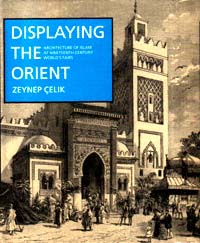 | Displaying the OrientArchitecture of Islam at Nineteenth-Century World's FairsZeynep ÇelikUNIVERSITY OF CALIFORNIA PRESSBerkeley · Los Angeles · Oxford© 1992 The Regents of the University of California |
TO MY PARENTS
Preferred Citation: Çelik, Zeynep. Displaying the Orient: Architecture of Islam at Nineteenth-Century World's Fairs. Berkeley: University of California Press, c1992 1992. http://ark.cdlib.org/ark:/13030/ft8x0nb62g/
TO MY PARENTS
Acknowledgments
The research for this book was carried out mainly in the Avery Library of Columbia University, the Cooper-Hewitt Library, and the Bibliothèque Nationale. I am grateful to the directors and staffs of these institutions and to the American Research Institute in Turkey, which provided financial support in the early phases. Among my friends and colleagues who helped me in innumerable ways, my special thanks go to Philippe Aigrain, Tosun Aricanli, Tülay Artan, Charles and Christine Burroughs, Suzanne Chun, Ahmet Evin, Mehmet Genç, Mireille Grubert, Richard Ingersoll, Boyd Johnson, Ned Kaufman, Timothy Mitchell, Gülru Necipoglu-Kafadar, Ilber Ortayli, Mary Woods, and Ayse Yönder. To Leila Kinney I owe my greatest intellectual debt: her challenge led me to investigate new avenues, and our collaboration on a related aspect of the world's fairs truly broadened my vision. Spiro Kostof pursued his Interest in my new ventures and inspired me in many ways. My parents, Edip and Nevin Çelik; my brother and sister-in-law, Ibrahim and Sylvie Çelik; and my mother-in-law, Frances Rome, maintained a genuine enthusiasm for the project. I thank them for their vital long-distance support.
I am greatly indebted to my hard-working assistants over the past few years: to Cheryl McQueen, Susan Miller, Kirsten Abrahamson, Ned Lager, and Jeff Gelles for the long hours they spent in the Avery Library; to Peter Tolkin for the care with which he photographed illustrations from books and periodicals, and to Tayeb El-Hibri for his revisions of Arabic terms. My editors at the University of California Press, Lynne Withey, Jeanne Sugiyama, and Stephanie Fay, have been invaluable. Lynne Withey's long-standing interest and belief in the project have been leading forces behind its completion.
My son, Ali Winston, did a lot of growing up while I researched and wrote this book. I know it was not fun for him to have a preoccupied mother, and I cannot thank him enough for being such a good sport at such a young age. As
always, the greatest support came from my husband, Perry Winston, who read my drafts, gave me his intelligent feedback, lent me his keen eye in selecting the visual material, and, most important, believed in my work.
Introduction
This immense exposition recapitulates the entire world. . . . Dreamers of travels, those who are attached by the short chain of their jobs and who dream of excursions on the banks of the Nile or the Bosphorus . . . now have no reason to complain. If they cannot go to the Orient, the Orient has come to them.
L'Illustration, 20 July 1867
The second half of the nineteenth century was the time of universal expositions in the Western world. Beginning in 1851 in London, the exhibitions, held in many cities of Europe and North America, became, in the words of the historian Eric Hobsbawm, "great new rituals of self-congratulation," celebrating economic and industrial triumphs. These "new rituals" were directly linked to the dramatic transformation of the economic order. During the first half of the century, industrialization had developed more rapidly than the market for industrial products. With the advancement of modern communication systems, however, the capitalist economy grew to encompass the globe.[1]
Imperialism and colonialism played crucial roles in this growth, redefining the global power structure and stimulating widespread interest in the non-Western world—now part of the universal economy. Aside from offering a market and rich sources of raw materials, the non-Western world also provided a supply of labor crucial to the new economic order. The advance of Western capitalism thus led to a much smaller world, one that was unified, if not equal. Simultaneously, the desire to maintain economic and political dominance called for better knowledge of subaltern peoples. While the Western world exported its industrial revolution to the rest of the globe, it also began to import information about other cultures.
Universal expositions represented this "single expanded world" in a microcosm, celebrating the products of industry and technological progress and displaying the entire human experience. Other cultures were brought piecemeal to European and American cities and exhibited as artifacts in pavilions that were themselves summaries of cultures. The experiential qualities of architecture—personal, intimate, and accessible to all—made it possible for exhibition buildings to offer a quick and seemingly realistic impression of the culture and society represented.[2]
As early as the Great Exhibition of 1851 in London, replicas of parts of well-
known buildings (such as the Alhambra) were displayed inside the main structure, the Crystal Palace; separate pavilions for different nations outside the main exhibition hall were first built for the Paris Universal Exposition of 1867. By gathering architectural pieces from all over the world, the fair grounds introduced the notion of an imaginary journey and created a new type of tourism, en place . Architectural displays became indispensable at every fair, setting the precedent for the "period room" and the "outdoor architectural museum."[3]
The architectural representation of cultures at the world's fairs was double-sided, making a claim to scientific authority and accuracy while nourishing fantasy and illusion.[4] The architectural critic Montgomery Schuyler argued on the occasion of the 1893 World's Columbian Exposition in Chicago that the buildings erected for the fairs belonged to a "festal" world and formed the "stage-setting for an unexampled spectacle." This was, he claimed, a world of dreams, and "in the world of dreams, illusion is all that we require."[5]
In accord with the notion of the fair as a microcosm and an imaginary journey around the world, foreign and especially non-Western societies were often represented in phantasmagoric images, themselves determined by Western legacies.[6] Even when the architecture purportedly demonstrated "scientific principles" (for example, the Ottoman pavilions in the 1867 Universal Exposition in Paris), it was received as a dreamlike environment—the setting for fairy tales—because of preconceptions about other cultures that were well established by the nineteenth century. As Walter Benjamin remarked, "Tactile appropriation is accomplished not so much by attention as by habit. As regards architecture, habit determines to a large extent even optical reception."[7]
This book examines the representation of Islamic cultures at the world's fairs of the nineteenth century, with a focus on architecture. The exposition buildings reflect sociopolitical and cultural trends crucial to an understanding of nineteenth-century transformations both in the West and in the world of Islam. For example, the placement of pavilions on the exhibition grounds revealed the world order as mapped by Western powers. The architectural styles of these pavilions embodied the colonizers' concept of Islamic culture as well as the struggle of certain Muslim nations to define a contemporary image, integrating historical heritage with modernization. How Westerners received these pavilions and how Western architects reinterpreted Islamic stylistic traditions, to-
gether with the impact such experiments made in urban centers like Istanbul and Cairo, shed light on the dominant attitudes in cross-cultural exchanges.
There are several reasons for choosing to study the representation of Islamic over that of other non-Western cultures. First, the world of Islam had been in contact and often in conflict with Europe over a period of thirteen centuries. Cultural and religious differences culminated in adversarial positions: Islam had come to mean the binary opposite of Europe.[8] Looking at this adversarial relation in the world's fairs will enable a better understanding of an inherent contradiction: while claiming to be platforms for peaceful cultural communication, in reality the expositions displayed the entire nineteenth-century world according to a stratified power relationship. Furthermore, this choice allows for a more complex reading of the homogenized "Islamic" culture: because some Islamic nations were independent powers while others were colonies during this period, the architectural representation of Islam can be viewed from different perspectives.
Second, the issue of cultural self-definition for many Muslim societies during the nineteenth century is particularly interesting due to their struggle to balance modernization imported from the West with local values and forms. The struggle extends to the present day, and "modernity and change" are still debated fervently in all "Third World" countries.[9] To analyze the controversy in its original terms, simplified and crystallized in the expositions, helps us to locate it historically.
Third, because the investigation of non-Western perspectives reveals "other ways" that issues were perceived and evaluated, it results in a more complex picture of a nineteenth-century world in which the West is not the only actor.
Fourth, and finally, examining the exchanges between Islam and the West acknowledges the existence of communication, discussion, and mutual recognition among these unequal partners, helping to refute the "silent" and "frozen" status given to Islam in Western discourse.[10]
My goal is not to survey the nineteenth-century expositions but to focus on those where the architectural representation of Islam was significant.[11] The expositions discussed at some length are the Expositions universelles held in Paris in 1867, 1878, 1889. and 1900; the 1873 Weltausstellung in Vienna, and the 1893 World's Columbian Exposition in Chicago. Each exhibition is associated
with specific architectural symbols, themselves often considered tours de force in nineteenth-century architectural history. The 1867 Universal Exposition is best remembered for its elliptical main hall, representing the globe, which was designed by Frédéric Le Play according to Saint-Simonian principles of universalism (see Fig. 18). The hybrid-style Trocadéro Palace, its central dome framed by two minaret-like towers, was the much-discussed hallmark of the 1878 exposition (see Fig. 34). Although this building was demolished in 1935, the new Trocadéro Palace erected on the site followed the outline of the original, engraving the mark of the 1878 fair on the Parisian topography. The centennial of the French Revolution, celebrated by the 1889 exposition, endowed Paris with its most renowned monument: the Eiffel Tower; the immense Galerie des Machines (demolished in 1910) boldly applied technological innovations to architecture. The 1900 exposition gave Paris two permanent monuments: the Grand Palais and the Petit Palais. In Vienna, in 1873, the longitudinal exhibition hall, with its colossal central dome in iron, stood for the age of technology. Finally, the legendary White City of the 1893 World's Columbian Exposition is considered the beginning of the City Beautiful movement. The discussion of two other expositions in this study, the 1851 Great Exhibition in London and the 1876 Centennial Exposition in Philadelphia, relates Islamic influences to the work of two important architects, Owen Jones and Frank Furness.
At the outset, certain themes need clarification. Cross-cultural topics involve confronting the vocabulary of European scholarship that reaffirms false polaritIes. The positing of a dichotomy between non-Western (or Eastern, or Oriental) and Western (or Occidental) produces culturally meaningless entities like "Islamic civilization" or "Western civilization." I believe that introducing a cross-cultural dialogue disrupts this polar system and questions the validity of fixing cultural boundaries. Therefore, when I use these inevitable terms, my intention is to question their validity, not to divide the world into opposing and homogeneous compartments.
The world's fairs of the nineteenth century have been analyzed from various viewpoints that complement one another and reiterate the ideological import of the expositions. Contributions by scholars in the social sciences and humanities suggest both the vast potential of the topic and the usefulness of interdisciplinary research. Among recent publications, those of historians and
anthropologists stand out. Historians have focused on the materialism and consumerism of the fairs, have linked the fairs to the development of capitalism and imperialism (Greenhalgh, 1988; Rydell, 1984) as well as to political ideology and artistic expression (Silverman, 1977, 1989), and have discussed cultural representations as microcosmic spectacles (Mitchell, 1988). Art historians have looked at the role the exhibitions played in the art world (Mainardi, 1987; Gilmore-Holt, 1988). Anthropologists and ethnographers have analyzed the impact of their disciplines on the organization of the fairs (Benedict, 1983; Leprun, 1986) and have connected the notion of consumerism to the selling of ideas at the fairs (Benedict, 1983). Tying all these approaches together is the theme of the expositions as a neat ordering of the world according to classes, types, and hierarchies—a system inherited from the Enlightenment.
For architectural historians, the expositions provided laboratories for new architectural forms and compositions; indeed, no architectural account of the late nineteenth century would exclude the Eiffel Tower and the Galerie des Machines, embodiments of the new aesthetics of iron. To them the fairs also reflected changing trends in architecture. For example, the transition in stylistic expression from the Eiffel Tower and the Galerie des Machines to the neorococo Grand Palais and Petit Palais of the 1900 Paris Universal Exposition is often presented as key evidence of a return to classicism. In addition, the involvement of many prominent architects in these grand events helped to bring the expositions to the forefront of architectural history. Expositions, however, have rarely been studied in their entirety; instead, architectural historians have discussed the buildings in isolation or have looked at them in their immediate environments. The theme of the ordered world of the expositions, analyzed by historians and anthropologists, did not extend to the study of their architecture. Neither were the non-Western pavilions considered seriously until Sylviane Leprun's recent study, Le Théâtre des colonies (1986), which examines the displays of the French colonies in the expositions from 1855 to 1937.
Nineteenth-Century Background
The period covered in this study, 1867–1900, witnessed turbulent transformations in both the political and the cultural lives of the Islamic nations discussed here. Although confrontation with European powers underlay the changes
everywhere, the differences in historical conditions, political structures, economic resources, and geographical locations led to different results, which were also affected by the struggles between European nations themselves. The historical outline that follows is intended to remind readers of the key dates and events as well as the contextual differences.[12]
During the second half of the nineteenth century, the Ottoman Empire, once a major Mediterranean power that included the territories discussed here—Egypt, Algeria, and Tunisia—was on the verge of disintegration, no longer able to defend itself against European military incursions. Among the crises the empire had faced were the Crimean War of 1854–56 and the revolt of Bosnia and Herzegovina in 1876. In 1877, Bulgaria, Serbia, and Romania obtained their independence; in 1882, Britain occupied Egypt, an independent governance of the Ottoman Empire. As Ira Lapidus argues, only the rivalries between European powers delayed the partition of the empire during the last decades of the century. In effect, the Foreign Debt Administration, an organization formed in 1881 by the Western nations that had made huge loans to the Ottoman government, ruled the empire.
The Ottoman government, attempting to rejuvenate the Empire and to confront European advances on its own terms, had undertaken modernization programs as early as the last decade of the eighteenth century. Technical, administrative, legal, and educational reforms based on European models were pursued during the nineteenth century, culminating in the declaration of the Turkish republic in 1923. A crucial debate—as reflected in Young Ottoman thought in the 1860s—was how to balance European norms and forms and Ottoman traditions.
The sultans who guided the Ottoman participation in universal expositions were Abdülaziz (1861–76) and Abdülhamid II (1876–1909). Whereas Abdülaziz enthusiastically supported Westernizing reforms, Abdülhamid's reign was characterized by a return to Islamic ideals on the one hand and a continuation of change and reform on the other. Under Abdülaziz an industrial exhibition was organized in Istanbul in 1863, and major Ottoman displays were assembled in Paris in 1867 (Abdülaziz himself visited this exposition) and in Vienna in 1873. During the thirty-two-year-long reign of Abdülhamid II, the Ottoman Empire participated in the 1893 World's Columbian Exposition in Chicago and the 1900 Universal Exposition in Paris; ambitious plans to hold a
similar event in Istanbul in 1894 fell apart because of financial problems resulting from a major earthquake that heavily damaged the city.
Although under Ottoman suzerainty since 1517, Egypt acquired a semiautonomous status in 1805, when Muhammad 'Ali was appointed governor; this status lasted until 1882, the date of the British occupation. Muhammad 'Ali initiated a series of military, economic, and administrative reforms, relying on the expertise of French and Italian advisers. These reforms were followed by legal and educational transformations and the development of infrastructure (the construction of railroads, the Suez Canal, cities, etc.) under Isma'il Pasha (1863–79), paralleling the changes promoted by the Ottoman rulers in Istanbul. In 1867, the Ottoman sultan conferred on Isma'il Pasha the title of khedive, giving him a special position in the empire and allowing him to sign independent technical and economic agreements with foreign powers.[13] Using this capacity, Isma'il Pasha appealed to European leaders for large loans to finance his projects, and like the Ottoman government, he soon lost control over finances. In 1875, a debt administration under British-French control was established, and in 1882 the British occupied Egypt in the name of the bondholders.
Egypt under Isma'il Pasha built an extensive compound for the Parisian exposition of 1867, which Isma'il Pasha, like Abdülaziz, visited. Egyptian pavilions appeared again in Vienna in 1873 and in Paris in 1878, but finances considerably restricted the lavishness of the displays. When the country was appended to the British Empire in 1882, private enterprise undertook the design and execution of the pavilions at the universal expositions.
Algeria, within the Ottoman imperial boundaries since 1529, had maintained its territorial identity and was ruled by a small group of Ottoman military officials until 1830, when the French occupied Algiers. From 1830 to 1890, the French gradually took control of the entire country, defeating a series of regional resistance movements. The first uprising, headed by 'Abd al-Qadir, lasted from 1832 to 1841 in western Algeria. Sporadic revolts followed, culminating in the massive but unsuccessful revolt in 1870–71, led by a tribal chief, al-Muqrani. Following the defeat of al-Muqrani, Algeria was incorporated into France and its administration was reorganized into three departments. Nevertheless, a civil governor-general maintained his authority over the entire country.
Conflicts between the Algerians and the French did not affect France's pre-
sentation of Algeria in the universal expositions as one of its most consolidated colonies. Algeria was always given a prominent location and an elaborate palace whose displays depicted a rich country, well integrated into the empire, whose culture enriched the dominating culture. The French presented the Algerian pavilions in Islamic styles even when in Algeria this heritage was being oppressed.
Tunisia, captured by the Ottomans in 1574 and made a province of the empire, maintained a semi-autonomous political structure like that of Egypt through most of the nineteenth century. Sharing the problems of the Ottoman Empire and Egypt in the face of the growing economic might of Europe, Tunisia similarly attempted a series of Westernizing reforms. Ahmad Bey (1837–55) and Khayr al-Din (1873–77) are particularly notable for their modernization efforts. Ahmad Bey, who was deeply influenced by Muhammad 'Ali of Egypt and whose ideal was Napoleon, began his reign by creating a new army, followed by an industrialization program to help equip the military. Khayr al-Din pursued the reforms begun under Ahmad Bey in administration, finance, education, and urbanism.[14]
French involvement in Tunisian affairs increased as Tunisia modernized. This is perhaps best illustrated by the current bey Muhammad al-Sadiq's submission of the Tunisian constitution to Napoleon III for his approval in 1860.[15] Using border disputes as a pretext, the French occupied Tunisia in 1881.
Tunisia's displays in the world's fairs were staged by the independent beys in 1867 and 1878 in Paris and by France in 1889 and 1900 after Tunisia became a colony. The dramatic shift in political structure did not, however, affect the pattern of architectural representation. The colonial officers chose to repeat the Islamic imagery of the earlier expositions; French architects designed the displays, reflecting the model set by the Algerian pavilions. In its historical references this architecture addressed the concern to preserve tradition.
Unlike other North African countries, Morocco never became part of the Ottoman Empire. As an independent state, its power was divided between the sultans in the urban areas and the tribal and Sufi leaders in the countryside. But Morocco did not escape the fate of other North African countries in the nineteenth century. As European trade increased, Moroccan industries could not compete with those of Europe, and the opening of the Suez Canal and the French expansion into West Africa made the main trade routes through Mo-
rocco obsolete. To remedy this situation, Sultan Hasan (1873–95) introduced military, administrative, and infrastructural reforms. These proved less successful than in other parts of the Islamic world largely because of the strong opposition of the religious and political elites, who believed the reforms infringed on religious law. The conflict between the sultan and the regional leaders and the resulting loss of central control facilitated French colonization between 1899 and 1912. Morocco's presence at the world's fairs reflected its unstable status: architectural scale and ambition were modest, and the pavilions mimicked those of other Muslim nations.
Iran's political status during the second half of the nineteenth century resembled that of the Ottoman Empire: both were sovereign, but each was also increasingly under European control. In the weak centralized regime of the Qajar dynasty that ruled Iran from 1779 to 1925 the religious establishment had a great degree of independent power. European incursions into Iran were military during the first half of the century, carried out by Russia in the north and the British Empire in the east; later, however, the same powers intervened economically. As elsewhere, exposure to Europe stimulated the modernization of the state apparatus as well as the military and the educational system. The reform movement was led by a new group of Westernized intellectuals who believed that only by modernizing could Iran resist foreign control.
In spite of these developments, Iran's cultural contacts with Europe were more restricted than those of other Muslim countries, which were geographically closer to Europe and had a history of continuous contact with the West. Accordingly, Iran's representation at the world's fairs did not reach the sumptuous scale of the Ottoman participation, for example. When Iran took part, its displays summarized the country's culture, albeit modestly, by architectural reference to its most glorious building era—the seventeenth century, under the Safavid dynasty.
Search for a Cultural Image
Many scholars, rejecting the definition of culture as the fixed attributes of a particular society, now focus instead on the dynamics through which cultures are "constructed" by those who define them. For example, in 1986 James
Clifford argued that cultures do not have a "scientific" objectivity; they are "produced historically."[16] Several years earlier, Roy Wagner, analyzing the position of the anthropologist vis-à-vis his research topic, claimed that the anthropologist "invented" the culture he studied on the basis of his own culture: "enveloped in his own world of meanings," he made analogies or "translations" from one culture to the other.[17] In the early 1970s, John Berger elaborated a similar point, applying the idea of studying "culture through culture"[18] to the way we see things: "We never look at one thing; we are always looking at the relation between things and ourselves."[19]
Accepting Wagner's broad definition of culture as a term that "attempts to bring men's actions and meanings down to the most basic level of significance, to examine them in universal terms in an attempt to understand them,"[20] I will survey the dynamic reformulation of Islamic culture by discussing late nineteenth-century Muslim thought in relation to the representations at the world's fairs. Even as many Muslim nations accepted European supremacy and attempted to remodel their institutions according to Western precedents, they were also searching for cultural identity under the strong impact of European paradigms. Because Europe represented the technologically advanced, "scientific" world, its "record" of another culture carried authority.[21] It is not surprising, therefore, that the European cultural image of Islam formed an important element, and often the foundation, of the new self-definition.
Europe's own norms and values had determined the image of an "Orient" in response to the European agenda, and the Orient had become the negative image of post-Enlightenment Europe.[22] In European discourse Islam was repeatedly characterized according to the preoccupations of Europe (or of anywhere else, for that matter): power, sex, and religion, linked by violence and tyranny.[23] European and Islamic cultural systems were juxtaposed and described as diametrically opposed to each other in these areas. Islamic countries in turn focused on the same attributes in their self-definitions: when invited to represent themselves through architecture in the universal expositions, they repeatedly depicted the mosque and the sultan or bey's residence as prototypical. The mosque was the setting for religious practices and the residence displayed the realm of the political ruler, his power, his lifestyle, and, perhaps most intriguingly, his subordination of women.
Yet European paradigms were not simplistically appropriated; they were often filtered through a corrective process, which reshaped them according to self-visions and aspirations. Another reference to architectural representations in the world's fairs may help to explain: the Ottoman pavilions in the 1867 Universal Exposition in Paris highlighted the rationalist principles of composition in Ottoman monuments rather than their decorative programs—the obsessive focus of European interest. Aside from illustrating the continuous redefinition of cultures, such specific cases suggest that different Islamic societies need to be considered, "each within its particular agendas and pace of development, its own formations, its internal coherence and its system of external relations." At the same time, applying a "contrapuntal perspective" to such specific experiences yields a better understanding of their "overlapping and interconnected" histories.[24]
World's fairs were idealized platforms where cultures could be encapsulated visually—through artifacts and arts but also, more prominently, through architecture. The debates on architectural imagery thus became closely intertwined with redefinitions of local cultures. I will look briefly at the dominant trends among the Muslim intelligentsia in the 1860s, when Islamic nations first participated on a large scale in the world's fairs, beginning with the 1867 Universal Exposition in Paris. The colonial discourse associated with the cultural representation of the occupied territories is not included here, however, because its subject was the consolidation of foreign control and its arguments were embedded in the culture of the "mother country," in this case, France.
I will attempt to correlate nineteenth-century thought in the Middle East and North Africa with the architectural imagery of the universal expositions with reference to the writings of three leading intellectuals from three different regions: Ibrahim Sinasi (1826–1871) of Istanbul, Rifa 'a al-Tahtawi (1801–1873) of Cairo, and Khayr al-Din of Tunis (1820/30–1889). All had lived in Paris for extended periods,[25] and each one had been exposed to French intellectual and political life, which became a key factor in the evolution of his thought.
The historian Albert Hourani argues that the Young Ottomans in the 1860s used Islamic ideas to explain and legitimize the modernization of Ottoman institutions along European models by emphasizing the high morality of Islam and by claiming that progress meant a "return to the true spirit of Islam."[26]
Ibrahim Sinasi, the founder of this movement, was one of the champions of Westernization among the Ottoman intelligentsia. Reversing the Islamic concept of moving from faith to reason,[27] he argued that the "soul . . . was chiefly guided by reason" and that religion was achieved through reason. But reason was not an end in itself for Sinasi; it was a means to civilization, which he described in religious terms. For example, he referred to Mustafa Resit Pasa, a leading reformer, as the "prophet of civilization" (medeniyet resulu ), his time as "the time of felicity" (asr-i saadet ), and his physical existence, his body, as a "miracle" (mucize ).[28]
Civilization, the religion of the new age, also had its scripture—the book of laws in which its values, such as justice, rights, and ethics, were registered—and its promise of redemption: it would free mankind from oppression, slavery, and ignorance. Sinasi talked about a "new man," a man of the age of reason, characterized more by universal attributes than by national ones. Indeed, Sinasi's goal was a worldwide civilization whose nations would serve and enlighten humankind and therefore contribute to "progress." Ottoman society would form a bridge between Europe and Asia, where "Asia's wise (old) reason (Asya'nin akl-i piranesi ) would meet with "Europe's young ideas" (Avrupa'nin bikr-i fikri ).[29]
The Ottoman intelligentsia derived their concept of a universal civilization centered in Europe (and, for many, in Paris) from the French social philosopher Saint-Simon and his followers. Many Ottoman displays in the world's fairs underlined the participation of Ottoman culture in world civilization: the universal qualities of Ottoman architecture were emphasized to show how these might be incorporated into the repertoire of a contemporary architecture; artistic and industrial products were often presented with a similar intent: to link the empire to the European community.
Al-Tahtawi, one of the most influential figures in the cultural reformation of Egypt under both Muhammad 'Ali and Isma'il Pasha (he was directly involved in educational reform and in the translation of major French texts into Arabic), focused at length on a cultural definition of Egypt within a broader framework of world civilizations and history. In an early work, Takhlis al-ibriz fi talkhis Bariz (The refinement of gold—summary of Paris), published in 1834 by order of Muhammad 'Ali, al-Tahtawi divided humanity hierarchically into savages, barbarians, and the civilized. Like Europeans, many Muslims belonged to the
third group, defined as "the people of morality, refinement, sedentary life, life in towns and great cities." If Europeans in this group were more advanced in science and technology, Muslims had the shari'a (divine law), the source of wisdom and social order; by studying European achievements, Muslims would overcome their inequality.[30] Thus Egypt would become more civilized as a result of frequent contact with Europe—a notion that Muhammad 'Ali and Isma'il Pasha fully accepted. Al-Tahtawi's concept of civilization was broad based, ranging from infrastructure (roads, modern ports, canals, railroads, etc.) to administrative and political institutions to education. Isma'il Pasha, satisfied with the progress registered in these areas, declared during his visit to Paris in 1867: "For thirty years, the European influence has transformed Egypt; now . . . we are civilized."[31]
This rapprochement with Europe did not mean a loss of cultural identity, however. On the contrary, the notion of watan (fatherland, patrie ), as opposed to the concept of umma (the large body of believers), appeared in political and intellectual discourse around this time, contributing to the Egyptian struggle for autonomy from the Ottoman Empire. Curiously enough, Egypt's new rulers were dusting off Napoleon's goal of returning Egypt to civilization and endowing it with its own cultural identity by dissociating it from the Ottoman system. For al-Tahtawi, watan was a place with a glorious history, a place he was proud to be associated with. In his concern to create a distinct national history, al-Tahtawi became the first Egyptian historian to embrace Egyptian antiquity as a glorious part of the country's past, when Egypt was the "mother" of civilization.[32]
Al-Tahtawi's first volume on the history of Egypt, Anwar Tawfiq al-jalil fi akhbar Misr wa tawthiq bani Isma'il (The radiance of the sublime Tawfiq in the history of Egypt and the descendants of Isma'il), published in 1865, dealt with the period from the ancient kingdoms to the Arab conquest, reflecting the work of Egyptologists—among them Jean-François Champollion and Auguste Mariette, the first considered the father of Egyptology, the latter a main actor in determining Egyptian representations in the universal expositions in 1867 and 1878.[33]
Al-Tahtawi analyzed both the great achievements and serious setbacks of Egypt after the Arab conquest. For example, although the first caliphs brought a renewal of civilization, the Mamluk beys impeded Egypt's development with
their "pagan furor," their "racial and clanish solidarity," and their disregard of "progress and civilization"; their defeat by Muhammad 'Ali finally opened the era of progress.[34] Nevertheless, Arab culture played a great role in the history of "civilization," and Islam would continue to define nineteenth-century Egypt, which would be simultaneously Egyptian, Muslim, and modern (hence civilized according to European norms).[35] As we will see in chapters 3 and 4, this tripartite definition informed the architectural representation of Egypt in the 1867 Universal Exposition in Paris, where one pavilion was devoted to Egyptian antiquity, another to the Arab past, and a third to the modern era—clad in an Islamic image.
The Tunisian statesman Khayr al-Din's proposals for progress followed European models yet were justified and explained by Islam and exemplify the widespread struggle between modernity and tradition among Muslim intelligentsia in the late nineteenth century. Khayr al-Din's important book, Aqwam al-masalik li-ma'rifat ahwal al-mamalik (The surest path to knowledge concerning the conditions of countries) was published in Arabic in 1867; only one year later a French translation (done under the supervision of the author) appeared in Paris. The book thus addressed two major audiences: Muslim political and religious leaders who opposed changes according to European models and European statesmen who considered Islam an obstacle to progress.[36] As a statement about the present condition of Muslim countries that explained their history and speculated on their potential, the French edition played a role similar to that of the exposition pavilions abroad.
In the introduction to his English translation of The Surest Path, the historian Carl Brown condensed Khayr al-Din's argument into three points: Europe's progress was not linked to Christianity, and hence Islam was not a hindrance to advancement; the reforms Khayr al-Din proposed were in accordance with Islam; and institutions and ideas similar to those in nineteenth-century Europe could be seen in Islamic countries in other periods.[37] The book itself describes European technology and inventions at length, focusing on the knowledge that could be easily grasped and applied; it omits descriptions of wonders or accounts of daily life in Europe.[38]
It is in this context that Khayr al-Din discussed universal expositions as platforms where "whoever invented[ed] something new or concern[ed] himself with any kind of beneficial work" got public attention; such exposure formed
"one of the reasons for [European] progress." The organization of the expositions into buildings designated for similar sorts of industries and merchandise, the prizes and decorations, and, ultimately, the attendance of kings and other "men of state" at these events promoted industrial and technological development.[39] Khayr al-Din believed that by understanding and applying European mechanisms for rewarding individual initiative, the lands of Islam could achieve progress.
Khayr al-Din argued that Muslim nations could both accommodate modernization and maintain their cultural identity. Although he did not dwell on cultural issues, he based his plan for Islamic societies on historical continuity. Unlike al-Tahtawi, Khayr al-Din did not envision national cultures and civilizations, nor did he subscribe to the notion of watan . On the contrary, his propositions were never specific to a locale, and his emphasis was always on umma, most likely because of his concern for the integrity of the Ottoman Empire against European expansion.[40]
The first three chapters of this book cover the Islamic displays at world's fairs in Europe and America. Chapter 1 discusses the presence of Muslims at the expositions in the ethnographic displays of indigenous peoples, in the official visits of Muslim rulers, and in the visits of individuals. Chapter 2 examines the site plans of the expositions as diagrams of the prevailing power relations and focuses on the grouping of Islamic pavilions. Chapter 3 surveys the main pavilions of Islamic nations, analyzing their stylistic qualities in the broader context of the nineteenth-century search for cultural self-definition.
Chapters 4 and 5 trace the impact of the architecture of these Islamic pavilions. Chapter 4 looks at two Ottoman expositions in Istanbul and at the opening of the Suez Canal in Egypt, all influenced by Western expositions. Chapter 5 relates exposition architecture to Islamic architectural theory and practice and discusses the interpretations of Islamic architecture by leading Western architects. Finally, the Epilogue brings the themes of the book to the present day.
1—
Muslim Visitors to World's Fairs
Now that we are not afraid of Turks, Arabs, and Saracens, the Orient has become for us a sort of hippodrome where grand performances are given. . . . We take the Orient for a theater.
Le Figaro, 26 June 1867
Muslim visitors to expositions in European and American cities were either official representatives of Muslim states or independent travelers, some of whom later recorded their observations in print. The official missions included heads of state as well as high-ranking government bureaucrats. Whatever their own motives for visiting the expositions, Muslim sovereigns who attended immediately became part of the display, often as the major attraction. Members of exposition commissions also received due attention from the Western press. And the commissions themselves published books about their cultures, documents that illustrate not only the official self-perception but also the perceptions governments hoped to elicit among Westerners. As part of the displays, indigenous people were brought in to represent anthropological "types." This idea may have derived from the French researcher Joseph Marie de Gérando (1772–1842), who, in the belief that humans could be understood in light of methodological observations carried out on "savages," had proposed to transport such "pure" specimens to France.[1]
Whereas official visitors to the fairs brought their lives and cultures to Europe and America, independent travelers in their reports took the expositions to audiences back home. Exposition fever was widespread, and literature on the fairs included travel accounts, newspaper and magazine articles, novels, and even poetry, all in tones ranging from the didactic to the lyrical.
Displays of Indigenous People
The young disciplines of anthropology and ethnography popularized their methods and publicized their discoveries at the nineteenth-century universal expositions. In a provocative study, Johannes Fabian defines anthropology as "a science of other men in another tune," the notion of "another time" signify-
ing not a chronological past but the frozen status of certain societies and cultures. Although, as Fabian points out, these "other men are our contemporaries," they are situated at a temporal and spatial distance.[2] The displays of non-Western peoples at the nineteenth-century world's fairs were organized around the anthropologist's concept of distance. "Natives" were placed in "authentic" settings, dressed in "authentic" costumes, and made to perform "authentic" activities, which seemed to belong to another age. They formed tableaux vivants, spectacles that fixed societies in history.[3] Mixing entertainment with education, these spectacles painted the world at large in microcosm, with an emphasis on the "strangeness" of the unfamiliar (Fig. 1). Describing a procession to be held at the Midway of the World's Columbian Exposition in 1893, the Chicago Tribune emphasized its theatricality:
It will be a unique procession, one which cannot be seen elsewhere, and one which never may be seen here again after the Fair closes. Headed by the United States regulars, there will follow in picturesque array Turks with Far-Away Moses leading them, Bedouins, sedan bearers, Algerians, Soudanese, the grotesque population of the Cairo Street, with its wrestlers, fencers, jugglers, donkey boys, dancing girls, eunuchs, and camel drivers, Swiss guards, Moors and Persians, the little Javanese, South Sea islanders, Amazons, Dahomans, etc. . . . The march of this heterogeneous conglomeration of strange peoples, brilliant in color and picturesque in attire, will be enlivened by music of all kinds. . . . It will be a picture in miniature of the World of the Orient in this newest city of the Occident, and a day's diversion in the routine of sight-seeing which will be of an agreeable if not exciting character to witness the queer and strange spectacle.[4]
Such spectacles also served the politics of colonialism. The display of both subject peoples and products from foreign possessions made colonialism concrete to those at home and reaffirmed the colonizing society's "racial superiority," manifest in its technical, scientific, and moral development—as the French prime minister Jules Ferry argued in the 1880s.[5] The inclusion of native populations in the fairs was much discussed at the time. An anonymous article on the Tunisian section in 1889 argued that it was essential to display the colonized people "to give more reality and life to the buildings [erected on the site]."[6] Furthermore, without the display of colonial subjects, an exposition would fail
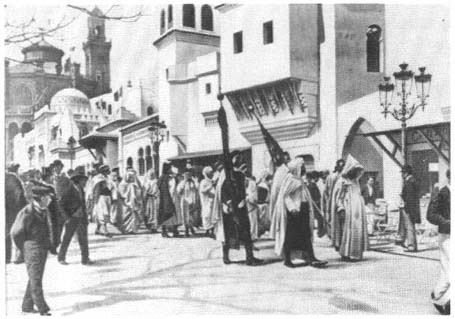
Figure 1.
A parade by Arabs in the Trocadéro Park, Paris, 1900 ( L'Exposition de Paris, vol. 2).
to "embrace all phases of life and work in the colonies."[7] When the organizers of the Universal Exposition in 1900 considered excluding displays of people from the French colonies, they encountered strong opposition. Charles Lemire, the honorary resident general, argued that because the French needed to be better informed about the races inhabiting the colonies and protectorates, the fairs should show the different racial types in appropriate environments. At the same time, the natives would have the opportunity to acquaint themselves with the metropole. Lemire suggested how the exposition could diffuse information about the colonized and the colonizer:
Useful products, racial types, specimens of ancient and modern art, these are the indigenous elements to conglomerate; French products, resources of the metropole, contact with the French [in France], these are the continental elements to offer to the indigenous.[8]
According to the anthropologist Burton Benedict, human displays at the world's fairs were organized into national and racial hierarchies.[9] The nine-
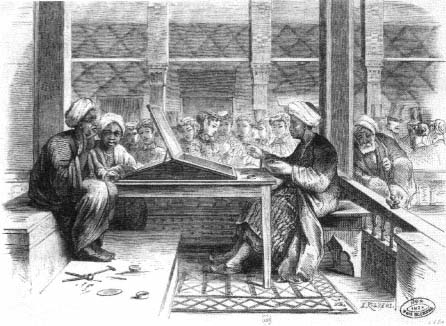
Figure 2.
Filigree artisans in the Egyptian bazaar, Paris, 1867 (Bibliothèque Nationale.
Département desEstampes et de la Photographie).
teeteenth-century "scientific" approach, based on an interpretation of Darwinian theories, emphasized classification,the diversity of racial types, and the hierarchy of these types.[10] Benedict summarized the classification of human types at the fairs as follows: (1) people as technicians, with a technician acting as part of a machine on display; (2) people as artisans, with an emphasis on tradition and ethnicity as well as the "handmade" qualities of the products; (3) people as curiosities or freaks, with an emphasis on abnormal physiology and behavior; (4) people as trophies, most typically the conquered displayed by the conquerer in special enclosures; and (5) people as specimens or scientific objects, as subjects of anthropological and ethnographic research.[11]
The displays of Muslim people fit all these categories except the first. Machines belonged to the advanced nations, and in only a few cases, which involved rather primitive inventions, were Muslims associated with them. One such example was the "Turkish fire engine" in the Columbian exposition, "carried on a sort of sedan chair arrangement by as many bare-legged Turks as can get hold of it."[12]
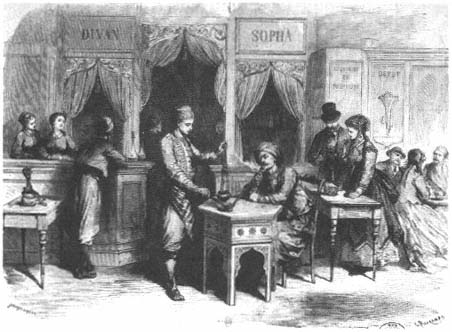
Figure 3.
Turkish café, Paris, 1867 (Bibliothèque Nationale, Département des Estampes et de
a Photographie).

Figure 4.
Ironsmith from Kabyle, Paris, 1889
(Bibliothèque Nationale, Département
des Estampes et de la Photographie).
Benedict's second category, artisans, filled the bazaars of the Muslim quarters at the fairs (Figs. 2–4). They included a Tunisian barber and café attendants in 1867,[13] Algerian cobblers and "handsome Kabyles from Constantine"
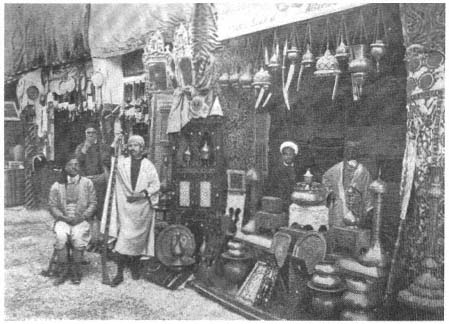
Figure 5.
Tunisian souk in the Trocadéro Park, Paris. 1900 (Quantin, Exposition du siècle ).
in 1878,[14] and Turkish street confectioners in 1893 in Chicago.[15] But perhaps the most complete crafts fair was provided by the Tunisian section of the 1900 exposition in Paris (Fig. 5). The thirty-seven crafts "typical of Tunisia," including jewelry making, weaving, embroidering, basket weaving, shoemaking, and woodworking, were "chosen in order to give the total picture of the local indigenous industry."[16] The protectorate administration was particularly proud of this section because it considered itself a savior of the "indigenous artistic industries" faced with the threat of modernization.[17] The Tunisian display was also seen as a reaction against the simpleminded entertainments in other Islamic displays: "[It] does not attract visitors by its tumultuous belly dances. It presents itself in its everyday clothes, in its honest work clothes."[18]
Muslims were often treated as curiosities in the exhibitions, not so much for any physiological abnormalities as for differences in behavior, customs, and the traditions they acted out before large audiences in the Islamic quarters built on the fair grounds (Figs. 6–7).[19] Theater, music, and dance in "exclusively
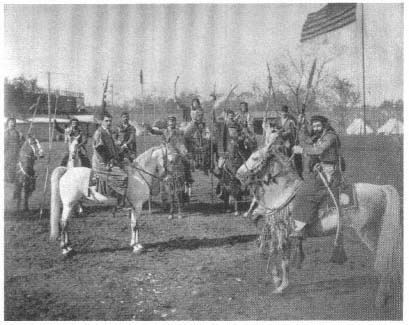
Figure 6.
"Bedouins in Their Encampment." Chicago, 1896 ( The Dream City, vol. 1.).
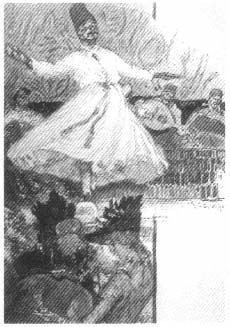
Figure 7.
Whirling dervish on the Rue du Caire,
Paris, 1889 (Revue de l'Exposition
universelle de 1889, vol. 1).
ethnic character" became indispensable attractions at every fair. Ben Truman, an American observer, described the Turkish theater at the 1893 World's Columbian Exposition:
Eighteen houris of the Orient and sixty-five men have been picked up from the companies of Constantinople, who dance, play, sing and form an orchestra, a stock company and a chorus. The complement is fully made-up, and there are soubrettes in baggy trousers, heavy tragedy in a fez, and low comedy in a turban.[20]
In 1900 the Egyptian theater in Paris reproduced vignettes from Egyptian and Sudanese life—at times even reconstituting social scenes from antiquity—in luxurious settings with actors in rich and diverse costumes.[21] In the same year the "Armenian theater" in the Ottoman section produced "operettas" based on Turkish daily life and customs but with Italianized music to make the performances "more acceptable to European ears."[22] The use of such music was, however, an exception; the music played in Islamic quarters was unfailingly described by European and American reporters as "bizarre," "strange," "wild," and "irritating to European ears,"[23] even as it was felt to maintain the cultural integrity of the compounds. Ben Truman summarized the prevailing view in describing the musical performance at the Turkish theater in 1893 as "mournful, weird, plaintive and funereal by turns—never lively or rhythmical; yet when floating out from a latticed window or portiered doorway, not entirely unenchanting."[24] More serious accounts of Arabic music also emphasized its "indefinite repetitions" and "monotony."[25]
In all performances the belly dance was the highlight (Figs. 8–10). Catering to fantasies about harem life, belly dancers attracted great crowds and achieved major commercial success; in 1889 in Paris, the "danse du ventre made all of Paris run [in its orbit]," and an average of two thousand spectators flocked to watch the belly dancers every day.[26] One French journalist cynically noted that the ten words in French one of the "exhibitors of bellies" had learned and repeated all day long were well chosen: "La danse, . . . c'est épatant! entrez, mousiu, c'est le moment psychologique" (The dance . . . it's terrific! Enter, Monsieur; it is the psychological moment!).[27] In 1893 a cartoon in a humor
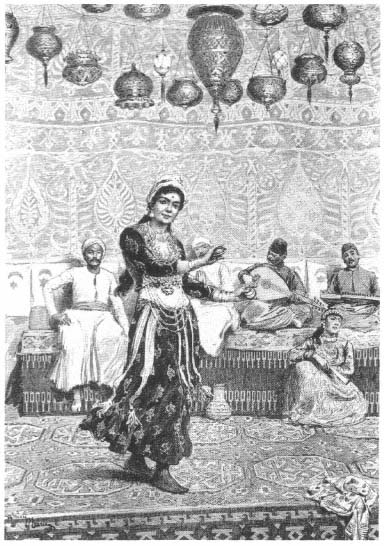
Figure 8.
Alma Aicha's dance in the Egyptian café of the Rue du Caire, Paris, 1889
(Bibliothèque Nationale, Département des Estampes et de la Photographie).

Figure 9.
Sudanese musicians and dancer in the Egyptian café of the Rue du Caire, Paris, 1889
(Bibliothèque Nationale, Département des Estampes et de la Photographie.).
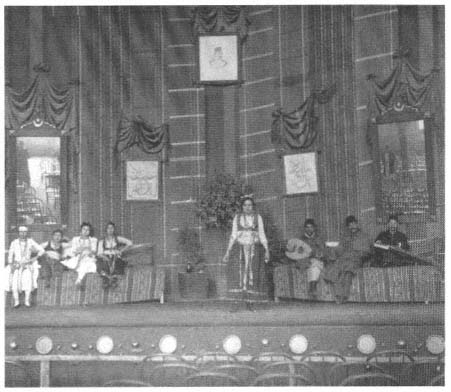
Figure 10.
A dance in the theater of Cairo Street, Chicago, 1893 ( The Dream City, vol. 1).
magazine, World's Fair Puck, elaborated on the business potential of the American obsession with the harem and the belly dance in Chicago (Fig. 11).[28]
The enthusiastic reception of the belly dance was closely linked to the Parisian entertainment industry in the nineteenth century, specifically to the popular dances performed in the cabarets, café-concerts, jardins d'hiver, and bals publics . The cult of the star, which originated in these establishments, extended to the Fathmas, Feridjées, Aichas, and Zohras who took their place among the erotic female dancers of the time: La Goulue (The Glutton), Nini Pattes en l'air (Nini Paws-in-the-Air), Môme Fromage (Mistress or Kid Cheese), Grille
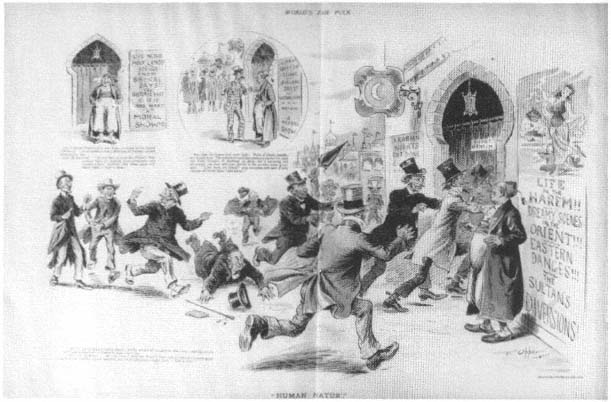
d'Egout (Sewer Grate), and many others.[29] The Islamic theaters at the expositions complemented the city's own places of pleasure—its streets, café-concerts, and cabarets.[30] In these theaters, amid architecturally "authentic" settings, belly dancers presented the element of Muslim life most intriguing to Europeans, one that for at least seventy-five years had been a focus of Orientalist painters and writers. The descriptions of the performances were at once evocative and condescending. This passage from a long article in the Figaro illustré is representative:
Men and women dressed in transparent silks and sumptuous embroideries reclined on rugs and cushions and, smoking the narghile and drinking rose- and liquor-flavored sherbets, awaited the delicious keif (pleasure). . . . As though pinched by a needle, [the dancer] started moving with hideous contortions that
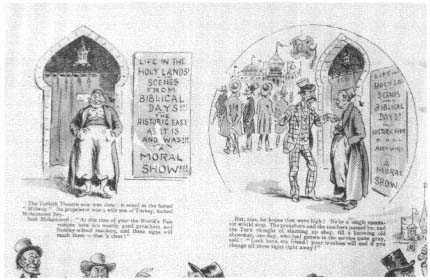
Figure 11.
Cartoon "Human Nature," Chicago, 1893, with detail ( World's Fair Puck, 4 September
1893). The detail shows, at left, a Turkish entrepreneur on the Midway who hopes to
attract large Crowds to biblical scenes from the Holy Land; after failing, he gets
advice from a local businessman. With the sign changed from "Life in Holy Lands,
Scenes from Biblical Days" to "Life in the Harem, Dreamy Scenes in the Orient,
Eastern Dances, the Sultan's Diversions," crowds flock to the booth.
all the Fathmas and Feridjees of the feasts of Neuilly have saturated us with. With the vibrations of her hips and her torso, she gives the illusion of a sea that calms down, one where the long slow waves die on the sand.[31]
The account further referred to sentiments aroused by The Thousand and One Nights, to images of prayers recited in front of mosques, and to ferocious men from "ancient times."[32]
As Parisian dance and the belly dance exchanged characteristics, both were transformed. For example, in 1889 the belly dancers' accessories were limited to swords and mirrors: in the dance of the sword, the dancer's clattering swords accompanied the violins and the violas; in the dance of the mirror, the dancer flirted with her reflection in a "real pantomime of conquetry."[33] The
belly dancers in the Egyptian theater in 1900 used more elaborate props: several glasses on the belly, a narghile or candelebra on the head, or a chair in the mouth (Figs, 12–13).[34]
In colonial displays people were frequently displayed as trophies. Artisans working in traditional crafts in small settings that re-created the "authenticity" of their place of origin were "trophies in special enclosures."[35] "Colonial soldiers" were presented similarly in 1889 and in 1900, when armed Algerians in their local costumes, in a setting designed to evoke the colony, "gave legitimate satisfaction to [French] patriotic feelings."[36]
People were presented as subjects of research more often than in any other guise at the fairs. The aura of these displays was "scientific," as was the language used to describe them. In 1867 a certain Docteur Warnier compared the physiology and character of the Arab and the Berber. The Arab was tall and thin, with a "pyriform" skull, a narrow forehead, an arched and bony nose, and black eyes, hair, and beard; the Berber was of medium height, with a large round skull, broad straight forehead, fleshy nose, square jaw, and eyes, hair, and beard varying from black to red. Whereas the Arab was a fighter who enjoyed war but was otherwise undisciplined, a "born enemy of work," the Berber was the opposite: he was docile, worked hard, and because of his intelligence could "become a devoted auxiliary of European and Christian colonization." The Arab looked Asiatic, the Berber European.[37]
The Tunisian musicians in Paris in 1878, of a "type bien africain," displayed the traits of a "beautiful race, indolent, sleepy, but with features not lacking nobility or energy";[38] the "Arabesque races" on the fairgrounds in 1889 were of the "Israelite type";[39] the Arabs of the Algerian theater were "generally handsome, having preserved the nervous grace and the pride of nomadic races."[40] Behavioral attitudes were also displayed. The Arabs of the Camp of Damascus in the Turkish village in Chicago "squatted about as at home. They had little occupation, except the smoking of the narghile, without which [they] would consider [their] hours of leisure devoid of any pleasure."[41]
The "scientific" display of indigenous peoples seemed to require that all the races from a specific region be included to give fairgoers as complete a picture as possible. The Cairo Street in Chicago had "Jews, Franks, Greeks, Armenians, Nubians, Sudanese, Arabs, and Turks . . . representing faithfully the population of the old city of Egypt."[42] The Tunisian section in 1900 had 140
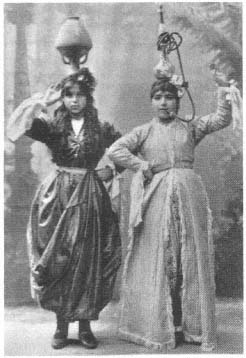
Figure 12.
Dance of the narghile, Paris, 1900
(Figaro illustré, no. 124, July 1900).
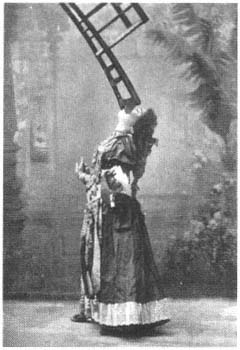
Figure 13.
Dance of the chair, Paris, 1900
(Figaro illustré, no. 124, July 1900).
Jews and Muslims (Moors and Berbers), "representing the different types one encounters in Tunisia."[43] The contemporary press, echoing the notion of a microcosm, commonly published images of all the racial types to be seen on the fairgrounds. The caption for a photographic collage from the Colombian Exposition dwelt on the diversity of the thirteen racial types depicted:
To say that all these characters were taken from a street less than a mile long, would seem to indicate a most heterogeneous massing of nations, but when is added the thought that they are but types, and that each one represented from
twenty to fifty more, the idea becomes quite overpowering. These individuals represented Europe, Asia, Africa, North America, South America, and the islands of the South Pacific.[44]
The hierarchy of races in the world's fair displays made the premises of nineteenth-century anthropology and ethnography constituents of mass culture in Europe and America. Indeed, the reception of non-Westerners at the expositions demonstrates this clearly. For example, in 1889 Parisian women "very quickly learned to treat the indigenous with a maternal charity; . . . they considered them big children (grands enfants )."[45]
Muslim Sovereigns at the Fairs
The 1867 Universal Exhibition in Paris was marked by important visits from two Muslim sovereigns: Governor Isma'il Pasha of Egypt and, some weeks later, Sultan Abdülaziz of the Ottoman Empire, the first in his dynasty to leave the empire for a purpose other than war (Figs. 14–15). These visits were major events, chronicled in minute detail. Parisians were intensely curious about Isma'il Pasha and Abdülaziz, both of whom traveled with their entourages and were honored guests of Napoleon III. As one newspaper noted at the time, a few days after the sultan's arrival "the Parisian population [was] divided into two very distinct classes: those who had seen the sultan and those who had not."[46] A ceremony at the Palais d'Industrie, where the sultan sat next to Emperor Napoleon III and Empress Eugénie, attracted between "twenty and thirty thousand people."[47]
Isma'il Pasha and Abdülaziz became the highlights of the exhibition. In Abdülaziz's honor, a splendid décor was put up in the Palais d'Industrie. A white drapery studded with golden stars lined the semicircular glass roof, crimson velvet draperies trimmed with gold lace hung from the galleries, and the imperial throne with its towering golden canopy dominated the room. Here, as if on a magnificent stage, the French emperor and empress sat with the sultan while an orchestra of twelve hundred musicians played.[48] The three rulers were as much on display as the different products exhibited on an elevated platform before the throne.
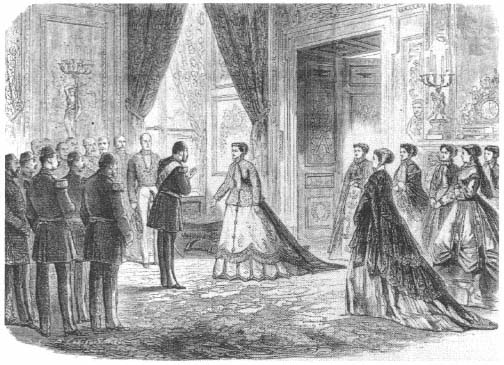
Figure 14.
Reception of Isma'il Pasha by Empress Eugénie at the Tuileries, Paris, 1867 ( L'Illustration, 29
June 1867).
One journalist interpreted the warm welcome Paris gave Abdülaziz as the result of curiosity rather than sympathie .[49] Another, criticizing the widespread perception of the sultan as a dazzling monarch from The Thousand and One Nights, surrounded by odalisques, drunk with perfumes, and adorned with precious stones and gold, argued that the sultan was instead a generous, good man, extremely intelligent and well educated, who valued work, order, and justice above all and who respected the rights of Christians in his empire. "This is the man," he concluded, "without doubt, not as marvelous as we believed, but wiser and more human."[50] Isma'il Pasha was presented as similarly tolerant because all citizens of Egypt, regardless of belief, could be elected to the Egyptian parliament.[51]
In Innocents Abroad, however, Mark Twain depicted Abdülaziz as a "weak, stupid, ignorant [man] who believe[d] in gnomes and genii and the wild fables of the Arabian Nights."[52] Describing the public appearance of Napoleon III
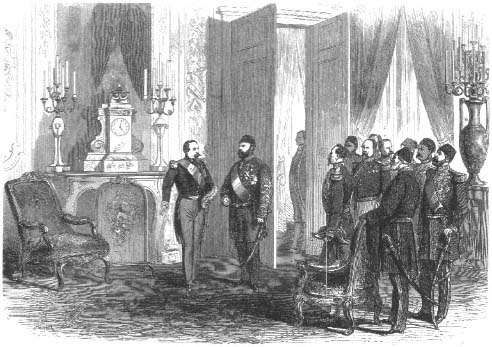
Figure 15.
Sultan Abdülaziz's visit to Napoleon III in the Elysée Palace, Paris, 1867 ( L'Illustration,
13 July 1867).
and Abdülaziz on the Place de l'Etoile, Twain argued that the two men represented opposite worlds:
Napoleon III, the representative of the highest modern civilization, progress, and refinement; Abdul-Aziz, the representative of a people by nature and training filthy, brutish, ignorant, unprogressive, superstitious—and a government whose Three Graces are Tyranny, Rapacity, Blood. Here in brilliant Paris, under the majestic Arch of Triumph, the First Century greets the Nineteenth![53]
The populace were disappointed by the outlook, disposition, and conduct of the Muslim rulers, who, except for the red fez, dressed in European-style clothes. They were socially graceful,[54] and Isma'il Pasha, who had been educated at the Ecole Polytechnique in Paris, even spoke excellent French—"le français le plus pur, sans le moindre accent."[55] They demonstrated their fine
taste by their interests. Abdülaziz, for example, stopped in front of "les plus beaux meubles" and "les bronzes les plus artistiques" in the furniture section of the exhibition before going on to visit the fine arts gallery.[56]
What were the governor's and the sultan's goals in visiting the exposition? According to one French journalist, Abdülaziz intended to tell the world that despite the reputation of his empire as the "sick man of Europe," he played a crucial role as the leader of the Muslims because the people of Asia and Africa still followed the teachings of the Qur'an.[57] As caliph, he was the omnipotent Muslim ruler. Yet Abdülaziz also pursued a Western model of "progress" and wanted to be recognized for his institutional reforms. Similarly, Isma'il Pasha's goal was to demonstrate his alliance with Europe by announcing the modernizing transformations in his own country.
Both Abdülaziz and Isma'il Pasha were intent on reshaping their cities according to European models—a goal reflected most dramatically in the physical transformation of Istanbul and Cairo. In Istanbul, following a fire that destroyed a huge section of the city in 1865, a campaign was launched to replace the irregular urban fabric—crooked streets and dead ends—with straight, regular streets and grid patterns. Modern services such as street lighting and cleaning were introduced at the same time.[58] The new plans were believed to match those of "the most recently designed places in the world,"[59] the reference being to the rebuilding of Paris under Napoleon III and his prefect, Baron Haussmann.
The changes in Istanbul were incremental and eclectic, determined mostly by fires and the rebuilding that followed them. In contrast, city building in Cairo was comprehensive.[60] A new quarter of Cairo, named Ismailiyya after the governor, extended the city to the west with a design that superposed a pattern of radial streets on a grid. Long avenues ended in squares or ronds-points; monuments and public buildings defined the ends of vistas.[61] The model was once again Haussmann's work in Paris. Indeed, French architects, landscape architects, and gardeners were commissioned to beautify Cairo.[62] Nubar Pasha, president of the conseil des ministres and head of the Egyptian Commission to the 1867 exposition, later criticized Isma'il's obsession with the "toilette du Caire" and accused him of misunderstanding the meaning of "progress" by equating it with imitating in Cairo what had been done in Paris—"des boulevards, des jardins, des embellissements de toute nature" (boulevards, gardens,
beautification of all kinds).[63] Because Isma'il Pasha needed to borrow money from European powers to carry out his plans, his purpose in visiting Paris in 1867 went beyond the strengthening of cultural ties between the two countries. In 1868 France loaned Egypt (through the Société Générale) 296 million francs to be paid in thirty years with interest.[64]
The visits of Muslim sovereigns to the 1867 Paris Universal Exposition were significant for several reasons. Both Isma'il Pasha and Sultan Abdülaziz used the opportunity to convince European powers of their commitment to modernization and hence their desire to become part of the European system. Their presence made a difference vis-à-vis the public, shattering romantic beliefs and demystifying certain stereotypes. Moreover, their firsthand look at European life and the externalized forms of European culture helped to consolidate their belief in the radical policies adopted at home. This effect was especially important for Abdülaziz, who was making his first trip to Europe. For Isma'il Pasha, who had lived in France, the expedition was an occasion to catch up with the social and physical transformation of Paris.
Iranian shahs were the next visitors to international fairs. Westerners did not express as keen an interest in Iran as in the Ottoman Empire and Egypt, however, most likely because of Iran's lesser effect on European history. Contacts between Europe and Iran were not significant for Iran either, and European ideas of reform penetrated the country only much later. Not until the 1870s did Shah Nasir ad-Din, stimulated by the technological achievements of the West, begin his modernizing reforms, which were initiated by the diplomatic corps.[65] In fact, when Napoleon III invited Shah Nasir ad-Din to Paris in 1867, it was the Iranian ambassador to Istanbul, Mushir ad-Dawla, who urged the shah to accept the invitation, arguing that the trip would "give new life to the state and nation of Iran and leave the Shah's great name in the history books." But at that point, Nasir ad-Din was not interested in European contacts, and even the example of Sultan Abdülaziz would not convince him. Instead, two years later, he took a trip to holy places.[66] The diplomats ultimately persuaded him to travel extensively in Europe. On his first trip in 1873 he stopped in Moscow and London to establish closer political ties with Russia and England and in Vienna to see the universal exhibition.[67] He visited Europe again in 1878 and 1889 during the Paris expositions. Shah Muzaffar ad-Din traveled to Paris to see the 1900 exposition.
By the turn of the century the novelty of exotic visitors to the expositions had worn off, and Europeans had become accustomed to distant, unfamiliar lands coming to them, complete with their rulers. In tired tones, later accounts repeated the old themes. For example, during Muzaffar ad-Din's visit, the popular press reported on his human qualities, his kindness, his love of children, and especially his simplicity; journalists also described his clothes at length. One gave a full account of his traveling wardrobe, which consisted of costumes for official visits, receptions, and "promenades" and a special cloak. All the glamour of the "Oriental" ruler had dwindled to this cloak, said to be adorned with "about one hundred million precious gems."[68]
Commissions to Expositions and Their Publications
The 1867 Universal Exposition generated several important books by the Egyptian and Ottoman commissions. These publications discussed the themes of the displays as well as the contemporary trends and developments in each nation considered worthy of international exposure. Isma'il Pasha appealed to French scholars to prepare the texts on Egypt: these scholars in turn focused on the aspects of Egypt that most interested them at the time. Alongside the growing field of Egyptology, the history of Egyptian antiquity acquired prominence. Egyptian publications also persisted in presenting the reforms of the 1860s as follow-ups of the Napoleonic mission. The Ottomans, in contrast, relied more on local sources and focused on Ottoman culture—both past and present—though they also reflected on efforts to modernize institutions along European lines.
The authors of the publications on Egypt were Charles Edmond and Auguste Mariette, also known as Mariette-Bey. Charles Edmond was a historian and an archaeologist, Mariette-Bey a well-respected Egyptologist. Both were savants in the Napoleonic tradition of the 1800s that had resulted in the Description de l'Egypte —the monumental document prepared by Napoleon's team of researchers during the Egyptian campaign.[69] Charles Edmond's and Auguste Mariette's books described the Egyptian exposition and gave general information about Egypt. Edmond's L'Egypte à l'Exposition universelle de 1867 (Paris, 1867) is structured according to the display, with each section representing a chronological period (antiquity, Middle Ages, and modern times), and in-
cludes historical information together with a description of the particular pavilion. Although the three-part historical division seems balanced, the greater amount of information on Egyptian antiquity meant that this period overshadowed the others. Egypt's Muslim architectural heritage of the Middle Ages, in contrast, was treated briefly and only as an antithesis to Western architecture, because, according to Edmond, Islamic architectural compositions relied on chance rather than reason.[70] The author's national pride and his assumption that France was the center of modern European civilization color the text even when his purpose is to glorify Egypt's Islamic monuments: "It seems very likely that in the creation of Mohammadan architecture Egypt played the role that France, justifiably, is honored with in the invention of the beautiful Gothic buildings of our Middle Ages: she is the initiator."[71]
The independence of Egypt from the Ottoman Empire—another theme echoed from the Napoleonic campaign—was asserted in the discussion of Islamic architecture. Edmond criticized Ottomans for their inability both to invent their own art and to assimilate Arab art with intelligence and taste: the mosques of Istanbul were mere copies of Hagia Sophia, yet their interiors were covered with arabesques and inscriptions. "After having stolen the Arab genius, [the Ottomans] let it die."[72]
In his last chapter Edmond discussed modern Egypt, which he felt had been "chosen to initiate the rest of the Orient to modern civilization." Not only Egypt's strategic position but also its luck with "great men" had opened the doors to progress. Napoleon I had begun the process of modernization; his contribution was invaluable for "the prestige of his name and his victories." He had "made the Oriental genius return to itself and opened [it] to ideas of reform."[73] Muhammad 'Ali and Isma'il Pasha were Napoleon's faithful followers.
Mariette-Bey credited Muhammad 'Ali and his dynasty with introducing modern civilization to Egypt, but he noted among the highlights of recent Egyptian history the "adventurous though brilliant expedition" of Napoleon. He praised the people of Egypt for the remarkable continuity of their history and explained this "great good fortune" by comparing them to the people who lived south of the Equator along the Nile. While these "races" to the south were "uncultivated, wild, incapable of governing themselves," those in Egypt were "docile, prompt to do good things, easy to instruct, and capable of prog-
ress." Such qualities would allow Egypt to "march grandly along the road to progress" and would "attract the attention of the whole world."[74]
Mariette-Bey did not elaborate on the modernization of Egypt and its current role in the international scene. He focused instead on his own field of expertise, Egyptology. In both Aperçu de l'histoire ancienne d'Egypte pour l'intelligence des monuments exposés dans le temple du Parc égyptien (Paris, 1867) and Description du Parc égyptien (Paris, 1867), the Egyptian displays were his starting point for discussions of the art and archaeology of the ancient kingdoms.[75] His penchant was clear in his definition of the "temple" in the 1867 exposition as the "principal building of the Egyptian Park."[76] Despite this nod toward the later history and current civilization of Egypt, the country's importance lay in the distant past.
Among the Ottoman officers at the 1867 fair was Salaheddin Bey, the head commissioner of the Ottoman Empire, whose book, La Turquie à l'Exposition universelle de 1867 (Paris, 1867), presented the Ottoman displays. Like Charles Edmond's L'Egypte à l'Exposition universelle de 1867 in format and contents, Salaheddin Bey's book also discussed the displays, summarizing through them the history of the Ottoman Empire and its participation in modern civilization. The overall tone was imperial: the dedication was to Sultan Abdülaziz, whose visit was compared to an act of the caliph Harun al-Rashid ten centuries earlier. Harun al-Rashid, to acknowledge his friendship with the "greatest monarch of the Occident," had sent him valuable presents. Now, at the invitation of the emperor of France, Abdülaziz was honoring France with his own presence.[77]
The imperial and sanguine tone of this document did not obscure the foreign influences that had infiltrated Ottoman culture.[78] In this respect, it is an important text, which illustrates how the Easterner affirmed an image of his culture constructed by Europeans. Salaheddin Bey's goal was to present the Ottoman Empire as modern and advanced; to ensure the acceptance of his work in the West, he adopted European conventions. For example, when describing the Ottoman pavilions, he often employed the vocabulary of rationalist architects, noting that the structures were designed according to certain scientific "principles."[79] Yet, Salaheddin Bey's observations were so much influenced by Western thought that they reflected its contradictions: in his analyses he paid lip service to rationalism while writing passionately about exoticism, as if he
were a romantic outsider fantasizing about the unknown. Hence he noted that the buildings on the Champ de Mars were "animated by a frank and naive gaiety,"[80] but he also complained that despite expert construction, they failed to convey the flavor of the real Orient. The mosque of the Champ de Mars, for example, lacked "the broad landscape, the great sun, and the calm sea—all the poetic things that make a beautiful frame in the Orient."[81] Out of context, the building "lost the marvelous placement it enjoyed back there, in Bursa, surrounded by shady gardens and pretty houses in painted wood with windows embellished by covered balconies, or chahnichirs, and frequented by a crowd in gaudily colorful clothes."[82]
Describing a typical crowd in a mosque, Salaheddin Bey echoed the familiar tone of European travelogues:
The pious imams and the simple believers, barefoot as a sign of deep respect, maintain a meditative silence and pray by striking their foreheads against the ground to adore God. The muezzin, in his clear, sharp voice, casts to the four winds from the height of the minaret the profession of the Muslim faith, the formula of belief La illah el Allah! Mohammed reçoul Allah! There is only one God! Mohammed is the prophet of God![83]
The Ottoman displays in 1867 were enriched by numerous photographs by the Abdullah brothers of Istanbul depicting Turkish life and a cross section of the population; by a watercolor portrait of the sultan by Amadeo Presiozi; by French artists' paintings of Ottoman subjects; and by three works (Gypsy Camp, Zeibek on the Lookout, and Death of Zeibek ) by the Ottoman painter Osman Hamdi, who at the time was studying under Gustave Boulanger and Jean-Léon Gérôme in Paris.[84] Osman Hamdi continued to play a significant role in representing nineteenth-century Ottoman art and culture at world expositions after 1867.[85] His paintings, often included in the Ottoman displays, contributed to the making of a new Ottoman image.
Osman Hamdi is a controversial figure in Ottoman art and intellectual history. His Westernized upbringing and his education in France were reflected in his vision of Ottoman society, yet Osman Hamdi maintained a considerable critical distance. Although his technique and the settings he painted belong to the Orientalist school, his topics, as statements about Ottoman culture and so-
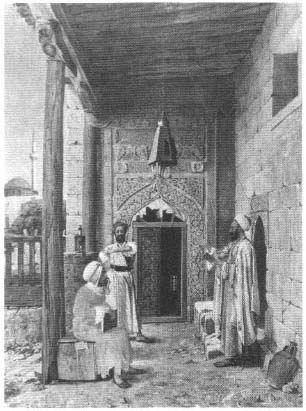
Figure 16.
Osman Hamdi, Discussion in Front of a Mosque Door, c. 1900
(Painting and Sculpture Museum, Istanbul).
ciety in the new age, distinguish him from the artists of this school. Osman Hamdi's men and women—dressed in the colorful garments of the Orientalist mode and placed in "authentic" architectural settings—are thoughtful, questioning, and acting human beings (Fig. 16) who display none of the passivity and submissiveness of Eastern subjects characteristic of the Orientalist tradition. The Orientalist paraphernalia in Osman Hamdi's paintings comments on the "difference" between Ottoman society and other societies rather than its "otherness," which European artists depicted.[86] To this extent Osman Hamdi's paintings are critiques of the Orientalist school by a "resistant" voice,[87] whose power derives from the painter's thorough acquaintance with the school's techniques and conventions. These paintings are carefully composed essays on Ottoman society, expressed in a Western vocabulary.[88]
Osman Hamdi also contributed to a book, Les Costumes populaires de la Turquie en 1873 (Constantinople, 1873), published on the occasion of the Universal Exposition in Vienna, which documented Ottoman costumes according to class and region, with photographs by Pascal Sébah (Fig. 17). The photographs all had the same format, and all were taken against a bare wall. The scenographic backgrounds of popular postcards and Orientalist paintings were deliberately avoided. This was a scholarly study of typology, aimed at an international audience:[89] "For artists, this will be an important mine of materials, for people of fashion, an interesting and instructive recreation; meanwhile the philosopher and the savant will find here numerous topics for beneficial reflection and fruitful study."[90]
Les Costumes populaires went beyond documentation to show "the diversity in the unity" of Ottoman culture.[91] The authors thus differentiated costume, which responded to conditions such as climate or profession, from clothing styles that changed constantly according to fashion.[92] But even as they revised one stereotype of Ottoman culture by insisting on its richness and pluralism, they repeated a false generalization common to European interpretations: by failing to note transformations over time and by characterizing "costumes" as timeless, they froze the culture historically.
The second Ottoman publication for the 1873 exposition, Usul-u mimari-i Osmani or L'Architecture ottomane (Constantinople, 1873), focused on Ottoman architecture. A collaborative effort by Marie de Launay, Montani Effendi (an Italian architect), Boghos Effendi Chachian (an Armenian architect), and M. Maillard (a French architect), the book illustrated the superior qualities of Ottoman monuments and reintroduced them to modern architects. The idea for this work came from Edhem Hamdi Pasa, Osman Hamdi's brother, who was minister of public works and president of the Ottoman imperial commission for the exposition. Edhem Pasa specified that the book should deal with the "rules of Ottoman architecture" and should contain "all the necessary drawings in addition to the historical and artistic descriptions of Ottoman monuments."[93]
The format of Usul-u mimari-i Osmani followed that of similar books on Western architecture. The book discussed the degeneration of Ottoman architecture in the nineteenth century and suggested remedies. A "Historical Précis" of the most important Ottoman monuments analyzed the causes of their
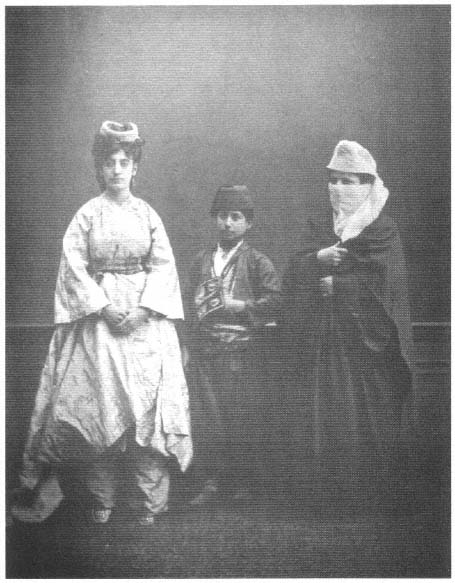
Figure 17.
Turkish women of Constantinople dressed for home (left) and the street (right);
in the center is a schoolboy (Hamdy Bey and Marie de Launay, Les Costumes populaires ).
decline. French architects, engineers, and artists were seen as a destructive influence, one that had led to a loss of purity in Ottoman architecture. The authors accused the nineteenth-century architects of Istanbul of experimenting with all known styles: "Trying in vain to adopt them, sometimes one by one, sometimes in a confusion that is ridiculous and inadequate to the requirements of Ottoman buildings—religious and other—they produce nothing but monstrous and dull designs." If Ottoman architecture continued to imitate European styles, it would soon disappear. During Abdülaziz's reign, however, some positive tendencies had emerged, and a "national art" based on a "renaissance" of Ottoman architecture, an "école néo-turque," was in sight.[94]
A chapter titled "Technical Documents" outlined the rules of Ottoman architecture. With Vitruvius's system of classification as a model, the Ottoman orders were divided into the ordre echafriné, ordre brechiforme, and ordre crystallisé, corresponding to the Doric, Ionic, and Corinthian orders. Each was described in detail, and each description ended with a few Vitruvian statements: the ordre echafriné was appropriate for the lower levels of galleries, for shops, and for every building type that required simplicity. The brechiforme was severe and heavy and was not used in civil architecture. The playful crystallisé was suitable for the interiors of civic buildings.[95]
The authors argued that the Ottoman orders, which had created many beautiful buildings in the past, should still be used because "they presented more subtlety than the commonly known classical orders." They believed that by reorganizing the principles of Ottoman architecture into a doctrine, they were serving art in general.[96] Their objective was to make a place for Ottoman architecture within the wide spectrum of Western architectural styles and to encourage the use, at home and abroad, of a neo-Turkish style.
A third book prepared under the patronage of the Ottoman government for the Viennese exposition was Le Bosphore et Constantinople (Vienna, 1873), by P. A. Dethier, the director of the Imperial Museum in Istanbul and a member of the Ottoman commission to the exposition. He noted that the Viennese exposition offered a good stage from which to present the Ottoman capital to people from around the world. The book covered historic (Byzantine and classical Ottoman) monuments as well as the major nineteenth-century buildings, such as the university and the Ministry of Defense.
These three Ottoman publications resulted from serious and systematic studies that followed Western precedents and formats. They reflected the larger goal of generating respect in the West for the Ottoman Empire, which would continue to maintain its cultural identity. For similar reasons a large collection of Ottoman photographs was brought to the United States in 1893 for the World's Columbian Exposition. Sultan Abdülhamid II donated fifty-one albums to the "National Library"[97] of the United States; at least some of them went to Chicago as part of the Ottoman display.[98] As propaganda prepared under imperial orders, the 1,819 photographs constitute a reliable record of the prevailing Ottoman self-image. They highlighted the beauty of the landscape, the grandeur of monuments (Byzantine and Ottoman, including examples from the nineteenth century), and the development of modern institutions (schools, factories, hospitals, and military establishments). Perhaps to correct the dominant Western view, images of "harem girls" and "backward occupations" were omitted.[99]
The Unofficial View: Muslim Intellectuals and Journalists at the Fairs
The Muslim intellectuals who reported on the fairs associated "progress" with the Western world. The willingness to adopt Western technology as a key to modernization dated back to the early nineteenth century. Napoleon himself had said that Egypt must be assimilated into Europe so that it could benefit from the "advantages of a perfect civilization." Similarly, the Arab scholar Rifa'a al-Tahtawi urged the lands of Islam "to pursue the foreign sciences, arts, and industries, whose perfection in Europe is a well-known and confirmed matter."[100] For al-Tahtawi, modern Europe, under the leadership of France, was the epitome of civilization, and the key to its superiority was the development of sciences.[101] Another scholar, Harayri, noted after visiting the 1867 fair that the "period of isolation and individuation is ended and everyone tries to learn from the others. Representatives of Muslim countries should attend [these fairs] so that they may examine the exhibits and learn what will benefit their countries."[102]
Several years later the Egyptian Mahmud 'Umar al-Bajuri focused on the sophisticated European machinery at the 1878 exposition."[103] In a poem occa-
sioned by the 1889 Paris exposition, another Egyptian, Muhammad Sharif Salim, mourned the past grandeur of the Arab world, celebrated the power of Europe, and voiced his love of progress and desire for a new Egypt.[104]
While the Egyptians admired the technical achievements of the Western world, they had doubts and questions about Western culture. Muhammad al-Muwaylihi, one of the first Egyptian novelists, set his novel al-Rihla al-thaniya (The second journey) in Paris during the 1900 exposition. The novel's theme was the problem of introducing European traditions to the East in a rush and through bad imitations. Western civilization had accomplished much, the novel suggested, but had created serious social problems; therefore the East should import Western technology but at the same time should defend itself against the colonialists and maintain the "patrimony."[105]
Muhammad Amin Fikri, a judge and scholar versed in both Arab classics and French legislation, analyzed the history of the theater section at the 1889 Paris exposition, wondering whether Western theater could respond to Egyptian social, moral, and aesthetic needs if women acted on the stage or were included in the audience. He decided that women's emancipation had already begun in Egypt and that Egypt should not be deprived of European-style theater.[106] In 1900, Ahmad Zaki, the director of the Translation Bureau of the Council of Ministers in Cairo, also examined the French theater in Paris from a moral, and especially a sexual, point of view. He concluded that the Comédie Française would be a "bad school for women," giving them too many ideas on intrigue and immorality.[107] In his critique of French society, then, he also expressed his desire to protect his own gender-based status.
Easterners responded enthusiastically to the unfamiliar sights at the European expositions. In 1878, Sadullah Efendi, a young Ottoman diplomat, admired the facades of the Trocadéro Palace with their beautiful columns; the museum and the concert hall; the "regular gardens," which separated the various sections of the exhibition; the viewing tower with its elevator (which he called makine, "machinery"); and especially the large fountain in front of the Trocadéro Palace. He described this fountain as "adorned with gilded sculptures of wild animals":
As one looks from the garden toward this high structure [the palace], one gets the impression that a blackbird with open wings is flying from the edge of the
pool to the exhibition Court. The bridge [Pont d'Iéna] is a paved "salon" decorated with garden benches. It is from there that one watches the life on the Seine River, which flows between the regular stone embankments as though through a marble channel.[108]
In 1889, the Egyptian writer Muhammad Tawfiq al-Bakri evoked a similar dreamy feeling by comparing Parisian buildings to renowned Islamic monuments from various regions: the large residential buildings of Paris were like the palace of Ghumdan in Yemen; the "salons," like the throne room of Chosroes at Ctesiphon; Parisian parks, like the Shi'ib Bawwan in Persia; bridges, like those of Khurrazad in Samarqand or al-Baradan in Baghdad; and palaces, like Mshatta.[109] Al-Bakri's readers knew these fabled places as the great achievements of Islamic civilization, not from firsthand experience but from legend and tradition. He and other writers were adding European accomplishments to this system of mythical references.[110]
The most celebrated landmark of the 1889 Paris exposition, the Eiffel Tower, fascinated Muslim observers. Al-Muwaylihi dedicated an entire chapter to it, calling it the Eighth Wonder.[111] Ahmad Zaki wrote enthusiastically in the guest book that the tower represented the intelligence of its engineer as well as the achievements of the French people.[112] To him the tower, with the light on its top, looked like a big candle. Al-Bakri, a Sufi sheik, thought it hid a lantern, "the red star of Suhayl."[113]
The fair in 1889 was memorable not only for such works of engineering but also for the extensive use of electricity. An anonymous editorial in the Ottoman newspaper Sabah described the major exhibition buildings at night, when the Trocadéro Palace appeared as if made of light, the fountain's waters flowed in a glowing cascade, and the illumination of the Eiffel Tower seemed the work of the skies:
The night view of the exhibition grounds is beyond one's capacity to describe. One stops in awe before a splendor seen nowhere in the world until now. There is no spot that is not flooded with light to dazzle the eye. As one sees these lights, which with marvelous mirror effects pour a gold dust on the exhibition buildings, one wants to believe that the world-illuminating sun is dispersing its power . . . [But] the honor of illuminating the nights of the Paris exhibition belongs to
the light of "electricity." If electric power did not exist, the exhibition grounds could not be illuminated as they are now. . . . It is estimated that the electricity illuminating the exhibition grounds could bring light to a city of 100,000 people.[114]
Halid Ziya, a prominent Turkish novelist, also grew emotional in describing the power of technology and electricity:
The EifFel Tower was a wonder of the time. One night, in an unexpected moment, when this iron tower three hundred meters tall was suddenly painted in red flames by an electric current, the thousands of people gathered beneath it unconsciously cried from their hearts in a startled, fearful voice.[115]
Other accounts of the 1889 exposition were more measured. The Ottoman writer Ahmed Mithat Efendi gave a comprehensive factual description, devoid of emotionalism. He first surveyed the fairgrounds and then guided the reader through various sections, focusing on the Eiffel Tower and the Galerie des Machines, both of which he described thoroughly. The parks, the gardens, and the overall planning of the exposition, "like an entire country . . . independent of the city of Paris," impressed him in their scale and their construction details and materials. The Ottoman presence here was limited to a small tobacco pavilion, which Ahmed Mithat referred to as a "lovely hut." He noted in passing the locations of other Islamic and foreign sections but did not discuss their architecture.[116]
Ahmed Mithat's attitude typifies that of the Turks who wrote about their visits to the international fairs; they did not analyze the differences between their culture and the representation of that culture abroad. Turkish newspapers described the Ottoman pavilions and products in news items without much interpretation. The Egyptians, in contrast, were deeply concerned about the image of their country. In 1889, Muhammad Sharif Salim argued that encapsulating Egypt in a café, stables (with animal drivers), and almées (dancing girls) meant deforming it.[117] In 1900 Ahmad Zaki criticized the absence of modern Egyptian industry, commerce, and intellectual life at the exposition, and he regretted the inclusion of the belly dancers.[118] These also distressed 'Isa,
the hero of Muhammad al-Muwaylihi's novel: on arriving in the Egyptian quarter, he and his friends were pleased to find the atmosphere of their native land and at first thought that Egypt was well represented—but only until the spectacle in the theater began. Then, embarrassed by the performance of two female dancers, they left in shame, determined never to return.[119] Their shame indicates the seriousness of their concern for the national image presented to the West. For them the eroticized and commercialized nature of the dance was a distortion of their culture.
The Ottoman and Egyptian visitors to the international fairs who wrote about their impressions were interested in Western civilization and what it could teach them about improving conditions at home. They shared with their governments the belief that European civilization meant progress and modernity. Nevertheless, their unofficial accounts differed from official publications, which treated the national displays as propaganda.
Back home a cynical third party disseminated its views on the fairs in local newspapers and magazines. The Istanbul-based satirical journal Diyojen published a social critique referring to the advertisements in Ottoman papers calling for products to be displayed at the 1873 exposition in Vienna: simple wooden toys, handcrafted in Eyüp, a humble quarter of Istanbul, would reveal the progress of industry; a liter of milk mixed with tap water would represent the high quality of services provided by the modernized municipal administration; and a veil would symbolize women's emancipation.[120] The satire implicitly compared Europe and the Ottoman Empire and raised the key issues of industrial development, social services, and the status of women.
The cultural images projected to international audiences at the universal expositions were sometimes carefully constructed representations of self-images and aspirations, but their impact was rarely "corrective." On the contrary, European stereotypes of the East and the notion of a clear-cut world order, as sketched by European powers, remained dominant.
2—
Islamic Quarters in Western Cities
The Midway Plaisance . . . bears the same relation to the Exposition that the sideshows have to the circus. [Here are] German, Irish, Austrian, Turkish, Javanese, and Egyptian villages, mosques, kiosks, and pagodas, menageries, panoramas, casinos, cliff-dwellers, snake-charmers, Esquimaux. . . . It is . . . a vivacious, cosmopolitan medley.
Chicago Tribune, 30 April 1893
London's Great Exhibition of 1851 opened a new era of international and cross-cultural communication. The Crystal Palace was the architectural centerpiece of this event—an iron and glass monument that served for a time as the model for exhibition halls. It was a large single hall that could be divided by partitions. As the exhibitions assumed increasingly important commercial and sociocultural roles and grew larger, however, such huge marketlike structures were no longer adequate. To portray the entire human experience—and to convey the flavor of the places represented—required a different kind of exhibition space.
By 1867 the desire for more authentic cultural representations—especially of more exotic and unfamiliar places—led to the construction of independent structures for indigenous displays. In carefully grouped constellations, these displays represented various parts of the world. To make them more realistic, people wearing their local costumes and "acting out" their typical daily activities were added.
The design of the exhibition grounds thus changed to include both an area in the Beaux-Arts manner, axial and symmetrical, with imposing structures for the main exhibition (in the tradition of the Crystal Palace) and a "picturesque" arrangement of buildings scattered in the surrounding parks and gardens. The site planning also graphically signified power relations among the exhibiting countries. It portrayed a world where races and nations occupied fixed places determined by the exposition committees of the host countries. Thus the host nation occupied the center; the other industrial powers surrounded it; colonies and other non-Western nations were relegated to the peripheries.[1]
The two-part organization was a characterizing feature of the 1867 exposition on the Champ de Mars, and the park was considered one of the main in-
novation (Fig. 18). Alfred Normand, in his learned account of the architecture of the different sections, emphasized the gardens surrounding the exhibition as "the necessary complement of the ensemble, the spectacle without equal."[2] Giving all nations the opportunity to represent themselves architecturally was a main goal in 1867. Indeed, the exhibition hall itself had been designed by the Saint-Simonian engineer Frédéric Le Play to suggest a brotherly aggregation. Its oval shape (the structure, first conceived as a circle, was changed to better fit it to the site) symbolized the globe; the hall was divided into seven concentric galleries, each reserved for a particular purpose. Industry was at the outside, followed by clothing, furniture, raw materials, history of labor, fine arts, and, in the center, a garden. Transverse segments, given to different nations, divided the concentric galleries. A visitor who walked from the outermost gallery toward the center could see all the products of one nation; a visitor who walked each concentric gallery would be able to compare the similar products of different nations.[3]
Although the park was intended to signify the peaceful gathering of nations, in reality it introduced, and even reinforced, division, in both its spatial organization and its architecture. Hippolyte Gautier remarked that outside the external walls of the "circus" was a crowd of "bizarre constructions . . . a strange city, composed of specimens from all kinds of architecture." Walking through this section seemed like taking a world tour in miniature. It was no longer necessary to take the boat from Marseilles.[4]
In scale and in architecture the major exposition structures differed notably from the indigenous quarters surrounding them. The main buildings were conspicuously located, self-conscious architectural monuments: the Eiffel Tower and the Galerie des Machines of the 1889 Universal Exposition in Paris, celebrating the spirit of the industrial age; the neoclassical buildings of the World's Columbian Exposition in Chicago; the Grand Palais and Petit Palais of the 1900 Paris Universal Exhibition. The pavilions in the parks and gardens, in contrast, were replicas in miniature of buildings in a variety of architectural styles from various cultures. Their scattered sitting and the landscape around them reinforced their modesty.
The main exposition halls and the quarters at the periphery differed, moreover, in their overall atmosphere. In the indigenous quarters the ambience was enriched by representatives of different cultures dressed in their most pictur-
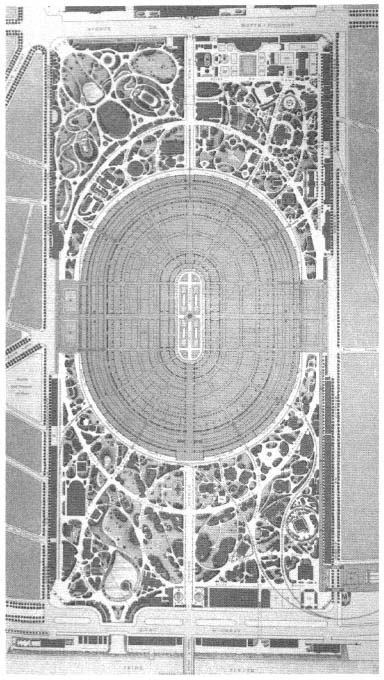
Figure 18.
Plan of Exposition universelle, Paris, 1867 (A. Alphand, Les
Promenades de Paris, 1867–73).
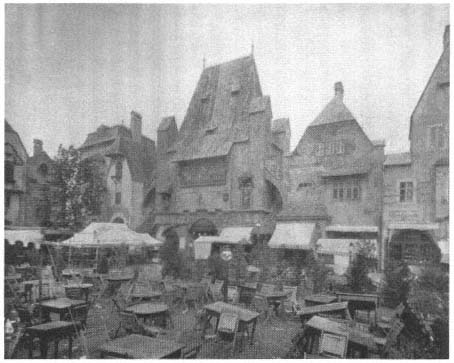
Figure 19.
Old Vienna, Chicago, 1893 (World's Columbian Exposition, vol. 2).
esque clothing. Artisans worked in the pavilions, traditional music played, and authentic food was served, unfamiliar sights and sounds mixing with exotic smells. As the urban historian and sociologist Janet Abu-Lughod argues, urban character is a matter not only of form but also of other sensuous cues.[5] The indigenous displays in nineteenth-century world's fairs appealed to all the senses and thus created the atmosphere of the places represented.
The peripheries were not reserved exclusively for non-Western cultures. There, all the nations displayed a lighter side, with the emphasis on entertainment rather than progress and economic power. For example, in Paris in 1867 the French quarter pavilions re-created the country's historical periods: a small Gothic church, a miniature Panthéon, and a Bastille Tower were scattered in a picturesque garden. Old Vienna, with its medieval architecture and beer gardens, was brought to Chicago in 1893 (Fig. 19). "Old Paris" was reconstructed on the Quai de Billy in 1900 as a collage of pavilions representing the Sainte-Chapelle, the Saint-Germain-des-Prés, the Cloisters of the Collège de Cluny, the Tower of the Louvre, and other structures (Fig. 20–21). Technology in the
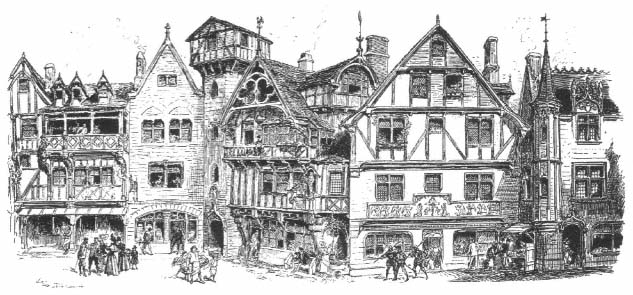
Figure 20.
Rue des Vieilles-Ecoles, Paris, 1900 (L'Esposizione universale del 1900 a Parigi, Milan, 1901).
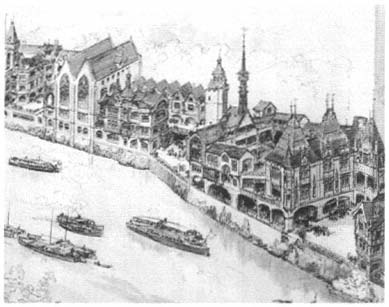
Figure 21.
Vieux Paris, Quai de Billy, Paris, 1900 ( Exposition de Paris, vol. 1).
displays at the periphery was presented as a curiosity: in 1867, France and England each erected a "lighthouse" powered by electricity.[6] Furthermore, as entrepreneurs learned to capitalize on the crowds of visitors to the expositions, quarters devoted to entertainment appeared at the outskirts of the fairgrounds. In Paris in 1889 an amusement park called the Pays de Fées was built on the Avenue de Rapp outside the gates of the fair.
In the design of the Islamic sections, particular attention was paid to "authenticity"—both of architecture and of atmosphere. The obsession with authenticity is generally associated with nineteenth-century Orientalist painters,[7] who represented architectural settings as combinations of architectural forms, fragments, and details of buildings from different places and time periods. They achieved "accuracy" not by representing particular buildings but by minutely rendering architectural details. A similar method was employed in the construction of exhibition pavilions, which were often architectural collages incorporating various periods and regions of Islamic civilization.
The art historian Linda Nochlin argues that in the realism of the Orientalist painter Jean-Léon Gérôme's works, a "plethora of authenticating details" went hand in hand with the idea of mystery and the absence of certain themes, such as history. The world represented was timeless, its customs and rituals atemporal.[8] The exhibition pavilions suggested mystery in their symbolically loaded architectural details (the intricate arabesques, the wooden latticework of the windows that connoted the seclusion of women); the decorative, often unintelligible, calligraphy on the walls; and the "curious" performances and unfamiliar musical instruments. They were also characterized by their ahistoricism, with different periods and regions often collapsed into single structures. Cultural dynamics, as expressed through architecture, were overshadowed by what was considered typical, representative, and, ultimately, timeless. Architecturally frozen in an ambiguous and distant past, Islamic cultures at the universal expositions were presented as incapable of change and advancement.
Although these themes generally determined the placement and architectural image of the Islamic quarters at expositions, the planning principles were not always the same. The changes that occurred from 1867 to 1900 mark shifts in power relations and in the struggle for Islamic and national cultural identity. An analysis of the changes sheds light on the internal logic of the exhibitions as diagrams of a world order.
Universal Exposition of 1867, Paris
As representatives of Islamic urban settings, Ottoman and Egyptian quarters were placed adjacent to each other in 1867 in Paris, and, despite their independent designs, they formed an ensemble: visitors could meander through the Egyptian street into the Turkish square. Both quarters were deliberately made irregular to reflect the tortuous streets with many dead ends of Islamic cities. The choice of an irregular urban fabric to represent Istanbul and Cairo at the fairs reflects one of the dilemmas of Ottoman and Egyptian officials and their European advisors. Even though in both Istanbul and Cairo the 1860s were marked by an intense campaign to regularize the network of streets, to create monumental avenues and vistas, and to establish large urban squares—all lessons learned from Haussmann's rebuilding of Paris—the exposition planners turned to the past, to an image that they considered outdated but that the West associated with Islam.
As I mentioned in the introduction, the definition of cultural identity was much debated among the Westernizing Turks and Egyptians during this intense period of sociocultural transformation. Some called for maintaining the old cultural forms while adopting Western technology; others wanted either to incorporate new elements into the local culture, thereby creating a rupture between the old and the new, or to evaluate and redefine their self-identity according to Western views. The architectural representations of Egypt and the Ottoman Empire in Paris in 1867 belong to the latter trend.
The Egyptian quarter at the 1867 fair consisted of three buildings on a street: a temple, a selamlik (a small palace), and an okel (a covered market, or caravansary) (see Figs. 70–75). The temple, a replica of the temple of Philae, was a museum where antiquities were exhibited; an avenue lined with sphinxes led to its entrance. Together, the temple, selamlik, and okel were intended to convey the complete history of Egypt. The temple stood for Egyptian antiquity, the selamlik for the nation's Arab civilization, and the okel for contemporary industrial and commercial life. Between the okel and the temple was a copy of Bartholdi's statue of the famous Egyptologist Jean-François Champollion, who seemed to meditate on a future when "the veil covering forty centuries of history would be torn."[9] A pavilion called the Isthme de Suez displayed docu-
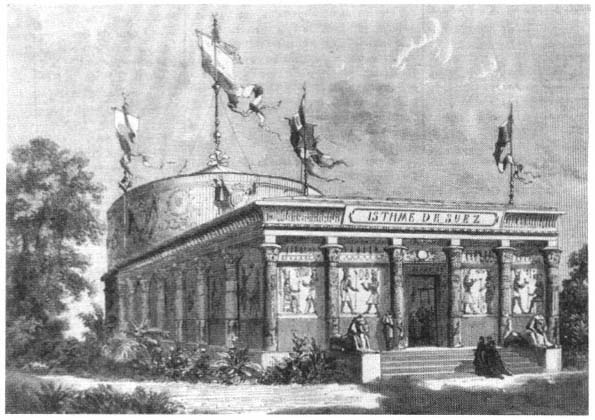
Figure 22.
Suez pavillon, Paris, 1867 (L'Exposition universelle de 1867 illustrée ).
ments and models of Ferdinand de Lesseps's work on the Suez Canal, then under construction, as well as the geography and the natural history of the site (Figs. 22–23).
In 6,000 square meters, a "condensed and miniature Egypt" was presented to the world, a "brilliant, splendid" achievement, in the eyes of the general commissary to the Egyptian exposition, and one that "revealed [Egypt's] past grandeur and its present richness."[10] The effort was applauded by the West. One French journalist, for example, argued that no other country had understood the idea of a universal exhibition as well as Egypt, which displayed its
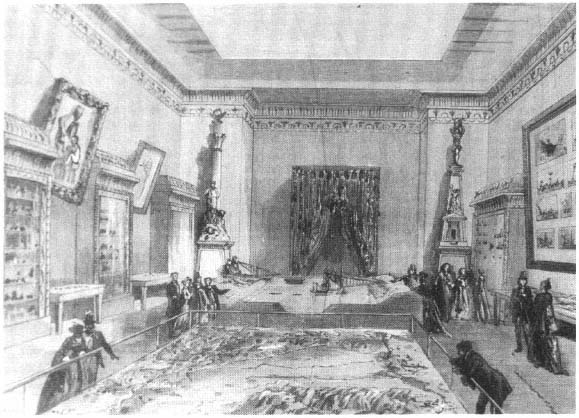
Figure 23.
Interior of the Suez pavillon, showing models of the canal area, Paris, 1867 ( L'Exposition universelle de
1867 illustrée ).
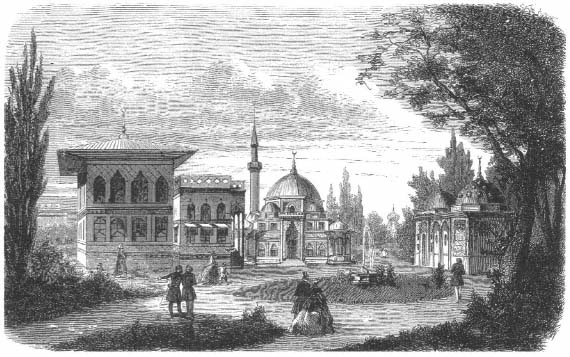
Figure 24.
The Turkish quarter, view (from left to right) of the Pavillon du Bosphore,
the mosque, the fountain, and the bath, Paris, 1867 ( L'Illustration, 2 March 1867).
past and its present.[11] Hippolyte Gautier praised the Egyptian quarter as "not only one of the most sumptuous, but also the most complete and the most instructive."[12]
The Egyptian exhibition had attempted to encapsulate Egypt's history. The Ottoman Empire, in contrast, condensed its cultural and social life in a selection of building types. The Ottoman section, designed by Léon Parvillée, was composed of three buildings—a mosque, a residential structure called the Pavilion du Bosphore, and a bath—around a loosely defined open space. In the center of this space was a fountain (Fig. 24). The mosque represented the religious sphere; the Pavilion du Bosphore, the homefront; the bath, social and cultural ritual; and the fountain, the public sphere. On the occasion of Sultan Abdülaziz's visit, a triumphal gate to the quarter was erected; with its formal
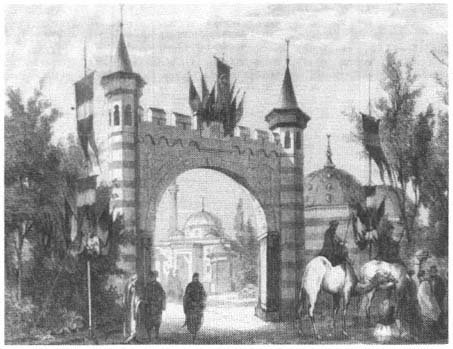
Figure 25.
Gateway to the Turkish quarter, Paris, 1867 ( L'Exposition universelle de 1867 illustrée ).
references to the gates leading to the different courts of the Topkapi Palace and its imperial tugra , "sultan's seal," it symbolized the imperial presence (Fig. 25).
Like that of the Egyptian section, the layout of the Turkish quarter was deliberately irregular, even though the basic premise—a square open space with a fountain in the center, surrounded by buildings with symmetrical facades—did not call for it. This arrangement was derived not from Turkish precedent but from French academicism. The idea was to create by irregularity an "authentic" and "picturesque appearance."[13]
Not far from the Egyptian-Ottoman complex was another Islamic section, composed of the Tunisian and Moroccan exhibitions (Fig. 26). Perhaps because of their associations with bedouin culture, both had tents for the display of products. Tunisia also had a residential structure, called the Palace of the Bey
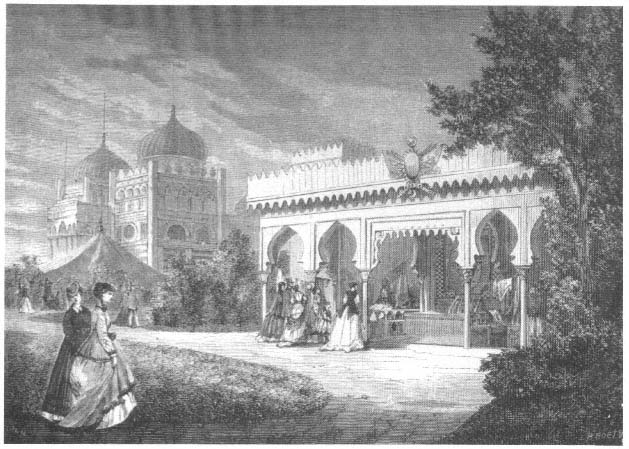
Figure 26.
Tunisian palace, Moroccan tent, and Moroccan stables, Paris, 1867 ( L'Exposition universelle de 1867 illustrée ).
because the bey of Tunisia had stopped there briefly during his visit to Paris. The two domes of this palace and the tents created an Islamic skyline. Strolling from the Quai d'Orsay toward the main exhibition hall, a visitor would see first these domes and tents and then the domes and minarets of the Egyptian and Ottoman parks. Hippolyte Gautier called the entire section the Quartier Oriental:
The entire Orient is before you; do not look for machines here, or for the practical inventions of the human mind; you are in the domain of contemplative life: the agreeable precedes the utilitarian, and poetry is intricately mixed into the smallest detail of existence.[14]
People dressed in colorful local costumes, Middle Eastern music coming from the pavilions, and the aromas of local cuisines from the cafés gave the quarter the real flavor of the Orient. According to one observer, "the illusion was complete. . . . To see the Orient . . . it is enough to get on the omnibus."[15]
Universal Exposition of 1873, Vienna
The precedent set by the Ottoman and Egyptian quarters at the 1867 exposition determined the format in Vienna six years later. The main exposition building was a longitudinal structure with a domed central section. The Ottoman and Egyptian pavilions were in the southeastern part of the park in front of the main hall (Fig. 27). Once again picturesque landscaping brought the two displays into relation and created an Islamic village on the periphery of the fairgrounds.
The Ottoman quarter consisted of seven small structures: a main pavilion carefully duplicating the Sultan Ahmed Fountain (1728) in Istanbul and presenting it as an example of Ottoman architecture (see Fig. 66); a high domed pavilion, the Sultan's Treasury, where valuable items such as jewelry were displayed (Fig. 28); a residential structure based on the Yali Kösk in Istanbul and reminiscent of the Pavilion du Bosphore of 1867; a bath, along the lines of Parvillée's bath in 1867; a café (Fig. 29), and a small two-story building with a bazaar on the first floor and residential apartments on the second floor (Fig. 30).[16] Whereas all the Ottoman buildings in 1867 were designed according to a set of clear principles that followed historic references, here the main pavilions quoted monuments, and the commercial structures interpreted vernacular traditions.
Unlike the Ottoman section, the Egyptian section consisted of a single building, composed of several distinct parts (Fig. 31). The dominant feature was a pavilion that duplicated the funerary complex of Sultan Qaytbay in Cairo from the late Mamluk period (1470s), its minaret and dome carved in arabesques and star patterns. A second minaret, with a square base, possibly inspired by the minarets of the mausoleums of Salar and Sanjar al-Jawli from the early Mamluk period (1300s), marked the other end of the structure. The eclectic styles in between enhanced the impression of a street facade rather than suggesting a single building. As in the Ottoman section, the structure referred to both the monumental and the vernacular.
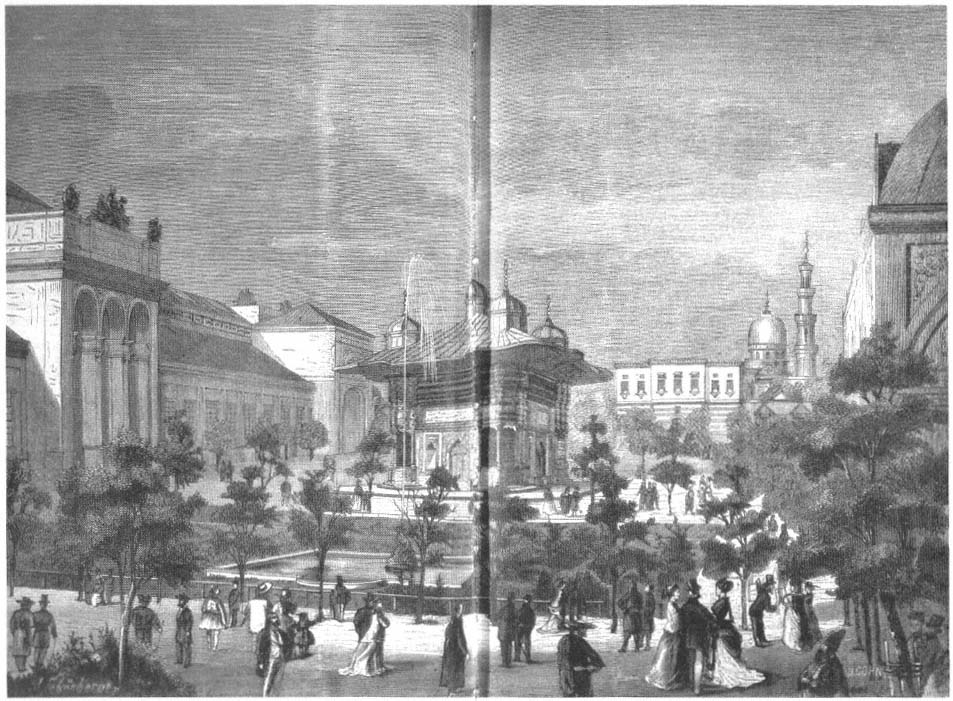
Figure 27.
The Ottoman section, with (left) the main exhibition hall and (background)
the Egyptian buildings, Vienna, 1873 (L'Esposizione universale di Viena, no. 10).
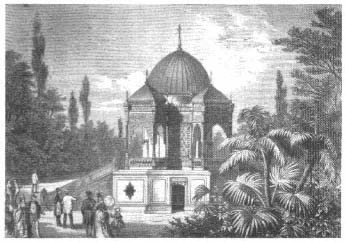
Figure 28.
Sultan's Treasury, Vienna, 1873 (L'Esposizione universale
di Viena, no. 19).
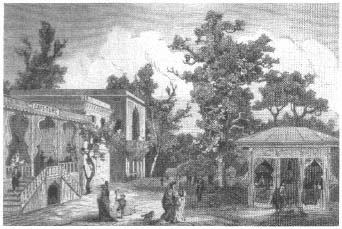
Figure 29.
Turkish café, Vienna, 1873 (L'Exposizione universale
di Viena, no. 36).
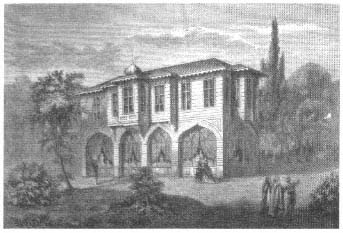
Figure 30.
Turkish bazaar, Vienna, 1873 (L'Esposizione universale
di Viena, no. 16).

Figure 31.
Egyptian section, Vienna, 1873 (L'Esposizione universale di Viena, no. 3).
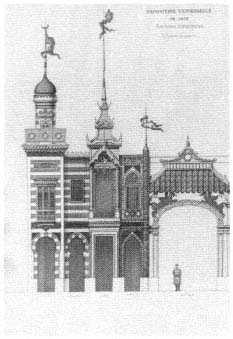
Figure 32.
Jacques Drévet's drawing of (from left)
the Tunisian, Morroccan, Siamese, Persian,
and Annam pavilions, Paris, 1878 (Jacques
Drévet, architecte ).
Universal Exposition of 1878, Paris
The desire to bring more order to the peripheries may have led organizers of the 1878 exposition to introduce a new linear arrangement, a Rue des Nations (street of nations), where a series of national pavilions would be erected. Although the facades were to be 5 meters wide, some nations (Belgium, Switzerland, Russia, England, the United States, and Italy) were allowed more width; the pavilions of Morocco, Tunisia, and Persia followed the 5-meter rule.[17] The idea was to create an architectural collage, with each nation represented according to its own taste and tradition. While illustrating the architectural diversity of the entire world in a short span, the street would also raise the issue of "national" architecture. For Hippolyte Gautier and Adrien Desprez, the Rue des Nations was "the most original, the most novel [idea] of the exposition."[18]
Morocco, Tunisia, and Persia were the only Muslim countries represented on the Rue des Nations (Fig. 32).[19] The task of searching for an architecture that would symbolize these Muslim nations (as well as Siam and Annam
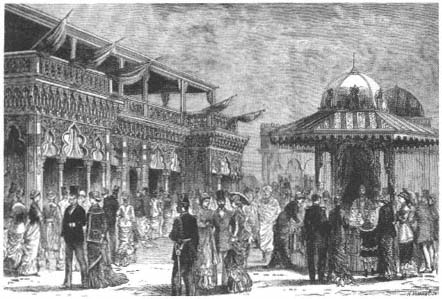
Figure 33.
An Oriental bazaar in the Trocadéro Park, Paris, 1878 (Bibliothèque Nationale,
Département des Estampes et de la Photographie).
[Vietnam]) was assigned to Jacques Drévet, a French architect, who had designed the Egyptian quarter in 1867. His ensemble of four facades attracted little attention and was deemed "of no importance and scarcely demanding notice."[20] The Spanish building at the exposition also had an Islamic facade. The structure comprised three sections, the two end pavilions "more sober in style" and the central one adorned with details from the Alhambra and the Great Mosque of Cordoba.[21]
Other Islamic pavilions in 1878 were sited to show their relationship with France. Algeria, France's most important and most turbulent colony; Tunisia, which would become a French colony in just four years; Morocco, which would take another two decades; and Egypt, then under the control of an Anglo-French debt management commission, were all in front of the Trocadéro Palace, representing France, whose arms, like those of a protective father/master encircled these North African nations (Figs. 33–34).

Figure 34.
View of the Trocadéro, with the Islamic quarter at right, Paris, 1878 (Bibliothèque Nationale,
Département des Estampes et de la Photographie).
Universal Exposition of 1889, Paris
Inspired by the Rue des Nations, the 1889 exposition further developed the commercial potential of the street and brought together on it a number of thematically connected displays. Two memorable streets of the fair, the History of Habitation (L'Histoire de l'habitation) and the Cairo Street (Rue du Caire), included Islamic representations, both claiming archaeological and historical accuracy. Neither was merely an open-air museum; as nineteenth-century streets they incorporated urban and commercial life and became places of "spectacle."[22]
The History of Habitation consisted of forty-four dwellings intended to tell the story of "the slow but inevitable march of humanity through the ages."[23]
Located in a longitudinal park along the Seine, these houses contrasted in scale and style with the Eiffel Tower behind them. They were designed by Charles Garnier, renowned perhaps as much for his hostility to the expression of iron structure in buildings as for his Paris Opera. The "palaces, grottoes, tents, villas, cottages, huts, and various shelters forming the Exposition of Human Habitation" voiced tectonically Garnier's protest against Eiffel's work.[24] Ironically, their location at the foot of the tower brought them to the forefront of the fair. The siting was particularly fortunate, because Garnier intended them as an architecture of spectacle, "a moving panorama, where all habitations parade before us."[25]
The houses were presented in two main categories: prehistorical and historical. In the first group were natural habitats (in the open air, in sheltering woods, in rocks and grottoes) as well as some simple structures; in the second group were the structures of "primitive civilizations" (e.g., Egyptian, Assyrian, Phoenician), civilizations arising from Aryan invasion (e.g., Hindu, Persian, German, Gallic, Greek, and Roman), and, finally, "contemporary [versions] of primitive civilizations"—those that "did not exert any influence on the general advance of humanity" (e.g., Chinese, Japanese, Eskimo, Indian, Aztec, Inca, and African).[26] Although presented as a historical survey, the display featured anthropological and ethnographic elements: the dwellings were decorated in "typical" ways, and a "native" in authentic costume welcomed visitors.[27] Furthermore, it included contemporary civilizations other than Western, thereby adhering to the definition of anthropology as the study of societies considered spatially and temporally distant.[28]
Garnier did not consider his survey complete; he thought of the entire display as a "scenario," with several stars and a supporting cast. He insisted, however, that the dwellings themselves were historically accurate, that they reflected a "general type" based on a synthesis of crucial elements. He argued that in them "the resemblance to truth was truer than truth itself" (le vraisemblable est bien plus vrai que la verité ).[29]
The History of Habitation included two Islamic houses, an Arab and a Sudanese (Figs. 35–36). Working in collaboration with a historian, A. Ammann, Garnier produced a book that presented a scholarly basis for the houses displayed at the exposition. The goal was to trace the development, the marche en avant, of the human habitat; Garnier and Ammann argued that the Muslim house offered little to this development because "Mohammadism sterilized all the regions it invaded."[30]
Basing their findings on travelers' accounts of Arabia, the authors declared that the Arab house had not changed over time; in its overall simplicity, it resembled the nomad's tent and consisted of women's quarters, men's quarters, and outbuildings. Rooms were either square or rectangular, and courtyards were essential. In its ornamentation, however, the Arab house in the most splendid period of Arab history, the eighth and the ninth centuries, was remarkable. In houses of this period horseshoe arches were supported by elegant colonettes; arabesques were important decorative motifs, and brilliant colors

Figure 35.
Arab house, Paris, 1889 (Garnier and Ammann, L'Habitation humaine ).
were used.[31] The authors described Muslim life as they knew it from literature and painting: "The ideal of happy life consisted of resting lazily in a cool place, surrounded by exquisite light and forms. Oriental life flowed, softly and voluptuously, behind these walls burning in the sun."[32]
Emphasizing that the Muslim house "had played no direct role in the grand architectural revolution of the Renaissance," Garnier displayed only two examples. The Arab house consisted of cubical masses enlivened with musharabiyyas (lattice woodwork on the windows) and an arcaded courtyard with horseshoe arches. To give a complete view of the design to passersby, only half of the courtyard was built. The Sudanese house, even simpler, was a rectangular structure with walls from 2 to 2.50 meters high; its only opening to the exterior was a small door.[33]
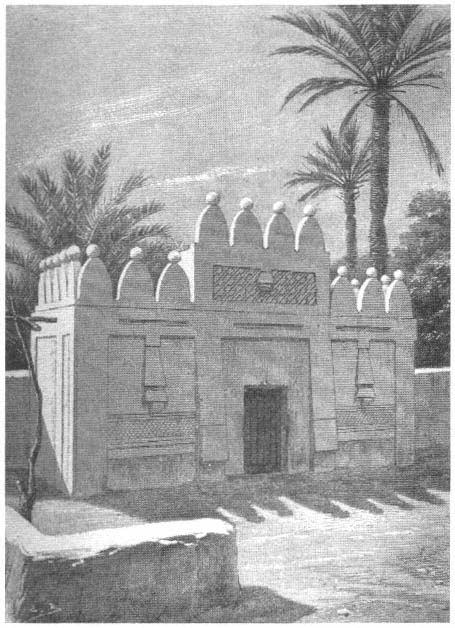
Figure 36.
Sudanese house, Paris, 1889 (Garnier and Ammann, L'Habitation humaine ).
Garnier understood Islamic culture as one that was fixed in history and was not a valuable resource for modern civilization. He argued that the salvation of Islamic architecture would be achieved by colonization: "the French conquest has just begun . . . to change [the] antique physiognomy" of Algerian, Tunisian, and Moroccan architecture.[34]
Although Garnier presented the History of Habitation as an educational display, it was not necessarily received as such. The critics, by now familiar with the "authentic" representations of previous fairs, claimed Garnier's pavilions were not based on reliable documents but only on the architect's imagination. They argued that the result was "absolutely fanciful" and did not convey the "impression of truth and of life." The dwellings were "children's toys without any scientific utility." Furthermore, they were located randomly, "Oriental architecture next to European, only to daze the visitor."[35]
Like the History of Habitation, the Rue du Caire vacillated between archaeological ambitions and the desire for spectacle. Its author Delort de Gleon, according to some sources, was a wealthy Frenchman who had lived in Egypt for about twenty-five years and was willing to pay for the exhibit.[36] The title page of the booklet Gleon wrote on the Rue du Caire, La Rue du Caire à l'Exposition universelle de 1889, describes him as the "architect and general commissioner of the Egyptian section." Although Charles de Lesseps was nominated president of the committee, Gleon told his readers that Lesseps gave him carte blanche to create the Egyptian section.[37]
Delort de Gleon collaborated with a young architect named Gillet. Using recycled architectural fragments (musharabiyya s, window and door details, decorative details, etc.) from demolished buildings in Cairo, the two men created a neighborhood street of twenty-five houses, representing different periods and styles of Cairene residential architecture (Fig. 37).[38] Gleon's stated goal was to gather "various motifs from all belles époques " of Cairo's history.[39] To complete the Cairene atmosphere, he integrated a religious monument into the street, a reduced copy of the Sultan Qaytbay complex, which he declared "the most gracious monument" of Cairene architecture,[40] with its minaret, dome, and surface details that added picturesqueness to the perspective.[41] Inside, the mosque was richly decorated with marble-covered walls, ceiling patterns highlighted in gold, and delicate woodwork.[42]
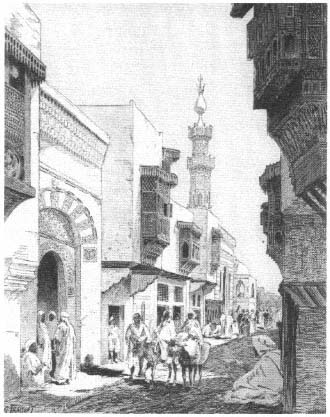
Figure 37.
Rue du Caire, Paris, 1889 (Bibliothèque Nationale,
Département des Estampes et de la Photographie).
Although he insisted on the authenticity of his representation, Gleon diverged from Cairene models in making the street wider than a typical Arab street (to allow the railroad to pass through) and in keeping building heights (including that of the minaret) lower because of construction problems. Otherwise, the buildings were "absolutely exact" and "faithfully reproduced."[43] In fact, the Rue du Caire on the Champ de Mars was more authentic than the streets in Cairo itself, because, Gleon argued, it was impossible to find an untouched old street in Cairo. The old houses with musharabiyya s no longer abutted each other, but were "separated, alas, by modern houses in bad taste!" Collectors now salvaged beautiful parts from the old buildings of Cairo.[44]
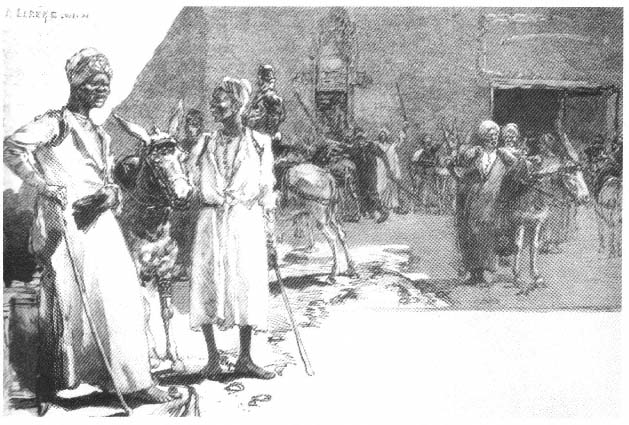
Figure 38.
Donkey drivers on the Rue du Caire, Paris, 1889 ( Revue de l'Exposition universelle de 1889, vol. 1).
Many visitors to the exposition, Egyptians and Europeans alike, admired the local color of this street. Hippolyte Gautier was fascinated by the "authentic pieces . . . picked by a collector of great taste, by a real artist."[45] An Egyptian visitor noted that "even the paint on the buildings was made to look dirty."[46] A French observer agreed: "You are in Cairo; a winding and picturesque street opens in front of you, with its musharabiyya s, its ingenious wood lattices, . . . its balconies projecting on the street."[47]
The "spectacle" of the street—the musicians, male and female dancers, artisans, and donkey drivers who crowded it—was intended to contribute archaeological exactitude (Fig. 38).[48] That commerce and entertainment overshadowed

Figure 39.
Esplanade des Invalides, site plan, Paris, 1889 (Alphand, Exposition universelle internationale
de 1889 à Paris ).
Gleon's concern for accuracy is illustrated by the mosque. Muhammad Amin Fikri, an Egyptian visitor, noted in disgust: "Its external form as a mosque was all that there was. As for the interior, it had been set up as a coffeehouse, where Egyptian girls performed dances with young males, and dervishes whirled."[49]
The 1889 exposition turned out to be a national celebration for France rather than an international event like earlier expositions. Because it celebrated the centennial of the French Revolution, many governments (among them that of the Ottoman Empire) declined to participate, as a protest against the ideals of the revolution.[50] Undeterred, France proceeded to display its power in a grandiose manner, as illustrated, for example, by the huge platform dedicated to its colonial possessions. Both "to convey a real idea of the economic state of [France's] diverse possessions overseas" and to show the nation to the subject people, the French organized the Esplanade des Invalides between the Quai d'Orsay and the Rue de Grenelle as a "striking display" of "original buildings" and artifacts (Fig. 39). The Algerian and Tunisian palaces occupied a prominent location at the entrance to the esplanade from the embankment. Behind
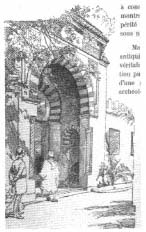
Figure 40.
Gate of the Tunisian
souk on the Esplanade
des Invalides, Paris,
1889 (Monod, L'Exposition
universelle de 1889, vol. 2).
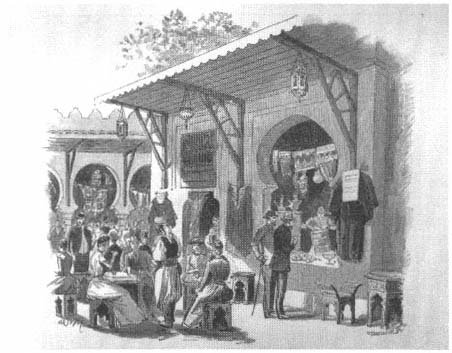
Figure 41.
Markets on the Esplanade des Invalides, Paris, 1889 ( Revue de l'Exposition
universelle de 1889, vol. 2).
them souks, cafés, and restaurants clustered, complete with a replica of a Kabyle village and bedouin tents (Figs. 40–41).[51] A crowd of "[indigenous] people of all races, all colors, and all classes" filled the winding streets of the
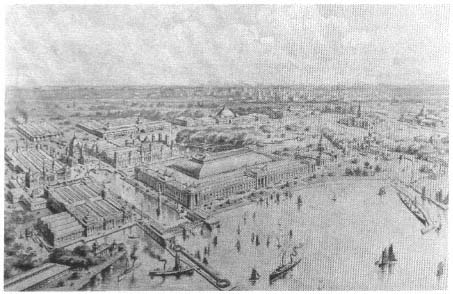
Figure 42.
Aerial view of the Chicago exposition, 1893 ( Rand, McNally and Co.'s Pictorial
Chicago and the World's Columbian Exposition, Chicago, 1893).
esplanade, their diversity creating "a profound impression of the grandeur [of France]." Here the colonized, dazzled by French civilization, could understand the privilege of being part of it.[52]
World's Columbian Exposition of 1893, Chicago
The contrast between the academic planning of the main exhibition and the deliberate haphazardness of the periphery was perhaps nowhere as striking as at the World's Columbian Exposition of 1893, held in Chicago (Fig. 42). The World's Fair, as it was commonly called, was a turning point in the history of American architecture. Under the supervision of Daniel Burnham, Jackson Park on the Chicago waterfront was developed into a "dream city," the forerunner of the City Beautiful movement. Burnham had appealed to the par-
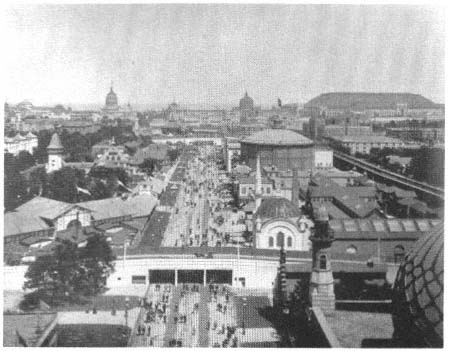
Figure 43.
View of the Midway from the Ferris wheel: (right) the Ottoman quarter, with the
mosque at its entrance, and, next to it, the Egyptian section with obelisks,
Chicago, 1893 (The Dream City, vol. 1).
ticipating architects for uniformity of design—to be achieved by the use of the classical style. Here was a mode in which the leading American architects of the late nineteenth century, most of them trained in the Beaux-Arts system, felt at ease. With the collaboration of the great landscape architect Frederick Law Olmsted, the "White City" was created, with its lagoons, long axes and vistas, and white classical monuments. The scale was large, and the exhibition was the most complete urban-scale project realized since the planning of Paris and Vienna in the 1860s.
The concern for uniformity in urban design and architecture seemed to disintegrate beyond the main sections on the waterfront. The exotic missions were placed along the Midway Plaisance, an avenue six hundred feet wide that extended for a mile west of the Women's Building (Fig. 43). There was, however, an order in the site plan of the seemingly chaotic national villages.
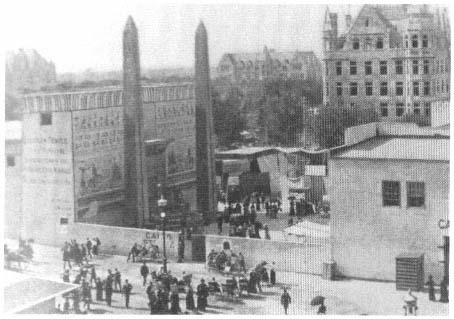
Figure 44.
Entrarce to the Egyptian quarter, Chicago, 1893 (Rossiter, A History of the
World's Columbian Exposition, vol. 2).
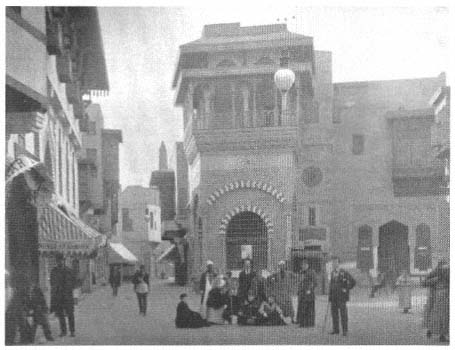
Figure 45.
Cairo Street, Chicago, 1893 (World's Columbian Exposition, vol. 2).
According to a contemporary literary critic, Danton Snider, the Midway was organized as a "sliding scale of humanity. The Teutonic and Celtic races were placed nearest to the White City; farther away was the Islamic world, East and West Africa; at the farthest end were the savage races, the African Dahomey and the North American Indian."[53] The Committee on Ways and Means had decided in advance that the Midway would have an "ethnological and historical significance" and thus some scientific respectability.[54] Echoing the Rue des Nations theme, the committee specified that here
the style of architecture in each case . . . be characteristic of the country represented. It will thus be seen that in addition to the beautiful buildings erected by the Exposition there will also be a grand display of architecture from every part of the world, making the variety of design so extensive as to be bewildering in its outlines.[55]
Thus the indispensable Cairo Street put on its show in Chicago (Fig. 44). Its facade on the Midway had "nothing artistic" about it; passersby had no clue to the life of the street from the plastered exterior wall. But once inside the gate, visitors saw a lively array of shops and houses, a café, the "solemn spectacle" of a mosque,[56] two obelisks, a "Temple of Luxor," and a much talked-about theater where the belly dance was performed.[57] The street itself was "just as crooked as one has a right to expect in a Cairo thoroughfare" (Figs. 45–46). A Chicago Tribune reporter argued that the Egyptian quarter had the "picturesque beauty and strangeness of 'Masr-al-Kahia,' as the natives termed the famous city, which stands near the site of old Babylon." The picturesqueness was enhanced by the projecting upper levels of the buildings:
Beautiful balconies and bow windows are seen, while here and there relief is given by a carved balcony. All the windows are protected by graceful woodwork and many of them are made of stained glass. The shades in the windows are attractive. No paint covers the closely-woven Meshrebieh screens which protect them.[58]
As in Delort de Gleon's Rue du Caire, the materials were shipped from Egypt "in order that Cairo street scenes may be represented,"[59] and consequently the buildings enjoyed "a polish and color that only age could bring."[60]
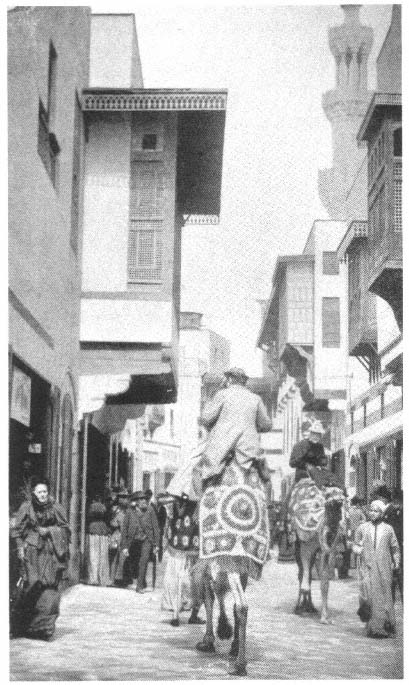
Figure 46.
Cairo Street, Chicago, 1893 (The Dream City, vol. 1).
The authenticity of the architectural, as well as the social, reproduction pleased many:
Architecturally, the street, long and winding, was perfectly reproduced; the shops were real shops, not mere exhibits, and it required only American money and a kind of polyglot French to strike a bargain. The attendants were Egyptians; and real citizens of Cairo lived in the upper stories of the houses, and loitered or hurried through the street, touching, jostling the cosmopolitan sightseers, who alone seemed foreign here. Donkeys and camels were steeds and vehicles. . . . From an open door came the music of an Oriental theater, and from a balcony hung a girl of sunny Egypt, . . . [and] barefoot babies played around the doorsteps or joined the motley throng that watched an Egyptian juggler on the corner; with a clanking of gilded chains and trapping, a band of pilgrims, camel-mounted, returned from Mecca; or preceded by a waving sword and escorted by many guests, a bride rode camelback to the temple: and up and down the throughfare and in and out of mysterious dark passages moved . . . the normal life of the Egyptian settlement.[61]
A mosque announced the Ottoman presence on the Midway (see Fig. 43), recalling its more elaborate 1867 counterpart in Paris. The high dome and minaret made the mosque one of the symbols of the Midway while helping to define the entrance to the Turkish Village. The village, also referred to as the Business Street of Constantinople, was designed to recall the Byzantine Hippodrome in the Ottoman capital (Fig. 47). The outstanding feature was an obelisk, a wooden replica of the Egyptian obelisk on the Hippodrome in Istanbul, whose lettering had been transferred to plaster casts, carved on the site in Turkey, and shipped to Chicago in sections. A low balustrade, like that around the original, protected the replica.[62] This was the first display at an exposition of Istanbul's Byzantine past as part of Ottoman culture—it had been added, perhaps, because the Egyptian displays, as well as the Tunisian and Algerian pavilions, included material on ancient history. The Hippodrome, however, was not simply meant as a cultural symbol; it included a track for horse races, and it also served as an entertainment center, where visitors could watch "fantasias and exercises by a number of dromedaries, harnessed and caparisoned according to Arabic fashion." The Arab horses and dromedaries were chosen from the best breeds and shipped to Chicago.[63]
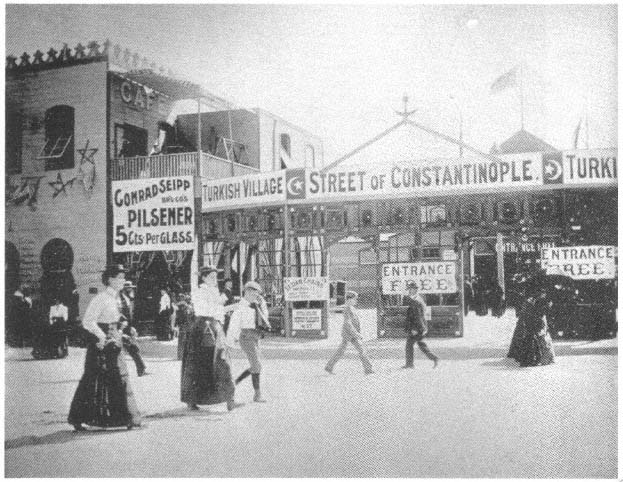
Figure 47.
Entrance to the Street of Constantinopole, Chicago, 1893 ( Glimpses of the World's Fair ).
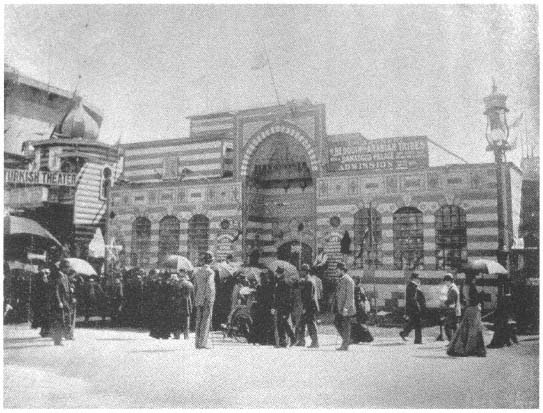
Figure 48.
Damascus palace, Chicago, 1893 (Glimpses of the World's Fair ).
At the center of the village was a Turkish restaurant in a cubical building with a three-tiered facade and overhanging cave that was topped by a small dome. In its overall form and architectural features, this structure repeated the themes of the main Ottoman pavilion in Jackson Park. The rest of the street was lined with shops; there was also a Turkish theater as well as a fortune-teller's tent in front of the obelisk.[64] In the Turkish Village and adjoining the theater, the city of Damascus was represented by a pavilion called the Palace of Damascus, and by an encampment (Figs. 48–49). The palace's large single
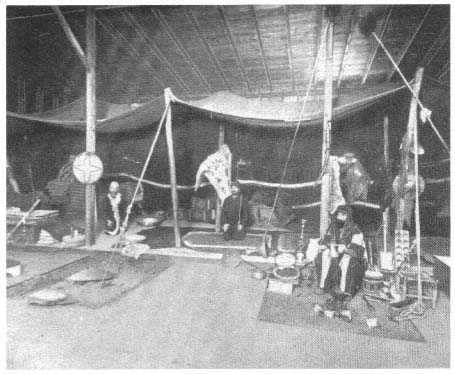
Figure 49.
"Camp of Damascus colony," Chicago, 1893 ( World's Columbian Exposition, vol. 2).
room was richly decorated, with a wide divan all around, and in its marble-paved vestibule was an octagonal fountain. Photographs representing Syrian tribal life and characteristic landscapes hung on the walls. In addition to performances in the theater, an "Oriental wedding ceremony" was acted out daily in the palace, complementing the performances in the theater.[65]
The Universal Exposition of 1900, Paris
The 1900 "exposition of the century," like the 1878 exhibition, had a street of nations but at a more visible location (Fig. 50). The Street of Nations now occupied the Quai d'Orsay between the Pont des Invalides and the Pont de l'Alma, the bridges connecting the two principal sections of the exhibition, the Champ de Mars-Trocadéro and the Esplanade des Invalides-Avenue Nicolas II
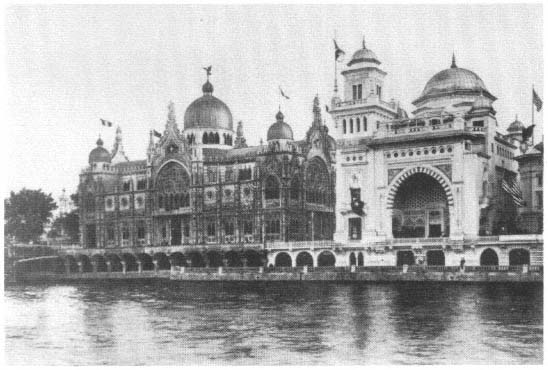
Figure 50.
Rue des Nations, with Ottoman pavilion to the right, Paris, 1900 (Bibliothèque Nationale,
Département des Estampes et de la Photographie).
along the waterfront. Nations considered more important were given larger sites facing both the river and the street.
The allocation of space to Islamic countries in the 1900 exposition made evident a hierarchical classification. The Ottoman Empire and Persia, both sovereign nations, had their pavilions on the Rue des Nations. The Ottoman Empire, perceived as more important politically, also faced the embankment and was located between the pavilions of Italy and the United States, whereas Persia's much smaller pavilion sat on the back row, between Peru and Luxembourg. Egypt, now accepted as a British colony, was with the other colonies in the Trocadéro Park.
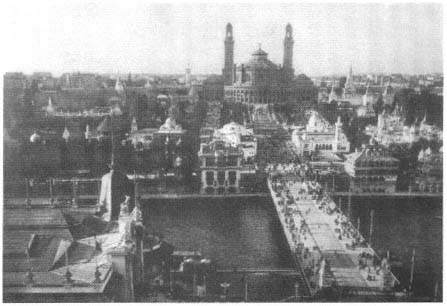
Figure 51.
View toward the Trocadéro Palace, with (foreground) the Iéna Bridge, (right)
the Algerian palace, and (left) the Tunisian palace, Paris, 1900 ( Exposition
universelle internationale de 1900, vues photographiques, Paris, 1900).
The displays of the Ottoman Empire and Persia were confined each to a single building. Egypt still had its temple, bazaar, and theater, but this time in a single three-part structure. Now it was the French colonies of North Africa that represented the full exotica of the Muslim world. The palaces of the two important colonies, Algeria and Tunisia, were in the Trocadéro Park, on the main avenue bisecting the park itself and the Champ de Mars and connecting the Trocadéro Palace to the Eiffel Tower via the Iéna Bridge. Viewed from the Iéna Bridge, with the Trocadéro Palace behind them, they helped to define the axis of the exposition grounds and complemented the larger palace stylistically with their Islamic references (Figs. 51–52). Seen from the palace, with the Eiffel Tower in the background, their white stucco masses and their facades abstracted from various precolonial monuments contrasted with the engineering aesthetics of the tower, thus juxtaposing the industrial progress of the empire and the timelessness of its colonies (Fig. 53). The juxtaposition offered a visual symbol of the French colonial tactics of assimilation and contrast.[66]
The Algerian Palace, given the "place of honor" in the Trocadéro Park, was a "symmetrical and coherent" building.[67] Inside, however, was an entire Rue
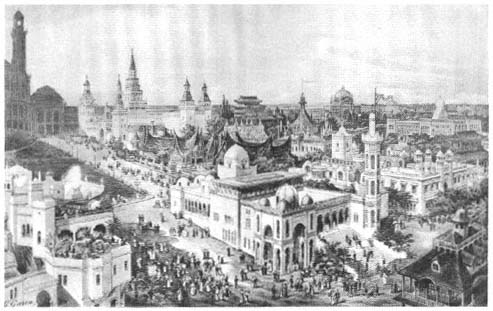
Figure 52.
View of the Trocadéro Park with (center foreground) the Algerian palace, (lower left)
the Tunisian palace, and (background) the Trocadéro Palace, Paris, 1900
(Bibliothèque Nationale, Département des Estampes et de la Photographie).
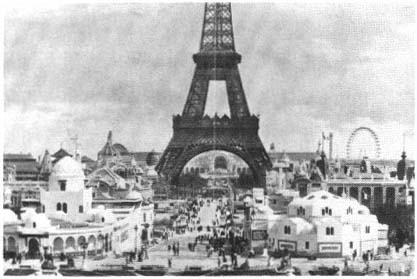
Figure 53.
View toward the Eiffel Tower from the Trocadéro Park, with (right) the
Tunisian palace and (left) the Algerian palace, Paris, 1900 ( Figaro
illustré, no. 124, July 1900).
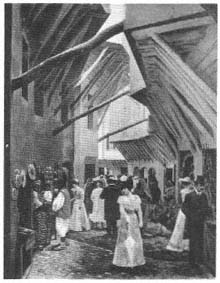
Figure 54.
Rue d'Alger, Paris, 1900 (Bibliothèque
Nationale, Département des Estampes
et de la Photographie).
d'Alger, winding picturesquely, replete with two-story houses with projecting second stories, musharabiyya s, decorated doorways, and shops on the street level.[68] It was considered "a faithful reproduction of one of those tortuous streets" (Fig. 54).[69]
The Tunisian exposition was next to the Algerian village, and the entire complex was called the Ville Arabe. It was an agglomeration of architecture from Tunisia: a replica of a fountain from the Rue Sadun in Tunis, a minaret from the Great Mosque of Sfax, a copy of the Mosque of Sidi-Maklouf from Kef, a zawiya (Sufi convent) from the Casbah Square in Tunis, the Bab al-Jadid gate from the walls of Tunis, and another old town gate from Soussa—all surrounding a large court. The main pavilion was a model of the Mosque of Sidi Mahres in Tunis. In sum, this village represented "all the towns of Tunisia."
The pieces were integrated by vaulted picturesque passageways and irregular streets, all designed "as though by chance." One observer remarked:
One could swear that these buildings are inhabited; the angles are rounded, the rough-cast broken, the tiles frosted—this imperceptible steam which represents time—and the stones, skillfully made up, display the superb reddish color of limestone in the countries loved by the sun.[70]
The appeal to the senses was complete. Even the smells were authentic. Here one could "breathe the smell of Africa," one Frenchman noted, "and for us, the colonizers, the smell of Africa is delicious."[71]
Although a concern for authenticity continued to inform the architectural representation of the French colonies, a new interest in symmetry emerged in 1900, with the result that the picturesqueness was hidden behind uniform screens or regularized along an axis. The enclosing of the Rue d'Alger clearly manifested the first tendency; the site plan of the Tunisian quarter revealed the second: the pavilions of the "village" were placed axially and symmetrically around a central open space. Furthermore, the entire Tunisian section was neatly hidden behind "regular facades, meeting at right angles."[72]
The 1900 Paris exposition expressed changing attitudes about French architecture. The 1889 exposition celebrated great engineering achievements, whereas the two major buildings of the 1900 exposition, the Grand Palais and the Petit Palais, returned to the vocabulary of "high art." Charles Girault, the architect of these buildings, which were intended as permanent structures, used modern engineering techniques and materials but clad the facades in classical masonry.[73] Undoubtedly, the classical architecture of the 1893 World's Fair in Chicago was influential in this change. Along with the return to classicism, a stricter control was exercised in planning the fairgrounds in 1900, and picturesque effects were minimized. Although the buildings on the Rue des Nations were designed in many different styles, they were neatly aligned and their regularized siting complemented the symmetry and axiality across the river. Moreover, in the turn-of-the-century exhibition, the haphazardness of the indigenous villages was tactfully hidden from immediate view.
After four decades, the Islamic world no longer seemed exotic. Islamic nations' displays at the international fairs had entertained Westerners and had taken them to distant lands, nurturing their imaginations by offering them unknown sights, images, foods, drinks, music, and dance. At the fairs, the Orient that European writers, scholars, and artists had defined and described (in Edward Said's word, "constructed") since at least the beginning of the nineteenth century was presented as a three-dimensional living model. Thus it was brought to the West and incorporated into Western culture. Moreover, with the expansion of colonial territories, the exotic increasingly belonged to the Western powers.
3—
Search for Identity:
Architecture of National Pavilions
The style is not a clearly determined one, or rather, it is a mixture of styles borrowed from mosques, caravansaries, private houses.
A visitor to the 1878 Universal Exposition, quoted in Sylviane Leprun, Le Théâtre des colonies
At the international expositions, the architecture of the main Islamic pavilions was based on that of the homeland—its key monuments and, to a lesser degree, its residential and commercial structures. The style was predominantly "Islamic," except in the Egyptian section, where there was always a "temple" in the style of an ancient Egyptian kingdom.
Two types of pavilions stood out in the Islamic sections: the replica of a building from back home and the exhibition hall per se. Replicas were sometimes artifacts themselves, serving their original functions and therefore introducing social and cultural traits of the represented country. The mosque was a major focus of curiosity as a symbol for Islam that appealed to the sense of religious otherness defining Muslim societies for Westerners. The first exhibition mosque was built in 1867 by the Ottoman Empire in Paris; others appeared regularly at subsequent fairs.
Like the exhibition mosque, the model residential structure, displayed as an artifact, made its debut in 1867 in the Egyptian, Ottoman, and Tunisian pavilions,[1] along with various public structures, such as fountains. In some cases, the replicas were adapted to new functions according to exhibition needs. Thus an Egyptian "temple" might be a museum, and a bath, or even a mosque, might be a marketplace.
The exhibition hall was not modeled directly on any known building but was designed to fit the requirements of the national display. Algeria's exhibition hall in a neo-Islamic style in 1878 set a powerful precedent: it synthesized indigenous architecture by combining elements from various monuments. This eclecticism allowed large-scale fragments (such as portals, minarets, and towers) to be integrated into the new composition.
Although the Islamic pavilions were often similar and were thus perceived as belonging to a single cultural tradition, their architecture in fact varied according to the politics, culture, and wealth of the particular country. This chapter
analyzes the national pavilions chronologically, starting with those erected by the Ottoman Empire. During the period considered here, 1867–1900, the empire maintained its political sovereignty while gradually losing its economic independence. The long struggle in the empire between modernization and the preservation of a historical identity intensified during these years.
The Ottoman Empire
Sultan Abdülaziz's desire to partake in the cultural life of Europe was reflected in the meticulous attention given to the design and construction of the Ottoman pavilions for the 1867 Universal Exposition in Paris. As noted in the preceding chapter, the Ottoman Empire was represented at the 1867 fair by an ensemble of buildings-as-objects: a mosque, a residence, a bath, and a fountain. Ottoman agricultural, industrial, and artistic products were displayed in the main exhibition halls. The 1867 pavilions marked a turning point in Ottoman architectural history as the end products of a theoretical study whose terms were defined in Europe. Although the change appears to have been enforced from the outside, it should be understood within the general framework of Westernizing reforms undertaken by the ruling elite. French architects initiated and practiced the academic approach, but it was endorsed wholeheartedly by the Ottoman commissioners to the exposition. Furthermore, the Ottoman buildings at the 1867 fair themselves affected European architectural thought. If they heralded a new theoretical viewpoint from which the Ottoman architectural heritage could be assessed and recycled, they also revised European architects' and architectural critics' stereotypes of Islamic architecture as a merely sensuous play of decorative devices.
The Ottoman pavilions were designed in Istanbul by a self-trained French architect named Léon Parvillée in collaboration with the Italian architect Barborini. Parvillée had been commissioned earlier by the Ottoman government to document and restore the fourteenth-seventeenth century monuments of Bursa.[2] An ardent follower of Eugène-Emmanuel Viollet-le-Duc, the proponent of rationalism in nineteenth-century architecture, Parvillée sought to discover some of the "rules" of Ottoman architecture in his measured drawings of Bursa's buildings. For example, in the Mausoleum of Mehmed I (known as the Green Mausoleum because of its colored tile facades) he discovered that the
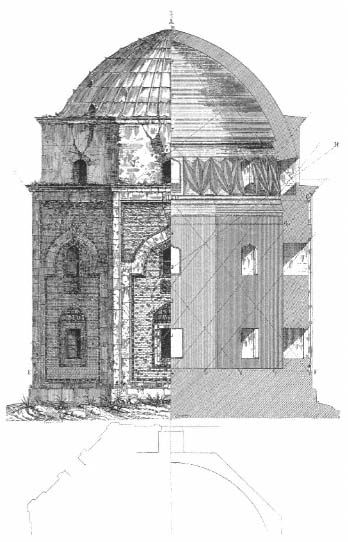
Figure 55.
Parvillée's drawing of the Mausoleum of Mehmed I
(Gazette des architectes et du bâtiment, special issue,
Paris, 1867).
height of the interior space from the floor to the top of the dome was obtained by the superposition of two Egyptian triangles, whose height equals five-eighths of the base (Fig. 55). On the basis of geometric analyses, Parvillée argued that Ottoman monumental architecture and its decoration were systematic and that the triangle was the primary form of geometric composition.[3] In Architecture et décoration turques (Paris, 1874), Parvillée presented his discoveries as a "key, a link, a reasoned explanation [une explication raisonnée ]" of the

Figure 56.
Parvillée, plan of the mosque, Paris, 1867 ( Gazette des architectes
et du bâtiment, special issue, Paris, 1867).
compositional principles of Ottoman architecture. He claimed that he was correcting the interpretation of "Oriental art" as purely a product of fantasy.[4]
Viollet-le-Duc wrote the preface to Architecture et décoration turques, praising Parvillée's studies for their "spirit of examination and analysis, necessary for the discovery of truth in the sciences just as in the arts." Parvillée, he continued, demonstrated the role of "cold science" in these artistic productions, which on the surface seemed to belong to a world of dreams.[5] In his analyses Parvillée took part in a broad contemporary debate. The concern with science and geometry in architectural design and the links between Islamic architecture and geometric principles were widely discussed in France, and not only in Viollet-le-Duc's circle. For example, César Daly, a prominent architect and architectural theorist, in his review of Owen Jones's Plans, Elevations, Sections, and Details of the Alhamhra (1842–46), emphasized that "geometry [was] the base of all form studies" and that "to become a great artist, one had to combine science and art," science meaning geometry in this context.[6]
A similar line of thought was pursued by Anatole de Baudot, who reviewed Parvillée's pavilions in the Gazette des architectes et du bâtiment .[7] Baudot, looking for a theoretical premise in the Ottoman architecture in the 1867 fair, concluded that these buildings were based on harmonic proportions, in accord with Viollet-le-Duc's theory of proportions. Baudot felt that the pavilions of other countries lacked the serious, instructive, and novel aspects of the Ottoman (and Egyptian) pavilions. Although they amused the public, such structures failed to inform and interest the architect.[8]
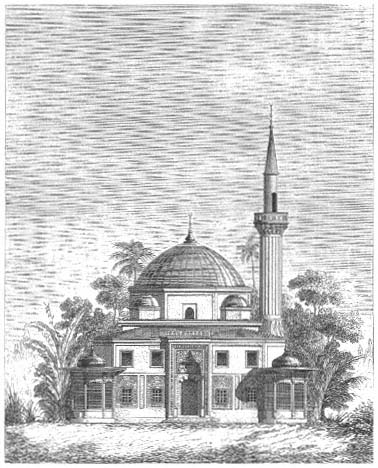
Figure 57.
Parvillée, facade of the mosque, Paris, 1867 ( Gazette des
architectes et du bâtiment, special issue, Paris, 1867).
The "rules" of Ottoman architecture "discovered" by Parvillée and acclaimed by Baudot and Viollet-le-Duc have not been challenged by historians of Ottoman architecture. While their premise is open to question, their impact was concrete in the Ottoman pavilions in 1867, which appeared as an awkward marriage of Ottoman architectural forms and the rules of French academicism.[9]
The mosque had a main hall, called the salle du mihrab by Parvillée, as well as a rectangular room divided into three parts: the ablution hall, the salle des horloges, and the entrance lobby where shoes were stored (Figs. 56–59). Two
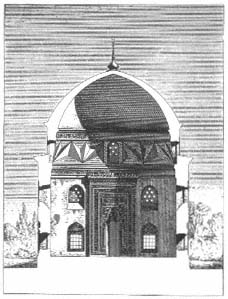
Figure 58.
Parvillée, section through the mosque,
Paris, 1867 (Gazette des architectes et
du bâtiment, special issue, Paris, 1867).
round symmetrical "verandas" framed the mosque. There were no precedents in Ottoman mosque types for such an arrangement of spaces and functions. Ablution fountains were either outside—in the courtyards or along the facades—or at the center of interior halls under large domes, as in the fourteenth- and fifteenth-century Bursa examples. A salle des horloges and verandas were not components of mosques. The architect thus had integrated these new elements into his mosque, using Ottoman forms to create a symmetrical Beaux-Arts plan. The verandas, for example, were shaped like sebil s, "drinking fountains." The only element breaking the symmetry was the inevitable minaret. Parvillée demonstrated his knowledge of Ottoman architecture and his sensitivity to scale and proportion by not doubling this element for the sake of symmetry. According to Théophile Gautier, because of Parvillée's care in reducing the scale of the Bursa mosque by exactly one-half, the re-creation gave the same impression as the original. The ornamentation, however, already very delicate in Bursa, became much too "cute" (mignonne ) for Gautier.[10]
Baudot approved Parvillée's use of a "very original" geometric canvas as well as his juxtaposition of green, blue, white, and yellow tiles on a blue background. The rich harmony of the decoration and the variety of its geometric combinations seemed to Baudot to offer valuable lessons to contemporary artists.[11]

Figure 59.
Interior view of the mosque, Paris, 1867 ( L'Exposition universelle de 1867 illustrée ).
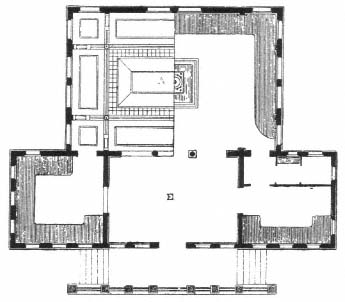
Figure 60.
Parvillée, plan of the Pavillon du Bosphore, Paris, 1867
(Gazette des architectes et du bâtiment, special issue,
Paris, 1867).
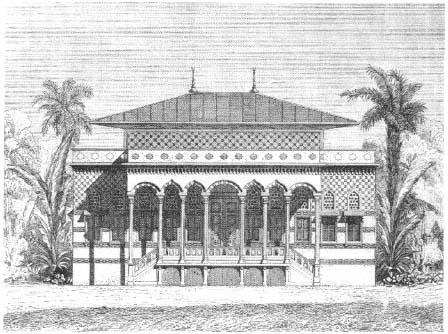
Figure 61.
Parvillée, facade of the Pavillon du Bosphore, Paris, 1867
(Gazette des architectes et du bâtiment, special issue, Paris, 1867).
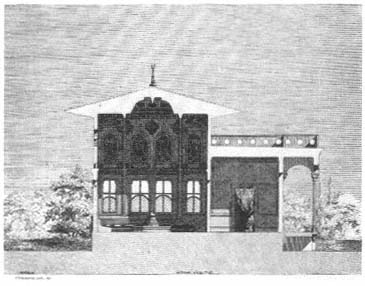
Figure 62.
Parvillée, section through the Pavillon du Bosphore, Paris, 1867
(Gazette des architectes et du bâtiment, special issue, Paris, 1867).
The residential structure, the Pavillon du Bosphore, consisted of a vestibule and a main hall (Figs. 60–63). The vestibule opened to a terrace and had service rooms at either end that communicated with the large main room,[12] which was surrounded by a built-in divan covered with colorful fabric. The water in the small pool in the center was perfumed with jasmine.[13] Baudot found the exterior of the building "picturesque and agreeable in its proportions but very simple." Inside, however, the main room was interesting, especially for its colors and light. Daylight entered at two levels from three sides, softened by the stained glass of the lower level's windows. The lower interior wall was defined by the windows and simple woodwork, the upper one by decorative panels; the ceiling was exquisitely detailed in wood. The dominant colors inside were green, blue, red, and white. Arguing once again that modern European art should learn how to use this rich resource, Baudot concluded that the contemporary French interior, covered with papier-mâché and "loud paintings," was "shabby" (mesquin ) and banal by comparison.[14] Such sentiments about ornamentation were not restricted to the architectural community but were also expressed in the popular press. One reporter wrote: "Ah, we Occidentals, who believe that we know all about the refinement of luxury; there is a lot for us to learn from the Orientals . . . on the art of interior decoration."[15]
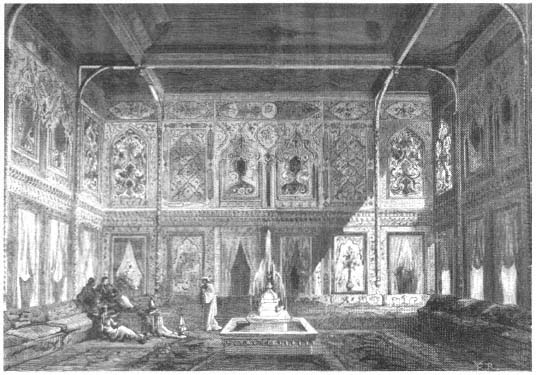
Figure 63.
Interior of the Pavillon du Bosphore, Paris, 1867 ( L'Exposition universelle de 1867 illustrée ).
Parvillée's bath had three rooms: a dressing room (at right in Figs. 64–65), a warm room (center), and a main room, lined with benches, with a small pool in each corner (left). A dome pierced by small lanterns in the Ottoman fashion rose over the main room. Symmetry was achieved on the exterior by a second dome over the dressing room. For Baudot, the point here was the faithful repetition of an Ottoman building type.[16]
Baudot was cautious in basing any conclusions about Ottoman architecture on these pavilions. He admitted that the construction raisonnée of Ottoman architecture could not be clearly understood through these temporary structures, but he claimed nonetheless that the high quality of their interior decoration, along with the coherence (unité ) and the "rather significant frankness of expression" of these structures, made them interesting to study.[17] Within the general framework of late nineteenth-century Western architecture, the key
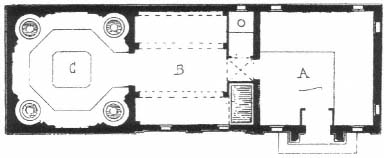
Figure 64.
Parvillée, plan of the bath, Paris, 1867 ( Gazette des architectes
et du bâtiment, special issue, Paris, 1867).

Figure 65.
Parvillée, facade of the bath, Paris, 1867 ( Gazette des architectes et du bâtiment,
special issue, Paris, 1867).
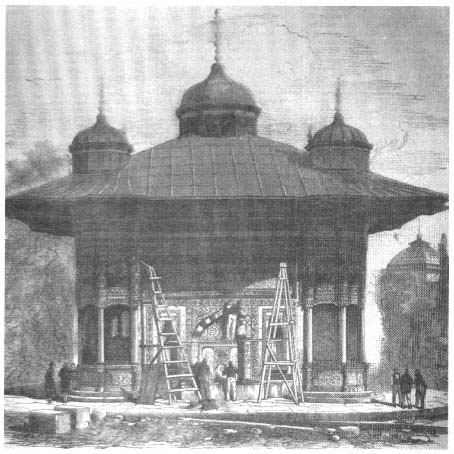
Figure 66.
Ottoman pavilion, Vienna, 1873 (L'Esposizione universale di Viena, no. 3).
terms are "coherence" and "frankness of expression," the interrelated goals of the time.
The "Ottoman style" (Osmanli biçiminde ) pavilion of the 1873 Vienna exposition, a replica of the Sultan Ahmed Fountain near Hagia Sophia in Istanbul, records a similar concern with historical precedent (Fig. 66). The Sultan Ahmed Fountain is a small pavilion with a sebil at each corner from which water and sherbet were served to the public. The elaborately carved facades and the rounded corners reflect a baroque influence on eighteenth-century Ottoman architecture in Istanbul. There were several reasons to exhibit this building abroad: its scale was appropriate for pavilions; it was a highly visible
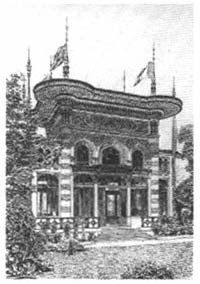
Figure 67.
Pavilion of Turkish Tobacco,
Paris, 1889 (Bibliothèque
Nationale, Département des
Estampes et de la Photographie).
public monument belonging to the recent past; it was a fresh interpretation of Ottoman forms under European influences; and, finally, it was a playful structure.
The 1873 building, unlike the pavilions of 1867, was a faithful full-scale copy. Ottoman artisans had crafted the details of the facade panels, and most of the materials (such as the tiles of the overhanging eaves) were brought from Turkey. Authenticity was a primary goal.
The other two Ottoman buildings erected in Vienna in 1873 were looser interpretations of Ottoman styles. The Sultan's Treasury was a two-story centralized structure, covered with a high dome, that may have derived from royal mausoleums (see Fig. 28). Outside, it had a large staircase to the main level and arcaded projecting porches. Because the building housed a valuable collection of jewels, its design was deliberately "luxurious" in detail.[18] Indeed, due to the exorbitant amount of money spent on it, the government ordered that some of the furniture be reused. The magnificent display cases were later placed in schools, museums, and other public buildings at home.[19]
The architecture of the Sultan Ahmed Fountain was recycled in the 1889 Paris exposition in the Pavilion of Turkish Tobacco (Fig. 67). Although it was
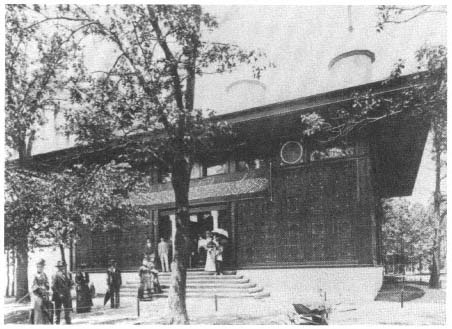
Figure 68.
Ottoman pavilion, Chicago, 1893 (World's Columbian Exposition, vol. 2).
not a major presence at this fair, with its overhanging roof, tripartite facade, rounded corners, and clearly delineated horizontal bands, it came to represent Ottoman architecture. As mentioned earlier, the Ottoman government had chosen not to participate in this exposition.
At the 1893 World's Columbian Exposition in Chicago the main Ottoman pavilion, placed with other national pavilions in Jackson Park, away from the Midway Plaisance, again referred to the Sultan Ahmed Fountain, described now as a "landmark of splendor and magnificence" by an Ottoman spokesman (Fig. 68). But the Chicago pavilion experimented with an approach different from that of the Vienna pavilion, for it was designed as an exhibition building—a new and consciously created type. Built on a larger scale than the fountain, the 1893 pavilion interpreted the formal and decorative principles of the historical structure, editing out some features (the curving sebil s at the corners) and adding others (the stairs leading to the central entrance). The pavilion's tripartite facade was simpler than that of the fountain. The rectangular structure, boxier than the original, had an overhanging roof, which further emphasized
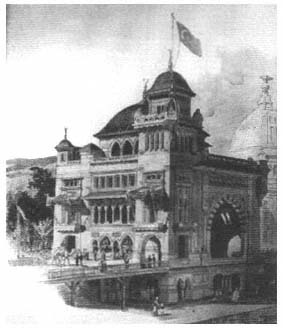
Figure 69.
Ottoman pavilion, Paris, 1900 (L'Esposizione
universale del 1900 a Parigi ).
its horizontality. Although the roof with its eaves and domes mimicked that of the Sultan Ahmed Fountain, the arches over the side door and windows, with their pointed tops (not visible in Fig. 68), were departures from the original model. The exterior decoration of the stone fountain was evoked in the wood panels of the facades, "carved in arabesques and traceries," fabricated in Damascus by local artisans and shipped to Chicago.[20] The orthogonal panels created an overall planar effect. This was almost a "modern" building, and according to some sources it was designed by a Chicago architect named J. A. Thain, although the scheme was specified by the imperial commission.[21]
The Ottoman pavilion at the 1900 Universal Exposition in Paris was an elaborate exhibition hall on the Rue des Nations (Fig. 69; see also Fig. 50). As if to compensate for its absence from the 1878 and 1889 expositions, the Ottoman government spent the considerable sum of $70,000 on the 1900 pavilion, designed by the French architect Adrien-René Dubuisson. A two-story porch delineated by a vast pointed arch dominated the riverfront. The structure had a bazaar, artisans' workshops, and a café on the ground floor; an in-
dustrial exposition on the first floor; and, on the second floor, a military museum modeled after the Military Museum in the Church of Hagia Eirene in Istanbul and a theater where operettas representing vignettes from Turkish life were performed.[22] Unlike other, earlier, Ottoman pavilions, which borrowed easily recognizable fragments from well-known monuments and combined them anew, this building made no direct reference to particular Ottoman monuments; it was an experiment in a broadly defined neo-Islamic style.
Western observers were puzzled by the style of this pavilion. An American observer described it as a "handsome structure, but Turkish throughout"; he seemed pleased that "no critic had yet ventured to place it in the renaissance style."[23] Others used known references to explain it. One French writer thought that Dubuisson had been inspired by "the most beautiful monuments of Constantinople, in particular the Mosque of Süleyman from the mid-seventeenth century [sic ]," accepted by many as the high point of the Turkish style. This same writer linked the great arch facing the river with the Mosque of Sultan Qaytbay in Cairo from the late Mamluk period, which had no relation to the "Turkish" architecture of Istanbul.[24] Another observer saw in it elements of architecture from the mosques of Qaytbay, Süleyman, Beyazid, and Murad IV as well as from Hagia Sophia and the Fountain of Top-Hane.[25] Still another proposed that here was a brilliant synthesis of pure Ottoman architectural forms:
Under the pretext of Orientalism, only Arab art—true or imitation—has been presented to us Occidentals until now. But Monsieur Dubuisson is showing us at last, for the first time, pure Ottoman art. . . . Here the eminent architect has made a synthesis of Ottoman art. In an ensemble that he brilliantly conceived, he grafted the important parts and true details of the most beautiful monuments of the pure style of Turkey.[26]
The discrepancies among the accounts reflect the building's potpourri of forms and elements, in most cases highly reinterpreted, from Islamic architecture of different periods and regions. Several buildings erected in Istanbul toward the end of the nineteenth century reveal a similar eclecticism—for example, the 1889 Terminal of the Orient Express, designed by the German architect Jachmund, who incorporated references from several regions of Islam (Mamluk, Moorish, and Ottoman) into the facades of a technologically advanced structure that was a well-established "type," the train station (see Fig. 103).
Egypt
The architecture of the Egyptian section in the 1867 Paris exposition was a major undertaking, similar in size and ambition to that of the Ottoman quarter. The Egyptian buildings, designed by Jacques Drévet and E. Schmitz, however, were products of a school of thought diametrically opposed to Parvillée's. Drévet did not write about his ideas, but they were described by Charles Edmond, the commissioner general of the Egyptian display, in L'Egypte a l'Exposition universelle de 1867:
We would be impetuous to look for a rule or a law in the development of Arabic architecture; it does not exist. The Orient lacks this ordering spirit that our Occident has brought to everything it has created since the Germanic invasion; in its place, the arbitrary and the capricious reign. Therefore, we are not trying to describe the architectonic system of Arabs; they don't have anything like it; and just as the diverse elements of their buildings are disconnected, the history of their art is also disjointed.[27]
Edmond argued that the details of Egyptian monuments were "capricious." The Arabs "tormented the dome in a thousand ways," and they made the arch go through "charming tortures"; the colonette arabe, far from displaying the rigorous proportions of the Greek column, was thin, svelte, and fragile. A true characteristic of this art was the "arabesque," into which "the Arab had poured his whole heart and a soul full of fire."[28]
The Egyptian section, like the Ottoman, contained a replica of a residential structure (Fig. 70). The selamlik was divided into an exposition hall and a pavilion de repos for Isma'il Pasha on his visits to the fairgrounds.[29] The building had a symmetrical cruciform plan, expressed on the exterior by large projections. A dome, covered with arabesques and terminating in a golden crescent, crowned the tower at the center; it was supported by horseshoe-shaped arches on delicate columns. Alternating bands of blue and white lined the facades; the crenellated roofline was white. An entrance portal (at right in Fig. 70), leading to the khedive's private rooms, dominated the main facade, it was framed by a double arch of red and white marble.[30] The two side doors (one visible at left in Fig. 70) served as public entrances.
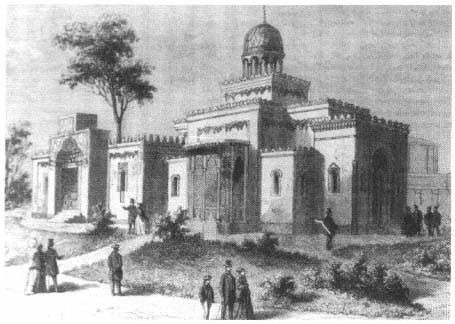
FIigure 70.
Palace of the khedive, Paris, 1867 ( L'Exposition universelle de 1867 illustrée )
Inside, a "great sobriety of colors and lines" generated "a quiet harmony," but bright colors and light enlivened the verandas. The atmosphere created by Drévet's decorative scheme, executed by French artisans from the Maison Bernard et Mallet,[31] recalled that of the Gamaliyya Palace in Cairo, where the khedive was born. Although Drévet's structure was a "perfect palatial example," it also embodied the main theme of Egyptian Muslim architecture according to Charles Edmond: "In an Arab building, everything is decoration, and the beauty of the ensemble depends on the harmonic and difficult fusion of the details."[32]
Egypt also brought the okel, a commercial building type, to the exhibition in 18O7 (Figs. 71–73). Despite its historic references, this building represented the arts and crafts of modern Egypt, the "living Egypt, the Egypt of Isma'il Pasha"; Edmond pointed out that its parallels in Western architecture were the arcades, the Parisian galleries.[33] Attached to it was a barn that sheltered two dromedaries and two donkeys.[34]
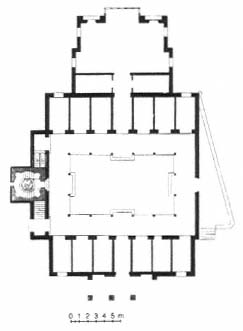
Figure 71.
Drévet, plan of the okel, Paris, 1867
(Gazette des architectes et du bâtiment,
special issue, Paris, 1867).
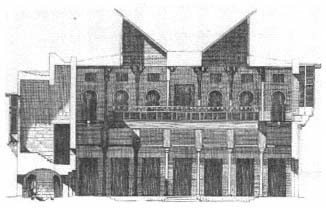
Figure 72.
Drévet, section through the okel, Paris, 1867 (Gazette
des architectes et du bâtiment, special issue, Paris, 1867).
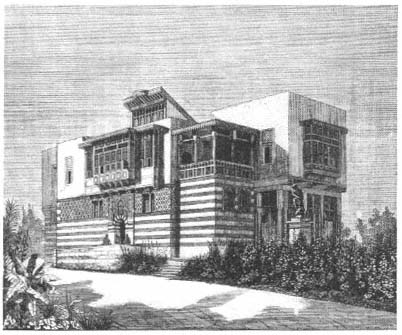
Figure 73.
View of the okel, Paris, 1867 (Gazette des architectes et du bâtiment,
special issue, Paris, 1867).
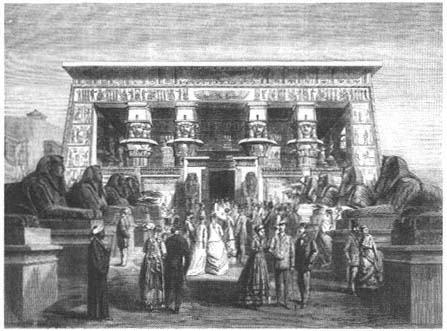
Figure 74.
Egyptian temple, Paris, 1867 (The Illustrated London News, 16 November 1867).
In the West an okel is more commonly known as a caravansary, a wholesale market that also provided rooms for travelers. Drévet's interpretation of this structure was considered an interesting use of Egyptian architectural forms and construction methods in modern buildings.[35] Its general outline and details were adapted from several okels —including those in Aswan (the okels of Shaykh 'Abd al-Mansur and Sidi 'Abdallah); the musharabiyya s duplicated those of the Gamaliyya Palace and the Husayn Bey Residence in Cairo.[36] Drévet's okel was a rectangular two-story structure with arcades on both stories and a covered central court, which had a fountain at its center.[37] On the ground floor was a café and shops that faced each other along the length of the building. Here "Oriental hospitality was demonstrated by free coffee, chibouk, and narghile, and music was performed."[38]
The second story of Drévet's okel, like the first, was given over to commerce. Artisans embroidered and made jewelry, lace, saddles, and harnesses; vendors sold fancy pipes, mats, and various trinkets.[39] On this floor was also
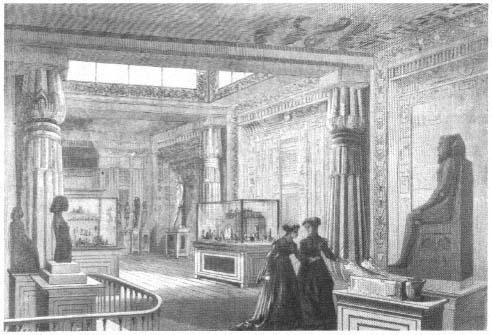
Figure 75.
Interior of the Egyptian temple, Paris, 1867 ( L'Exposition universelle de 1867 illustrée ).
the popular "anthropological museum," where hundreds of skulls (some dating from the Egyptian antiquity) and mummies from different centuries were displayed.[40] The second-floor rooms had projections with musharabiyya s, which gave the building a picturesque exterior and created playful effects of light in an interior French rationalist architects praised for its details: the doors had a "correct scale" and a "happy proportion"; the woodwork of the musharabiyya s demonstrated a remarkable compositional integrity because of "grids of great rigidity" yet "varied design."[41]
The Egyptian temple at the 1867 exposition was not in an Islamic style but looked back in Egypt's history (Figs. 74–75)—" A living lesson in archaeology," in Mariette-Bey's words,[42] which demonstrated the keen interest at the time in Egyptian antiquity and the direct role of French scholars in the field. The Egyptologist Mariette-Bey had selected articles for display here from Bulaque Museum, which he himself had established. As a member of the commission nominated by Isma'il Pasha to organize the exhibition, he had also
collaborated closely with the architect Drévet in the design of the pavilion. Mariette-Bey's preference to replicate the Temple of Philae prevailed; for him the temple was not "to embellish the exposition uselessly,"[43] but to show the entire world a "magnificent summary" of antique Egypt. Charles Edmond argued that this building and the artifacts in it reconstructed the oldest ideas of human civilization, from religion, arts, industry, customs, and traditions to the great heroes and feats of the past.[44]
An avenue of sphinxes led to the temple because every temple had to have its own "sacred way." The rectangular building itself measured 18 by 25 meters; it was 9 meters high. Slightly tapered pillars defined the four corners. Four columns on the shorter side and seven on the longer supported the entablature and the corniche, which gave the roof its strong horizontality. The design of the interior had to diverge from the Philae model. To bring in sufficient light for a public exposition hall, a glass roof was erected; "the few rays of light that Egyptians distributed mysteriously in their sanctuaries" would not have been enough. The interior divisions of the original structure were also discarded. Everything else, however, was realized with "the greatest authenticity in the ensemble and in minute detail," down to the colors. To achieve the exact proportion of the columns and other elements, precise measurements and photographs were taken at Philae.[45] With the decoration replicated on the interior walls, the illusion of authenticity was so complete that visitors claimed they felt surprised and strangely uprooted when they first encountered this temple, which seemed to belong to the banks of the Nile.[46]
The architecture of the ancient kingdoms became an accepted symbol of Egypt. In 1878 Mariette-Bey, now commissioner general of the Egyptian exposition, introduced to Paris a dwelling from Pharaonic times, a "severe" cubical building with two massive towers flanking the main facade (Fig. 76). The structure was based on his own archaeological discoveries in the town of Abydos; because some of his archaeological documentation was ambiguous, the dimensions were approximate. The facade details were not exact copies but derivations. Although this building, like the 1867 temple, was intended as a museum for the display of antiquities from the Bulaque Museum, the French organizers of the exposition decided to exhibit these objects, together with other antique works, in the galleries of retrospective art. Thus Mariette-Bey's pavilion became an exhibition hall for the art and industrial products of modern Egypt.[47]
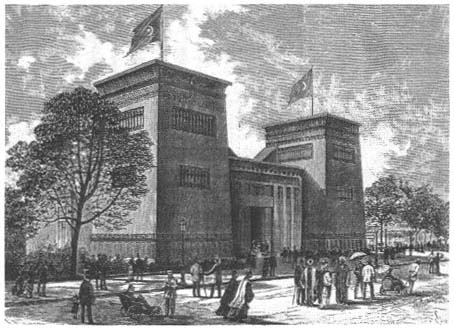
Figure 76.
Egyptian temple, Paris, 1878 (L'Illustration, 31 August 1878).
The Pharaonic house was the only pavilion representing Egypt in the exposition of 1878. The khedive had intended to bring the three epochs of Egyptian history (Pharaonic, Arabic, and modern) to Paris, in the spirit of the 1867 exposition, and "to demonstrate by contemporary monuments the state of Egyptian civilization in three principal periods of its long duration," that is, under the pharaohs, the Arabs and Ottomans, and the reigning dynasty.[48] But financial difficulties arising from the Russo-Turkish war forced a more modest display: medieval Egypt was reduced to the authentic facade of a house inside the Trocadéro Palace, and modern Egypt was architecturally absent.[49]
An Egyptian structure, following the guidelines established in the Paris expositions, appeared again in Chicago in 1893 (see Fig. 44). The Temple of the Sacred Bull on the Cairo Street was a "somber building . . . relieved with hieroglyphic writing containing biographical sketches of the Pharaohs, the history of the worship of the sacred bull, of Osyrus, and the various gods." The obelisks in front of the temple were dedicated to the United States, to Colum-
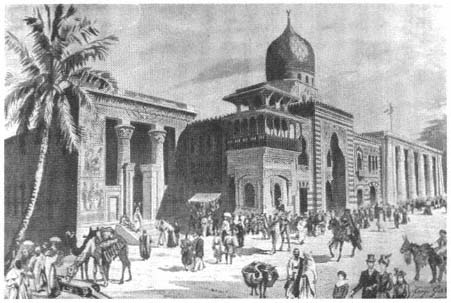
Figure 77.
Egyptian palace, Paris, 1900 (L'Esposizione universale del 1900 a Parigi )
bus, to the World's Fair, and to President Grover Cleveland. The pavilion served as a museum of antiquities.[50]
The Egyptian Palace in Paris in 1900 was a curious complex composed of three buildings: temple, okel, and a new invention: the theater with a temple facade (Fig. 77). The French architect Marcel-Lazare Dourgnon had based his design for the palace on several well-known monuments: the portico, for example, was inspired by the Temple of Dandur, whereas the principal section was based on the monuments of Memphis and Thebes. Visitors found the exterior of the pavilion "very beautiful" but considered the interior, containing ancient collections and funerary chambers, disappointing, more or less empty and "vulgar," with "nothing new" in it. Its only attraction was the theater, which featured two hundred dancers.[51] The complaints suggest that the exoticism of Egypt had been overexploited and no longer appealed to French audiences.
The okel, like the temple, reappeared at successive fairs—as an independent structure in Vienna in 1873 and as a component of the Egyptian palace in Paris in 1900. In each case it referred to several models. The portal of the Parisian
okel of 1900, for example, derived from the Cotton Market (Khan al-Khalili) in Cairo, whereas the projecting cubical section at one of its corners was a faithful copy of the Sabil al-Gamaliyya, again in Cairo.[52]
The architectural ambition of Egypt's national pavilions reflected its economic and political status. As a semi-independent province, struggling to detach itself from the Ottoman Empire and searching for a firmer alliance with European powers, the Egypt of Isma'il Pasha sent a grand display to the 1867 exhibition, emphasizing its national self-image and complex historical heritage. With the downfall of Isma'il Pasha, Egypt had to curtail any grand plan for the 1878 exposition. When Egypt submitted to British rule in 1882, the scale, ambition, and character of its presence at the fairs changed. In 1889 the Egyptian section, financed by individual entrepreneurs, represented a street in Islamic Cairo, popular as an entertainment zone; and the Cairo Street in Chicago in 1893 functioned solely as an amusement strip.
Iran
The Iranian presence at the world's fairs began modestly. In 1867 in Paris, the Persian park, located next to the Egyptian quarter, consisted of a small kiosk, a replica of a house, and an opium factory.[53] As Iran's exposure to the West increased, so did the elaborateness of its pavilions. But even at their most elaborate, they were less grand than those of other Islamic nations.
The architectural language of the Iranian pavilions was that of the Safavid Isfahan region. Although at times the pavilions alluded to particular monuments, they were never complete replicas. For example, the 1873 pavilion in Vienna was a two-story exhibition hall on a residential scale (Fig. 78). Its central part projected, with an entry at either side and porches on both levels; the large pointed arch on the projection resembled arches of the grand iwans (vaulted halls), but here, uncharacteristically, it was divided horizontally. The building was rigidly symmetrical, with externalized facades, a major divergence from the internalized monumentality of, for example, the mosques and madrasas of Islamic Persia, where courtyard facades with their ample iwans would be richly decorated in colorful tiles.
The Persian palace in 1878 (sometimes called the Palace of Mirrors) was noted not for its exterior, which incorporated random details from Isfahan's monuments, but for its main hall, which duplicated the Hall of Mirrors in the
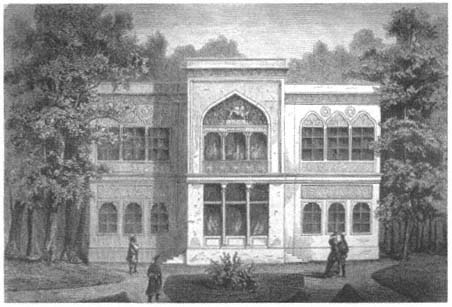
Figure 78.
Persian pavilion, Vienna, 1873 (L'Esposizione universale di Viena, no. 5).
Ali Qapu Palace (Fig. 79). For visitors, this was the ultimate expression of Oriental luxury. A guidebook to the exposition stated that the grand salon, "with millions of pieces of glass adorning the stalactites of the ceiling," flashed like a huge diamond.[54] Another observer called the room enchanted, "a real salon from The Thousand and One Nights " that acquired an "absolutely magical" atmosphere when the candles were lighted.[55]
Iran made its greatest architectural statement in Paris in 1900 (Fig. 80). A French architect, Philippe Mériat, designed and supervised the construction of the Persian pavilion on the Rue des Nations for the Iranian government, which asked for a building modeled on the Madrasa Maderi Shah Sultan Husayn.[56] The exposition hall, however, did not rely solely on toe original model organized around a courtyard. In fact, the pavilion had four elaborate facades and no Interior courtyard; thus references to the original were restricted to particular elements. Moreover, the structure was topped by two colonnaded pavilions modeled after the Pavilion of the Forty Columns and the terrace of'Ali Qapu Palace in Isfahan. Visitors were dazzled by the octagonal columns carved in cypress; ceilings sculpted, painted, and gilded; and a floor of white marble.[57]
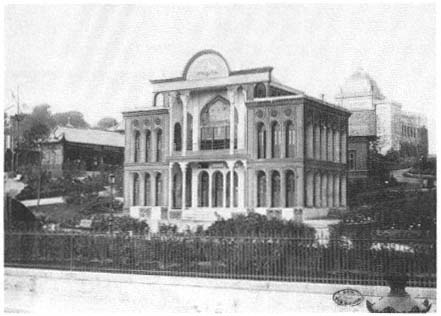
Figure 79.
Persian pavilion, Paris, 1878 (Bibliothèque Nationale, Département des
Estampes et de la Photographie).
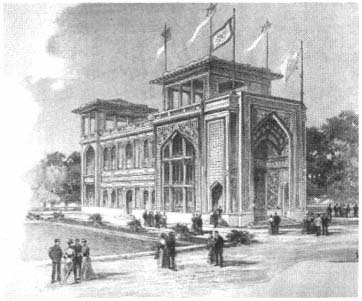
FIigure 80.
Persian pavilion, Paris, 1900 (L'Esposizione universale
del 1900 a Parigi ).
The facade on the Rue des Nations reinterpreted the great portal of the original madrasa as a tall iwan whose vault was decorated with stalactites; the tiles defining the borders of the portal were green, pink, orange, and different shades of blue. The overall effect was one of "grandeur, elegance, and bright gaiety." It was reported to be such a "perfect reproduction" that one observer lamented the lack of Iranian plants and waterworks on the Rue des Nations.[58] The interior of the building contained both a "magnificently furnished" reception hall and an "immense bazaar," where agricultural, industrial, and artistic products were exhibited.[59] The Hall of Honor, reserved for Shah Muzaffar ad-Din, was reportedly of the "first rank." It was lighted by two large stained-glass windows. On one, a Persian lion was depicted; on the other, lines by a contemporary poet were inscribed, glorifying the role of France and the city of Paris in modern civilization.[60] To Europeans such an integration of long inscriptions into architecture was novel. One observer remarked in awe: "Every facade is a real banner. They wrote everywhere: on the tiles, on the walls, on the glass."[61]
The attention given to the design and execution of this pavilion indicates the changing relations between Iran and Europe. Following Egypt and the Ottoman Empire, Iran had joined the "train of Western civilization."[62] Its exposure to the West led to a redefinition of its identity. Like the architecture of other Islamic powers at the world's fairs, that of Iran looked back to the nation's heritage, reinterpreting it according to the principles of Western architecture.
Tunisia and Morocco in the Pre-Protectorate Period
In 1867 Tunisia's and Morocco's displays in Paris seemed to some observers a deliberate escape from the economic and political upheavals the two countries were experiencing. Agricultural, industrial, and commercial spheres were omitted: instead, there were palaces with exuberant interiors and furniture, royal costumes, and armor—simply "everything that glitters, shines, and adorns.[63] Others noted the artistic value of the Tunisian and Moroccan pavilions. Alfred Norman claimed that they
were important not only for their size, but also for their tastefulness, their picturesque effect, and especially the brand new and charming sensation that they
arouse in us. . . . [Here was] a particular type of dwelling, where art was not excluded . . . from everyday activities.[64]
The purpose of the Tunisian pavilion was similar to that of the Egyptian selamlik and the Ottoman Pavillon du Bosphore: on his visits to the exposition, the Tunisian bey rested in the "grand palace" on the Champ de Mars (Figs. 81–82; see also Fig. 26). A duplicate of the Bardo Palace in Tunis, it was designed by the French architect Alfred Chapon. Six statues of lions framed the escaliers d'honneur, which led to a colonnaded porch and, inside, a vestibule. To the right of the vestibule was the domed "throne room" in the "purest Moorish style." The hall of the guards and the hall of the prime minister Mustafa Khaznadar were to the left. The prime minister's hall provided access to the bey's chambre d'honneur, also called Bayt al-Basha. Here, in a section separated by musharabiyya s, the Bey could hold private conferences.
At the core of the building was the patio, which gave access to the bey's private quarters—a vast room decorated in "unheard-of luxury and taste" that once again evoked The Thousand and One Nights . Brilliantly colored tiles sent from Tunisia added to the effect created by beautiful carpets and embroideries; gold-painted elements unified the space. The dazzling effects were greatest in the gilded dome. On a wall was a line from the Qur'an—"Happy is the land governed by the sadiq " (that is, "the just, the rightful")—that made a graceful pun on the name of the current bey, Muhammad al-Sadiq. On one side of the room, a stairway, hidden by a curtain, led to the harem, accessible only to the bey.
In the palace was a museum filled with Roman and Phoenician antiquities from Carthage, along with a huge café and a barbershop, accessible from the main street, that embodied two elements of Tunisian public life the exposition organizers saw as typical. The basement housed the stable.[65]
In 1878 the Tunisian pavilion was a more modest structure near the Algerian Palace. A square building with plain facades and a central courtyard with the inevitable fountain, it followed, on a much simpler level, the precedent of the 1867 palace, though its exterior was described as "grim and sad," like "all Turkish, Arabic, Moorish, and Persian buildings."[66] Inside, however, the
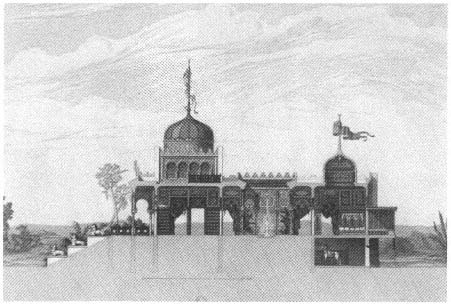
Figure 81.
Tunisian Palace of the Bey, section, Paris, 1867 (Normand L'Architecture
des nations étrangres ).
"multicolored Moorish design" was lively; ceilings were covered with rich mosaics, and the effect was altogether cheerful and picturesque.[67]
Stables and bedouin tents also played their part—in both the Tunisian displays (see Fig. 26) and the Moroccan. In 1867 in Paris, Morocco was represented by a large imperial tent and two smaller tents for guards next to the Tunisian section.[68] Nearby was a modest stable whose most striking feature was a fountain in white marble, decorated with bright tiles.[69] The pyramid-shaped tent made of camel hair reappeared in Paris in 1878, again as part of the "Oriental park." Inside, as in 1867, the tent was lined with couches covered with thick carpets; bric-a-brac, from large wooden wedding trunks to narghiles, completed the decor.[70] But now there were additions to the Moroccan compound: shops and a main pavilion, called the Moroccan villa. The villa consisted of four rooms, richly decorated and organized around a courtyard.[71] In 1889 and 1900, Morocco's pavilions, again with courtyards, had simple facades highlighted by detailed portals and square towers modeled after minarets.
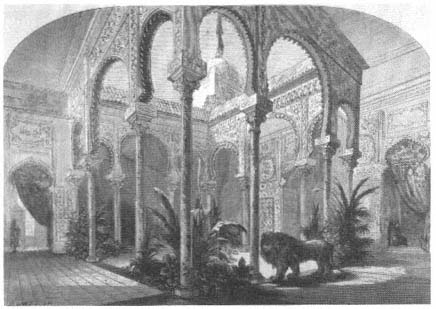
Figure 82.
Courtyard of the Tunisian palace, Paris, 1867 ( L'Exposition universelle de
1867 illustrée ).
Algeria and Tunisia under French Rule
Because Algeria was France's first and most important Muslim colony, its presentation to the world was a major concern, and French officials experimented with various possibilities. In 1867 Algeria was represented in the French exhibit as a "trophy," "a new territory reconquered by civilization after twelve centuries of barbarian rule." Inside the Galerie des Machines the Algerian display, modestly demarcated by palm trees, showed raw materials (Fig. 83). To display Arabs and their civilization, a douar, or Arabian village, was set up in the southwestern part of the park, near the Porte de la Grenelle. A group of camels sat in the center of a circle of tents while their caretakers, brought to Paris "to give an idea of the true Arab type," dozed inside.[72]
This modest exhibit contrasted with the next one in Paris in both scale and architectural ambition. The Algerian palace in 1878 was a massive mosquelike building, 40 by so meters (Figs. 84–85), its exterior dominated by four towers, its plain white walls unfenestrated. The interior, however, was more of a caravansary, where the products of two thousand exhibitors were displayed.[73]
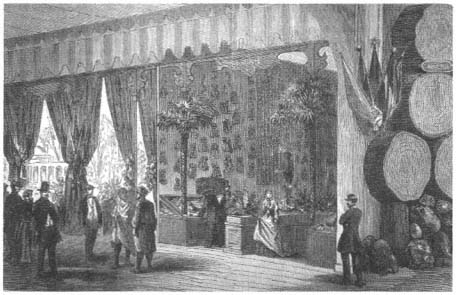
Figure 83.
Algerian displays of raw materials, Paris, 1867 ( L'Exposition aniverselle de
1867 illustrée ).
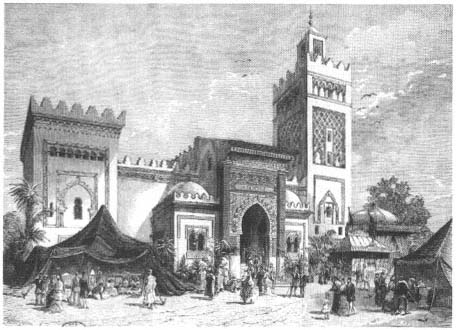
Figure 84.
Algerian palace, Paris, 1878 (Bibliothèque Nationale, Département des
Estampes et de la Photographie).
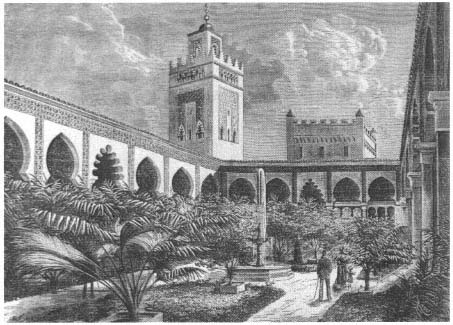
Figure 85.
Courtyard of the Algerian palace, 1878 ( L'llustration, 10 August 1878).
Daylight came in through the central courtyard, planted with palms and roses and containing a fountain. Components of the structure had their origins in monuments in the city of Tlemcen: the 30-meter-high minaret replicated that of the fourteenth-century Mosque of al-Mansur, and the portal came from the Mosque of Sidi Bou-Madina; the ribbed dome of the vestibule imitated the mihrab dome of the Great Mosque of Tlemcen. The most important space in the building was the rotunda-shaped Salon du Maréchal, the reception hall of the French marshal; it was on axis with the main entrance and was lighted dramatically by spherical stained glass windows.[74] With its allusion to the appropriation of local architecture by the colonial power, this room served as a political symbol.
The idea of architectural fragments so dominated the Algerian display that the portal of the al-Kebir mosque in Algiers was erected as a freestanding structure near the exposition palace (Fig. 86).[75] Out of its context the portal served as an archway, but because of its seemingly random placement, it was also a picturesque "found object."
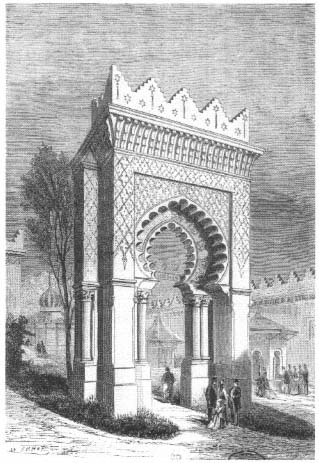
Figure 86.
The porta of al-Kebir mosque, Paris, 1878 (Bibliothèque
Nationale, Département des Estampes et de la Photographie).
Like the 1878 palace, the main Algerian pavilion at the 1889 Paris fair, designed by Albert Ballu and Emile Marquette (Fig. 87), was an introverted structure with courtyards, plain exterior facades with arched portals and porticoes, and a square minaret (not visible in the illustration) modeled after that of the Mosque of Sidi'Abd al-Rahman, which was topped with a French flag. A dome, also inspired by the Mosque of Sidi'Abd al-Rahman, covered the central space.[76] The interior decoration displayed a "capricious geometry"; one journalist argued that it was the "product of a dry imagination, a cold, me-
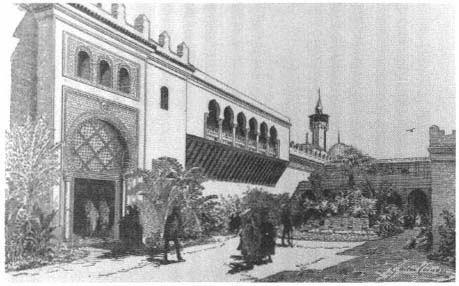
Figure 87.
Courtyard of the Algerian palace, Paris, 1889 (Monod, L'Exposition
universelle de 1889, vol. 2).
thodical barbarity without exuberance," because "the Arab never had a feel for plasticity; his genius was only in mathematics and colors."[77] Although this viewpoint adopts the rationalist theories of Islamic architecture rather than earlier theories of Islamic architecture as a sensuous fantasy, it still presents Islamic architecture in a negative light, denying that the Muslim artist and architect had any creative flexibility. Ironically, the exposition pavilions were considered Islamic architecture, despite their French authorship, at the same time that the neo-Arabian buildings erected in the colonies were considered French.
As noted in the previous chapter, Algeria in 1900 occupied the "place of honor" in the Trocadéro Park. Albert Ballu, the architect of the Algerian palace, had given this imposing structure an unadorned exterior to reflect the "Muslims' contempt of worldly things" (see Fig. 52).[78] The walls were a "luminous white," with bands of tiles on the upper levels and a crenellated roofline. The facade on the Seine was the structure's most elaborate, with its monumental stairway leading to an arched portico. A minaret 28 meters high, a replica of that of the Mosque of Sidi Bou-Madina in Tlemcen, rose on one side of the stairway. The central dome of the palace was inspired by the Mosque of the Fishery in Algiers.[79]
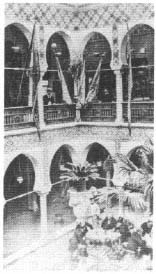
Figure 88.
Courtyard of the Algerian
palace, Paris, 1900 (L'Exposition
de Paris, vol. 3).
The palace basement was filled with antiquities and choice wines for tasting (Fig. 88).[80] On the ground floor, a large courtyard, a reproduction of the courtyard in the Bardo Palace in Algiers, "recalled the interior courts of Moorish houses in Granada and of Muslim harems, where solitude and freshness invite one to dream." In the middle, however, where tradition called for a fountain, there was a large, glassed-in model of the ruins of Timgad. In the galleries of the next floor, reached via the grand staircase outside, were exhibit of fabrics, guarded by "Turks and sipahis" (indigenous soldiers in the French army); a collection of engravings and cartoons from the time of the French conquest ("very curious and amusing historical documents"); a mineralogical exposition, complete with geological maps; and an exhibit of Algerian artists and French Orientalist painters.[81]
French colonizers presented the Algerian palace as a "didactic and demonstrative" exposition. Because the "attractions" were reserved for the section on the other side of the avenue bisecting the park, the palace lacked the picturesqueness Europeans were accustomed to by now. Although some visitors expressed disappointment, others noted with satisfaction that for once an Oriental exposition avoided being messy and commercial.[82]
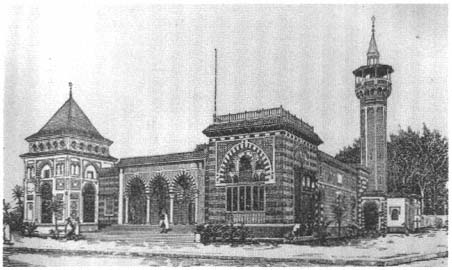
Figure 89.
Tunisian palace, Paris, 1889 (Monod, L'Exposition universelle de 1889, vol. 2).
Tunisia, which became a French colony in 1882, was summarized in 1889 by an elaborate and ambitious pavilion (Fig. 89). Following what could now be called a tradition in colonial representations, the young architect Henri-Jules Saladin incorporated architectural motifs from various monuments of Tunis into the facades of this "sober and elegant" building. A portal came from the Sulaymaniyya Madrasa and a facade from the Great Mosque of Kairawan, the dome and the minaret recalled the Sidi ben-Arous, verandas and musharabiyya s evoked the old houses of Tunis, and the tiled courtyard with a fountain in the middle was a feature of many Tunisian buildings. Tiles with floral motifs in blue and yellow, inspired by the tiles of the Bardo Palace, covered the walls. The building featured agricultural products and archaeological objects as well as schoolbooks that recorded "the progress achieved" under French rule.[83]
In the crowded Tunisian quarter of the Universal Exposition in Paris in 1900, again designed by Henri-Jules Saladin, there were two replicas of mosques. The first, a copy of the Mosque of Sidi-Maklouf in Kef, actually served as a mosque where Muslims could go for their daily prayers.[84] The second, a copy of the seventeenth-century Mosque of Sidi-Mahres in Tunis, then abandoned and in
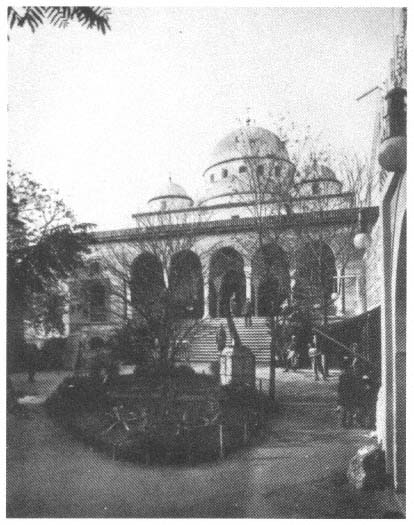
Figure 90.
Tunisian palace, Paris, 1900 (Exposition universelle internationale
de 1900, Paris, 1979).
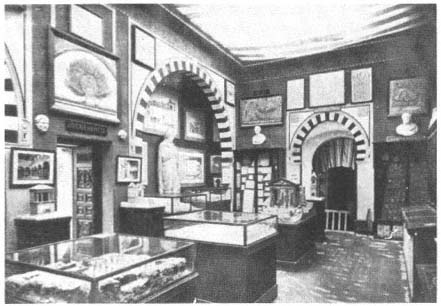
Figure 91.
Interior of the Tunisian palace, the archaeological section, Paris, 1900
(L'Exposition de Paris, vol. 3).
ruins, was transformed into an exhibition hall to display the agricultural, industrial, and commercial products of the regency (Figs. 90–91).[85] One room was reserved for documents pertaining to colonization, another for representative artwork from Tunisia's rich history.[86] Observers agreed enthusiastically that this white-domed "mosque" lacked only the light of the Tunisian sun to be real. To lend "authenticity," the moldings (geometric interlacings) were made in Tunisia by local artisans and shipped to Paris. The resident general of the colony, René Millet, joked that this replica—this "jewel"—lacked only the cow that had turned it into a stable back in Tunis.[87] Once again underscoring the building's authenticity, a French journalist sympathized, tongue-in-cheek, with the native who did not understand why he was not allowed to pray in this "mosque."[88]
The architecture of the Algerian and Tunisian colonies of France projected an image of Islam correlating with that of the noncolonial presentations. Yet the indigenous character of the pavilions played a different role in the colonial context, aggrandizing the image of France by making it more varied and complex. The greater the spectrum of differences in colonized cultures, the stronger was the impression of the colonizer's power and the vastness of his
domain. One French observer asked: "Are we not a grand Muslim nation, given our vast African colonies?"[89] In effect, the Islamic colonies were only a small part of the much larger French empire, which included West Africa, the Congo, Madagascar, Indo-China, and islands in the Caribbean. Pluralism suggested the empire's universality.
The Architects
The architects (almost all of them French) commissioned to design the buildings that represented the Islamic nations to the world are unfamiliar to most students of nineteenth-century French architecture: Léon Parvillée (1867, Ottoman Empire), Jacques Drévet (1867, Egypt; 1878, sections étrangères ), Albert Ballu (1889 and 1900, Algeria), Théodore Ballu (1878, Egypt), Alfred Chapon (1867, Tunisia), Marcel-Lazare Dourgnon (1900, Egypt), Adrien-René Dubuisson (1900, Ottoman), Emile Marquette (1889, Algeria), Henri-Jules Saladin (1889 and 1900, Tunisia), Paul-Jacques Aimé Baudry, and Philippe Mériat (1900, Iran). Although these men were not associated with the epoch-making buildings of the century, they did build in the mainstream, and their names appear frequently as exposition architects. Expositions provided platforms for architectural experimentation, as well as a means of livelihood, for many professionals. In Paris, where four expositions took place within thirty-six years, exposition architecture became a specialty.
Not only Islamic nations but also Luxembourg, Greece, China, Japan, and Russia, among others, commissioned French architects to design their pavilions. As the architectural historian Louis Hautecoeur pointed out in reference to the 1878 exposition, "Many nations trusted French architects to make their countries known."[90] France's influential role in this area was noted proudly by locals as "a sort of homage to [French] national art."[91]
Only some exposition architects knew firsthand the architecture of the places they represented. As noted earlier, Parvillée (a ceramicist, not an architect, by training) had documented and analyzed the Ottoman monuments of Bursa. Henri-Jules Saladin, a Beaux-Arts trained architect, had worked on archaeological missions in Tunisia and had published extensively on the antique and Muslim architecture of the country.[92] Jacques Drévet and Marcel-Lazare Dourgnon, who had also trained at the Ecole Supérieure des Beaux-Arts, had some practical experience with Islamic architecture. Drévet had developed a
project for the waterfront of Alexandria; though not implemented, it led to his assignment as the architect of the Egyptian pavilions in 1867. His expertise in "Oriental architecture," gained in 1867, led in turn to the French exposition committee's decision to select Drévet to design the foreign section (Iran, Siam, Annam, Tunisia, and Morocco) in the Trocadéro Park in 1878.[93] Moreover, his "serious and fruitful" studies of Egyptian architecture in preparation for the 1867 exhibition resulted in another project—a Cairo museum in a neo-Egyptian style, never realized.[94] Another exposition architect, Marcel-Lazare Dourgnon, responsible for the Egyptian pavilion in 1900, subsequently built the Museum of Antiquities in Cairo according to his own designs and undertook two other monuments in Cairo, both associated with the French government: the French Institute of Oriental Archaeology and the Monument to the French Soldier (fallen in the Napoleonic campaign) in the Latin cemetery of Cairo.[95] Albert Ballu (architect of the Algerian pavilions in 1889 and 1900) had an administrative position with the Commission of Historic Monuments in Aix-en-Provence and in Algiers. Later he became the general inspector of the Algerian museums and was involved in archaeological research in North Africa until 1925.[96] The other architects had no documented affiliation with the architecture of the Islamic countries whose pavilions they designed.
In this framework, Parvillée and Saladin stand out for their serious and detailed studies of Islamic architecture. Dourgnon must have been familiar with the Muslim architecture of Egypt and Ballu with that of Algeria, but neither demonstrated an analytical interest in the subject. Most likely the knowledge of the remaining architects depended on what they could glean from publications.
Conclusion
The International Colonial Exposition, held in the Bois de Vincennes outside Paris in 1931, celebrated the benefits of French colonialism. The architecture of this exposition can be seen as a conscious synthesis of earlier representations of non-Western societies at the fairs. In an article reviewing the architecture of this exposition, Pierre Courthion classified the pavilions into three types: original creations, stylized interpretations, and exact copies and reconstructions. He argued that the first appealed to artists, the second to dilettantes, and the third to ethnographers.[97] What he defined as original creations were products
of the age of modernism; stylized interpretations and exact copies, however, grew out of experimentation in the non-Western pavilions of the nineteenth-century universal expositions.
The building types allowed for the expression of regional differences. The architectural models that were copied or interpreted came from the homeland, although sometimes the purity of the original style was blurred, as, for example, in the Ottoman pavilion in Paris in 1900. A widespread cultural anxiety in the face of universalizing tendencies, along with a search for an appropriate architecture, resulted in the persistence of regional models—in both Islamic and modern European societies.[98] César Daly described the problem: "Modern society, powerless to express through art a harmony among souls that no longer exists, and powerless to attribute a fixed meaning . . . to the fundamental forms of architecture, [is] without the power to create and is constrained to borrow."[99]
The consequences of modernization for non-Western societies were even more serious than those for Western societies; non-Western societies risked losing their "national cultures" because of the homogenizing force of the "universal civilization," created by industrialization—itself a Western phenomenon.[100] Hippolyte Gautier had raised this issue as early as 1867. He had argued that the exposition provided the last opportunity for the Islamic nations to confirm their "characteristic physiognomy, their climatic, racial, and cultural originality"—in sum their "individuality"—and had warned that they risked losing their authenticity under the uniform color of "civilization."[101]
The expression of cultural identity was a primary theme in the Islamic architecture of nineteenth-century expositions, which themselves helped to differentiate national identities, to challenge "Islamic" as an all-inclusive term. The insistence on national identities in exposition architecture was a reaction both to the European tendency to consider Islamic civilization a single entity and to Ottoman suzerainty (except where the Ottoman Empire's own displays were concerned). As the governors and beys tried to establish their independence from the central Ottoman administration, they looked to local elements to define their cultures.[102] Nevertheless, regionalism at the world's fairs remained a stylistic affair, which did not extend to the types of buildings displayed. Although the pavilions cited specific structures from the place represented, the range of types was limited: mosques, caravanseries, souks, and so forth ap-
peared again and again, reiterating the signs and symbols commonly associated with a uniform Islam.
The architects of the exposition pavilions based their designs on one of two theoretical positions: rationalist and intuitionist. Although contradictory, both were deemed Islamic in essence. Rationalists looked for scientific rules of composition; Léon Parvillée was the most prominent among them. Intuitionists relied on feelings and fantasy as sources of inspiration; Jacques Drévet, who represented this approach, designed the Egyptian pavilions in 1867 in a mood of "artistic anarchy."[103] Both Parvillée and Drévet sought to understand the architecture of the cultures they represented at the expositions. But were they culturally equipped to do so?[104] Could it be argued that the "rules" Parvillée found in the monuments of Bursa were formulated in his own mind, based on his assumption (perhaps unconscious) that there was only one way of designing and that the Ottoman architects had worked within the same framework? And could it be argued that Drévet, although professing "artistic anarchy," was only pursuing a design methodology that he already knew?
More often than not, the theory was not articulated, and the architecture of the Islamic pavilions was influenced by the educational and professional background of the architect in charge. In general, the French architect's understanding of architecture was based on the long tradition of French academicism, which consequently shaped that architect's designs. The foreign vocabulary of Islamic architecture created no real problem because eclecticism was accepted by the Beaux-Arts tradition itself during the second half of the nineteenth century, and Islamic forms could easily be incorporated into its already crowded repertoire.
The pavilions erected on the grounds of the universal expositions raised serious and complex questions about cultural definition and the role of architecture in representing cultures. As temporary installations, they could be experimental and ask these questions boldly. And, because of the high visibility of the national pavilions and the attention they received in contemporary publications, both scholarly and popular, their regional and cross-cultural impact was disproportionate to the short life of the buildings themselves.
4—
Exposition Fever Carried East
As is customary in these expositions, one goal is to promote architecture, which in our country has come to need promotion. . . For the exposition hall, one's heart desires the application of Ottoman architectural science, or the "Arabic" and the "Moorish," or the Indian, Arab, African, and Andalusian architectural science—in short, an Islamic architectural science.
"On the General Exposition," Basbakanlik Arsivi, Yildiz, Kisim 31, Evrak 1933, Zarf 45, Kutu 82; 19 Sefer 1311 (August 1893)
Exposition fever in the mid-nineteenth century extended to the Ottoman Empire and Egypt, where events similar to those in the West were organized. The Ottoman government planned two exhibitions in Istanbul, one in 1863, the other in 1894. The first was a successful venture, but the second did not materialize because of a major earthquake in 1894 that caused great damage to the capital and required huge expenditures of the government's already limited funds. In the Egypt of Isma'il Pasha, the spectacular opening of the Suez Canal in 1869 replicated elements of the international fairs—among them an ephemeral architecture and many festivities.[1] Perhaps more important, however, as at the European and American fairs, the host country became the spectacle's central feature. For both the Ottoman Empire and Egypt this visibility was crucial, since their restructuring efforts in the nineteenth century were intended to make them part of modern civilization, and hence the Western world.
The Ottoman General Exposition, 1863
The date of this first exposition is significant because it precedes that of most of the larger exhibitions in Europe and America. Before 1863, only four major international exhibitions had taken place: in 1851 and 1862 in London, in 1853 in New York, and in 1855 in Paris. The Ottoman Empire had participated in all but the one in New York, where transportation costs had prevented its attendance. The 1863 exposition indicated the willingness of the Ottoman Empire to become part of modern civilization. It took place in the third year of Sultan Abdülaziz's reign, which proved to be one of the most intense periods of Westernizing reforms as well as a time of much city-building activity. As noted in chapter 2, Abdülaziz himself later visited the 1867 Paris Universal Exposition, demonstrating his personal interest in these events.
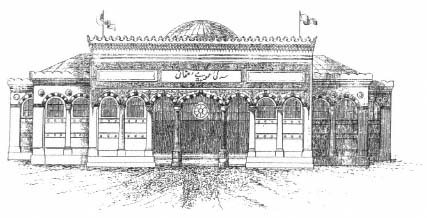
Figure 92.
Front facade of the main hall, Ottoman General Exposition, Istanbul, 1863
(Mirat, no. 3, Zilkade 1279/April 1862).
The 1863 Sergi-i Umumi-i Osmani (Ottoman General Exposition) borrowed its format from the Western exhibitions, but its scope was smaller and its goals more directly linked to the promotion of national industry—a larger program that had been hard hit in the nineteenth century by competition from European products as well as the special rights and privileges given by the Ottoman government to Western entrepreneurs and industrialists from the 1830s on. The exposition was to help in pinpointing the problems of Ottoman industry and in seeking solutions. Initially it was conceived of as a national display, but eventually European industries, assumed to have the most advanced machines and tools, were encouraged to participate.[2]
The Hippodrome—a large open space, centrally located and historically important—was chosen as the exhibition site. The government wanted an exhibition building in the "new manner" (tarz-i cedid ).[3] The commission was given to two French architects already working in the empire on imperial commissions: Marie-Augustin-Antoine Bourgeois, who had designed the Ministry of Defense headquarters in Beyazit, and Léon Parvillée, then working on the documentation and restoration of Ottoman monuments in Bursa. Bourgeois was to design the overall architecture, Parvillée the interior.[4]
The building was a large rectangle that occupied approximately 3,500 square meters (Figs. 92–93).[5] A projecting section, higher than the rest of the building, defined the main facade. Here was the arched entry porch, marked by a
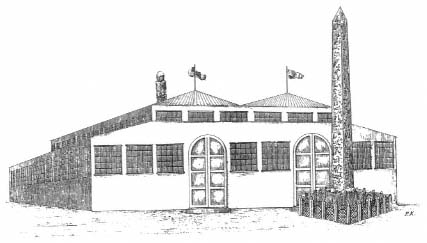
Figure 93.
Back facade of the main hall, Ottoman General Exposition, Istanbul, 1863
(Mirat, no. 3, ZilKade 1279/April 1862).
crenellated roofline. An inscription above the three central arches read "Ottoman General Exhibition." The precedent for the design—a large hall, which could be partitioned—came from previous exhibitions. Nevertheless, the facades expressed local color through an Islamic architectural vocabulary: arches of alternating red and white stones, Ottoman columns and capitals, elaborated rooflines. Not all of these forms were Ottoman (the crenellation, for example, was Cairene), but the "envelope" of the otherwise "new manner" structure was broadly neo-Islamic in style.
The interior was divided into thirteen sections for displaying such items as agricultural products, handicrafts, textiles, industrial products, mining products, leather goods, furniture, carpets, and musical instruments. In one section architectural models and drawings were displayed together with photographs, charcoal drawings, paintings, maps, prints, and books.[6] But agricultural goods occupied the largest space. For example, 212 kinds of wheat from different regions of the empire were shown,[7] emphasizing agriculture as the leading force in the Ottoman economy.
Machines sent from abroad were exhibited in an annex south of the main hall that was reserved for national displays. A simple structure with none of the embellishment of the main building, it extended from the obelisk to the south end of the Hippodrome, enclosing the Serpent Column within its boundaries.[8]
The Istanbul Exhibition became a popular event. Men could visit it five days
a week, women only on Wednesdays and Saturdays. Public transportation fares from neighboring suburbs and towns were reduced to encourage attendance, and, as in the Western world, recreation and entertainment facilities were provided on the fairgrounds. For example, on Fridays and Saturdays the army band (Asakir-i Nizamiyye-i Sahane Muzikasi) gave free concerts. The exposition generated a great deal of commercial and tourist activity, and many foreigners, among them journalists, entrepreneurs, and industrialists, came to Istanbul specifically to visit it.[9] The building was torn down in 1865.[10]
The Istanbul Agricultural and Industrial Exposition, 1894
A second exposition in Istanbul was conceived in 1893 under Abdülhamid II, with the goal of "promoting the development of the wealth and well-being of the country."[11] A 142,000-square-meter site on the northern side of the Golden Horn, near Sisli, was selected for the Istanbul Agricultural and Industrial Exposition (Dersaadet Ziraat ve Sanayi Sergi-i Umumisi).[12] Unlike the 1863 exposition, this one would be permanent but would close for four months each winter. Although the major exhibits would consist largely of agricultural, industrial, and artistic products of the empire, foreign goods would also be displayed, and some foreigners would sit as regular members on the committee formed to organize the exhibition.[13] Therefore, while bringing "under the eye of agricultural and industrial Europe a complete collection of products of the soil and toil of the Empire," the exhibition would simultaneously "show to the native industrialists and agriculturists such foreign methods, models, and types of production as might enlarge their ideas of their own work and enable them to improve it as to render Turkey in an economic sense less and less tributary to foreign countries."[14] The exhibition would double as a marketplace; the products would be offered for sale, and purchasers as well as visitors would be admitted.[15]
As in the West the promoters of this exposition emphasized its educational, social, and recreational benefits. An editorial in The Levant Herald and Eastern Express argued that although the capital had open spaces with pleasant views and fresh air, none of them were "interesting, nor did any of them offer any intellectual attraction whatsoever nor quicken healthy curiosity." If managed properly, the planned exhibition could do all these things. The site was well chosen, because Sisli was a healthful spot. With its physical and intellectual
appeal, the exhibition had the potential to bring together "all classes of the population."[16]
The organizing committee decided that because the exhibition was to be permanent, the pavilions should be built of long-lasting materials—stone, brick, and iron.[17] Visitors arriving at the site from Pera would see two facades of the main building. Inside, to the left of the entrance, would be an area for foreign machines and instruments and for hothouses. A large hall (under a glass roof), intended for the inaugural ceremony, would occupy the center. To the right of the entrance an area was reserved for displaying livestock and dairy farming. A field for agricultural experiments and a hippodrome were planned for the northeast section. The buildings, including an imperial pavilion, would cover 44,000 square meters. A rail transportation system would facilitate communication on the site.[18]
The architectural style of the pavilions was a major concern. A government document argued for the serious consideration of the issue because the goal of exhibitions was promotion, including promotion of architecture, and in the Ottoman Empire the "science of architecture" (fenn-i mimari ) had been forgotten. Even the design of buildings, on which great sums had been spent, did not follow "architectural rules" (kaide-i mimari ). To develop such rules required the study of "Ottoman architectural science" (fenn-i mimari-i Osmani ) or of Arabic, Moorish, Indian, African, and Andalusian "architectural styles"—in short, an "Islamic architectural science" (fenn-i mimari-i Islami ). Nevertheless, some buildings would be designed in the "new manner." This was the "Renaissance" style, based on the "Roman," "Greek," and "Gothic" architectural rules and observed in many architectural drawings received from Europe. The logic for selection among the Western styles was simple: "Whatever is considered prestigious in Europe will be used in the architecture of the exhibition."[19] Despite its great confusion, this argument reflects the basic dilemma Ottomans encountered in choosing an appropriate style—reduced to the juxtaposition of Islamic versus European.
Raimondo D'Aronco, well known as a practitioner of the Italian branch of art nouveau, the stile floreale, was chosen as the architect of the exhibition. Only two of his numerous drawings have surfaced in the archives of the Dolmabahçe Palace: one depicts a setting for ceremonies (possibly the imperial pavilion) and the other the British pavilion (Figs. 94–95).[20] The first is an interpretation of Islamic forms in new materials (i.e. the iron-ribbed dome and the
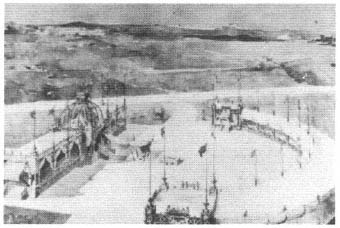
Figure 94.
D'Aronco, pavilion for the Istanbul Agricultural and Industrial
Exposition, Istanbul, 1894 (D'Aronco architetto ).
arcades); the second is a typical stile floreale structure, with oversized sculptures applied to the facades, the decorative use of metalwork, large windows, and curving lines. These two drawings represent the two architectural styles, neo-Islamic and modern European, written into the program by the organizing committee.
D'Aronco's scheme for the exhibition grounds included landscaping. At the center of the site would be the People's Palace, surrounded by "all the features of (landscape) gardens—shrubberies, avenues, fountains, etc."[21] When D'Aronco presented the drawings, the sultan expressed his satisfaction by conferring a decoration on him and agreed to hire Italian master builders for the construction work.[22] A few months later a huge model of the exhibition grounds was brought before the sultan; measuring 3.0 by 2.5 meters, it was seen as "a masterpiece, perfect in every detail, . . . a work of rare beauty and finish, a work of art."[23]
The plan for the 1894 Istanbul Agricultural and Industrial Exposition was ambitious in its social aims, its hopes for economic benefits, and the grandeur of its architecture. Like exhibitions in Western cities, it was seen as an arena of architectural experimentation. Although the pavilions were never built and most of the drawings and the model have been lost, the discussion of architectural styles sheds light on the Ottoman Empire's search for an architectural philosophy.
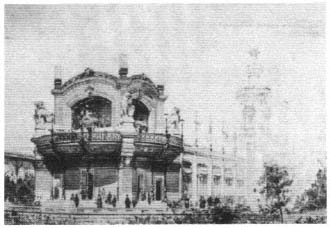
Figure 95.
D'Aronco British pavilion, Istanbul, 1894 ( D' Aronco architetto ).
The Opening of the Suez Canal, 1869
Among the grandiose schemes undertaken by Isma'il Pasha, the opening of the Suez Canal, which joined, in the words of Théophile Gautier, the "Mer de Perle" to the "Mer de Corail,"[24] highlighted Egypt's importance to European trade. The canal, by providing much easier access between England and India, ultimately led to the British occupation of Egypt; but the original impetus for the project had been "global." In the 1830s the Saint-Simonians promoted the idea so that goods could circulate freely throughout the world and encourage worldwide industrialization.[25] Three decades later, Isma'il Pasha brought in a Saint-Simonian, Ferdinand de Lesseps, to lead the project. Most likely, however, Lesseps was commissioned not because of his ties to utopian socialism but because of his credentials as an engineer.
For the inaugural ceremonies only a few permanent buildings were built in Ismailiyya, the new town that owed its existence to the canal, but temporary structures were erected, many of them inspired by the architecture of the universal expositions. As at the expositions, the number of visitors (both local and foreign) was overwhelming, but in this case their expenses were paid by the Egyptian khedive. The ceremonies, feasts, and entertainment further recalled the European fairs.
The magnificence of the three-week-long inaugural ceremonies reminded some observers of The Thousand and One Nights . Many notable political and
literary figures attended the celebration, among them the Austrian emperor Franz Joseph, the king of Hungary, the prince of Prussia, and the prince and princess of Holland. Undoubtedly the most valued guest, however, was the French empress Eugénie, for whom the khedive built a palace on the Nile, a replica of her private apartments in the Tuileries.[26] Eugénie, on the day she arrived in Port Said, sent a telegram to Emperor Napoleon III: "I arrived at Port Said in good health. Magnificent reception. I haven't seen anything like it in my lifetime."[27]
The khedive did not include Muslim sovereigns among his guests. He apologized by admitting that he would have invited, among others, the sultan of Morocco, the shah of Persia, and the bey of Tunis, but he had to limit invitations because accommodations were unavailable. He wrote to Nubar Pasha: "With the best intentions on earth, and opening all my residences, I could not have more than eighty palaces ready for the sovereigns and princes who would like to honor me with their presence."[28] As rapprochement with the West was his goal, European leaders were naturally given preference over Muslim leaders.[29]
Among the scholars and writers attending were the famous German Egyptologist Richard Lepsius, the Norwegian playwright Henrik Ibsen, the French painter Jean-Léon Gérôme, and the French writer Théophile Gautier. A large contingent of journalists was also present.[30] These guests were distributed among the main hotels of Cairo, and a large group was housed in the renowned Hotel Shepheard. Gautier wrote that
the guests would group at tables according to their affiliations or professions; there was the corner of painters, the corner of scholars, the corner of literary people and reporters, the corner of worldly people and amateurs. . . . They visited one another. . . . The conversation and the cigar blended all the ranks and all the nations; one saw German doctors talking about aesthetics to French artists and serious mathematicians listening to the tales of the journalists with smiles.[31]
At least according to Gautier, the atmosphere of friendly communication transcended national barriers—one of the stated goals of international exhibitions.
Isma'il Pasha entertained his foreign guests lavishly in Cairo, on the boat trip down the Nile to Ismailiyya and in Ismailiyya. The boat trip was splendid,
with stops at ancient sites like the Temples of Luxor and Saqqara. Sometimes meals were served in ancient temples, but more often tents were erected—in the middle of the desert in Saqqara, for example, in honor of Empress Eugénie. They were silk ecru on the outside, and some were covered with yellow satin, others with red satin, on the inside; the color of the furniture in each tent matched that of the interior.[32] In the tents in Ismailiyya seven to eight thousand guests dined in "unheard-of luxury."[33]
The crowds included Egyptians as well as foreigners. Isma'il Pasha declared:
The inhabitants of all the regions of Egypt, including the tribes of Sudan, will unite in Ismailiyya; there will be national games and entertainments. . . . [This is planned] out of respect for both the religious sentiments of the large majority of the country's population and the national customs and historical traditions of modern Egypt.[34]
The governor also saw touristic value in these indigenous ceremonies. He urged foreign guests to visit Arab feasts,[35] where the entertainment included bands, chanting, folkloric dances, performing dervishes, fire-eaters, and karagöz, the shadow theater. Empress Eugénie was especially amused by the performances of bedouin horsemen "galloping to and fro, shouting, and firing off their meskets ."[36] Tents were erected for the chiefs of local tribes, decorated with colorful carpets and "all the splendors of . . . the Orient" (Fig. 96). The chiefs in white robes, surrounded by their servants, either stretched on divans or stood in front of their tents and invited passersby in for coffee, chibouk, and sherbets.[37] The noises made by the many horses and donkeys mingled with the "rowdy music of the desert orchestras." Dervishes howled and whirled, and singers from Upper Egypt sang in high-pitched voices.[38] This was a tableau vivant, an ethnographic display of the indigenous—learned from the international exhibitions. Indeed, the accounts of the European observers recalled the descriptions of world's fairs with their emphasis on race:
All the examples of Semitic races are here; all the people subject to Islam have sent their representatives: the Persian brushes past the man of Morocco and the man of Zanzibar; the inhabitant of Arabia has put up his multicolored tent next to the striped cone of the Indian.[39]
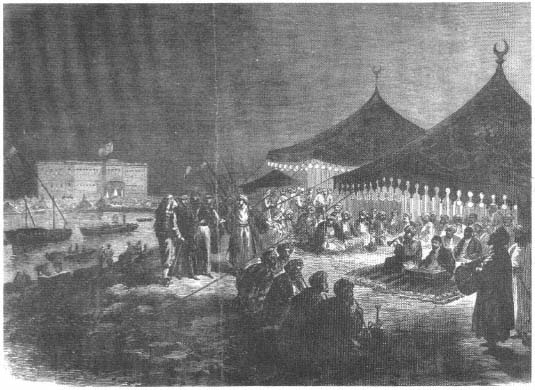
Figure 96.
Tents of local people, Ismailiyya, 1869 ( The Illustrated London News, 18 December 1869).
This was a "most varied and bizarre spectacle,"[40] which created a "marvelous effect." Here, as in the Islamic quarters of the 1867 Universal Exposition in Paris, there was a "brilliantly organized disorder."[41]
In Ismailiyya, three elevated pavilions with broad stairways were set up for the opening ceremony (Figs. 97–98). The first contained seats for the khedive, his imperial and royal guests, and their attendants; the second was for the Catholic church; and the third for the Muslim ulama. All were built of wood and adorned with flowers and the flags of guest nations. Golden crescents rose from the corners of each pavilion. On the Christian sanctuary there was a cross of Jerusalem, and on the Muslim pulpit an inscription from the Qur'an. The ceremonies began with a Muslim prayer, followed by a Catholic mass conducted by the archbishop of Jerusalem, and a speech by Monsignor Bauer
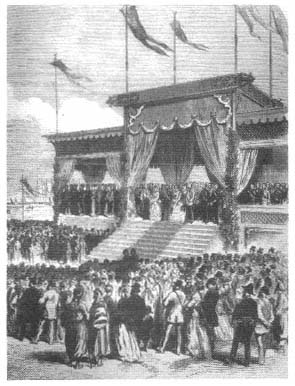
Figure 97.
Pavilion for the khedive and his guests, Ismailiyya,
1869 (The Illustrated London News, 11 December 1869).
(Empress Eugénie's confessor), who compared Ferdinand de Lesseps to Christopher Columbus.[42]
The town of Ismailiyya was "dressed up" for the occasion. The tents of the Arab chiefs, multicolored and bedecked with banners, were placed between Lake Timsah and the canal. The long line of tents for the khedive's guests stood across from Lesseps's house, on the Avenue of Victoria; there were more than twelve hundred, each one providing shelter for three people. Thus a temporary settlement was built next to the permanent town. In the words of one French guest, the walls of this city were made of "the most beautiful carpets in the world and white linens, all suffused with sunlight."[43]
At one end of the embankment stood the khedive's palace, 72 by 25 meters, built in only six months. The long facade of the two-story structure faced Lake
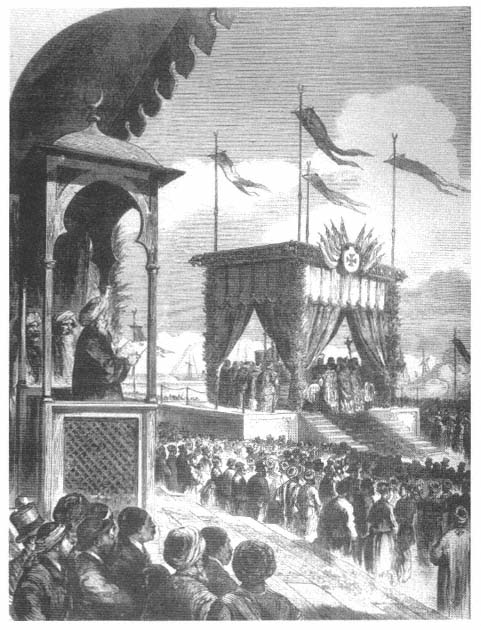
Figure 98.
Pavilion for the Muslim ulama (left) and pavilion for the representatives of the
Catholic church (right), Ismailiyya, 1869 ( The Illustrated London News, 11 December 1869).
Timsah. A round veranda, furnished with sofas, led to the main staircase in the grand vestibule, decorated in "Moorish" style. On either side of the vestibule were reception rooms in "Arab style" with polychrome stained-glass windows and intricate woodwork. The second story of the palace had not been completed by the time of the inauguration ceremonies. For the main reception, a special hall large enough to accommodate a thousand tables was built on the dunes facing the palace. The dining room for the visiting sovereigns abutted this hall; it was transformed into a tropical garden with plants brought from the greenhouses and gardens of the Gazira Palace. The chandeliers, the furniture, the paintings, the fountains, and the mirrors were in the "latest Parisian taste."[44]
Ismailiyya was further decorated by Venetian masts with glittering streamers, flags in lively colors, garlands, arches of triumph, and inscriptions in honor of Isma'il Pasha and the guest sovereigns. Here a new city was to be built; its layout was marked on the ground and the names of the future arteries were indicated on large bands of cloth: Avenue of Empress Eugénie, Avenue of the Prince of Prussia, Avenue of Franz-Joseph—to honor Egypt's royal guests. At night, fireworks transformed the streets of Ismailiyya into "rivers of fire."[45]
The inauguration of the canal marked a new era for Isma'il Pasha's Egypt, one that saw Cairo's old fabric regularized and new quarters built in the Haussmannian manner. New social and cultural customs, moreover, were imported into Egypt from Europe, all of them rehearsed at the inaugural ceremonies for the Suez Canal. According to a French guest: "at night, the salons of Cairo and the theaters welcome the guests. White tie is worn, and the evening begins at the house of a pasha or a bey; [it] ends at the Italian opera or the French theater or even the circus."[46]
The newspaper Nil projected the changes to come, beginning in the winter season following the Suez Canal festivities:
This season will show the old city of the caliphs to foreigners under a new light. Balls, concerts, vaudevilles, circuses, ballets, all kinds of performances, first-class hotels luxuriously furnished, entertainments and feasts of all kinds. . . . Nothing will be lacking this winter in the Paris of the Orient.[47]
The Impact
The period of isolation and individuation is ended and everyone tries to learn from others. Representatives of Muslim countries should attend [the international fairs] so that they may examine the exhibits and learn what will benefit their countries.
S. HARAYRI, Ard al-Badai al-Amm (The General Exhibition), 1867, quoted in Ibrahim Abu-Lughod
In these [Ottoman] compositions, there is a very developed and refined art and elements of decoration that could be used by our artists and artisans.
VIOLLET-LE-DUC, preface to Architecture et décorations turques, 1874
The impact of international expositions on architecture extended far beyond the fairgrounds. The shock of the new, symbolized most strikingly in exhibition structures such as the Crystal Palace (1851), the Eiffel Tower (1889), and the Galerie des Machines (1889), soon gave way to an acceptance of boldly engineered forms as appropriate to the industrial age. The countertrend, a return to classicism, also first appeared on the fairgrounds: the classical White City of Chicago (1893) led to the City Beautiful movement, which made an immense impact on urban planning in the United States. The return to classicism in this country paralleled that in Europe, as reflected in the major buildings of the 1900 Universal Exposition, the Grand Palais and the Petit Palais.
Although exposition architecture in the West has been studied in some depth, its cross-cultural influences have, for the most part, remained in the background. The goal of this chapter is to investigate this relatively unexplored area, first by looking at what the "Orient" learned from the expositions held in European and American cities and then by examining how Islamic pavilions affected Western architecture.
In both cases, the process of absorbing ideas was complex. Muslim nations had to reconsider and redefine their cultural identities in order to present a summarizing image; as they did, they re-evaluated their past and present architecture and made projections for the future. Along the way they had to come to terms with the widespread influence of the "advanced" world. The direct involvement of Europeans in architecture and urbanism (as colonial decision makers and as invited technocrats) complicated the issues further.
That Westerners had long been fascinated by the East was demonstrated, for example, by the eighteenth-century upper-class fad of turquerie, the imitation of Turkish tastes in clothing and decoration. But aside from such playful influences, a serious trend emerged in the nineteenth century, initiated in England by Owen Jones, who, with the help of his meticulously illustrated publica-
tions, attempted to place Islamic architecture in a theoretical context, which could be referred to in new buildings. The expositions changed the medium through which Islamic architecture was introduced to the West from drawings and descriptions to actual buildings. European and American architects could now analyze structures from other cultures and reinterpret them in their own work. The process involved a reassessment of their own culture and of what had been presented as Islamic culture. Although many Western architects opted to use literal references in an eclectic fashion, for others non-Western architecture gave rise to critical and philosophical debates.
Learning from the West
Architectural Theory
Architectural representation at the world's fairs brought a new focus to the discussion of architecture in Islamic countries themselves. Ottomans played leading roles among other Muslim nations, both in architectural practice and in theoretical debate—not a surprising phenomenon, given the independent status of the empire. The Ottoman government hired Europeans as architects and consultants, but not as policy makers. Thus if Western trends were followed in architecture and urban planning, this was the result of a conscious choice by the ruling elite.
Developments in graphic representation techniques and in architectural philosophy during the last three decades of the nineteenth century diverged considerably from the conventions of the classical period. Exhibitions did not cause these changes, but they acted as catalysts by publicizing them—for they were embodied in the pavilions themselves, in architectural drawings displayed at the exhibitions, and in theoretical debates published on these occasions.
The architectural historian Gülru Necipoglu-Kafadar describes Ottoman architectural practice as heavily reliant on detailed plans, often presented in a grid. The standardization and modulation of such a system meant that the imperial style could be rapidly disseminated throughout the provinces. The elevation drawings, however, dependent on the miniature painting tradition, remained schematic and imprecise and did not match the meticulously detailed ground plans.[1] In contrast, European drawings of Islamic monuments from the eighteenth century on presented carefully rendered perspectives, elevations, and sections, as well as plans.[2] These were executed using European
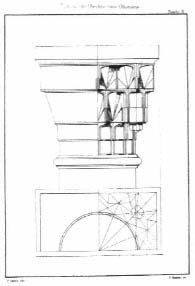
Figure 99.
Detail drawing from Montani Effendi
and Boghos Effendi Chachian,
Usul-u mimari-i Osmani .
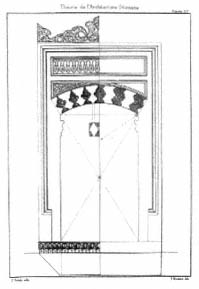
Figure 100.
Detail drawing from Montani Effendi
and Boghos Effendi Chachian, Usul-u
mimari-i Osmani .
techniques of graphic representation, which differed from the Ottoman practices in their rendering of elevations, sections, and perspectives. Detail drawings also belonged to the Western tradition and were introduced to the Ottoman Empire by European architects. The emphasis on Islamic details in Western drawings stemmed from the widespread belief among European architects that the value of Islamic architecture lay in its decorative creativity.[3]
As European architects began practicing in the Ottoman Empire, they brought with them their own graphic traditions, which soon became the norm. For example, when Parvillée was commissioned to work on monuments in Bursa, he documented his surveys with precise plans, elevations, sections, drawings that combined sections and elevations, and drawings of many details. Furthermore, in some of the section-elevation drawings, he indicated the analytical lines demonstrating the rules of geometry he had "discovered" (see Fig. 55). Some of this work, displayed at the 1867 Paris exposition, legitimized the "official" adoption of the graphic techniques (see pp. 96–106).
In Usul-u mimari-i Osmani, or L'Architecture Ottomanae, published by the Ottoman government on the occasion of the 1873 exposition in Vienna (see chapter 2), the drawings by Montani Effendi, Boghos Effendi Chachian, and M. Maillard displayed the same techniques and the same repertoire of plans, sections, elevations, and details, some in color (Figs. 99–100). The book was
based largely on lessons learned from Parvillée's work. Although Usul-u mimari-i Osmani was published one year before Architecture et décoration turques, the introductory essay, with its emphasis on "rules" and "necessary drawings," is not coincidental or original but a continuation of discussions of the science and the "hard facts" of architecture stemming from Parvillée's designs for the 1867 exposition, Anatole de Baudot's analyses of these pavilions the same year, and Parvillée's Architecture et décoration turques, whose foreword was written by Viollet-le-Duc.
The concern for the revival of Ottoman architectural forms in Usul-u mimari-i Osmani did not extend to a search for an Ottoman architectural theory; nineteenth-century Ottoman attempts to interpret local architecture remained anchored to the European way of thinking.[4] Although architectural theory in Islamic cultures is an elusive topic, yet to be studied, certain treatises stand out—among them two classical Ottoman texts that make sporadic references to the philosophical foundations of the discipline. In the biography of the great sixteenth-century architect Sinan, architecture was said to be the work of civilization; the great works of architecture and engineering symbolized the magnificence of the sultan and the state, embodying the height of civilization at the time. The architect was the creator of the civilized environment.[5] Cafer Efendi's early seventeenth-century treatise also attempted to place architecture in a broad context by making an analogy between the creation of the universe and architecture and by discussing the similar roles of harmony, geometry, and proportions in the arts—specifically music and architecture.[6] There was no comparable approach in L'Architecture ottomane or Architecture et décoration turques, which rationalized Ottoman architecture according to geometric and formalistic relationships. Although the first work speculated briefly on the appropriate uses of certain architectural elements, the discussion remained piecemeal.
Necipoglu-Kafadar's recent work emphasizes the geometric rules of classical Ottoman architecture. Although there were no elevation or section drawings in Ottoman practice, Necipoglu-Kafadar claims that elevations were "computed by traditional formulae deriving from proportions inherent in the geometric ground plans with modular grids"—not surprising given that Ottoman architects had a rigorous training in geometry.[7] In this light, Parvillée's analyses appear particularly relevant, even though he avoided cross-references between plans and sections/elevations. Further research may yet prove that his
analyses of Bursa's monuments, focusing on geometric relations and numerical proportions, are more insightful than previously believed.
Architectural Practice
Participation in the world's fairs had an impact on architectural practice in Muslim countries: the search for a representational image in the exposition pavilions enhanced the development of a neo-Islamic style. As we have seen, these countries were concerned to develop an architectural style appropriate to the new age that would also reflect their historical heritage. For Muslim as for Western countries the expositions provided a setting in which to test new ideas. Of course, the buildings themselves were not physically accessible to people at home, but, for example, the extensive information on them in the contemporary Ottoman press suggests their potential as models to be followed at home.
Neo-Islamic style after the 1850s differed from earlier architecture that referred to the Ottoman Empire's classical period, its acknowledged highpoint, as an enduring model. Until then building functions and programs had provided continuity between the monumental architecture of past and present: the building types—mosques; madrasas, or religious schools; hospitals; mausoleums; etc.—had remained the same. In contrast, the neo-Islamic style of the second half of the nineteenth century was applied to new secular building types, adopted from Western precedents: an Islamic architectural vocabulary was used in otherwise Beaux-Arts buildings.[8]
European architects designed the first neo-Islamic buildings in Istanbul, beginning in the 1860s. The early examples were architectural "fragments," like the Moorish-inspired gateway (originally conceived for the Golden Gate of the Theodosius walls) placed at the entrance of the new Ministry of Defense headquarters, now Istanbul University; it lined up neatly with the main gate of the ministry, designed by the French architect Bourgeois, its centrality accentuated by two symmetrical kiosks in a matching style (Fig. 101). The neoclassical military barracks in Taksim had an elaborate gate based on a mixture of "Islamic" styles from different regions (Fig. 102). The Islamic vocabulary of the tripartite portal to Bourgeois and Parvillée's 1863 building for the General Ottoman Exposition in the Istanbul Hippodrome (discussed in chapter 4) also stood out, but here the references were carried out in the facades as well.
The more radical applications of a neo-Islamic style occurred later in the

Figure 101.
Gate of the Ministry of Defense, now Istanbul University (photograph by the author).
century, most strikingly in two monumental buildings: the 1889 Terminal of the Orient Express (described in chapter 3 with reference to the Ottoman pavilion erected for the 1900 Universal Exposition) and the 1899 Public Debt Administration Building, designed by the French architect Antoine Vallaury (Figs. 103–105). Located prominently on the hill behind the terminal, Vallaury's building combined Beaux-Arts principles with elements of the local chitecture: the large caves and bay windows were borrowed from Turkish houses; the choice of materials, the monumental entrances, and the fenestration echoed certain Ottoman monuments. Unlike the Terminal of the Orient Express, Vallaury's building was an exercise in a purely Turkish-Islamic revivalist style.
The evolution of a neo-Islamic style in Istanbul went hand in hand with architectural experimentation in the Ottoman exposition pavilions. The earlier building "fragments" in the capital—like the gateway to the Ministry of De-
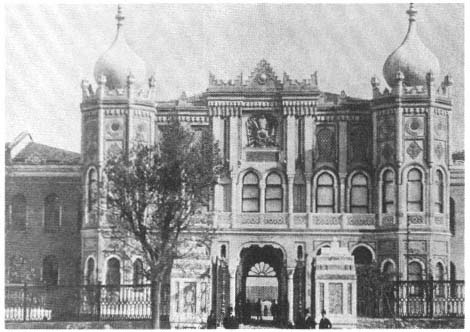
Figure 102.
Gate of the military barracks in Taksim, Istanbul ( Sehbal, 1908).
fense—had the ephemerality of a stage set, perhaps because they stood out on buildings and complexes in otherwise different styles (for example, neo-Islamic portals on a neoclassical structure, as in the military barracks in Taksim). In contrast, the later structures have an imposing permanence, as they confidently integrate the traditional vocabulary into their design. These buildings correspond to such reinterpretations of Islamic architectural forms as those in the Chicago and Paris exposition pavilions in 1893 and 1900.
Cairo's Neo-Arabic Renaissance" (so named by Robert Ilbert and Mercedes Volait) paralleled the architectural developments in the Ottoman capital and originated in a similar concern about the loss of local architectural traditions under the growing influence of Western styles. For example, in 1871 Frantz
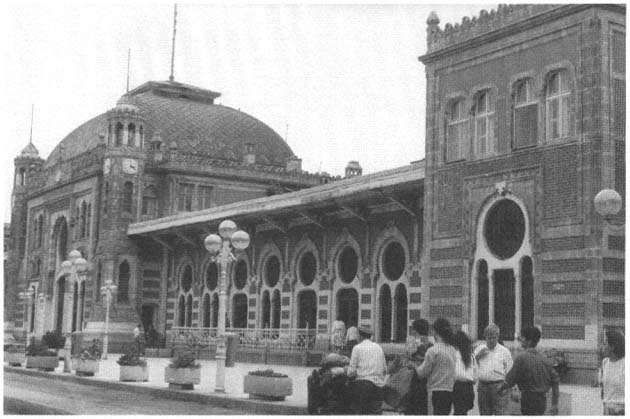
Figure 103.
Terminal of the Orient Express, Istanbul (photograph by the author).
Bey warned that the old facades might soon disappear; ten years later it seemed to another commentator that "everything is threatened by the banal transformations which are invading our cities from the West."[9]
In the late nineteenth-century architecture of Cairo and Alexandria, regional features such as corner stalactites, geometric bands defining windows, crenellations, musharabiyya s, and even minarets were used decoratively in public and residential buildings (Fig. 106).[10] But local elements also came into play in fundamental changes of compositional principles. For example, the spatial organization of family functions in the Gazira Palace (built in 1863 by Frantz Bey and Curel) as well as in some villas of the 1870s was based on "a liberal way,
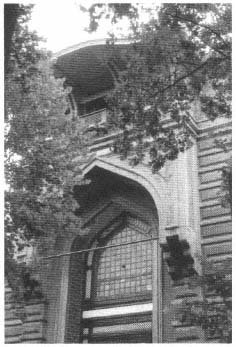
Figure 104.
Public Debt Administration Building,
Istanbul (photograph by the author).

Figure 105.
Public Debt Administration Building,
Istanbul (photograph by the author).
not . . . terrible old traditions";[11] thus in residential quarters the sexes were not rigidly divided.
The decorative trend became popular in small-scale buildings, such as single-family residences or apartment buildings, whereas the more radical trend was pursued in larger-scale public projects (for example, in the work of al-Sayyid Mitwalli Effendi, who was in charge of a number of public buildings for the Ministry of Public Works in the 1900s). Some of the intelligentsia, among them Mariette-Bey, claimed that a return to "Moorish decoration" was "childish." Although the theoretical debate, as well as most of the neo-Arabic structures, had been originated by European (French, German, and Italian) ar-
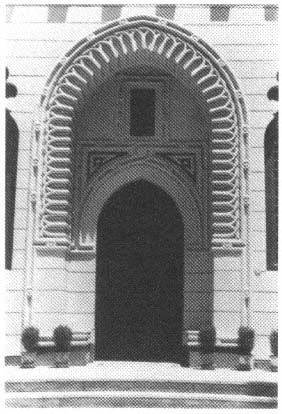
Figure 106.
Entrance to Khayri Bey Palace, Cairo, 1870
(Mimar, no 13, 1984).
chitects, these men received their orders from Westernized Egyptian officials, including 'Ali Mubarak Pasha, Isma'il Pasha's Paris-educated minister of public works—the Haussmann of Cairo. Therefore, while the proponents of neo-Arabism in Egypt were European architects, the style reflected Egyptian social and cultural transformations, especially among the ruling elite and the newly developing "cosmopolitan bourgeoisie" for whom neo-Arabism was "an expression of a search for identity."[12]
This search for identity was rehearsed in the exposition pavilions abroad. In fact, the same men who built the pavilions—among them Mariette-Bey—played leading parts in the construction industry in Egypt. The populist "decorative" approach corresponded to the attempt to represent Egypt truthfully at Western fairs in "streets of Cairo" characterized by irregular outlines, mush-
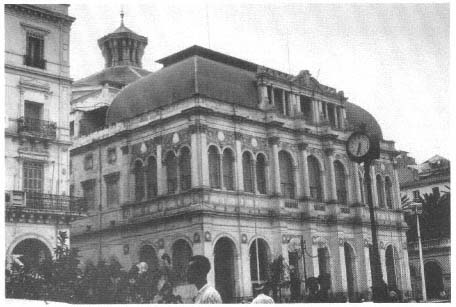
Figure 107.
Theater, Algiers (photograph by the author).
arabiyyas , arabesques, and dirty facades with peeling paint. In contrast, the search for fundamental transformations benefited from the construction of neo-Arabic palaces and okels on the exhibition sites.
The architectural scene in the French colonies of North Africa differed from that in the Ottoman Empire and Egypt. The colonizers in North Africa first expressed their presence and power through a deliberately foreign architecture. From the conquest of Algeria in 1830 to the 1900s, a "neo-classical austerity" dominated,[13] beginning with extensive demolition in Algiers for a large Place d'Armes for military maneuvers and the construction of the first arcaded streets that cut through the lower Casbah.[14]
Although the demolished sections of Algiers were filled with new buildings in the "conqueror's style" (Fig. 107),[15] the French were not indifferent to North Africa's architectural heritage. From 1867 on, they constructed neo-Arabic pavilions to represent the colony at the universal expositions. In such "indigenous" architecture they effectively displayed the wealth and the extent of their imperial power, reserving the neoclassical "conqueror's style" for the Palace of the Ministry of Colonies.
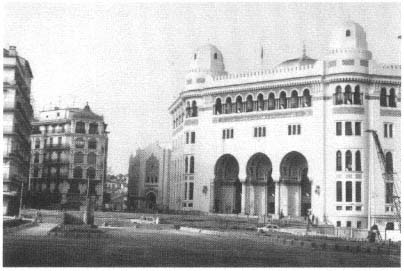
Figure 108.
Central Post Office, Algiers (photograph by the author).
After the turn of the century, as the political agenda shifted from "assimilation" to "association" under the leadership of Algeria's Governor-General Charles Jonnard, French architectural policy in the colonies showed a similar shift, realized in a "spirit of conciliation and tolerance."[16] The official buildings in Algeria, Tunisia, and later Morocco began to quote the local heritage, leading to a new architecture that combined the principles of modernism with highly interpreted historical forms (Fig. 108). The preparatory work for this phenomenon, called arabisance by François Béguin, had already been completed at the world's fairs where architects of the colonial pavilions had interpreted the Islamic architecture of the colonies according to Beaux-Arts principles. During the first decades of the twentieth century, early modernists incorporated the "simple contours and facades" of Arab architecture into their repertoire, creating an architecture of "association" based on the elementary forms, geometric masses, and sparse decoration of France's North African colonies.[17]
Learning from Islam
The fairs that provided architects with an unprecedented freedom to experiment were also, with their hundreds of thousands of visitors, active dissemi-
nators of ideas, spread even more widely by the popular and professional journals that dedicated long sections to the architecture of the pavilions. Expositions thus created rare opportunities to extend the discussion of architecture beyond professional circles to the general public; and fairgoers' responses to architectural experiments could indicate future success or failure.
Among the epoch-making exposition buildings, a few stand out for their resourceful interpretation of Islamic forms. Although many pavilions drew inspiration from Islamic buildings, the case studies included here distinguish themselves as significant theoretical and aesthetic statements.
Owen Jones at the 1851 London Exposition
The 1851 Universal Exposition precedes the period covered in this study. Because of the impact of Owen Jones's ideas on many leading architects, however, his contribution to the Crystal Palace must be discussed along with his theoretical stand. Joseph Paxton's Great Exhibition Building, known as the Crystal Palace, was decorated by Owen Jones according to principles he had drawn from Islamic architecture and particularly from the Alhambra, the palace of Muslim governors in Granada (Fig. 109). Jones's goal was to create a "new style" that would evolve from modern technology and would create forms capable of accepting color. Earlier, he had proposed to use new materials (iron and glass) in a grammar derived from Islamic buildings. But, as these proposals were never realized, the exposition provided a much-cherished opportunity for Jones to test his ideas.[18]
Jones claimed to have based the interior decoration of the Crystal Palace on the following principles:
1. The Construction is decorated; decoration is never purposely constructed.
2. Beauty of form is produced by lines growing out from one another in gradual undulations; there are no excrescences; nothing could be removed and leave the design equally good or better.
3. The general form is first cared for; this is subdivided and ornamented by general lines; the interstices are then filled with ornament, which is again subdivided and enriched for closer inspection.
4. Color is used to assist in the development of form, and to distinguish objects, or parts of objects, one from another.
5. And to assist light and shade, helping the undulations of form by the proper distribution of the several colors; no artificial shadows are ever used.
6. That these objects were best obtained by the use of the primaries on small surfaces, or in small amounts, supported and balanced by the secondary and tertiary colors on the larger masses.[19]

Figure 109.
Owen Jones, interior of the Crystal Palace (Victoria and Abort Museum, London,
printed in Damp. The Islamic Perspective ).
Jones developed these principles into the "general laws" of his Grammar of Ornament, published in 1856. The "general laws" of decoration, he argued, were common to historical styles but were independent of their particularities.[20] He presented various Islamic styles as valuable "guides" for a new architecture, especially in their use of decoration and color, and argued that the Alhambra was the "culminating point" of Islamic architecture.[21]
In the Crystal Palace Jones put into practice a color theory he had formulated based on archaeological (Greek, Egyptian, and Moorish) sources: blue, a relieving color, should be used on concave surfaces; yellow, an advancing (projecting) color, should be applied to convex ones; and red, "the color of the middle ground," was appropriate for horizontal surfaces. White helped to divide the primary colors, as in antiquity. Because the Alhambra was Jones's authority for the "proportions of color and methods of application," his "new style" had an "Oriental" feel. Furthermore, his design called for large hangings to separate the sections of the upper level, accentuating the barrel-vault effect of the interior and giving it the look of a bazaar—another touch of the East.[22]
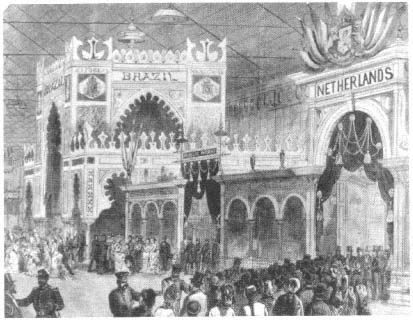
Figure 110.
Furness, Brazilian pavilion, Philadelphia, 1876 (O'Gorman, The Architecture
of Frank Furness ).
Jones created this atmosphere not by replicating Islamic forms but by interpreting them according to theoretical premises. Later his persistent search for the "science" of architecture and his incorporation of Islamic principles into this "science" would be pursued from another angle by French rationalists under the leadership of Viollet-le-Duc.[23]
Frank Furness at the 1876 Centennial Exposition in Philadelphia
Frank Furness, the controversial Philadelphia architect, designed the Brazilian section in the main building of the 1876 Centennial Exposition in a neo-Islamic style (Fig. 110). Although the choice of style may seem peculiar for a Brazilian pavilion, it makes sense in terms of Furness's work, which was inspired by Islamic architecture. Furness had never been abroad, so he had seen neither Islamic monuments themselves nor the Ottoman, Egyptian, and North African exposition pavilions in Europe. Buildings erected in America in Islamic styles earlier in the nineteenth century were whimsical imitations, recalling European "follies,"[24] and as such they differed from Furness's highly interpreted use of Islamic forms.
A more direct influence on Furness may have been his mentor, Richard Morris Hunt. Hunt's cast-iron building for the Tweedy and Company Store (1871–72) in New York had a facade with lobed horseshoe arches of different scale on different levels and entrances inspired by mihrabs , or niches indicating the orientation of Mecca in mosques.[25] Hunt's comprehensive library, which included works on Islamic architecture, was available to his apprentices.[26] Furness might also have benefited from discussions with Henry Van Brunt, another of Hunt's protégés. In iron buildings Van Brunt advocated the "incised" (rather than the "applied") ornamentation and contrasts of color characteristic of Islamic architecture.[27]
Publications, however—especially those of Owen Jones—appear to have been the main source of Islamic influence on Furness. James O'Gorman has shown Jones's direct influence, for example, in some of Furness's floral patterns.[28] But, more significant, Furness adopted Jones's theoretical position on the integrity of form and decoration. In interpreting Islamic motifs, Furness went back and forth from literal borrowings to unconventional adaptations, from the Rodef Shalom synagogue (Fig. 111) of 1869, with its horseshoe-arch windows and its choir a Moorish maqsura (enclosure near the mihrab ) topped by an octagonal pavilion reminiscent of garden kiosks and fountains, to the Pennsylvania Academy of the Arts of 1871, with its three-story-high portal inspired by mosque portals and mihrabs (Fig. 112), and the Guarantee Trust and Safe Deposit Company Building of 1873, with its playful pointed arches and its fenestration serialized and superposed in an Islamic manner.
Furness employed his favorite Islamic themes in the Brazilian pavilion: the horseshoe arch and the pointed arch (both scalloped), crenellations, the superposition of square-sectioned columns over circular ones to create height and an elongated effect, clusters of circular columns to mark entrances, and brightly colored glass tiles and floral ornament. The screen-like walls defining the enclosure combined all these borrowed "Moorish" elements. Although Brazil was far from the Orient, it had a labyrinthine link to Islam through Portuguese colonization and the Moorish architectural heritage of the Iberian peninsula; Furness evidently associated Brazil directly with an Islamic style, for he neither experimented nor interpreted in designing the Brazilian section, as he did in other buildings designed for Philadelphia.
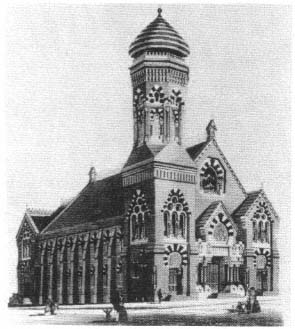
Figure 111.
Furness, Rodef Shalom synagogue, Philadelphia
(O'Gorman, The Architecture of Frank Furness ).
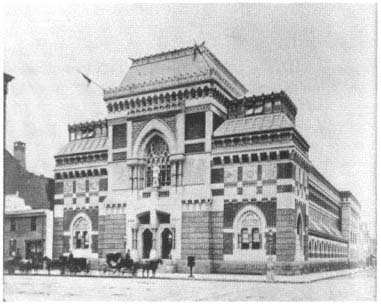
Figure 112.
Furness, Pennsylvania Academy of Arts, Philadelphia
(O'Gorman, The Architecture of Frank Furness ).
Gabriel Davioud at the 1878 Paris Exposition
Gabriel Davioud, one of Baron Haussmann's leading architects in the rebuilding of Paris, designed the imposing Trocadéro Palace for the 1878 Paris exposition in cooperation with an engineer named J. D. Bourdais (Fig. 113; see also Fig. 34).[29] It became a landmark and the focus of expositions that followed, with its fountains and the Place de Trocadéro, a large open space between the palace and the Seine.
The palace was novel not in its organizational principles but in its architectural vocabulary. It was sited conventionally, on an axis with the Ecole Militaire across the Seine. Its domed central section (a theater that could hold six thousand persons) was symmetrically framed by curving lateral galleries. The style was viewed skeptically by some contemporaries, endorsed by others. According to one observer, the dome and towers were Byzantine.[30] Others defined the structure as "a mixture of many styles—Greek, Roman, Byzantine, Arabian, and Renaissance,"[31] or as "Romano-Spanish-Moorish." Yet another associated it with modernism: "It is neither this nor that, but it is modern."[32] Viollet-le-Duc applauded Davioud for his "judicious employment of materials."[33]
Perhaps the most striking Islamic elements in the Trocadéro Palace were the two square towers, modeled after the minarets of North African mosques—with elaborately ornamented facades and domed pavilions. The pavilions at either end of the building, used as entrances, each with large arches, a single dome, crenellations on the roofline below the dome, and large rosettes ornamenting the facades, recalled the portals of Islamic monuments. The portal motif was repeated in four secondary entrances on the curving colonnade; these were simpler variations on the same theme. The Islamic vocabulary was further expressed in the fenestration as well as in the bands of red stone and the polychromatic exterior decoration of tiles and mosaics.
The palace overpowered everything else on the fairgrounds. Its scale is understood best in the context of other exposition buildings, for example, the Algerian, Tunisian, and Moroccan quarters, situated in front of the Palace. The architectural references in these quarters were similar to those in the palace, but the scale in the colonial village was much smaller, the entire North African section being about the size of the central part of the Palace.
The majesty of the Trocadéro Palace helped to focus interest on Islamic architecture in Paris perhaps even more than the Islamic pavilions themselves. As the main building of the exposition, it was designed by an eminent Parisian archi-
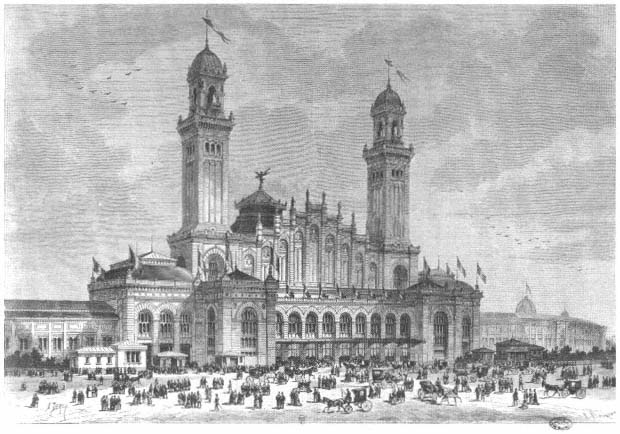
Figure 113.
Davioud and Bourdais, Trocadéro Palace, back facade, Paris, 1878
(Bibliothèque Nationale, Département des Estampes et de la Photographie).
tect, yet it marked a divergence from the norms of Western architecture in its vocabulary, its incorporation of Islamic forms into a Western syntax in a major structure. A contemporary critic called it "one of the greatest, naivest, most amusing feats in architecture ever achieved." The same critic found it graceful and playful, but "not a style to imitate."[34] And in fact it set no precedent; neo-Islamic forms appeared only sporadically afterward in French architecture.
Adler and Sullivan at the 1893 World's Columbian Exposition in Chicago
Louis Sullivan and Dankmar Adler's Transportation Building was one of the most memorable structures at the 1893 Columbian Exposition in Chicago (Figs. 114–115). As an "architectural exhibit"[35] in itself, it served one of the main goals of world's
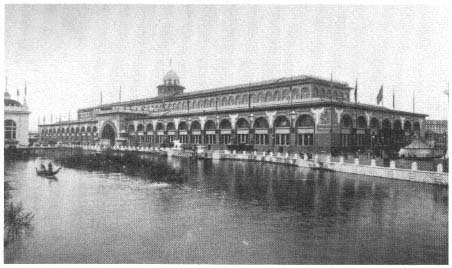
Figure 114.
Adler and Sullivan, Transportation Building, Chicago, 1893 ( World's
Columbian Exposition ).
fairs: education. Its location off the Court of Honor, where the main buildings of the exposition were erected in a uniform neoclassical style on an axial and symmetrical plan, enabled Adler and Sullivan to break some of the rules spelled out by the organizing committee and experiment with exterior ornamental forms. Nevertheless, they had to adjust their structure to its context and conform to exposition guidelines.
With its cornice line and the rhythm of its openings determined by other buildings in the main section, the Transportation Building fit snugly into the Beaux-Arts site plan. Its design also followed the conventions of the time: a central hall with an arcaded clerestory and a dome. But in the treatment of its surface and the color of its facades it contrasted with the other buildings in the White City. The exterior walls were light red at the lower level; the elaborate spandrels above were characterized by their "high pitch intensity in color." Winged figures on the spandrels were metaphors for transportation against a gold-leaf background. The main feature of the pavilion was the hundred-foot-wide and seventy-foot-high Golden Gateway, formed by concentric arches painted in gold.[36]
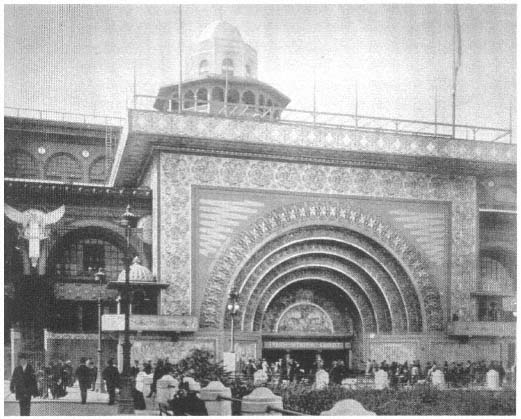
Figure 115.
Adler and Sullivan, Transportation Building, the Golden Gateway. Chicago, 1893
(The Great White City: A Picture Gallery of the World's Fair and Midway
Plaisance, Chicago, 1893).
The architects emphasized the external polychromy as the basis of their design:
The architecture of the building . . . has been carefully prepared throughout with reference to the ultimate application of color, and many large plain surfaces have been left to receive the final polychrome treatment. The ornamental designs for this work in color are of great and intricate delicacy; the patterns, interweaving with each other, produce an effect almost as fine as that of embroidery. As regards the colors themselves, they comprise nearly the whole galaxy, there being not less than thirty different shades of color employed.[37]
Sullivan did not refer to Islamic precedents in this explanation of the Transportation Building (though others did).[38] In a letter to Daniel Burnham on 16 October 1893, he argued that he had designed the Transportation Building in a "natural" manner, expressed by "elementary masses carrying elaborate decoration." He achieved geometric simplicity by using straight lines and semicircles. In contrast to this simplicity was the structure's richly colored decoration, created by "systematic subdivisions." In his use of color, Sullivan intended to reflect "the true nature of polychromy," combining and repeating "a great many colors" in sequence.[39]
In Kindergarten Chats, he further clarified his point:
A decorated structure, harmoniously conceived, well-considered, cannot be stripped of its system of ornament without destroying its individuality. . . .
It must be manifest that an ornamental design will be more beautiful if it seems a part of the surface or substance that receives it than if it looks "stuck on," so to speak. . . . Both structure and ornament obviously benefit by this sympathy, each enhancing the value of the other. And this, I take it, is the preparatory basis of what may be called an organic system of ornamentation.[40]
Among the critics of the Transportation Building was Montgomery Schuyler, who, arguing that Adler and Sullivan had turned Islamic architecture inside out, repeated the common misperception that all Islamic architecture is interiorized:[41]
The Saracens, indeed, attained an interior architecture of plaster, and this architecture comprises all the precedents that were available for the architects of the Transportation Building. The outsides of those Saracenic buildings of which the interiors are most admired are little more than dead walls. One cannot fail to respect the courage and sincerity with which the architects . . . tackled their task.[42]
Another contemporary critic, Charles Mulford Robinson, the acknowledged theorist of the City Beautiful movement, called this building "the bride of the Orient." Uneasy with its "strange" details, Robinson emphasized its otherness among the structures of the White City: it had a "voluptuous Orientalism," which caused it to stand out among the more masculine structures.[43]
Arguing that Sullivan's building synthesized ancient, medieval, and Islamic elements, the architectural historian Dmitri Tselos notes analogies to Islamic monuments of North Africa and India—among them the twelfth-century Aguenaou Gate in Marrakesh.[44] In fact, Sullivan's references to both the interior and exterior elements of Islamic monuments are broader than Tselos suggests. The hierarchical treatment of surface elaboration from planar to complex ornamentation is common in the architecture of many Islamic regions; for example, in Morocco, on the minaret of the Mosque of Sultan Hasan in Rabat from the Almohad period (late twelfth century). The curvilinear vine-and-scroll motif occurs in Syria on both Byzantine and early Islamic buildings of the Umayyad period; in later centuries it is found on the mihrab of the Great Mosque of Cordoba and in the surface decoration of many Mamluk buildings in Cairo. The Golden Gateway of the Transportation Building recalls the Rabat Gate in Oudna's fortifications (late twelfth century) as well as tombs in Bukhara, such as the Tomb of the Samanids, with its receding arched portal. The multiplication of receding arches is also seen in the mihrabs of Mamluk mosques in Cairo. The small domed "porch" evokes sixteenth-century fountains in the center of mosque courtyards in Istanbul (e.g., Sokullu Mehmed Pasa mosque).
The list of precedents could be extended, but archaeological detective work is beside the point here. Even a quick study of the Transportation Building facade shows that the structure embodied not Islamic revivalism but, in Sullivan's words, a rejection of "historical styles."[45] Although such a statement reiterates the ahistorical quality ascribed to Islamic cultures in general, for Sullivan this was not a negative trait but a redemption. Here was the potential to create a new architecture.
Sullivan's search was a philosophical one. He saw himself as a creator of culture for the New World whose architecture would express intellectual, emotional, and spiritual realities, satisfying the "real needs of the people."[46] To Sullivan, function meant "the whole life" that would be lived in a building. In his self-assigned role as prophet, he would interpret American life and idealize its egalitarian dimension, which he believed was best expressed by forms drawn from distant sources. His "exoticism" and his references to other cultures voiced his dissatisfaction with the dominance of classical forms. Nevertheless, Sullivan's "Orientalism" was purely formal: he referred to Islamic architecture
not because he was inspired by the civilization of Islam but only because the source was formally a novel and refreshing one.
Eugène Hénard at the 1900 Paris Exposition
Eugène Hénard is best known for his future-oriented urban design projects of the 1910s, which consolidated the technological developments of his time and focused on the problems of motor traffic. Like many architects of his era, Hénard apprenticed at the world's fairs, as both an architect and an urban designer. The Avenue Nicolas II and the Pont Alexandre III are his surviving achievements in Paris from the 1900 exposition. Hénard, to honor the "fire of the century," also designed one of the most spectacular structures of this exposition, the Palace of Electricity—a rectangular structure, 150 by 80 meters, near the Eiffel Tower. Its main room, called the Palace of Illusions, was a large hexagonal hall lined with mirrors for light and sound shows. It was here that Hénard appealed to Islamic architecture: to create a building "in air," he relied on an "intensive and original decoration," but only on the upper levels of the structure (Fig. 116).[47]
The dome of the Palace of Electricity was its most striking feature. Trilobed horseshoe arches carried its load down to six sets of supports—each a cluster of three columns on high pedestals. The elaborate detail of the structure, built entirely of iron, glass, and zinc, produced the effect of "metallic lacework,"[48] but because the materials belonged to the new age of industry, the structure seemed to one contemporary observer to resemble "an extravagantly sumptuous factory rather than an exposition palace."[49]
The Great Mosque of Cordoba provided Hénard's inspiration for both the architectural elements and the spatial qualities of the palace, particularly the sense of infinity created by the repetition of elaborately detailed arches in two directions. Although the Palace of Electricity had neither the space nor the programmatic justification for duplicating the Great Mosque, Hénard, to glorify the power of electricity, used mirrors to create multiple reflections of the illuminated arches, their complex supports, and their embroidered details.[50]
The exterior of the Palace of Electricity reflected the turn-of-the-century art nouveau style.[51] Hénard was undoubtedly searching for an architectural vocabulary for the new century, one without historicist references. Islamic architecture was different enough to help him formulate a new vocabulary. More-
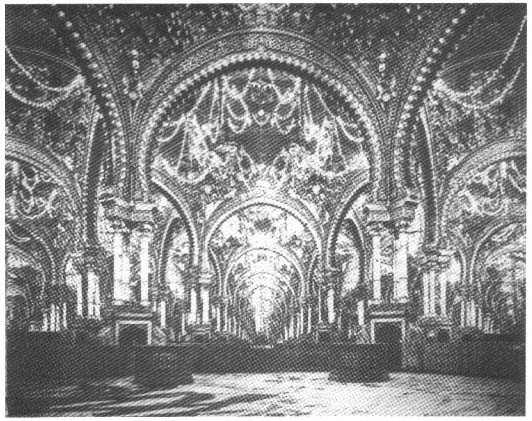
Figure 116.
Hénard, Palace of Electricity, Palace of Illusions, Paris, 1900
(Exposition universelle internationale de 1900, vues photographiques, Paris, 1979).
over, the features Hénard used in the palace created a fantastic aura consistent with that of nineteenth-century world's fairs. For Hénard, fantasy was not a thing of the past but an element of the industrial age, embodied in the magic of electricity.
Conclusion
The dialogue between Western architecture and Islamic architecture goes back to the birth of Islam in the seventh century. As Oleg Grabar has shown, the originality of the formative period of Islamic art and architecture lay in "a series of attitudes toward the very process of artistic creation"; these attitudes led to a redistribution of a rich repertory of forms from conquered lands, a persistent dissociation from the meaning behind these forms, and the creation of a small number of new forms.[52] Contact with Western art and architecture would not always result from the acquisition of territories; later, commercial ties played an increasingly important role.
In analyzing the impact of non-European arts on the West, Rudolf Wittkower argued that Western civilization incorporated non-European forms into its own sphere by "a triple challenge of ascending complexity: from the importation of non-European material, to its assimilation and adaptation, to its complete transformation,"[53] paralleling the processes described by Grabar for the early phase of Islamic art and architecture. Although cross-cultural studies in this area are just beginning, certain periods stand out for intensity of cultural exchange—for example, the second half of the fifteenth century, when contacts between Istanbul and Venice were particularly noteworthy. The attitudes toward the products of other cultures outlined by Grabar and Wittkower may well have characterized later periods as well, with variations depending upon specific conditions and contexts.
In the nineteenth century the frequency and the intensity of contacts between the two cultures increased, and the interpretation by one culture of the other's art and architecture became much more complex and widespread. It was no longer a matter of individual artistic choice but a force with a broad base in popular culture. The fairs celebrated the exchange between East and West. It is not surprising, then, that some of the most striking experiments in integrating Islamic forms into the Western buildings were carried out on the fairgrounds.
In the Ottoman Empire and in Egypt, the expositions acted as catalysts for intra-cultural developments. The architectural styles of the Ottoman and Egyptian pavilions reflected a quest for self-definition and a self-image that would fit contemporary needs while preserving a strong sense of each society's
history and culture, though that sense was often determined by the European viewpoint. The exposition pavilions were thus forerunners of neo-Islamic styles in the Ottoman Empire and Egypt. In the colonial context, however, the dominating culture appropriated the Islamic architectural heritage to its own stylistic repertoire, so that French architecture acquired a convenient image with which to furnish the North African colonies.
Epilogue
There is no vantage outside the actuality of relationships between cultures, between unequal imperial and nonimperial powers, between different Others, a vantage that might allow one the epistemological privilege of somehow judging, evaluating, and interpreting free of the encumbering interests, emotions, and engagements of the ongoing relationships themselves.
EDWARD SAID, "Representing the Colonized: Anthropology's Interlocutors," Critical Inquiry, Winter 1989
By the turn of the century, universal expositions had become a well-established tradition. But even as they occurred more frequently and spread to lands beyond Western Europe and North America, they began to have less of an impact on the public. Easier travel and more sophisticated communications made possible other ways of seeing and understanding foreign places, cultures, and societies. The original goal of representing the entire world in the microcosm of an exhibition grew obsolete. In the twentieth century specialized fairs focusing on industrial artifacts, arts and crafts, and colonial products became commonplace. With this shift the format of the fairs did not necessarily change; rather, many of the thematic and architectural experiments carried out at the universal expositions were adapted.
For example, the colonial exhibitions in France—first held in 1894 in Lyon, then in 1906 and 1922 in Marseille and in 1931 in Paris—duplicated many of the structures built on the Esplanade des Invalides in 1889. As Jean-Claude Vigato has argued, their architecture celebrated two aspects of colonial culture: the spectrum of exoticism (in the pavilions built according to the indigenous styles of territorial possessions) and the "civilizing mission" of expansionism (in the Western-style metropolitan palaces).[1] The exoticism is illustrated, for example, by one of the most memorable corners of the 1931 Colonial Exposition in the Bois de Vincennes in Paris: the Tunisian section. Designed by Victor Valensi, an architect who had studied Tunisian residential architecture, the complex had two components: the main pavilion, in a neo-Islamic style like that of the nineteenth-century national "palaces" at the fairs, and the market (the souk), reminiscent of the Rues du Caire and Rues d'Alger.
The Tunisian souk occupied a large area between two avenues abutted by buildings with irregular facades, creating an effect of incremental growth; a mausoleum and a minaret added "authenticity" (Figs. 117–118). The tortuous
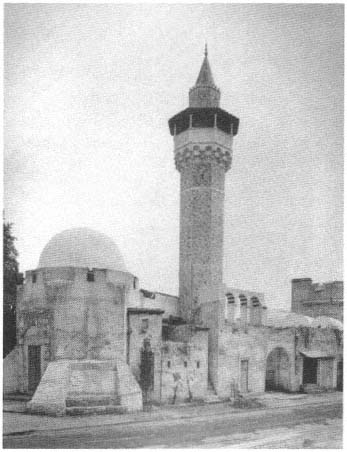
Figure 117.
Tunisian quarter, Paris, 1931 (L'Exposition coloniale de Paris,
Paris, n.d.).
interior streets were covered either by vaults or by the roofs of the structures on two sides, and they were poorly paved. The organic effect was enhanced by the use of stones to patch up a brick structure and vice versa; plastering was irregular (parts of it seemed about to fall); and striking fragments from demolished buildings were inserted randomly into the structures. In the words of a contemporary critic, "the architect Victor Valensi forced himself to reconstitute something badly built, and he succeeded perfectly."[2]
The quarter was populated by three hundred Tunisians in "national costumes," preparing and selling foods, working in leather and copper, and sell-

Figure 118.
Tunisian quarter, entrance to the souks, Paris, 1931 ( L'Exposition coloniale de Paris, Paris, n.d.).
ing all kinds of local crafts, among them carpets. Music was played in a café, where "real" Tunisian girls performed the belly dance—still popular, as demonstrated by the crowds attracted. A snake charmer displayed his talents (and thus belonged to Burton Benedict's "curiosities" category; see chapter 1). The architecture of the quarter, the presence of the indigenous people, and the products displayed and marketed, as well as the noises, smells, music, and singing, created an "integral reconstitution of [Tunisian] souks."[3]
The "civilizing mission" of Western culture was celebrated at the same fair in the Museum of the Colonies, designed by Léon Jaussely and Albert Laprade in
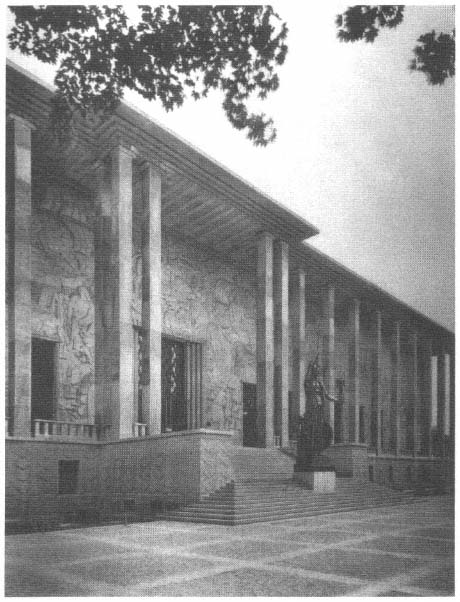
Figure 119.
Museum of the Colonies Paris, 1931 ( L'Exposition coloniale de Paris, Paris, n.d.).
the "Greco-Latin tradition" (Fig. 119). Laprade argued that a colonial style would not flourish under the Parisian sky; besides, it would be impossible to select one of the many colonial regions to represent all of overseas France. Nevertheless, elements from various colonies appeared in the structure. For example, the surface decoration in the subbasement suggested "primitive civilizations," the ironwork borrowed motifs from Berber carpets, and the Ionic capitals of the colonnade were found in a simpler form in southern Morocco.[4] The museum was seen at the time as belonging to the esprit nouveau, with "a perfume of Islam and of very primitive civilizations."[5] In addition, Albert Janniot's bas-reliefs in the colonnade, depicting the colonies of France, literally conveyed a message about the nature of colonialism (Fig. 120). Colonies were shown as well-integrated parts of the French sociopolitical and economic mechanism. It was argued at the time that Janniot's depiction was like a "mirror of the world" and carried no militaristic overtones—that it was not "a triumphal ode, but the familiar and grand epic of human activity and of nature's fertility."[6]
The pavilions of noncolonial Islamic nations in the twentieth-century expositions also carried over many traits from the preceding century. This is perhaps best illustrated in the structure Sedat Hakki Eldem designed for Turkey for the 1939 New York World's Fair (Fig. 121). The young Turkish republic, born out of the ashes of the Ottoman Empire, was represented in a complex that blended modernist and neo-Ottoman forms. For example, its main pavilion was derived from residential prototypes, reminiscent of the numerous Ottoman structures in nineteenth-century expositions and going back to the 1867 Pavilion du Bosphore. Its courtyard, with a fountain and brightly colored tiles, and its small reproduction of the covered bazaar in Istanbul reenacted other favorite themes. Meanwhile, the displays inside stressed the modernization of Turkey.[7] The tension between modernization and a historically defined cultural image thus continued.
Such a pattern has been common in the architectural representations of Islam in more recent world's fairs that have recycled, for example, the familiar elements that signified North African Islamic architecture to the West for one hundred years. The Moroccan pavilion at the 1967 World Exhibition in Montreal was a square building with a sixty-five-foot minaret; its decoration—horseshoe and lobed arches, sculptured wooden ceiling, mosaic floor—drew on cultural
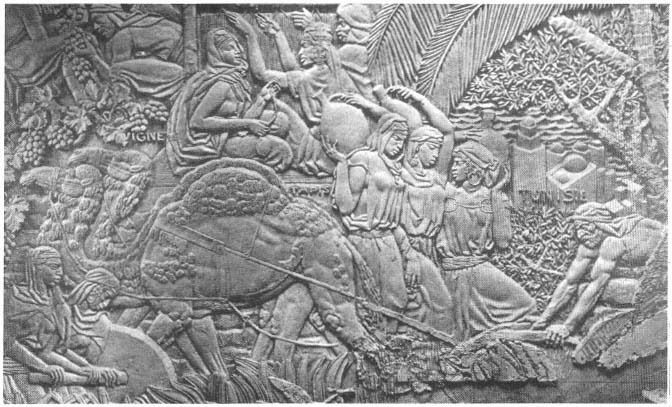
Figure 120.
Bas-relief depicting North Africa, Museum of the Colonies, Paris, 1931 (Charbonneaux, Les Bas reliefs du Musée des colonies ).
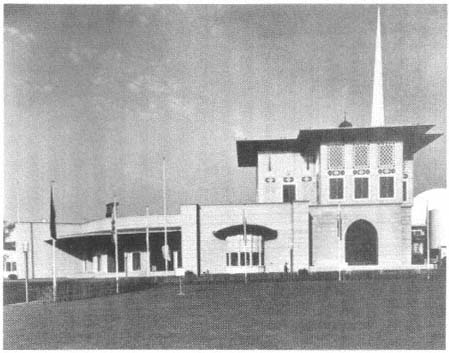
Figure 121.
Sedat Hakki Eldem. Turkish pavilion, New York, 1939 ( The New York World's Fair,
New York, 1977).
symbols that had long been part of the exposition repertoire (Fig. 122).[8] The Tunisian pavilion nearby was organized around a courtyard surrounded by arcades and vaulted areas, "recreating the authentic atmosphere of the souks . . . of Tunis"; under these vaults, weavers and coppersmiths practiced their crafts.[9]
The themes developed in representations of non-Western cultures at the universal expositions ultimately pervaded twentieth-century institutions and popular cultures. The following case studies give a broadbrush picture of the persistence of this nineteenth-century heritage and point to some new directions.
As an important cultural institution of our century, the Musée de l'Homme in Paris represents the French Left's impact on the reading of non-Western cultures in the 1930s. It was founded on a humanist universalism that reinterpreted anthropology and ethnography, but it pursued many themes from the nineteenth-century world's fairs. The Musée kid l'Homme (Museum of Man)
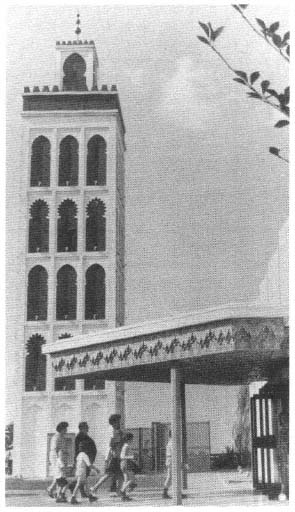
Figure 122.
Moroccan pavilion, Montreal, 1967 (General
Report on the 1967 World Exhibition, vol. 1).
goes back to the Musée Nationale d'Histoire Naturelle, established in 1793, which became the Musée d'Ethnographie du Trocadéro in 1878 and remained in the Trocadéro Palace after the closing of the exhibition. With its emphasis on re-creating the atmosphere of foreign places, the Trocadéro museum was a permanent version of the non-Western displays at the world's fairs and did not reflect a clear rationale: it was neither an instructive exhibit—like those typical
of natural history museums—nor a display of beautiful objects—as in a typical museum of art in the nineteenth century.[10] It was filled randomly with curiosities, costumed mannequins, dioramas, and so forth.[11] In 1938 the museum was reorganized as the Musée de l'Homme by two anthropologists, Paul Rivet and Georges-Henri Rivière, in a new building designed by Jacques Carlu, Louis Boileau, and Léon Azama.[12]
Rivet and Rivière's undertaking had radical scientific and political goals, as they attempted to present societies in their entirety by contextualizing the products through ethnographic research and documentation. All races and cultures were on exhibit, and neighboring cultures were placed next to each other to allow comparative observation of different regions. According to Rivet, the goal was
to assemble in a general synthesis the results provided by specialists and to force them thus to compare their solutions, to check them with one another and secure for them mutual support. Humanity is an indivisible whole, in space and time.[13]
The modern West, however, was altogether absent from this picture of humanity. In James Clifford's words, "the orders of the West were everywhere present in the Musée de l'Homme, except on display. . . . The identity of the West and its 'humanism' was never exhibited or analyzed, never openly at issue." Here, Westerners could observe other cultures and societies, but their own exclusion from the display reiterated their position of power.[14]
Once again, as at the expositions, non-Western cultures were placed on stage, arranged according to European norms. The siting of the indigenous quarters at the expositions prefigured the organization of the Musée de l'Homme: societies believed to be similar were placed next to each other. And like the world's fairs, the museum conveyed a political message about power relations between societies. Despite the intentions of their progressive and humanist founders, the ethnographic museums in France engaged in propagandistic activities on behalf of colonialism in the 1930s (they have been described as "incomparable instruments of colonial propaganda")[15] because of their effectiveness in acquainting the public in the metropole with the benefits of French possessions abroad. Moreover, just as the Musée d'Ethnographie du Trocadéro was an extension of the 1878 exposition, the Musée de l'Homme was conceived as a permanent part of the 1937 International Exhibition.
The parallels between the Islamic quarters of the universal expositions and some urban design experiments (in colonial and noncolonial settings) are also revealing. In chapter 5, I discussed the impact of the universal expositions on architectural theory and practice in Muslim countries in the late nineteenth century. The thread is longer and more tangled than the chapter suggests, however; it reaches to the present day and raises questions about the dialogue between cultures, in particular about the impact of colonial architecture on postcolonial efforts to express national cultures in pure and historically sound forms. As seen in this study, the expositions created settings where cultures were condensed into architectural summaries. The meaning of architectural representation differed in noncolonial and colonial contexts. In the noncolonial context, the search was for a cultural self-image that would underscore what was different about the represented nation and hence empower it as a distinct identity. In the colonial context, the subject and the object were no longer the same, and cultural characteristics of the represented culture were determined by the colonizing culture; the outcome was to empower the latter. Nevertheless, one type of representation influenced the other, and the end products displayed similar characteristics.
In the colonial context, neo-Islamicism in architecture had begun with the pavilions of North African colonies erected on the exposition sites. The appropriation of this style into large-scale buildings—from post offices to banks to theaters to townhalls—in the colonies formed the next stage, from 1900 on.[16] The third stage was marked by an interesting dialogue between indigenous architecture (in particular residential architecture) and early modernism. A number of studies by French architects in the 1920s and 1930s highlighted the spatial, picturesque, and architectonic qualities of vernacular architecture—among them Victor Valensi's L'Habitation tunisienne (1923), Augustin Bernard's Enquête sur l'habitation rurale des indigènes de la Tunisie (1924), Jean Galloti's Le jardin et la maison arabs au Maroc (1926) with sketches by Albert Laprade, and A. Mairat de la Motte-Capron's L'Architecture indigène nord-africaine (1932). This interest was connected to the resident general Louis Hubert Lyautey's romantic, if politically charged, notion of preserving the "poetry," the "originality," the "charm," and the "beauty" of the casbahs in Morocco and building modern French cities, villes nouvelles, adjacent to them in the 1910s and 1920s.[17] He described the Arab towns of North Africa passionately: "You are familiar with the nar-
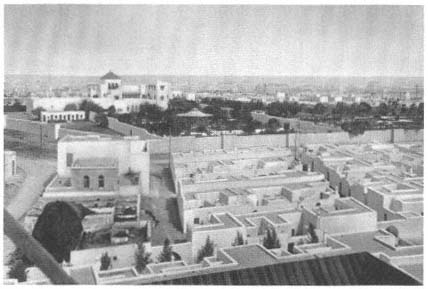
Figure 123.
Casablanca, Nouvelle Ville Indigène, aerial view (Vaillat,
Le Visage français du Maroc ).
row streets, the facades without opening behind which lies the whole of life, the terraces upon which the life of the family spreads out and which must therefore remain sheltered from indiscreet looks."[18]
The urban design policies of French planners for indigenous populations went beyond preservation and extended to the creation of new neighborhoods. Although in scale and ambition they may not have matched the new cities created for French settlers, experiment like the new madina of Casablanca made a significant impact, ultimately affecting the postcolonial searches for an expression of cultural identity in architecture and urban form. To accommodate the growing Moroccan population of Casablanca, Henri Prost, Lyautey's architect-in-chief, proposed a new quarter, separate and formally different from the settlements designed for the French. Albert Laprade, who had already undertaken a systematic study of the Moroccan vernacular, was chosen to design it. The project was then carried out by two of Laprade's associates, Albert Cadet and Edmond Brion, who took into consideration the "customs and scruples" of the indigenous populations as well as French "hygiene."[19]
Laprade's madina was based on Moroccan urban patterns, particularly the spatial contrast between the street and the interior courtyards of houses (Figs. 123–124). Reinterpreting local forms and decorative motifs, he created
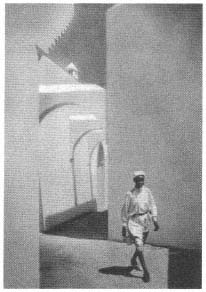
Figure 124.
Casablanca, Nouvelle Ville Indigène,
street (Vaillat, Le Visage français
du Maroc ).
"sensible, vibrant walls, charged with poetry." Although these white walls defined cubical masses, their irregularity gave them a "human" touch. The project was more than a stylistic exercise; the architect's ambition was to integrate into his design "values of ambience" as well as a "whole way of life." Architecture for Laprade was "a living thing" and "should express a sentiment." The spatial and programmatic qualities of the project revealed the goals of the architect clearly: there were pedestrian streets and courtyard houses, markets, neighborhood ovens, public baths, mosques, and Quranic schools—all in neo-Moorish styles, "preserving everything respectable in the tradition," but constructed with modern technology and materials.[20]
This emphasis on local forms and their broader meanings is associated with Lyautey's thoughts on Arab culture as different from European culture but not inferior to it:
[T]here, the secret, it is the extended hand, and not the condescending hand, but the loyal handshake between man and man—in order to understand each other. . . . This race is not inferior, it is different. Let us learn how to understand their differences just like they will understand them from their own side.[21]
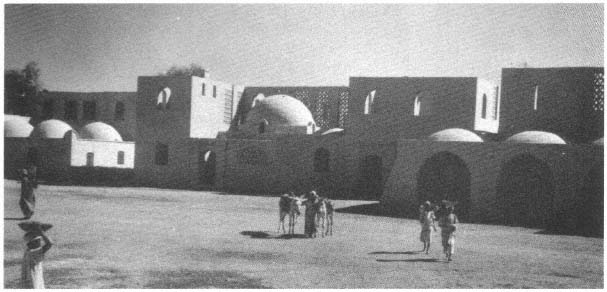
Figure 125.
Fathy, New Gourna, street (Fathy, Architecture for the Poor ).
Both Europeans and Arabs must understand that Arab culture is distinct from European culture. The architectural and urban forms that articulate this difference therefore must be continued. Benevolently paternalistic colonial administrators and architects assumed the responsibility to display Arab architecture to educate not only the French but also Arabs.
An attitude similar to Lyautey's characterizes the work of the distinguished Egyptian architect Hassan Fathy, whose well-known experimentation with the village of New Gourna goes back to the 1940s. Emphasizing the importance of tradition, Fathy reinterpreted the indigenous architecture of the Egyptian countryside, juxtaposing and reorganizing such key spaces as the square domed unit, the rectangular vaulted unit, the alcove covered with a half-dome, and the courtyard (Fig. 125). Arguing that the rural vernacular offered excellent examples of "light constructions, simple, with the clean line of the best modern houses," he relied on the power of volumes and masses and abstained from using color or texture on his walls.[22]
Fathy's insistence on returning to the oldest and purest building traditions of Egypt (those of the countryside) perhaps illustrates Frantz Fanon's analysis of the "passion with which native intellectuals defend the existence of their na-
tional culture,"[23] but it also grew out of French colonial architectural experiments in North Africa. Fathy's courtyards, private streets, and residential clusters; his aesthetics founded on simple volumes; his public building types (market, crafts khan, mosque, bath); and even his socially ambitious program had counterparts in Laprade's new madina. In New Gourna, Fathy attempted social reform by revitalizing the traditional way of life both in the built environment and in the patterns of production, which were founded on crafts and construction materials, namely making bricks. This approach was essentially like Laprade's idea of allowing for "a whole way of life" in the new madina.[24]
An even more striking parallel between Fathy and Laprade is their paternalism. Through such prominent spokesmen as Lyautey, French colonialists, as authorities on good taste and fine culture, argued they were reiterating the local culture and helping the Arab populations to understand and value their own heritage. Fathy's self-assigned mission was much the same: as peasants were increasingly coming to favor modern buildings, "an architect is in a unique position to revive the peasant's faith in his own culture. If as an authoritative critic, he shows what is admirable in local forms, and even goes as far as to use them himself, then the peasants at once begin to look on their own products with pride."[25] Therefore, the educated elite, represented by the architect in this instance, undertook to rejuvenate vernacular culture. Both parties feared losing "local culture" to "universal civilization." Whereas Fathy dreaded the universalizing effects of mass housing built by the Egyptian government and regretted the lack of a modern "indigenous style,"[26] Lyautey earlier had mourned the "hideous constructions" (built by French architects in classical styles) which were in the process of ruining the "charm and poetry" of Moroccan cities.[27] Yet each man's argument about built forms stemmed from different concerns and had different implications. For Fathy, a return to vernacular forms meant endowing modern Egypt with a cultural image, a manifest identity in the face of the universalizing power of Western technology. For the French colonists, the architecturally emphasized difference of North African Islamic cultures enhanced the power of France, not only because of the diversity of its possessions but also because of its tolerance.
The ironic discord between goals and forms echoes one of the main themes of the architectural representations of Islam in the nineteenth-century expositions. Whether designed by colonial powers or by independent states, the pa-
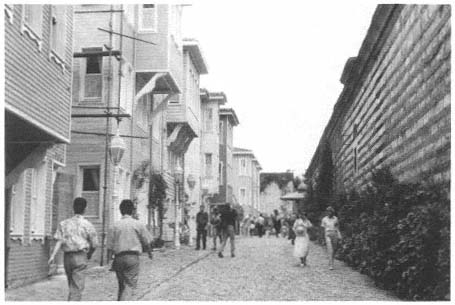
Figure 126.
Sogukçesme Street. Istanbul (photograph by the author).
vilions had similar architectural characteristics, which evoked a general "Islamic style." One might well question, then, the notion that architecture can be manipulated to summarize cultures and nations visually; architectural representation is never pure and is always colored by power relations.
Recent urban preservation/restoration ventures also recall the Islamic streets of universal expositions. Although the importance of conserving the historical heritage cannot be denied, to reject the immediate past and the consequences of sociocultural and physical transformations leads to questionable results. The restoration of Sogukçesme Street in Istanbul offers a striking case study (Fig. 126). Located in the historical core between the north wall of Hagia Sophia and the outer walls of the Topkapi Palace, this street was lined with modest houses—some wooden, some concrete and brick—set against the walls of the palace. To accommodate tourism and emphasize the picturesqueness of the street, the entire built fabric was demolished, rebuilt in concrete frame-brick infill, clad in wood paneling, and painted in different colors—all to evoke the atmosphere of Ottoman Istanbul as described in European travel literature. Disguised to look like houses, the new buildings are actually hotels and pensions, complete with restaurants, cafés, and night clubs.
This major intervention, involving the displacement of the former residents, changed the character of the street dramatically from that of a neighborhood to that of a touristic strip. With its stage-set quality (there is also a crafts workshop nearby), the seemingly authentic residential fabric is a contemporary version of the Islamic quarters of expositions, now situated in a city with a powerful Muslim heritage. Ironically, its alienation from the rest of the urban fabric of late twentieth-century Istanbul makes it as much a curiosity in that city as the Rues du Caire and the Rues d'Alger were in nineteenth-century Paris.
The story has a counterpart in many European cities today, where non-Western quarters have become an integral part of the urban reality. The economic advantage of using cheap labor from abroad, from the less fortunate "peripheries" of the capitalist system, resulted in the immigration of large numbers of guest-workers to European cities. Whereas large waves of immigrants were attracted from former colonies to the metropoles (North Africans to France and Indians to Britain) and other immigrants from poorer to richer countries in Europe (Turks and Greeks to Germany), the pattern was not definitive, and a mosaic of different nationalities began to coexist in European environments. During the past three decades ethnically distinct neighborhoods have soared: for example, the Nineteenth Arrondissement of Paris is populated by North Africans, and Berlin's Kreuzberg quarter is now known as kleine Istanbul . Though their architectural forms and styles are European, these neighborhoods bring a cultural otherness to these cities with their signs, smells, noises, languages, and different urban use patterns.[28] They thus duplicate some of the carefully orchestrated elements of the non-Western quarters at the universal expositions, albeit to stay and to redefine European urban/cultural identity.
Today some symbols once valued for their exoticism can lead to political confrontation. For example, the "headscarf controversy," which produced heated debates on laicism in public education in France in the fall of 1989, began when two Tunisian female students in a Parisian technical high school wanted to keep their heads covered to comply with an Islamic code.[29] The debates that followed raised important questions about the presence of the Other in European culture as well as the "speaking back" of this Other. They suggest that in the future binary oppositions may no longer define cultures and cultural boundaries themselves may disintegrate.
Yet Eastern dress has always fascinated Westerners, who have appropriated it for festivals and celebrations, like the masked balls at the court of Louis XIV.[30]
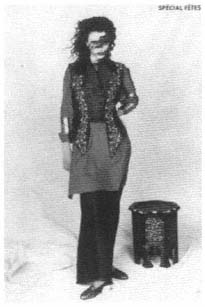
Figure 127.
"Kadine aux mousselines"
(Dépêche Mode [1989], no. 24).
Twentieth-century haute couture sporadically recycles images from the "Orient." Paul Poiret in 1911 made a memorable debut in fashion design with his "Oriental" collection, presented at a Thousand and Second Night party. The setting included illuminated fountains, Persian rugs, Middle Eastern music, and even souks with "craftsmen at work"—all of it probably borrowed from the stages of the universal expositions. In Peter Wollen's words, "The whole party . . . [was] set in a phantasmagoric fabled east."[31] A more recent version of sumptuous "Oriental" festivity was Malcolm Forbes's seventieth birthday party in August 1989, celebrated in Tangiers, where belly dancers and Moroccan cavalry provided the entertainment in luxurious tents. The famous guests of the billionaire showed up in Eastern-style clothing.
These grand-scale events affect popular culture. While editorials in the French press pursue the implications of the "headscarf controversy," another sector broadcasts new "Oriental" designs using terms like odalisque, reiterating (and exploiting) the historical fascination with the "imaginary Orient." In these images fashion models hide their faces behind literal or implied veils and display the submissiveness expected of Muslim women (Figs. 127–128). The
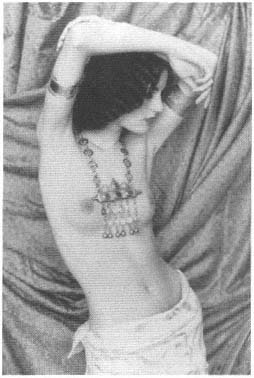
Figure 128.
"Odalisque aux bijoux" (Dépêche Mode
[1989], no. 24).
phantasmagoric attraction of Islamic cultures today thus coexists with the problematic sociopolitical reality stemming from the European absorption of these cultures.
The patterns of cultural representation encountered in nineteenth-century universal expositions, then, maintain their authority at large but have also become more complex in response to new sociopolitical and economic power relations. Even as Western popular culture imbues Islam with dreamlike images, the very symbols that represent the culture are seen as threats. Islamic cultures, on the other hand, continue to display themselves according to images drawn through the eyes of others, with references that rely heavily on nineteenth-century legacies and that broadcast simultaneously old and new value systems. This complex and multilayered dialectic—within each culture and between cultures—may play the most important role in the rapidly changing cultural definitions of the late twentieth century.
Notes
Introduction
1. Eric Hobsbawm, The Age of Capital, 1848-1875, 2d ed. (New York, 1979), 32-33.
2. Walter Benjamin argues that architecture is appropriated by touch and by sight. See his chapter "The Work of Art in the Age of Mechanical Reproduction," in Illuminations (New York, 1969), 240.
3. Edward N. Kaufman, "The Architectural Museum from the World's Fair to Restoration Village," Assemblage, no. 9 (1989): 22.
4. Benjamin calls the illusionary effects phantasmagoria. See Walter Benjamin, "Paris, Capital of the Nineteenth Century," in Reflections (New York, 1979), 152.
5. Montgomery Schuyler, "Last Words about the World's Fair," The Architectural Record 3 (July 1893-July 1894): 299-300.
6. This period also witnessed a great interest in travel to foreign countries. Feeding it was a vast travel literature, often richly illustrated to convey vivid images of foreign lands. Artists, especially the Orientalist painters, included in their works images from other cultures.
7. Benjamin, "The Work of Art," 240.
8. Edward Said, Orientalism (New York, 1978).
9. The term "Third World" implies a global order, neatly divided into clear and simple zones, each with a fixed place in the hierarchy. Yet cultures and societies are not abstract, oppositional, static, and sealed units. Trinh Mihn-Ha eloquently summarized the fallacy of the First World-Third World construct: "No system functions in isolation. No First World exists independently from the Third World; there is a Third World in every First World and vice-versa." See: Trinh Mihn-Ha, "Of Other Peoples,'' in Hal Foster, ed., Discussions in Contemporary Culture (Seattle, 1987), 138.
10. Edward Said, "Orientalism Reconsidered," Cultural Critique 1 (Fall 1985): 92-93, 97.
11. For a survey of expositions, see: Paul Greenhalgh, Ephemeral Vistas: The Expositions Universelles, Great Exhibitions, and World's Fairs, 1851-1939 (Manchester, 1988).
12. The account that follows relies largely on Ira Lapidus's History of Islamic Societies (Cambridge, 1988). General works on the topic include Charles Issawi, The Economic History of the Middle East, 1800-1914 (Chicago, 1966); and Roger Owen, The Middle East in the World Economy (New York, 1981). For the Ottoman Empire, see Niyazi Berkes, The Development of Secularism in Turkey (Montreal, 1964); R. H. Davison, Reform in the Ottoman Empire, 1856-1876 (Princeton, N.J., 1963); Bernard Lewis, The Emergence of Modern Turkey, 3d ed. (London, Oxford, New York, 1976); and Donald Quataert, Social Disintegration and Popular Resistance in the Ottoman Empire, 1881-1908 (New York, 1983). For Egypt, see G. Baer, Studies on the Social History of Modern Egypt (Chicago, 1969); and P. M. Holt, ed., Political and Social Change in Modern Egypt (London, 1968). For Algeria, see C. R. Ageron, Histoire de l'Algérie contemporaine (1830-1964) (Paris, 1966), and Les Algériens musulmans et la France (1871-1919), 2 vols. (Paris, 1968); and C. A. Julien, Histoire de l'Algérie contemporaine (Paris, 1964). For Tunisia, see Leon Carl Brown, The Tunisia of Ahmed Bey, 1837-1855 (Princeton, N.J., 1975). For Iran, see Shaul Bakhash, Iran: Monarchy, Bureaucracy, and Reform under the Qajars, 1858-1896 (London, 1978).
13. Gilbert Delanoue, Moralistes et politiques musulmans dans l'Egypte du XIXe siècle (Paris. 1982) vol. 2, livre V, 577.
14. Leon Carl Brown, The Surest Path (Cambridge, Mass., 1967), 23-33.
15. Brown, The Surest Path, 28.
16. James Clifford, Introduction to Writing Culture, ed. James Clifford and George Marcus (Berkeley and Los Angeles, 1986), 18.
17. Roy Wagner, The Invention of Culture, rev. ed. (Chicago and London, 1981), 4, 8-9.
18. Wagner, 35.
19. John Berger, Ways of Seeing (London, 1972), 9.
20. Wagner, The Invention of Culture, 2.
21. I owe this interpretation to Talal Asad's analysis of the ethnographer's translation of a culture. Because of its inscribed nature, Asad claims, the ethnographer's text assumes a "scientific" role and hence "gains a greater power to shape, to reform selves and institutions than folk memories do." See Talal Asad, "The Concept of Cultural Translation,'' in Clifford and Marcus, Writing Culture, 163.
22. Said, Orientalism, 2-5.
23. Norman Daniel, Islam, Europe, and Empire (Edinburgh, 1966), xvi. For a very different "Orient," seen through the eyes of European women, see Bilha Melman, "Western and Middle Eastern Women in the Colonial Era: Images of Europe's 'Other' and 'Self,'" paper delivered at the Minda de Gunzburg Center for European Studies, Harvard University, 27 April 1990.
24. Edward Said, "Intellectuals in the Post Colonial World," Salmagundi 70-71 (Spring-Summer 1986): 56.
25. Ibrahim Sinasi lived in Paris between 1849 and 1853 and, later, in the 1860s; al-Tahtawi lived there between 1826 and 1831, later visiting the city again in the 1860s; and Khayr al-Din lived there in the 1850s and the 1860s.
26. Albert Hourani, Arabic Thought in the Liberal Age, 1789-1939, 3d ed. (Cambridge, 1986), 68.
27. Serif Mardin, The Genesis of Young Ottoman Thought (Princeton, N.J., 1962), 267-268.
28. Ahmet Hamdi Tanpinar, XIX asirda Türk edebiyati tarihi, 3d ed. (Istanbul, 1967), 171-172.
29. Tanpinar, 172-175.
30. Delanoue, Moralistes et politiques musulmans, 2, livre V, 390-391.
31. Quoted in G. Douin, Histoire du règne du khédive Ismail (Rome, 1934), 2:10.
32. Delanoue, Moralistes et politiques musulmans, 2, livre V. 453.
33. Anouar Abdel-Malek, Idéologie et renaissance nationale, l'Egypte moderne (Paris, 1969), 208.
34. Delanoue, Moralistes et politiques musulmans, 2, livre V, 456.
35. Delanoue, 2, livre V, 485; Abdel-Malek, Idéologie et renaissance, 228.
36. Brown, The Surest Path, 38.
37. Brown, 10.
38. Brown, 46-47.
39. Brown, 168-170.
40. Brown, 35.
1— Muslim Visitors to World's Fairs
1. Paul Rabinow, French Modern (Cambridge, Mass., and London, 1989), 21-23. Greenhalgh points out that the rise of anthropology as a discipline occurred between 1878 and 1889 in Paris. See Geenhalgh, Ephemeral Vistas, 86.
2. Johannes Fabian, Time and the Other: How Anthropology Makes Its Object (New York, 1983), xi, 68, and 143.
3. Fabian argues that the ethnographer and the anthropologist see native society as a tableau vivant . See Fabian, 67.
4. Chicago Tribune, 17 June 1893.
5. Raoul Girardot, L'Idée coloniale en France (Paris, 1972), 83.
6. L'Exposition de 1889, 15 March 1889.
7. Charles Lemire, "La Transformation de l'exposition coloniale de 1900, L'Exposition des colonies, 1 January 1898.
8. Charles Lemire, "L'Exposition des colonies en 1900," L'Exposition des colonies, 1 August 1897.
9. Burton Benedict, "The Anthropology of World's Fairs," in The Anthropology of World's Fairs, ed. Burton Benedict (London and Berkeley, 1983), 2.
10. Robert W. Rydell, All the World's a Fair (Chicago and London, 1984), 5 and 235. Hannah Arendt traced the origins of "race-thinking" to Arthur de Gobineau's Essai sur l'inégalité des races humaines, published in 1853, arguing that by 1900, Gobineau's text had become "a kind of standard work for race theories in history." See Hannah Arendt, Imperialism, 4th ed. (San Diego, New York, London, 1968), 50-51.
11. Benedict, "The Anthropology of World's Fairs," 43-45.
12. Chicago Tribune, 21 June 1893. During the latter part of the century the Ottoman government had launched a reform to industrialize the country and exhibited its machine-produced goods (especially textiles) in Western cities. Yet because the machines themselves were European inventions, the production processes of Ottoman industry were not brought to the fairs.
13. A. Chirac, "Le Palais du Bey," L'Exposition universelle de 1867 illustrée (Paris, 1867), 42.
14. L'Illustration, 23 June 1878.
15. Chicago Tribune, 8 April 1893.
16. J. Charles-Roux, Les Colonies françaises, l'organisation et le fonctionnement de l'exposition des colonies et pays de protectorat (Paris, 1902), 210-211.
17. L'Illustration, 15 September 1900.
18. Le Figaro, 19 May 1900.
19. The "people as freaks" category, however, existed in the Islamic quarters of the exhibitions as well. For example, Cairo Street in Chicago in 1893 was crowded with wrestlers, acrobats, sword-swallowers, fire-eaters, snake charmers, and fortune-tellers. See the Chicago Tribune, 5 April 1893.
20. Ben. C. Truman, History of the World's Fair (Philadelphia, 1893), 558.
21. "Le Palais de l'Egypte," L'Exposition de Paris (Paris, 1903), 3:6; Julien Tiersot, Musiques pittoresques, promenades musicales. L'exposition de 1889 (Paris, 1889), 95-98.
22. P. Jorde, "Le Théâtre du pavilion ottoman," L'Exposition de Paris, 3:161.
23. See, for example, H. Lavoix, "L'Orient à l'Exposition universelle," L'Illustration, 22 July 1867; L'Illustration, 18 May 1878; and P. Jorde, "Le Théâtre du pavilion ottoman," L'Exposition de Paris, 3:161. These views are uninformed by the serious investigations of many nineteenth-century historians of music, who included non-Western music in their publications. For further discussion, see Philip V. Bohlman, "The European Discovery of Music in the Islamic World and the 'Non-Western' in Nineteenth-Century Music History,'' The Journal of Musicology 5, no. 2 (Spring 1987): 147-163.
24. Truman, History of the World's Fair, 558.
25. Tiersot, L'Exposition de 1889, 78.
26. Anouar Louca, Voyageurs et écrivains égyptiens en France au XIXe siècle (Paris, 1970), 193-194.
27. Eugène-Meichior de Vogue, "A Travers l'exposition," Revue des deux mondes 95 (1889): 451.
28. World's Fair Puck, 4 September 1893.
29. Zeynep Çelik and Leila Kinney, "Ethnography and Exhibitionism at the Expositions Universelles, " Assemblage, no. 13 (1990): 34-59.
30. Sylviane Leprun, Le Théâtre des colonies (Paris, 1986), 70-72.
31. René Maizeroy, "Les Théâtres éphémères à l'exposition, le théâtre égyptien," Figaro illustré, no. 124 (July 1900): 142-143.
32. Maizeroy, 143-144. The Thousand and One Nights had been instrumental in shaping European ideas about Islam since the early eighteenth century. First translated into French by Antoine Galland, it was published in twelve volumes between 1704 and 1717. During the eighteenth century alone it was reissued in French twenty times. German and English translations appeared in the 1710s, and the book was translated into eight other European languages in the nineteenth century. See Georges May, Les Mille et une nuits d'Antoine Galland (Paris, 1986), 9-10.
33. Léon Dussert, "Le Palais algérien," Revue de l'Exposition universelle de 1889 (Paris, 1889), 1:208.
34. Figaro illustré, no. 124 (July 1900): 142-144.
35. See, for example, the descriptions of the workshops in the Tunisian section of the 1889 exposition, in E. Monod, L'Exposition universelle de 1889 (Paris, 1900), 2:245.
36. "Nos soldats coloniaux à l'exposition," L'Exposition de Paris, 2:25.
37. Docteur Warnier, "Exposition de l'Algérie," L'Exposition universelle de 1867 illustrée, 182-183.
38. L'Illustration, 18 May 1878.
39. Paris illustrée (1889): 449.
40. Paris illustrée (1889): 617.
41. The Vanishing White City (Chicago, 1893), caption.
42. Chicago Tribune, 28 May 1893.
43. Charles-Roux, Les Colonies françaises, 209.
44. The Vanishing White City, caption.
45. Monod, L'Exposition universelle de 1889, 2:141.
46. Le Figaro, 3 July 1867.
47. The Illustrated London News, 6 July 1867. Although Paris in the 1860s was filled with foreigners from all corners of the world—among them the Young Ottomans, liberal Ottoman intellectuals who were in exile in Paris—their numbers escalated because of the exhibition. According to one journalist, "Paris had never been so populated with Turks" (See L'Illustration, 6 July 1867). Nevertheless, cosmopolitan Paris showed at least as much interest in the sultan as it had in the first Turkish ambassador, Mehmed Çelebi Efendi, in 1727. For an account of Mehmed Efendi's visit, see Fatma Müge Göçek, East Encounters West: France and the Ottoman Empire in the Eighteenth Century (New York and Oxford, 1987).
48. The Illustrated London News, 6 July 1867, and Ruzname-i Ayine-i Vatan 35, 1 Rebiülevvel 1284 (3 July 1867).
49. L'Illustration, 6 July 1867.
50. Le Figaro, 19 June 1867.
51. Charles Edmond, L'Egypte à l'Exposition universelle de 1867 (Paris, 1867), 14.
52. Mark Twain, The Innocents Abroad (New York, 1984), 102.
53. Twain, 101.
54. The entry of the empress to the Palais de l'Industrie on the arm of the composed Abdülaziz was described at length in the press. See, for example, Le Figaro, 7 July 1867.
55. Le Figaro, 19 June 1867.
56. Le Figaro, 7 July 1867.
57. L'Illustration, 6 July 1867.
58. See: Zeynep Çelik, The Remaking of Istanbul: Portrait of an Ottoman City in the Nineteenth Century (Seattle and London, 1986), especially chapter 3.
59. Osman Nuri [Ergin], Mecelle-i umur-u belediye (Istanbul, 1914-1922). 1:1013.
60. A Turkish journalist visiting Cairo during the late 1860s described, with admiration and envy, its ongoing transformation into a "little Paris." See Basiretçi 'Ali, Istanbul'da yarim asirlik vekayi-i muhimme (Half a century of important events in Istanbul) (Istanbul, 1325 [1907]), 28.
61. Janet Abu-Lughod, Cairo: One Thousand and One Years of City Victorious (Princeton, N.J., 1971), chapter 7.
62. Nubar Pasha, Mémoires de Nubar Pasha (Beirut, 1983), 312.
63. Nubar Pasha, 312.
64. Louis Béhier, L'Egypte de 1798 à 1900 (Paris, n.d.), 182.
65. Iran's diplomatic representation in major European cities, as well as in Istanbul, dates from the1850s. See Bakhash, Iran, 28.
66. Bakhash, 48-49.
67. Bakhash, 114-115.
68. L'Illustration, 28 July 1900.
69. See Commission des sciences et arts d'Egypte, Description de l'Egypte, 9 vols. (Paris, 1809-1828).
70. Edmond, L'Egypte à l'Exposition, 185.
71. Edmond, 182.
72. Edmond, 183.
73. Edmond, 200-201.
74. Auguste Mariette, Aperçu de l'histoire ancienne d'Egypte pour l'intelligence des monuments exposés dans le temple du Parc égyptien, (Paris, 1867), 7-9.
75. L'Aperçu de l'histoire surveys Egyptian history from the early kingdoms to the official adoption of Christianity in 381; it is a reprint, with a new introduction, of a text first published in Cairo. The Description du Parc égyptien, in contrast, records the Egyptian buildings and the artifacts they sheltered, with an emphasis on the "temple," the representation of antiquity. Mariette-Bey's La Galerie de l'Egypte ancienne à l'exposition rétrospective du Trocadéro (Paris, 1878) is again a survey of the antique artifacts in the Egyptian gallery in 1878.
76. Auguste Mariette, Description du Parc égyptien (Paris, 1867), 13.
77. Although Salaheddin Bey did not acknowledge Marie de Launay's contribution, several paragraphs from Marie de Launay's article in L'Exposition universelle de 1867 illustrée, titled "Turquie, établissement du parc" (pp. 199-202), appear in La Turquie à l'Exposition universelle de 1867 . Marie de Launay was a translator and the author of many Ottoman publications; he may have contributed to Salaheddin Bey's book. Or if there was plagiarism on Salaheddin Bey's part, it may not have been considered a serious issue. In any event, it is significant that the intellectual activities of an Ottoman administrator were linked with those of a European consultant.
78. Even when talking about the uniqueness of Ottoman architecture, Salaheddin Bey reflected the Westernization process that characterized this era. He was so much at ease with the French vocabulary (and the French way of thinking as expressed through the language) that he did not refer to the mosque-pavilion as a mosque, but as a chapelle-sepulchrale .
79. Salaheddin Bey, La Turquie à l'Exposition universelle de 1867 (Paris, 1867), 139.
80. Salaheddin Bey, 36.
81. Salaheddin Bey, 37.
82. Salaheddin Bey, 36. The description is largely a fiction. For example, the sky is not always blue in most parts of Turkey, and certainly not in Bursa, and Ottoman culture is not particularly sea oriented. The picturesque image of Bursa painted here, however, agrees with contemporary descriptions of this town.
83. Salaheddin Bey, 36.
84. Salaheddin Bey, 142-144.
85. Osman Hamdi acted as the commissary general for the Ottoman Empire in the 1873 Vienna exposition.
86. Linda Nochlin, "The Imaginary Orient," Art in America 71, no. 5 (May 1983): 121-123.
87. Said argues that such "repressed" and "resistant" histories were omitted by Orientalism for the most part. See Edward Said, "Orientalism Reconsidered," 94.
88. For further detailed discussion of Osman Hamdi's work, see Mustafa Cezar, Sanatta batiya açilis ve Osman Hamdi (Exposure to the West in art and Osman Hamdi) (Istanbul, 1971); Vasif Kortun, "Osman Hamdi üzerine yeni notlar," Tarih ve Toplum 41 (May 1987): 25-26; and especially Ipek Aksügür Duben, "Osman Hamdi ve Orientalism," Tarih ve Toplum 41 (May 1987): 27-34.
89. The chapters are divided according to types. For example, in the Constantinople section, first the professional types ( aiwaz, caikdji, sakka, hamal ) are listed; religious types ( derviche mevlevi, derviche baktachi, and molla ) and women follow. A short text explains the role of each type in social life, gives average salaries, and so forth.
90. Hamdy Bey and Marie de Launay, Les Costumes populaires de la Turquie en 1873 (Constantinople, 1873), 7. Although Osman Hamdi's name does not appear in the book, Cezar claims that Osman Hamdi worked on this publication, as well as on Usul-u mimari-i Osmani. See Cezar, Sanatta batiya açilis, 143.
91. Hamdy and de Launay, 6.
92. Hamdy and de Launay, 5.
93. Montani Effendi and Boghos Effendi Chachian, Usul-u mimari-i Osmani (Constantinople, 1873), vi. The following discussion of Usul-u mimari-i Osmani is excerpted from my Remaking of Istanbul, 148-149.
94. Montani Effendi and Boghos Effendi Chachian, 7.
95. Montani Effendi and Boghos Effendi Chachian, 15.
96. Montani Effendi and Boghos Effendi Chachian, 17.
97. These albums are in the Prints and Photographs section of the Library of Congress.
98. The Levant Herald and Eastern Express, 27 March 1893.
99. William Allen, "The Abdul Hamid II Collection," History of Photography 8, no. 2 (April-June 1984): 119.
100. Quoted in Ibrahim Abu-Lughod, Arab Rediscovery of Europe (Princeton, N.J., 1963), 138.
101. Hourani, Arabic Thought, 83.
102. Quoted in Ibrahim Abu-Lughod, Arab Rediscovery of Europe, 141.
103. Mahmud 'Umar al-Bajuri, al-durar al-bahiyya fi al-rihla al-urubiyya (Description of an Arab's journey); see Louca, Voyageurs et écrivains, 207.
104. Louca, 106.
105. Louca, 227 and 233.
106. Muhammad Amin Fikri, Irshad al-alibba ila mahasin 'uruba (The guide to the virtues of Europe); see Louca, 202-203.
107. Louca, 213.
108. Sadullah Efendi, "1878 Paris Ekspozisyonu," in Ebuziya Tevfik, ed., Numune-i edebiyat-i Osmaniye (Istanbul, 1302 [1884]), 298-301.
109. Louca, Voyageurs et écrivains, 224.
110. The tradition of describing European settings in the language of fairy tales goes back to the 1727 Sefaretname of Mehmed Çelebi Efendi, the first Ottoman ambassador to Paris. Sent to Paris to document Western advances, Mehmed Efendi became fascinated by French architecture. He described the buildings, the gardens, the palaces, and especially the fountains in the language of fairy tales. See Göçek, East Encounters West .
111. Louca, Voyageurs et écrivains, 233.
112. Ahmad Zaki, al-safar ila al-mu'tamar (The trip to the conference); see Louca, 212.
113. Louca, 224.
114. Sabah, 9 Muharrem 1307 (5 September 1889).
115. Halid Ziya Usakligil, Kirk yil (Istanbul, 1969), 263.
116. Ahmed Mithat, Avrupa'da bir cevelan (Istanbul, 1307 [1889]), 486-499.
117. Louca, Voyageurs et écrivains, 106.
118. Louca, 219.
119. Louca, 232.
120. Diyojen, no. 101, 4 Mart 1288 (16 March 1872).
2— Islamic Quarters in Western Cities
1. In the main building of the 1867 exposition, France occupied 61,315 square meters; next came Great Britain with 21,655, followed by Germany with 7,880. See L'Exposition universelle de Paris (Paris, 1867), 1:5.
2. Alfred Normand, L'Architecture des nations étrangères, étude sur les principales constructions du parc à l'Exposition universelle de Paris (1867) (Paris, 1870), 1.
3. S. Giedion, Space, Time, and Architecture, 4th ed. (Cambridge, Mass., 1965), 258-262.
4. Hippolyte Gautier, Les Curiosités de l'Exposition universelle de 1867 (Paris, 1867), 2:85-86.
5. Janet Abu-Lughod, "The Islamic City—Historic Myth, Islamic Essence, and Contemporary Relevance," International Journal of Middle Eastern Studies 19, no. 2 (May 1987): 160-161.
6. Patricia Mainardi, "The Eiffel Tower and the English Lighthouse," Art Magazine 54 (March 1980): 141-144, and Art and Politics of the Second Empire: The Universal Expositions of 1855 and 1867 (New Haven, Conn., and London, 1987), 146-147.
7. Sylviane Leprun uses the formal conventions of Orientalist paintings to analyze the architectural representations of French colonies in the expositions. Her three case studies are Horace Vernet's La Prise de la Smalah d'Abd el-Kader, Eugène Delacroix's Une Noce juive dans le Maroc, and Eugène Fromentin's La Rue d'El Aghouat . See: Leprun, Le Théâtre des colonies, 48-83.
8. Nochlin, "The Imaginary Orient," 120-123.
9. Mariette, Description du Parc égyptien, 100.
10. Edmond, L'Egypte à l'Exposition, 15-19.
11. L'Illustration, 20 July 1867.
12. Hippolyte Gautier, Les Curiosités de l'Exposition universelle de 1867, 2:56.
13. The Levant Herald, 19 February 1867.
14. Hippolyte Gautier, Les Curiosités de l'Exposition universelle de 1867, 2:49.
15. L 'Illustration, 20 July 1867.
16. Basiret 779, 14 Ramazan 1289 (15 November 1872); L'Esposizione universale di Viena del 1873 2 (1873): 11; L'Esposizione universale di Viena 2:10, 74.
17. Ministere de l'Agriculture et Commerce, Monographie des palais et constructions diverses de l'Exposition universelle de 1878 (Paris, 1882), 1:4.
18. H. Gautier and A. Desprez, Les Curiosités de l'exposition de 1878, guide du visiteur (Paris, 1878), 41.
19. Morocco's and Tunisia's representation elsewhere on the fairgrounds is discussed in chapter 3. The Ottoman Empire did not take part in this exposition.
20. Reports of the United States Commissioners to the Paris Universal Exposition, 1878 (Washington, D.C., 1880), 2:155.
21. Reports of the United States Commissioners, 2:154. Spain at the fairs was often represented by its Islamic monuments, most likely because of the English and
French obsession with the Alhambra. These pavilions, though interesting as they shed light on the fundamental conflicts in Spain's self-image, will not form part of this study, which focuses on Islamic cultures.
22. Leprun, Le Théâtre des colonies, 130-131.
23. Frants Jourdain, L'Histoire de l'habitation humaine (Paris, 1889), 2.
24. E. Godeau, "L'Histoire de l'habitation," in Revue de l'Exposition universelle de 1889, 1:781.
25. Charles Garnier and A. Ammann, L'Habitation humaine (Paris, 1892), iii.
26. Godeau, "L'Histoire de l'habitation," 80.
27. L'Exposition de 1889, guide illustré (Paris, 1889), 90; also see Debora Silverman, "The 1889 Exhibition: The Crisis of Bourgeois Individualism," Oppositions 8 (Spring 1977): 80.
28. See chapter 1, nn. 2-3 and the discussion pp. 17-18.
29. Garnier and Ammann, L'Habitation humaine, iii-iv.
30. Garnier and Ammann, 26.
31. Garnier and Ammann, 715-716.
32. Garnier and Ammann, 723-724.
33. Garnier and Ammann, 744.
34. Garnier and Ammann, 740.
35. Victor Champier, "Les 44 habitations humaines," in Revue de l'Exposition universelle de 1889 (Paris, 1889), 1:115-116 and 121. For further discussion of the pavilions, see chapter 6.
36. Louca, Voyageurs et écrivains, 193; Monod, L'Exposition universelle de 1889, 3:74-75; Leprun, Le Théâtre des colonies, 138.
37. Delort de Gleon, La Rue du Caire à l'Exposition universelle de 1889 (Paris, 1889), 9.
38. Louca, Voyageurs et écrivains, 193; Monod, L'Exposition universelle de 1889, 3:74-75.
39. Gleon, La Rue du Caire, 9.
40. Gleon, 7.
41. Gleon, 11.
42. Gleon, 10.
43. Gleon, 11.
44. Gleon, 10. This is an early instance of a Western art collector's obsession with saving non-Western art that is not valued by the indigenous—a phenomenon James Clifford calls salvage paradigm. See Hal Foster, ed., Discussions in Contemporary Culture, 121-130.
45. Hippolyte Gautier, Les Curiosités de l'exposition de 1889 (Paris, 1889), 65.
46. Muhammad Amin Fikri, Irshad al-alibba ila mahasin 'uruba (The guide to the virtues of Europe) (Cairo, 1892), quoted in Timothy Mitchell, Colonizing Egypt (Cambridge and New York, 1988), 1.
47. G. Lenôtre, Voyage merveilleux à l'exposition de 1889 (Paris, 1889), 11 (quoted in Louca, Voyageurs et ecrivains, 193).
48. Emile Godeau, "Promenade à la rue du Caire," in Revue de l'Exposition universelle de 1889, 1:155.
49. Quoted in Mitchell, Colonizing Egypt, 2.
50. Gilmore-Holt, Elizabeth, ed., The Expanding World of Art, 1874-1902 (New Haven, Conn., and London, 1988), 69.
51. Léon Dussert, "Le Palais algérien," in Revue de l'Exposition universelle de 1889, 1:206.
52. Monod, L'Exposition universelle de 1889, 2:139-140.
53. Quoted in Rydell, All the World's a Fair, 65.
54. Rydell, 62.
55. World's Fair (Chicago, 1893), 3.
56. Chicago Tribune, 7 May 1893.
57. The Vanishing White City, caption.
58. Chicago Tribune, 28 May 1893.
59. Chicago Tribune, 5 April 1893.
60. Chicago Tribune, 28 May 1893.
61. Johnson Rossiter, ed., A History of the World's Columbian Exposition (New York, 1897), 1:505-506.
62. The Vanishing White City, caption.
63. The Levant Herald and Eastern Express, 16 January 1893.
64. The Vanishing White City, caption.
65. The Vanishing White City, caption.
66. The location of the colonial displays was much debated in 1900. It was argued that since France's overseas possessions had increased considerably since the previous exposition in 1889, the area reserved for the colonies in the Trocadéro Park was insufficient. One editorial proposed the Tuileries gardens for part of the colonial exhibition, linking the colonial displays to the future of French colonialism: "It is crucial to startle the Metropolitans by introducing them to the products and resources . . . that our colonies offer them . . . to evoke in their hearts the firm desire to exploit . . . all these riches." See S. Arnaud, "Projet d'exposition coloniale en 1900," L'Exposition des colonies, 1 December 1897, 7.
67. A. Quantin, Exposition du siècle (Paris, 1900), 165.
68. Leprun, Le Théâtre des colonies, 148-149.
69. L'Illustration, 20 September 1900; G. de Wailly, A travers l'exposition de 1900 (Paris, 1900), no. 16:18.
70. G. Moynet, "L'Exposition tunisienne," L'Exposition de Paris, 2:279-280.
71. Le Figaro, 19 May 1900.
72. L'Illustration, 15 September 1900.
73. Norma Evenson, Paris: A Century of Change, 1878-1978 (New Haven, Conn., and London, 1979), 136-138.
3— Search for Identity: Architecture of National Pavilions
1. A French journalist's remarks on the Ottoman residential pavilion in the 1867 exhibition suggest Western fantasies about Muslim home life. After describing the main room of the Pavillon du Bosphore (to be discussed later), the journalist added: "Here the contemplative Muslim enjoys his kief, allowing hours to pass smoking his chibouk or the narghile and drinking coffee, letting his gaze wander from the vault ornamented with arabesques to the golden latticework to the brightly colored glasswork" (Saint-Félix, "Les Installations d'Orient dans le parc," in L'Exposition universelle de 1867 illustrée, 38).
2. On Parvillée, see Beatrice St. Laurent, "Léon Parvillée: His Role as Restorer of Bursa's Monuments and His Contribution to the Exposition Universelle of 1867," in H. Batu and J.-L. Bacque-Grammont eds., L'Empire ottomane, la république de Turquie, et la France (Istanbul, 1986), 247-282.
3. Léon Parvillée, Architecture et décoration turques (Paris, 1874), ii.
4. Parvillée, 2.
5. Parvillée, iii-iv.
6. Quoted in Michael Darby, The Islamic Perspective (London, 1983), 62.
7. Anatole de Baudot, "Exposition universelle de 1867," Gazette des architectes et du bátiment (special issue), Paris, 1867. Baudot was a leading rationalist architect and a former student of Viollet-le-Duc. Among his buildings in Paris is St. Jean de Montmartre, a pioneer building whose structural members are of exposed reinforced concrete.
8. Baudot, 260.
9. Perhaps the only exception is Celal Esad, who in 1907 called for a careful documentation of Ottoman monuments, which were to be studied for their underlying "principles"—a reference to Viollet-le-Duc's thought. See Celal Esad, "Osmanli mimarisi," Ikdam, 3 January 1907.
10. Théophile Gautier, L'Orient (Paris, 1902), 2:88.
11. Baudot, "Exposition universelle de 1867," 165.
12. References are to Çinili Kösk (1472) in the Topkapi Palace gardens and Köprülü Amcazade Hüseyin Pasa Yalisi (1698) in Kanlica on the Bosphorus.
13. Saint-Félix, "Les installations d'Orient dans le parc," 38.
14. Baudot, "Exposition universelle de 1867," 268.
15. Saint-Félix, "Les Installations d'Orient dans le parc," 38.
16. The only other example of a bath in an exposition setting was in Vienna in 1873. See Basiret no. 779, 14 Ramazan 1289 (15 November 1872).
17. Baudot, "Exposition universelle de 1867," 268-269.
18. L'Esposizione universale di Viena, no. 2:11; no. 10:74; no. 19:145.
19. Basiret, no. 779, 14 Ramazan 1289 (15 November 1872).
20. The Dream City: A Portfolio of Photographic Views from the World's Columbian Exposition (Chicago, 1893), caption.
21. David Burg, Chicago's White City of 1893 (Lexington, Ky., c. 1976); The Dream City, caption. As David Gebhard has pointed out, this pavilion inspired Frank Lloyd Wright, whose Winslow House in River Forest, Illinois, designed in 1893 and completed in 1894, showed striking similarities to the Ottoman building: it too had an overhanging roof, a band of windows, and terra-cotta ornament under the eaves. Gebhard has traced other parallels between Wright's early houses and the Ottoman pavilion, for example in the skylight of his own house (1895) in Oak Park, Illinois (which also repeated the pattern of squares on the exterior facades of the Ottoman building) and in the hipped roof, terra-cotta band, and arched openings of the Isidore Heller House and in the Joseph Husser House (1899), both in Chicago. Indeed, the overhanging roof and the band of terra-cotta with windows right under the roof became features of his Prairie Houses. See David Gebhard, "A Note on the Chicago Fair of 1893 and Frank Lloyd Wright," Journal of the Society of Architectural Historians 18, no. 2 (May 1959): 63-65.
22. Le Figaro, 16 May 1900.
23. The Parisian Dream City (St. Louis, Mo., 1900), caption.
24. Quantin, Exposition du siècle, 9.
25. Le Figaro, 16 May 1900; George Riat, La Rue des nations (Paris, 1901), 4.
26. Wailly, A travers l'exposition de 1900, no. 8:42.
27. Edmond, L'Egypt à l'Exposition, 177.
28. Edmond, 179-180.
29. L'Illustration, 22 July 1867.
30. Edmond, L'Egypte à l'Exposition, 190-191.
31. L'Exposition universelle de 1867 illustrée, 55.
32. Edmond, L'Egypte à l'Exposition, 196; Alfred Normand also saw the careful
study of decorative patterns, which ''highlight further the brilliance of precious materials," as a typical feature of Arab monumental architecture. See Norman, L'Architecture des nations étrangères, 7.
33. Edmond, 214-215.
34. Mariette, Description du Parc égyptien, 101.
35. Baudot, "Exposition universelle de 1867," 271.
36. Louca, Voyageurs et écrivains, 184; Mariette, Description du Parc égyptien, 97.
37. Mariette, Description du Parc égyptien, 98.
38. L'Illustration, 29 June 1867 and 27 July 1867.
39. The Illustrated London News, 3 August 1867.
40. Hippolyte Gautier, Les Curiositiés de l'Exposition universelle de 1867, 2:98-99; Mariette, Description du Parc égyptien, 99.
41. Baudot, "Exposition universelle de 1867," 274.
42. Mariette, Description du Parc égyptien, 11.
43. Mariette, Description du Parc égyptien, 11-12.
44. Edmond, L'Egypte à l'Exposition, 18.
45. Edmond, 91-92.
46. Hippolyte Gautier, Les Curiosités de l'Exposition universelle de 1867, 2:92.
47. L'Illustration, 31 August 1878; Clovis Lamarre and Charles Fliniaux, L'Egypte, la Tunisie, le Maroc à l'exposition de 1878 (Paris, 1878), 134-136.
48. Mariette, La Galerie de l'Egypte ancienne, 1.
49. Louca, Voyageurs et écrivains, 190-191.
50. Chicago Tribune, 16 May 1893.
51. Le Figaro, 17 June 1900; Quantin, Exposition du siècle, 198.
52. L'Exposition de Paris, 3:6.
53. C. Perrouchot, "L'Exposition universelle de 1867, le parc étranger," L'Illustration, 9 March 1867.
54. Livre Chaix, guide du visiteur à l'Exposition universelle de 1878, 98, quoted in Le Livre des expositions universelles, 1851-1989 (Paris, 1983), 291.
55. S. de Vendières, L'Exposition universelle de 1878 illustrée (Paris, 1879), 15.
56. L'Exposition de Paris, 2:215.
57. Wailly, A travers l'exposition de 1900, no. 11:78.
58. Quantin, Exposition du siècle, 154.
59. Wailly, A travers l'exposition de 1900, no. 11:79.
60. L'Illustration, 16 June 1900; Quantin, Exposition du siècle, 155. The text of the inscription read:
The government of His Highness the Shah erected this pavilion in honor of the 1900 Universal Exposition. The palaces it contains will call to
mind the art of lost centuries as well as testifying to the progress of the present one. The whole world stands breathless with admiration before the gigantic work to which France gathered all the nations by a gracious act of hospitality. If the Persian pavilion displays only a small portion of the products of Persia, it bears in itself a precious treasury: the warm wishes that she [Persia] has for the prosperity and glory of France. The poet Zaka el Molk was happy to write these lines in Teheran and sign them in honor of this beautiful city of Paris, the land which nourishes all sciences and all arts.
61. Wailly, A travers l'exposition de 1900, no. II:79. Islamic architecture is distinguished by the use of inscriptions on wall surfaces and details. See Oleg Grabar, The Formation of Islamic Art (New Haven, Conn., and London, 1973), 208-209.
62. Van Millingen used this phrase in reference to the modernization of the Ottoman Empire. See A. van Millingen, Constantinople (London, 1906), 205.
63. L'Exposition universelle de 1867 illustrée, 411-412.
64. Normand, L'Architecture des nations étrangères, 9.
65. L'Illustration, 9 March 1867; Normand, 12-14; A. Chirac, "Le Palais du bey," L'Exposition universelle de 1867 illustrée, 39-42; Hippolyte Gautier, Les Curiosités de l'Exposition universelle de 1867, 2:51-53.
66. Lamarre and Fliniaux, L'Egypte, la Tunisie, le Moroc, 54.
67. L'Illustration, 3 August 1878.
68. C. Perrouchot, "L'Exposition universelle de 1867, le parc étranger," L'Illustration, 9 March 1867.
69. Normand, L'Architecture des nations étrangères, 14.
70. L'Illustration, 3 August 1878.
71. Lamarre and Fliniaux, L'Egypte, la Tunisie, le Moroc, 62-63.
72. Dr. A. Warner, "L'Exposition de l'Algérie, trophée de la colonie," L'Exposition universelle de 1867 illustrée, 182-183.
73. Vendières, L'Exposition universelle de 1878 illustrée, 15.
74. L'IIlustration, 10 August 1878.
75. L'Illustration, 26 October 1878.
76. Monod, L'Exposition universelle de 1889, 2:224.
77. Paris illustrée (1889): 449.
78. Quantin, Exposition du siècle, 165.
79. Wailly, A travers l'exposition de 1900, no. 16:16.
80. The emphasis on wines indicates how the French changed the agricultural patterns of the Algerian countryside by substituting grapes for cereals.
81. Gustave Regelsperger, "L'Exposition coloniale, le pavillon d'Algérie," in L'Exposition de Paris, 3:193.
82. L'Illustration, 29 September 1900.
83. Monod, L'Exposition universelle de 1889, 2:244.
84. G. Moynet, "L'Exposition tunisienne," in L'Exposition de Paris, 2:280.
85. Because non-Muslims were not allowed to enter mosques, Saladin, in designing the interior, had to rely on photographs taken by an Arab. He did measure the exterior of the building himself, however. See G. Moynet, "L'Exposition tunisienne," in L'Exposition de Paris, 2:279.
86. L'Illustration, 15 September 1900.
87. Le Figaro, 19 May 1900.
88. Le Figaro, 19 May 1900.
89. Wailly, A travers l'exposition de 1900, no. 8:46.
90. Louis Hautecoeur, L'Architecture classique en France (Paris, 1957), 7:384.
91. Le Figaro, 16 May 1900.
92. Saladin's publications include Voyage en Tunisie, Géographie de la Tunisie, Rapport sur deux missions archéologiques, Monographe sur la Mosquée Sidi Okta à Kairouen, and Histoire d'architecture musulmane. See E. Delaire, Les Architectes élèves de l'École des Beaux-Arts, 2d ed. (Paris, 1907), 378.
93. Jacques Brévet architecte, 1832-1900 (Paris, n. d.), 8.
94. Jacques Brévet, 55.
95. Delaire, Les Achitectes, 245.
96. Albert Ballu wrote extensively on the antiquities of the region. Among his books are Guide de Timgad (1897), Les Ruines de Timgad (1897-1903), Les Ruines de Timgad, sept années de découvertes (1911), and Les Monuments antiques de l'Algérie (1894).
97. Pierre Courthion, "L'Architecture à l'exposition coloniale," Art et décoration 55 (July-December 1931): 37.
98. Rabinow, French Modern, 46.
99. César Daly, "Discours prononcé au nom des anciens élèves de Félix Duban," Funerailles de Félix Duban, ed. César Daly (Paris, 1871), 33; quoted in Neil Levine, "The Romantic Idea of Architectural Legibility: Henri Labrouste and the Neo-Grec," in The Architecture of the Ecole des Beaux-Arts, ed. Arthur Drexler (New York, 1977), 328; quoted in Rabinow, 46.
100. The terms are Paul Ricoeur's in History and Truth, trans. C. A. Kelbley (Evanston, Ill., 1965), 271-284.
101. Hippolyte Gautier, Leo Curiosités de l'Exposition universelle de 1867, 2:86.
102. Another aspect of this redefinition was the shift from Turkish to Arabic in official documents. The last treaty between France and Tunis to be written in Turkish dates from 1824. See Brown, The Surest Path, 15.
103. Edmond, L'Egypte à l'Exposition, 178.
104. I am thinking of the questions Edward Said asked in the last pages of Orientalism (325-326):
How does one represent another culture? What is another culture? Is the notion of a distinct culture (or race, or religion, or civilization) a useful one, or does it always get involved either in self-congratulation (when one discusses one's own) or hostility and aggression (when one discusses the "other")? Do cultural, religious, and racial differences matter more than socio-economic categories, or politicohistorical ones? How do ideas acquire authority, "normality," and even the status of "natural" truth?
4— Exposition Fever Carried East
1. The analogy to international expositions has been made earlier by Timothy Mitchell in Colonizing Egypt, 17.
2. Rifat Önsoy, "Osmanli Imparatorlugu'nun katildigi ilk uluslararasi sergiler ve Sergi-i Umumi-i Osmani (1863 Istanbul Sergisi)" (First international expositions participated in by the Ottoman Empire and the General Ottoman Exposition), Belleten 47, no. 185 (January 1983): 208; Ruzname-i ceride-i havadis (Daily journal of news), 4 Recep 1279 (25 December 1862).
3. Ruzname-i ceride-i havadis, 5 Cemazielahir 1279 (28 November 1862).
4. Önsoy, "Ilk uluslararasi sergiler," 209.
5. Önsoy, "Ilk uluslararasi sergiler," 210.
6. Osman Nuri [Ergin], Mecelle-i umur-u belediye, 1:738; Salaheddin Bey, La Turquie à l'Exposition universelle, 26.
7. Önsoy, "Ilk uluslararasi sergiler," 210.
8. Salaheddin Bey, La Turquie à l'Exposition universelle, 27. The Egyptian obelisk, dating from the sixteenth century B.C., and the Serpent Column from the fifth century B.C. were placed on the Hippodrome in the fourth century A.D.
9. Önsoy, "Ilk uluslararasi sergiler," 231-234.
10. Basbakanlik Arsivi, Irade, Dahiliye, no. 37141.
11. The Levant Herald and Eastern Express, 6 March 1893.
12. Düstur (Ankara, 1939), 6:1435; The Levant Herald and Eastern Express, 4 September 1893.
13. The Levant Herald and Eastern Express, 27 March 1893.
14. The Levant Herald and Eastern Express, 4 September 1893.
15. The Levant Herald and Eastern Express, 27 March 1893.
16. The Levant Herald and Eastern Express, 29 May 1893.
17. The Levant Herald and Eastern Express, 27 March 1893.
18. The Levant Herald and Eastern Express, 4 September 1893.
19. Basbakanlik Arsivi, Yildiz, Kisim 31, Evrak 1933, Zarf 45, Kutu 82, 19 Sefer 1311 (1 September 1893).
20. D'Aronco Architetto (Milan, 1982), 56.
21. The Levant Herald and Eastern Express, 11 September 1893.
22. The Levant Herald and Eastern Express, 18 September 1893.
23. The Levant Herald and Eastern Express, 12 March 1894.
24. Florian Pharaon, Le Caire et la haute Egypte (Paris, 1872), 1.
25. On Saint-Simonists and Egypt, see Abdel-Malek, Idéologie et rénaissance nationale, 189-198.
26. Mitchell, Colonizing Egypt, 17.
27. Quoted in Ahmed Chafik Pasha, L'Egypte moderne et les influences étrangères (Cairo, 1931), 43.
28. Telegram from the khedive to Nubar Pasha, 2 August 1869, quoted in Angelo Sammarco, Histoire de l'Egypte moderne (Cairo, 1937), 3:193.
29. President Grant of the United States was invited but declined because of obligations at home.
30. G. Douin, Histoire du rèegne du khédive Ismail, 2:436-438.
31. Quoted in Douin, 439.
32. Douin, 449.
33. Douin, 460.
34. Quoted in Douin, 435.
35. Douin, 435.
36. The Illustrated London News, 11 December 1869.
37. Douin, Histoire du règne, 461-465.
38. Pharaon, Le Caire et la haute Egypte, 45.
39. Pharaon, 45-46.
40. Quoted in Douin, Histoire du négne, 453.
41. Pharaon, Le Caire et la haute Egypte, 46.
42. The Illustrated London News, 11 December 1869.
43. Charles Blanc, Voyage de la haute Egypte (Paris, 1876), 346, quoted in Douin, Histoire du régne, 461.
44. Douin, Histoire du régne, 461-462 and 465.
45. Douin, 462 and 465; The Illustrated London News, 1 December 1869, 598; Pharaon, Le Caire et la haute Egypte, 47.
46. Pharaon, Le Caire et la haute Egypte, 49. The opera in Cairo was inaugurated at this time. Isma'il Pasha had asked Verdi to write a special opera for the occasion, but Verdi turned him down. A year later, however, he accepted the com-
mission and composed Aida, collaborating with the Egyptologist Auguste Mariette, the commissioner of the 1867 exposition for Egypt. The Temple of Philae, which had served as the model for one of the Egyptian pavilions in 1867, also was incorporated into the first scene that Mariette designed for Aida . See Edward Said, "The Imperial Spectacle," Grand Street (Winter 1987): 82-104.
47. Nil, 7 October 1869, quoted in Douin, Histoire du régne, 470.
The Impact
1. Gülru Necipoglu-Kafadar, "Plans and Models in Fifteenth- and Sixteenth-Century Ottoman Architectural Practice," Journal of the Society of Architectural Historians, 45, no. 3 (September 1986): 224-243.
2. One of the early examples demonstrating Western architects' interest in Islamic buildings is J. B. Fisher von Erlach's Entwurff einer historischen Architectur (1725). Numerous other drawings by European architects followed, among them the work of Napoleon's army of savants, published in the Description de l'Egypte; Lewis Vulliamy (1810s); Pascal Xavier Coste (1830s); F. V. J. Arundale (1830s); C. F. M. Texier (1830s and 1840s); and Owen Jones (1840s-1870s). For a selective survey of British architects who studied Islamic architecture and were influenced by it, see Darby, The Islamic Perspective .
3. Leon Parvillée's Architecture et décoration turques and Jules Bourgoin's Les Arts arabes (Paris, 1873) are the outstanding examples of this viewpoint. Working with detail drawings, both authors analyzed the geometric principles of ornament. Parvillée was less systematic and persistent, whereas Bourgoin undertook a classification of the rules of ornamental designs.
4. The premise of "theory" in Islamic architecture was denied by architectural historians until recently. Because research on the topic, led by the Soviet scholars N. B. Baklanov and M. S. Bulatov and in this country by Lisa Golombek, Oleg Grabar, Renata Holod, and Gülru Necipoglu-Kafadar, is in an early stage, it does not lend itself to conclusions. As Holod has argued in Theories and Principles of Design in the Architecture of Islamic Societies (Cambridge, Mass., 1988), looking for an Islamic architectural theory that corresponds, for example, to Roman and Renaissance theories is not appropriate; a new set of criteria might be necessary.
5. Dogan Kuban, "Sinan," Macmillan Encyclopedia of Architecture (New York, 1982), 4:71.
6. Cafer Efendi, Risale-i Mimariyye: An Early Seventeenth-Century Ottoman Treatise on Architecture, facsimile with translation and notes by Howard Crane (Leiden and New York, 1987), 59-20 and 26.
7. Necipoglu-Kafadar, "Plans and Models," 242.
8. This practice was not unusual in late nineteenth-century Westerns architecture, which welcomed any stylistic addition to its repertoire. See, for example, J. Guadet, Eléments et théorie de l'architecture (Paris, 1894).
9. Robert Ilbert and Mercedes Volait, "Neo-Arabic Renaissance in Egypt," Mimar, no. 13 (1984): 33. Delort de Gleon's Rue du Caire in the 1889 Paris exposition should be understood in this context. As a correction to the rapidly changing local architecture, Gleon had proposed an "authentic" street, unaffected by modernization. See La Rue du Caire, chapter 2.
10. Ilbert and Volait, 26.
11. Frantz Bey, quoted in Ilbert and Volait, 30.
12. Ilbert and Volait, 33-34.
13. François Béguin, Arabisances (Paris, 1983), 20.
14. J. J. Deluz, L'Urbanisme et l'architecture d'Alger (Algiers, 1988), 10-11. The ruthlessness of the process, which extended from palaces to religious monuments, was expressed in an Algerian song:
O regrets for Algiers, for its palaces.
And for its forts which were so beautiful!
O regrets for its mosques, for the prayers prayed there,
And for their marble pulpits,
From which the lightning flashes of the faith came.
O regrets for its minarets, for the songs sung from them,
For its talbas, for its schools, and for those who read the Qur'an!
O regrets for its zaviyas, whose doors were closed.
. . .
They have broken down the walls of the janissaries' barracks,
They have taken away the marble, the balustrades, and the benches:
And the iron grills which adorned its windows
Have been torn away to add insult to our misfortunes.
. . .
Al-Qaisariya has been named Plaza
And to think that holy books were sold and bound there.
They have rummaged through the tombs of our fathers,
And they have scattered their bones
To allow their wagons to go over them.
Their horses tied in our mosques . . .
Quoted in A. A. Heggoy, The French Conquest of Algiers, 1830, in Algerian Oral Tradition (Athens, Ohio), 1986, 22-23.
15. Deluz, L'Urbanisme et l'architecture d'Alger, 28-32.
16. Lyautey, quoted in Béguin, Arabisances, 20; Rabinow, French Modern, 311.
17. Rabinow, 312. "Simple contours and facades" are Marshal Lyautey's words, quoted in Rabinow.
18. Darby, The Islamic Perspective, 61-62.
19. Owen Jones, "Gleanings from the Great Exhibition of 1851," Journal of Design and Manufactures (June 1851), quoted in Darby, 102.
20. Owen Jones, The Grammar of Ornament (London, 1856), 1.
21. Jones's monumental monograph on this palace was published in the 1840s. See: Owen Jones, Plans, Elevations, Sections, and the Details of the Alhambra (London, 1842-46).
22. Darby, The Islamic Perspective, 105.
23. Owen Jones's work was introduced to French architects by César Daly in a series of articles in 1844-1845: César Daly, "L'Alhambra," Revue de l'architecture et des travaux publics 5 (1844): 97-105 and 529-538, and 6 (1845): 7-14.
24. Clay Lancaster, "Oriental Forms in American Architecture, 1800-1870," The Art Bulletin 29, no. 3 (September 1947): 183-193; G. S. Bernstein, In Pursuit of the Exotic: Islamic Forms in Nineteenth-Century American Architecture, Ph.D. diss., University of Pennsylvania, 1968, 88-151.
25. James O'Gorman, The Architecture of Frank Furness (Philadelphia, 1973), 41.
26. William A. Coles, "Richard Morris Hunt and His Library as Revealed in the Studio Sketchbooks of Henry Van Brunt," Art Quarterly 30 (Fall-Winter 1967): 227-228 and 236 n. 10.
27. Henry Van Brunt, "Cast Iron in Decorative Architecture," The Crayon 6 (1859): 20.
28. O'Gorman, The Architecture of Frank Furness, 36-37.
29. This building was demolished in 1935 to be replaced by a new Trocadéro Palace for the 1937 International Exposition, designed by Jacques Carlu, Louis-Hippolyte Boileau, and Léon Azéma.
30. M. B. E., "Social Aspects of the Paris Exhibition," Fraser's, August 1878, 209-210, quoted in Elizabeth Gilmore-Holt, ed., The Expanding World of Art, 1874-1902 (New Haven, Conn., and London, 1988), 19.
31. Reports of the United States Commissioners 2:151.
32. Paul Sédille, quoted in Louis Hautecoeur, Paris (Paris, 1972), 2:557.
33. Eugène Viollet-le-Duc, "Les Bâtiments de l'Exposition universelle de 1878: Le Palais de Trocadéro," L'Art 14 (1878): 195-198, quoted in Gilmore-Holt, 24.
34. M. B. E., "Social Aspects of the Paris Exhibition," quoted in Gilmore-Holt, 19.
35. David Van Zanten, in Wim De Wit, ed., Louis Sullivan: The Function of Ornament (New York and London, 1986), 106.
36. Dankmar Adler and Louis Sullivan, "The Transportation Building," A Week at the Fair (Chicago, 1893), 47-48, quoted in Gilmore-Holt, 89.
37. Adler and Sullivan, quoted in Gilmore-Holt, 88-89.
38. The writings of Owen Jones helped to shape the intellectual foundations of Sullivan's architecture. Sullivan's understanding of ornament is similar to Jones's, and his repertoire borrows from Grammar of Ornament (the American edition was published in 1889). A more direct influence was Frank Furness, for whom Sullivan had worked in 1873. Sullivan collected Islamic art objects—among them Persian rugs. See John Sweetman, The Oriental Obsession (Cambridge, London, New York, 1988), 237-241. Although there is no direct evidence that Sullivan's architecture was influenced by the Islamic pavilions, the possibility exists because Islamic architecture at the European fairs had already had an impact on European architectural theory and practice. Given Sullivan's interest in non-Western sources, it is reasonable to believe that he might have followed the discussions of the Islamic pavilions at the fairs while he was a student in Paris.
39. The letter is quoted by David Van Zanten in DeWit, Louis Sullivan , 106-109.
40. H. L. Sullivan, Kindergarten Chats and Other Writings (New York, 1947), 187-189.
41. Mamluk architecture in Cairo, for example, has elaborate exterior facades.
42. Schuyler, "Last Words about the World's Fairs," 271-301.
43. Charles Mulford Robinson, "The Fair as Spectacle," in Johnson Rossiter, ed., A History of the World's Columbian Exposition (New York, 1897), 1:500.
44. Dmitri Tselos, "The Chicago Fair and the Myth of the Lost Cause," Journal of the Society of Architectural Historians 26, no. 4 (December 1967): 264-265.
45. Quoted by David Van Zanten in De Wit, Louis Sullivan, 106-109.
46. Kenneth Frampton, Modern Architecture: A Critical History (New York, 1980), 56. For Sullivan's "view of the democratic vista," see Louis Sullivan, The Autobiography of an Idea (New York, 1922), 260-284.
47. Wailly, A travers l'exposition de 1900, no. 7:51.
48. Wailly, no. 7:52.
49. Wailly, no. 7:51.
50. Wailly, no. 7:54.
51. Wailly, no. 7:57. There are strong parallels between the Palace of Electricity and the Porte Binet, the main entryway to the 1900 exposition. Designed by architect René Binet, this entryway was composed of a dome with arches, framed by two minarets. For a discussion of this structure, see Debora Silver-
man, Art Nouveau in Fin-de-Siècle France (Berkeley and Los Angeles, 1989), 288-293.
52. Grabar, The Formation of Islamic Art, 210-211.
53. Donald Martin Reynolds, ed., Selected Lectures of Rudolf Wittkower: The Impact of Non-European Civilizations on the Art of the West (Cambridge and New York, 1989), 2.
Selected Bibliography
Books and Articles
Abdel-Malek, Anouar. Idéologie et renaissance nationale, l'Egypte moderne. Paris, 1969.
Abu-Lughod, Ibrahim. Arab Rediscovery of Europe. Princeton, N.J., 1963.
Abu-Lughod, Janet. Cairo: One Thousand and One Years of City Victorious. Princeton, N.J., 1971.
Abu-Lughod, Janet. "The Islamic City—Historic Myth, Islamic Essence, and Contemporary Relevance." International Journal of Middle Eastern Studies 19, no. 2 (May 1987): 155–176.
Abu-Lughod, Janet. Rabat: Urban Apartheid in Morocco. Princeton, N.J., 1980.
Allen, William. "The Abdul Hamid II Collection." History of Photography 8, no. 2 (April–June 1984): 119–145.
Alphand, A., Exposition universelle internationale de 1889 à Paris (Paris, 1889).
Appelbaum, Stanley. The New York World's Fair, 1939/1940. New York, 1977.
Arendt, Hannah. Imperialism. 4th ed. San Diego, New York, London, 1968.
Bakhash, Shaul. Iran: Monarchy, Bureaucracy, and Reform under the Qajars, 1858–1896. London, 1978.
Batu, H., and J.-L. Bacque-Grammont, eds. L'Empire ottomane, la république de Turquie et la France. Istanbul, 1986.
Baudot, Anatole de. "Exposition universelle de 1867." Gazette des architectes et du bâtiment. Special Issue. Paris, 1867.
Béguin, François. Arabisances. Paris, 1983.
Béhier, Louis. L'Egypte de 1798 à 1900. Paris, n.d.
Benedict, Burton, ed. The Anthropology of World's Fairs: San Francisco's Panama Pacific International Exposition of 1915. London and Berkeley, 1983.
Benjamin, Walter. Illuminations. New York, 1969.
Benjamin, Walter. Reflections. New York, 1979.
Berger, John. Ways of Seeing. London, 1972.
Bernstein, G. S. In Pursuit of the Exotic: Islamic Forms in Nineteenth-Century American Architecture. Ph.D. diss., University of Pennsylvania, 1968.
Blanc, Charles. Voyage de la haute Egypte. Paris, 1876.
Bohlman, Philip V. "The European Discovery of Music in the Islamic World and the 'Non-Western' in Nineteenth-Century Music History." The Journal of Music History (1986): 147–163.
Boudot-Lamotte, Emmanuel. "Le Musée des colonies." L'Architecture 44, no. 7 (1931): 229–240.
Brown, Leon Carl. The Surest Path. Cambridge, Mass., 1967.
Brunt, H. van. "Cast Iron in Decorative Architecture." The Crayon 6 (1859): 15–24.
Burg, David. Chicago's White City of 1893. Lexington, Ky., 1976.
Cafer Efendi, Risale-i Mimariyye: An Early Seventeenth-Century Ottoman Treatise on Architecture . Facsimile with translation and notes by Howard Crane. Leiden and New York, 1987.
Çelik, Zeynep. The Remaking of Istanbul: Portrait of an Ottoman City in the Nineteenth Century. Seattle and London, 1986.
Çelik, Zeynep, and Leila Kinney. "Ethnography and Exhibitionisni at the Expositions Universelles," Assemblage, no. 13 (1990): 34–59.
Cezar, Mustafa. Sanatta batiya açilis ve Osman Hamdi (Exposure to the West in art and Osman Hamdi). Istanbul, 1971.
Chafik Pasha, Ahmad. L'Egypte moderne et les influences étrangères. Cairo, 1931.
Charbonneaux, J. Les Bas-reliefs du Musée des colonies. Paris, 1931.
Charles-Roux, J. Les Colonies françaises, l'organisation et le fonctionnement de l'exposition des colonies et pays de protectorat. Paris, 1902.
Clifford, James. The Predicament of Culture. Cambridge, Mass., and London, 1988.
Clifford, James, and George Marcus, eds. Writing Culture. Berkeley and Los Angeles, 1986.
Coles, William A. "Richard Morris Hunt and His Library as Revealed in the Studio Sketchbooks of Henry van Brunt." Art Quarterly 30 (Fall–Winter 1967): 224–238.
Commission des sciences et arts d'Egypte. Description de l'Egypte. 9 vols. Paris, 1809–1828.
Courthion, P. "L'Architecture à l'exposition coloniale." Art et décoration 55 (July–December 1931): 37–54.
Daniel, Norman. Islam, Europe, and Empire. Edinburgh, 1966.
Darby, Michael. The Islamic Perspective. London, 1983.
D'Aronco architetto. Milan, 1982.
Delaire, E. Les Architectes élèves de l'Ecole des Beaux-Arts. 2d ed. Paris, 1907.
Delanoue, Gilbert. Moralistes et politiques musulmans dans l'Egypte du XIXe siècle. 2 vols. Paris, 1982.
Deluz, J. J. L'Urbanisme et l'architecture d'Alger. Algiers, 1988.
De Wit, Wim, ed. Louis Sullivan: The Function of Ornament. New York and London, 1986.
Douin, G. Histoire du règne du khédive Ismail. Vol. 2. Rome, 1934.
The Dream City: A Portfolio of Photographic Views from the World's Columbian Exposition. Vol. 1. Chicago, 1893.
Düstur (Code of laws). Vol. 6. Ankara, 1939.
Ebuziyya Tevfik, ed. Numune-i edebiyat-i osmaniye (Examples from Ottoman literature). Istanbul, 1302 [1884].
Edmond, Charles. L'Egypte à l'Exposition universelle de 1867. Paris, 1867.
[Ergin], Osman Nuri, Mecelle-i umur-u belediye (Book of municipal affairs). Vol. 1. Istanbul, 1914–1922.
Evenson, Norma. Paris: A Century of Change, 1878–1978. New Haven and London, 1979.
L'Exposition de 1889, guide illustrée. Paris, 1889.
L'Exposition de Paris. 3 vols. Paris, 1900.
L'Exposition universelle de 1867 illustrée. Paris, 1867.
Exposition universelle de Paris. 3 vols. Paris, 1867.
Fabian, Johannes. Time and the Other: How Anthropology Makes Its Object. New York, 1983.
Fanon, Frantz. The Wretched of the Earth. Translated by Constance Farnington. New York, 1968. Originally published as Les damnés de la terre, Paris, 1961.
Fathy, Hassan. Architecture for the Poor. Chicago and London, 1973.
Foster, Hal, ed. Discussions in Contemporary Culture. Seattle, 1987.
Garnier, Charles, and A. Ammann. L'Habitation humaine. Paris, 1892.
Gautier, Hippolyte. Les Curiosités de l'exposition de 1889. Paris, 1889.
Gautier, Hippolyte. Les Curiosités de l'Exposition universelle de 1867. 2 vols. Paris, 1867.
Gautier, Hippolyte, and A. Desprez. Les Curiosités de l'exposition de 1878, guide du visiteur. Paris, 1878.
Gautier, Théophile. L'Orient. 2 vols. Paris, 1902.
Gebhard, David. "A Note on the Chicago Fair of 1893 and Frank Lloyd Wright." Journal of the Society of Architectural Historians 18, no. 2 (May 1959): 63–65.
General Report on the 1967 World Exhibition. Vol. 1. Ottawa, 1969.
Giedion, S. Space, Time, and Architecture. 4th ed. Cambridge, Mass., 1965.
Gilmore-Holt, Elizabeth, ed. The Expanding World of Art, 1874–1902. New Haven, Conn., and London, 1988.
Girardot, Raoul. L'Idée coloniale en France. Paris, 1972.
Gleon, Delort de. La Rue du Caire à l'Exposition universelle de 1889. Paris, 1889.
Glimpses of the World's Fair through a Camera. Chicago, 1893.
Göçek, Fatma Müge. East Encounters West: France and the Ottoman Empire in the Eighteenth Century. New York and Oxford, 1987.
Goissaud, Antony. "A l'Exposition coloniale, le pavillon de la Tunisie." La Construction moderne, 18 October 1931, 34–40.
Grabar, Oleg. The Formation of Islamic Art. New Haven, Conn., and London, 1973.
Greenhalgh, Paul. Ephemeral Vistas: The Expositions Universelles, Great Exhibitions, and World's Fairs, 1851–1939, Manchester, 1988.
Hamdy Bey and Marie de Launay. Les Costumes populaires de la Turquie en 1873. Constantinople, 1873.
Hautecoeur, Louis. L'Architecture classique en France. Vol. 7. Paris, 1957.
Hautecoeur, Louis. Paris, de 1715 à nos jours. Vol. 2. Paris, 1972.
Hobsbawm, Eric. The Age of Capital, 1848–1875. 2d ed. New York, 1979.
Hourani, Albert. Arabic Thought in the Liberal Age, 1789–1939. 3d ed. Cambridge, 1986.
Ilbert, Robert, and Mercedes Volait. "Neo-Arabic Renaissance in Egypt." Mimar, no. 13 (1984): 26–34.
Jacques Drévet, architecte, 1832–1900. Paris, nd.
Jones, Owen. The Grammar of Ornament. London, 1856.
Jones, Owen. Plans, Elevations, Sections, and the Details of the Alhambra. London, 1842–46.
Jourdain, Frants. L'Histoire de l'habitation humaine. Paris, 1889.
Kaufman, Edward N. "The Architectural Museum from the World's Fair to Restoration Village." Assemblage no. 9 (1989): 21–39.
Kuban, Dogan. "Sinan." Macmillan Encyclopedia of Architecture, edited by Adolf Placzek, 4:62–73. New York, 1982.
Lamarre, Clovis, and Charles Fliniaux. L'Egypte, la Tunisie, le Moroc à l'exposition de 1878. Paris, 1878.
Lancaster, Clay. "Oriental Forms in American Architecture, 1800–1870." The Art Bulletin 29, no. 3 (September 1947): 183–193.
Lapidus, Ira. A History of Islamic Societies. Cambridge, 1988.
Leprun, Sylviane. Le Théâtre des colonies. Paris, 1986.
Lewis, Bernard. The Emergence of Modern Turkey. 3d ed. London, Oxford, New York, 1976.
Le Livre des expositions universelles, 1851–1989. Paris, 1983.
Louca, Anouar. Voyageurs et écrivains égyptiens en France au XIXe siècle. Paris, 1970.
Maigrot, Emile. "Le Futur musée permanent des colonies, à Vincennes." L'Architecture 43, no. 1 (1931): 23–25.
Mainardi, Patricia. Art and Politics of the Second Empire: The Universal Expositions of 1855 and 1867, New Haven, Conn., and London, 1987.
Mainardi, Patricia. "The Eiffel Tower and the English Lighthouse." Art Magazine 54 (March 1980): 141–144.
Mardin, Serif. The Genesis of Young Ottoman Thought. Princeton, N.J., 1962.
Mariette, Auguste [Mariette-Bey]. Aperçu de l'histoire ancienne d'Egypte pour l'intelligence des monuments exposés dans le temple du Parc égyptien. Paris, 1867.
Mariette, Auguste [Mariette-Bey]. Description du Parc égyptien. Paris, 1867.
Mariette, Auguste [Mariette-Bey]. La Galerie de l'Egypte ancienne à l'exposition rétrospective du Trocadéro. Paris, 1878.
Ministère de l'Agriculture et Commerce. Monographie des palais et constructions diverses de l'Exposition universelle de 1878. 2 vols. Paris, 1882.
Mitchell, Timothy. Colonizing Egypt. Cambridge and New York, 1988.
Mithat, Ahmed. Avrupa'da bir cevelan (A tour in Europe). Istanbul, 1307 [1889].
Monod, E. L'Exposition universelle de 1889. 3 vols. Paris, 1900.
Montani Effendi and Boghos Effendi Chachian. Usul-u mimari-i Osmani (L'Architecture ottomane). Constantinople, 1873.
Necipoglu-Kafadar, Gülru. "Plans and Models in Fifteenth- and Sixteenth-Century Ottoman Architectural Practice." Journal of the Society of Architectural Historians 45, no. 3 (September 1986): 224–243.
Nochlin, Linda. "The Imaginary Orient." Art in America 71, no. 5 (May 1983): 120–129 and 186–191.
Normand, Alfred. L'Architecture des nations étrangères, étude sur les principales constructions du parc à l'Exposition universelle de Paris (1867). Paris, 1870.
Nubar Pasha. Mémoires de Nubar Pasha, Beirut, 1983.
O'Gorman, James. The Architecture of Frank Furness. Philadelphia, 1973.
Önsoy, Rifat. "Osmanli Imparatorlugu'nun katildigi ilk uluslararasi sergiler ve Sergi-i Umumi-i Osmani (1863 Istanbul Sergisi)" (First international expositions participated in by the Ottoman Empire and the General Ottoman Exposition). Belleten 47, no. 185 (January 1983): 195–235.
The Parisian Dream City. St. Louis, Mo., 1900.
Parvillée, Léon. Architecture et décoration turques. Paris, 1874.
Pharaon, Florian. Le Caire et la haute Egypte. Paris, 1872.
Quantin, A. Exposition du siècle. Paris, 1900.
Rabinow, Paul. French Modern. Cambridge, Mass., and London, 1989.
Reports of the United States Commissioners to the Paris Universal Exposition, 1878. Vol. 2. Washington, 1880.
Revue de l'Exposition universelle de 1889. 2 vols. Paris, 1889.
Reynolds, Donald Martin, ed. Selected Lectures of Rudolf Wittkower: The Impact of Non-European Civilizations on the Art of the West. Cambridge and New York, 1989.
Riat, George. La Rue des nations. Paris, 1901.
Ricoeur, Paul. History and Truth. Translated by C. A. Kelbley. Evanston, Ill., 1965. Originally published as L'Histoire et la vérité, Paris, 1961.
Rivet, Paul. "Organization of an Ethnological Museum." Museum 1 (1948): 68–69 and 111–113.
Rossiter, Johnson, ed. A History of the World's Columbian Exposition. 2 vols. New York, 1897.
Royer, Jean, ed. L'Urbanisme aux colonies et dans les pays tropicaux. 2 vols. La Charité-sur-Loire and Paris, 1932–35.
Rydell, Robert W. All the World's a Fair. Chicago and London, 1984.
Said, Edward. "Intellectuals in the Post-Colonial World." Salmagundi 70–71 (Spring–Summer 1986): 44–81.
Said, Edward. Orientalism. New York, 1978.
Said, Edward. "Orientalism Reconsidered." Cultural Critique 1 (Fall 1985): 89–107.
Salaheddin Bey. La Turquie à l'Exposition universelle de 1867. Paris, 1867.
Sammarco, Angelo. Histoire de l'Egypte moderne. 3 vols. Cairo, 1937.
Schuyler, Montgomery. "Last Words about the World's Fair." The Architectural Record 3 (July 1893–July 1894): 291–301.
Sevcenko, Margaret Bentley, ed. Theories and Principles of Design in the Architecture of Islamic Societies. Cambridge, Mass., 1988.
Silverman, Debora. Art Nouveau in Fin-de-Siècle France. Berkeley and Los Angeles, 1989.
Silverman, Debora. "The 1889 Exhibition: The Crisis of Bourgeois Individualism." Oppositions 8 (Spring 1977): 71–91.
Stocking, George W., Jr. Objects and Others: Essays on Museums and Anthropology. History of Anthropology, 3. Madison, Wis., 1985.
Sullivan, L. The Autobiography of an Idea. New York, 1922.
Sullivan, L. Kindergarten Chats and Other Writings. New York, 1947.
Sweetman, John. The Oriental Obsession. Cambridge, London, and New York, 1988.
Tanpinar, Ahmet Hamdi. XIX asirda Türk edebiyati tarihi (History of Turkish literature in the nineteenth century). 3d ed. Istanbul, 1967.
Tiersot, Julien. Musiques pittoresques, promenades musicales. L'Exposition de 1889. Paris, 1889.
Truman, Ben. C. History of the World's Fair. Philadelphia, 1893.
Tselos, D. "The Chicago Fair and the Myth of the Lost Cause." Journal of the Society of Architectural Historians 26, no. 4 (December 1967): 259–268.
Twain, Mark. The Innocents Abroad. New York, 1984.
Usakligil, Halid Ziya. Kirk yil (Forty years). Istanbul, 1969.
Vaillat, Léandre. Le Visage français du Maroc. Paris, 1931.
The Vanishing White City. Chicago, 1893.
Vendières, S. de. L'Exposition universelle de 1878 illustrée. Paris, 1879.
Vigato, Jean-Claude. "The Architecture of the Colonial Exhibitions in France." Daidalos, 15 March 1986, 24–37.
Wagner, Roy. The Invention of Culture. Rev. ed. Chicago and London, 1981.
Wailly, G. de. A travers l'exposition de 1900. Paris, 1900.
Wollen, Peter. "Fashion/Orientalism/the Body." New Formations, no. 1 (Spring 1987): 5–33.
World's Columbian Exposition. Vol. 2. Chicago, 1893.
World's Fair. Chicago, 1893.
Nineteenth-Century Newspapers and Periodicals
Basiret (Istanbul)
Chicago Tribune (Chicago)
Diyojen (Istanbul)
L'Esposizione universale di Viena del 1873 illustrata (Milan)
L'Exposition de 1889 (Paris)
L'Exposition des colonies (Paris)
Le Figaro (Paris)
Figaro illustré (Paris)
The Illustrated London News (London)
L'Illustration (Paris)
The Levant Herald, later The Levant Herald and Eastern Express (Istanbul)
Paris illustrée (Paris)
Revue des deux mondes (Paris)
Ruzname-i ceride-i havadis (Istanbul)
Sabah (Istanbul)
World's Fair Puck (Chicago)
Archives
Basbakanlik Arsivi (Prime Minister's Archives, Istanbul):
Irade Collection
Yildiz Collection
Index
A
Abdülaziz, 34
modernization favored by, 6 , 35 , 36 , 44 , 96 , 139
Paris exposition visited by, 6 , 7 , 32 -34, 35 , 36 , 39 , 60 , 139
Abdülhamid II, 6 , 45 , 142
Abu-Lughod, Janet, 54 , 224 n17
Academicism, 61 , 96 , 99
Accuracy, representational, 56 , 70 , 72 , 78
Adler, Dankmar, 171 -73, 174
Agricultural displays: at General Ottoman Exposition of 1863, 141
and plans for Istanbul Agricultural and Industrial Exposition, 142 -43
at Universal Exposition of 1889 (Paris), 131
Ahmad Bey, 8
Ahmad Zaki, 46 , 48
Ahmed Mithat Efendi, 48
Al-Bakri, Muhammad Tawfiq, 47
Alexandria, 135
Algeria French colonial rule of, 7 -8, 69 , 75 , 125 , 130 , 133 , 163 -64, 215 n80, 220 n14
indigenous architecture in, 163 , 220 n14
Ottoman: rule of, 6 , 7
resistance movements in, 7
Algeria, expositional displays of: and colonialism, 69 , 90 , 93 , 125 , 127 , 130 , 133
and craft displays, 21
modest scale of, 125
and traditionalism, 8
at Universal Exposition of 1867 (Paris), 125 , 126
at Universal Exposition of 1878 (Paris), 21 , 69 , 125 , 126-27,127 , 170
at Universal Exposition of 1889 (Paris), 30 , 78 , 128 -29, 129
at Universal Exposition of 1900 (Paris), 30 , 90 , 90-91, 92 , 93 , 129 -30, 130
at World's Columbian Exposition (Chicago), 85.
See also Architectural displays
Algiers, 127 , 130 , 163 , 163 , 220 n14
Alhambra, 69 , 165 , 210 n21
'Ali Mubarak Pasha, 162
'Ali Qapu Palace, 120
Al-Muwaylihi, Muhammad, 46 , 47 , 49
Al-Sadiq, Muhammad, 8
Al-Tahtawi, Rifa'a, 11 , 12 -14, 45
Ammann, A., 72
Amusement parks, 56
Annam (Vietnam), 68 , 135
Anthropology, 4 -5, 10
and displays of indigenous peoples, 17 -18, 19 -20, 72
and Egyptian museum, 115
and hierarchy of racial types, 19 -20, 32
and History of Habitation exhibit, 72
and Musée de l'Homme, 187 -89
Arabisance, 164
Arabesque, 56 , 63 , 72 , 109 , 111 , 163
Arabia, 72 -73, 125
Arabs: conquest of Egypt by, 13 -14
as racial type, 30 , 125
Archaeology, 39 , 70 , 75 , 115 , 116 , 131 , 134 , 135
Architectural displays, Algerian: designed by Western architects, 128 -29, 134
and didacticism, 130
and eclecticism, 95
at Universal Exposition of 1878 (Paris), 125 , 126 -27, 127
at Universal Exposition of 1889 (Paris), 128 -29, 129 , 134
at Universal Exposition of 1900 (Paris), 90 , 92 , 129 -30, 130 ,134
Architectural displays, Egyptian: ancient kingdoms represented in, 37 , 38 , 39 , 95 , 115 -16
Baudot's review of, 98
and decorative arts, 111 -12
designed by Western architects, 7 , 69 , 75 -76, 111 -12, 114 , 116 , 118 , 134 -35, 137
eclecticism in, 63
historical scheme of, 14 , 38 , 60
at Ismailiyya ceremony for Suez Canal opening, 139 , 145 -49, 151
national
Architectural displays,
Egyptian (continued)
identity reflected in, 119 , 178 -79
okels in, 57 , 112 , 113 , 114 , 118 -19
publications based on, 37 -38, 111
and residential architecture, 95 , 111 -12
and Rue du Caire exhibit, 70 , 75 -78, 76 -77
selamliks in, 57 , 111 , 123
site plans of, 57 , 63
and Suez pavilion, 57 -58, 58-59
and temples, 39 , 57 , 95 , 114-15,115 -16, 117 , 118 , 206 n75
at Universal Exposition of 1867 (Paris), 13 , 14 , 39 , 57 , 111 -12, 112-15,114 -16, 134 , 135 , 137
at Universal Exposition of 1878 (Paris), 13 , 116 -17, 117,134
at Universal Exposition of 1889 (Paris), 70 , 75 -79, 76-77
at Universal Exposition of 1900 (Paris), 90 , 118 -19, 134 , 135
at Weltausstellung (Vienna), 63 , 64 -67,118
at World's Columbian Exposition (Chicago), 83 , 117 -18
Architectural displays, Iranian: decorative arts in, 120 , 122
designed by Western architects, 120 , 134 , 135
national identity reflected in, 122
and residential architecture, 119
Safavid dynasty reflected in, 9 , 119
at Universal Exposition of 1867 (Paris), 119
at Universal Exposition of 1878 (Paris), 68 , 119 -20, 121,135
at Universal Exposition of 1900 (Paris), 120 , 121,122 , 134
at Weltausstellung (Vienna), 119 , 120
Architectural displays, Moroccan: designed by Western architects, 135
modest scale of, 9
at Universal Exposition of 1867 (Paris), 61 , 62 , 122 , 124
at Universal Exposition of 1878 (Paris), 68 , 69 , 124 , 135
at Universal Exposition of 1889 (Paris), 124
at Universal Exposition of 1900 (Paris), 124
at World Exhibition of 1967 (Montreal), 185 , 188
Architectural displays, Ottoman: and baths, 60 , 63 , 95 , 96 , 104 , 104-5
Baudot's review of, 98 -100, 103 -4, 156
correction of European paradigms in, 11 , 55
and decorative arts, 11 , 63 , 96 , 97 , 100 , 103
designed by Western architects, 60 , 96 , 98 -100, 104 , 109 -10, 134 , 140 , 143 -44
Dubuisson's design of, 109
eclecticism in, 63 , 110
and fountains, 60 , 63 , 96 , 106 , 107 , 108 , 109
at General Ottoman Exposition of 1863, 140 -42
and interaction with Western architecture, 96 , 99 , 100 , 155 -56, 178 -79
and mosques, 40 , 60 , 95 , 96 , 99 -100, 99-101
Parvillée's design of, 96 -100, 97-99, 101 -3,104 , 105
and Pavilion of Turkish Tobacco, 48 , 107 -8, 107
and Pavillon du Bosphore, 60 , 63 , 103-4,103 , 123
and plans for Istanbul Agricultural and Industrial Exposition, 143 -44, 144-45
and rationalism, 11 , 39
and residential architecture, 60 , 63 , 95 , 96 , 103 , 212 n1
science coexistent with fantasy in, 2
site plans of, 57 , 60 -61, 63
and Sultan's Treasury pavilion, 63 , 66 ,107
Thain's design of, 109
at Universal Exposition of 1867 (Paris), 2 , 11 , 39 -40, 57 , 60 -62, 96 , 98-105,98 -100, 103 -4, 134
at Universal Exposition of 1900 (Paris), 109 -10, 109,134 , 136 , 158
and universalism, 12
at Weltausstellung (Vienna), 63 , 64 -66,106 -7, 106,1 55
at World's Columbian Exposition (Chicago), 85 , 87 , 108 -9, 108
Architectural displays, Tunisian: decorative arts in, 123 , 124 , 131
designed by Western architects, 8 , 131 , 134 , 135
at International Colonial Exposition of 1931 (Paris), 181 -83, 182-83
and Palace of the Bey, 61 -62, 123 , 124-25
and residential architecture, 61 , 95 , 123
and traditionalism, 8
at Universal Exposition of 1867 (Paris), 61 -62, 122 -23, 124-25,134
at Universal Exposition of 1878 (Paris), 68 , 135
at Universal Exposition of 1889 (Paris), 131 , 134
at Universal Exposition of 1900 (Paris), 92 , 131 , 132-33,133 , 134
at World Exhibition of 1967 (Montreal), 187
Architecture, Islamic: and arabesque, 56 , 63 , 72 , 109 , 111
and architectural drawings, 154 -56
and architectural theory, 154 -56, 219 n4
chance as compositional factor in, 38 , 111
decorative arts in, 11 , 56 , 63 , 72 , 75 , 96 , 97 , 100 , 112 , 131 , 155 , 219 n3
Drévet's view of, 137
Edmond's view of, 38 ,
111,112
geometric principles of, 96 -98, 100 , 128 -29, 133 , 155 , 219 n3
and intuitionism, 137
and modernization, 2 -3, 35 , 44 , 96 , 122 , 136
mosques in, 10 , 38 , 69 , 95 , 110 , 127 , 168 , 175
and music, 156
and neo-Arabic style, 129 , 159 -63
and neo-Islamic style, 144 , 157 , 167 , 179 , 190
Parvillée's view of, 96 -98, 100 , 111 , 137 , 155 -56
and rationalism, 11 , 39 , 96 , 115 , 129 , 137
rules of, 42 , 44 , 96 -98, 100 , 111 , 137 , 155 -56
and search for cultural identity, 2 , 3 , 10 -11, 56 , 57 , 122 , 136 , 153 , 162 , 178 -79, 190
timelessness of, 56
Western architecture influenced by, 4 , 96 , 165 -79, 213 n21, 219 n2
Western influence on, 2 -3, 44 , 96 , 99 , 122 , 153 , 157 -64, 178 -79.
See also Expositional displays; Monumental architecture; Residential architecture
Architecture, Western: and academic style, 61 , 96 , 99 , 137
and Beaux-Arts style, 81 , 100 , 134 , 137 , 157 , 172
Gothic, 38 , 54
Greek, 111
and historical research, 5
and interior decoration, 103 , 104
Islamic accounts of, 46 -49, 208 n110
Islamic architecture influenced by, 2 -3, 44 , 96 , 122 , 153 , 157 -64, 178 -79
Islamic influence on, 4 , 96 , 165 -79, 213 n21, 219 n2
neoclassical, 5 , 52 , 93 , 153
and rationalism, 39 , 96 , 115
Renaissance, 73 , 170 , 219 n4
rococo, 5
and Saint-Simonianism, 4 , 52 , 145
scientific principles of, 2 , 39 , 98
and stile floreale,143 -44
and technological development, 4
and Vitruvian classification, 44
Arendt, Hannah, 203 n10
Art, Ottoman, 40 -41, 110 .
See also Decorative arts
Art history, 5
Art nouveau, 143
Arundale, F. V. J., 219 n2
Asad, Talal, 201 n21
Authenticity, representational, 18 , 28 , 30 , 41 , 56 , 75 , 76 , 85 , 93 , 107 , 133
Azéma, Léon, 189 , 221 n29
B
Baklanov, N. B., 219 n4
Ballu, Albert, 128 , 129 , 134 , 135 , 216 n96
Ballu, Théodore, 134
Bardo Palace, 123 , 130 , 131
Bartholdi, Frédéric-Auguste, 57
Baths, 60 , 63 , 95 , 96 , 104 , 104-5,213 n16
Baudot, Anatole de, 98 -100, 103 -4, 212 n7
Baudry, Paul-Jacques Aimé, 134
Bazaars, 21 -22, 90 , 109 , 122
Beaux-Arts style, 81 , 100 , 134 , 137 , 157 , 158 , 164 , 172
Bedouins, 18 , 61 , 79 , 124 , 147
Béguin, François, 164
Belgium, 68
Belly dance, 24 -30, 25-29,48 -49, 83 , 183 , 197
Benedict, Burton, 19 -20
Benjamin, Walter, 2 , 200 n2
Berbers, 30 , 31 , 185
Berger, John, 10
Berlin, 196
Bernard, Augustin, 190
Binet, René, 222 n51
Boghos Effendi Chachian, 42 , 155
Boileau, Louis-Hippolyte, 221 n29
Bois de Vincennes, 135 , 181 , 223 n3
Boulanger, Gustave, 40
Bourdais, J. D., 170
Bourgeois, Marie-Augustin-Antoine, 140 , 157
Bourgoin, Jules, 219 n3
Brazilian expositional display, 166, 167 , 168
Brion, Edmond, 191
Brown, Carl, 14
Bulatov, M. S., 219 n4
Bulgaria, 6
Burnham, Daniel, 80
Bursa, 96 , 100 , 134 , 137 , 140 , 155 , 207 n82
Byzantine architecture, 44 , 85 , 170 , 175
C
Cabarets, 27
Cadet, Albert, 191
Cafer Efendi, 156
Cairo: architectural modernization of, 3 , 35 , 57 , 76 , 151 , 162 , 205 n60
cotton market in, 119
Dourgnon's building designs in, 135
Gamaliyya Palace in, 112 , 114 , 119
neo-Arabic architecture in, 159 -63
residential architecture in, 75 , 114 , 160 , 161
Sultan Qaytbay complex in, 63 , 75 , 110
Calligraphy, 56
Capitalism, 1 , 5 , 196
Carlu, Jacques, 221 n29
Carthage, 123
Casablanca, 191 , 192
Catholicism, 148
Celal Esad, 212 n9
Centennial Exposition of 1876 (Philadelphia), 4 , 166, 167
Champ de Mars, 40 , 51 , 76 , 88 , 90 , 123
Champollion, Jean-François, 13 , 57
Chapon, Alfred, 123 , 134
Chicago Tribune,18 , 83
China, 72 , 134
Christianity, 14 , 148
City Beautiful movement, 4 , 80 , 153 , 174
Cleveland, Grover, 118
Clifford, James, 9 -10, 189 , 210 n44
Colonialism: and Algerian expositional displays, 69 , 90 , 93 , 125 , 127 , 130 , 133
and Algerian indigenous architecture, 163
British, 6 , 7 , 89 , 119 , 145
and displays of indigenous peoples, 18 -19, 30
and economic development, 1
and Egyptian expositional displays, 69 , 89
and ethnographic museums, 189
French, 7 , 8 , 69 , 75 , 78 , 90 , 93 , 125 , 127 , 130 , 131 , 133 , 163 -64, 185 , 189
and Islamic culture, 2 , 3 , 8 , 11 , 75 , 129 , 133 , 190
and Moroccan expositional displays, 69
Portuguese, 168
reflected in site plans, 2 , 5 , 51 , 52 , 69 , 89 , 90 , 93 , 211 n66
and Tunisian expositional displays, 69 , 90 , 93 , 125 , 133
Comédie Française, 46
Commercial architecture, 57 , 63 , 70 , 87 , 95.
See also Okels
Consumerism, 5
Cordoba, Great Mosque of, 69 , 175 , 176
Coste, Pascal Xavier, 219 n2
Costumes, 30 , 42 , 43,52 , 54 , 72 , 196 -97, 224 n30
Courthion, Pierre, 135
Craft displays: Algerian, 21
Egyptian, 20,112 , 114
at General Ottoman Exposition of 1863, 141
at International Colonial Exposition of 1931 (Paris), 182 -83
Ottoman-Turkish, 22 , 109 , 141
at Rue de Djenne exhibit, 223 n3
Tunisian, 21 , 22 , 182 -83, 187
at Universal Exposition of 1867 (Paris), 20,112 , 114
at Universal Exposition of 1889 (Paris), 21
at Universal Exposition of 1900 (Paris), 22 , 109
at World Exhibition of 1967 (Montreal), 187
Crimean War, 6
Cross-cultural exchange, 3 , 4 , 27 , 29 , 51 , 137 , 153 , 178
Crystal Palace, 2 , 51 , 153 , 165 -67
Culture, definition of, 9 -10, 217 n104.
See also Identity, cultural; Islamic culture
D
Daly, César, 98 , 136 , 221 n23
Damascus, 87
Dance, 22 , 23, 24 , 31,77 , 78 , 118 .
See also Belly dance
D'Aronco, Raimondo, 143 -44
Darwinism, 20
Davioud, Gabriel, 170
Debt, economic, 6 , 7 , 36 , 69
Decorative arts, 56 , 72 , 75 , 112 , 155 , 214 n32, 219 n3
Egyptian, 111 -12, 161 , 162
Iranian, 120 , 122
Ottoman, 11 , 63 , 96 , 97 , 100 , 103
Tunisian, 123 , 124 , 131 .
See also Arabesque
Desprez, Adrien, 68
Dethier, P. A., 44
Dourgnon, Marcel-Lazare, 118 , 134 , 135
Drévet, Jacques, 68, 111 , 112 , 113,114 , 116 , 134 -35, 137
Dubuisson, Adrien-René, 109 , 110 , 134
E
Eclecticism, 56 , 63 , 95 , 110 , 137
Economic development, 1 , 6 , 7 , 8 , 140
Edhem Hamdi Pasa, 42
Edmond, Charles, 37 , 111 , 112 , 116
Egypt: ancient, 14 , 37 , 38 , 39 , 95 , 115 -16, 206 n75
Arab conquest of, 13 -14
British occupation of, 6 , 119 , 145
and economic debt to Europe, 6 , 7 , 36 , 69
indigenous architecture of, 3 , 35 , 38 , 57 , 63 , 110 , 112 , 114 , 193 -94
(See also Architectural displays)
Mamluk period in, 63 , 110 , 175
Middle Ages in, 14 , 38 , 117
modernization in, 7 , 12 -14, 35 , 36 , 37 , 38 -39, 57
and Napoleon I, 13 , 37 , 38 , 39 , 45 , 219 n2
in Ottoman Empire, 6 , 7 , 8 , 13 , 38 , 119
and relations with Britain, 6 , 7 , 119 , 145
and relations with France, 7 , 45 , 69
status of women in, 46
Suez Canal in, 7 , 8 , 58 , 139 , 145 -49, 151
Western architects enlisted by, 161 -62
Egypt, expositional displays of: and craft displays, 20
cultural self-definition in, 57
historical scheme of, 14 , 37 , 38 , 60 , 117
Mariettes involvement in, 13
and private enterprise, 7
publications based on, 37 -39
site plans of, 57 , 89
at Universal Exposition of 1867 (Paris), 7 , 13 , 14 , 20 ,37 , 39 , 57 -58, 60 , 62 , 98 , 111 -12, 112-15,114 -16, 119 , 219 n46
at Universal Exposition of 1878 (Paris), 13 , 116 -17, 117,119
at Universal Ex-
position of 1889 (Paris), 48 , 70 , 75 -79, 76-77,119
at Universal Exposition of 1900 (Paris), 24 , 30 , 48 , 90 , 118 -19
at Weltausstellung (Vienna), 7 , 63 , 64-67,118
Western praise of, 58 , 60 , 115
at World's Columbian Exposition (Chicago), 30 , 81, 82 ,83 , 84 ,85 , 117 -18, 119 .
See also Architectural displays
L'Egypte à l'Exposition universelle de 1867 (Edmond), 37 -38, 39 , 111
Egyptology, 13 , 37 , 39 , 57 , 115 , 146 , 219 n46
Eiffel, Alexandre-Gustave, 71
Eiffel Tower, 4 , 5 , 47 , 48 , 52 , 71 , 90 , 91, 153
Eldem, Sedat Hakki, 185 , 187
Electricity, 47 -48, 56
and Palace of Electricity, 176 -77, 177
Enlightenment, 5 , 10
Erlach, J. B. Fisher von, 219 n2
Eskimos, 72
Esplanade des Invalides, 78 -79, 88 , 181
Ethnography, 5 , 17 , 83 , 147 , 187 , 201 n21
and hierarchy of racial types, 20 , 32
and History of Habitation exhibit, 72
Eugénie (empress of France), 32 , 33 ,146 , 147 , 149
Exhibition halls, as architectural type, 51 , 52 , 95 , 108
Exposition displays, Islamic: authenticity of, 18 , 28 , 30 , 41 , 56 , 75 , 76 , 85 , 93 , 107
and colonialism, 2 , 5 , 51 , 52 , 69 , 89 , 90 , 93 , 125 , 127 , 130 , 133
and definition of cultural identity 2 , 3 , 10 -11, 45 , 56 , 57 , 122 , 136
and displays of indigenous peoples, 17 -18, 19 -20, 30 , 72 , 125
and History of Habitation exhibit, 70 -73, 75
literature occasioned by, 17 , 45 -46, 47 , 48
as microcosms, 1 , 2 , 18 , 31
and Orientalism, 10 , 28 , 40 -42, 56 , 110 , 130
picturesque quality of, 51 , 61 , 75 , 93 , 115 , 124 , 127 , 130
replicas used in, 57 , 95 , 106 -7, 111 , 119 , 127 , 129
and Rue des Nations exhibit (1889), 68 , 70 , 83
and Rue des Nations Exhibit (1900), 88 -89, 93 , 109 , 120 , 122
Expositional displays, Islamic, designed by Western architects: Algerian, 128 -29, 134
Egyptian, 7 , 69 , 75 -76, 111 -12, 114 , 116 , 118 , 134 -35, 137
at General Ottoman Exposition of 1863, 140 , 157
at International Colonial Exposition of 1931 (Paris), 181 -83
Iranian, 120 , 134 , 135
Moroccan, 135
Ottoman-Turkish, 60 , 96 , 98 -100, 104 , 109 -10, 134 , 140 , 143 -44, 157
and plans for Istanbul Agricultural and Industrial Exposition, 143 -44
Tunisian, 8 , 131 , 134 , 135 , 181 -83
at Universal Exposition of 1867 (Paris), 60 , 69 , 96 , 98 -100, 104 , 111 -12, 114 , 116 , 134 , 135 , 137
at Universal Exposition of 1878 (Paris), 134 , 135
at Universal Exposition of 1889 (Paris), 71 -73, 75 -76, 128 -29, 131 , 134 , 135
at Universal Exposition of 1900 (Paris), 109 -10, 118 , 120 , 131 , 134 , 135
at World's Columbian Exposition (Chicago), 109 .
See also Architectural displays
F
Fabian, Johannes, 17 -18
Fathy, Hassan, 193 -94, 193
Ferry, Jules, 18
Figaro illustré,28
Forbes, Malcolm, 197
Foreign Debt Administration, 6
Fountains, 60 , 92 , 95 , 96 , 123 , 124 , 127 , 131
and Fountain of Top-Hane, 110
and Sultan Ahmed Fountain, 63 , 106 , 107 , 108 , 109
France: Algeria colonized by, 7 , 69 , 75 , 125 , 130 , 133 , 163 -64, 220 n14
global empire of, 134
Morocco colonized by, 9 , 69 , 75 , 164
and relations with Egypt, 7 , 45 , 69
Tunisia colonized by, 8 , 69 , 75 , 131 , 133 , 164
French Revolution, 4 , 78
Funerary architecture, 63 , 96 , 97, 118 , 175
Furness, Frank, 4 , 166,167 -68, 169,222 n38
G
Galerie des Machines, 4 , 5 , 48 , 52 , 125 , 153
Galland, Antoine, 204 n32
Galloti, Jean, 190
Gamaliyya Palace, 112 , 114 , 119
Garnier, Charles, 71 -73, 75
Gautier, Hippolyte, 68 , 77 , 136
on 1867 Paris Exposition, 52 , 60 , 62 -63
Gautier, Théophile, 100 , 145 , 146
Gazira Palace, 160
Gebhard, David, 213 n21
General Ottoman Exposition of 1863 (Istanbul), 6 , 139 -42, 140-41,157
Geometry, architectural, 96 -98, 100 , 128 -29, 133 , 155 , 219 n3
Gérando, Joseph Marie de, 17
Germany, 72 , 196 , 208 n1
Gérôme, Jean-Léon, 40 , 56 , 146
Girault, Charles, 93
Gleon, Delort de, 75 , 76 , 78 , 83 , 220 n9
Gobineau, Arthur de, 203 n10
Golombek, Lisa, 219 n4
Gothic architecture, 38 , 54
Grabar, Oleg, 178 , 219 n4
Grand Palais, 4 , 5 , 52 , 93
Great Britain, 6 , 7 , 68 , 89 , 119 , 143 , 145 , 208 n1
Great Exhibition of 1851 (London), 1 -2, 4 , 51 , 165 -67
Greece, 72 , 111 , 134 , 185
H
Hagia Sophia, 38 , 106 , 110 , 195
Halid Ziya, 48
Harayri, 45
Harun al-Rashid, 39
Hasan, Sultan, 9 , 175
Haussmann, Georges-Eugène, 35 , 57 , 151 , 170
Hautecoeur, Louis, 134
Hénard, Eugène, 176
Hippodrome, 85 , 140 , 141 , 157 , 217 n8
Hobsbawm, Eric, 1
Holod, Renata, 219 n4
Hourani, Albert, 11
Hunt, Richard Morris, 168
I
Ibsen, Henrik, 146
Identity, cultural, 2 , 3 , 10 -11, 45 , 56 , 57 , 122 , 136 , 162 , 190
Ilbert, Robert, 159
Immigrant workers, 196
Imperialism, 1 , 5 , 180
Industrialization, 1 , 8 , 136 , 140 , 145 , 203 n12
Interdisciplinary research, 4 -5
Interior decoration, 103 , 104
International Colonial Exposition of 1931, 135 , 181 -85, 182-84, 186
Iran: European intervention in, 9
modernization in, 9 , 36
Qajar dynasty in, 9
Safavid dynasty in, 9 , 119
Iran, expositional displays of: modest scale of, 9 , 119
and Safavid heritage, 9 , 119
at Universal Exposition of 1867 (Paris), 119
at Universal Exposition of 1878 (Paris), 68 , 119 -20, 121
at Universal Exposition of 1900 (Paris), 89 , 90 , 120 , 121,122 , 214 -15n60
at Weltausstellung (Vienna), 119 , 120 .
See also Architectural displays
Iron architecture, 4 , 5 , 51 , 71 , 143
Islamic culture: and colonialism, 2 , 3 , 8 , 11 , 75 , 129 , 133 , 190
and dance, 22 , 23, 24 , 31,77 , 78 , 118
European absorption of, 196 -98
impact of European paradigms on, 10 -11
intelligentsia in, 11 , 14
and modernization, 2 -3, 11 -15, 136
and Music, 22 , 24 , 30 , 54 , 114
science and technology valued in, 10 , 13 , 14 -15, 36 , 57
self-definition of, 2 , 3 , 10 -11, 56 , 57 , 122 , 136 , 153 , 162 , 190
status of women in, 10 , 46 , 49
timelessness of, 56 , 75 .
See also Architecture; Expositional displays; Traditionalism
Islamic religion: and modernization, 9 , 13 , 14
and Qur'an, 123 , 148
and residential architecture, 72 , 123
and shari'a (divine law), 13
and Sufism, 8
and umma (community of believers), 13 , 15
Isma'il Pasha, 33
downfall of, 119
education of, 34
European loans sought by, 7 , 36
modernization favored by, 7 , 12 , 13 , 35 , 36 , 38
and opening of Suez Canal, 7 , 139 , 145 -49, 151
and Universal Exposition of 1867 (Paris), 7 , 32 , 33 , 34 , 36 , 111 , 119
Verdi's Aida commissioned by, 218 -19n46
Istanbul: architectural modernization of, 3 , 35 , 44 , 57
architectural restoration in, 195 -96
earthquake in, 7 , 139
General Ottoman Exposition in, 6 , 139 -42, 157
Hagia Sophia in, 38 , 106 , 110 , 195
Hippodrome in, 85 , 140 , 141 , 157 , 217 n8
mosques in, 38 , 106 , 110
neo-Islamic architecture in, 157 -58
plans for Agricultural and Industrial Exposition in, 7 , 139 , 142 -44
Public Debt Administration Building in, 158 , 161
residential architecture in, 63
Sogukçesme Street in, 195 -96
Sultan Ahmed Fountain in, 63 , 106
Terminal of the Orient Express in, 110 , 158
Topkapi Palace in, 61 , 195 , 213 n12
Italy, 7 , 24 , 68 , 89 , 143 , 144
J
Janniot, Albert, 185
Japan, 72 , 134
Jaussely, Léon, 183
Jews, 30 , 31
Jones, Owen, 4 , 98 , 153 ,
165 -67, 168 , 219 n2, 221 nn, 222 n38
Jonnard, Charles, 164
Journalism, 17 , 18
K
Khayr al-Din, 8 , 11 , 14 -15
L
Lapidus, Ira, 6
Laprade, Albert, 183 , 185 , 190 , 191 , 192 , 194
Launay, Marie de, 42 , 206 n77
Le Corbusier, 224 n18
Lemire, Charles, 19
Le Play, Frédéric, 4 , 52
Leprun, Sylviane, 5 , 209 n7
Lepsius, Richard, 146
Lesseps, Ferdinand de, 58 , 75 , 145 , 149
Literature, occasioned by world's fairs, 17 , 45 -46, 47 , 48
London, Great Exhibition of 1851 in, 1 -2, 4 , 51 , 165 -67
Luxembourg, 89 , 134
Luxor, 83 , 147
Lyautey, Louis Hubert, 190 -92, 194 , 224 n18
Lyon, colonial exhibition in, 181
M
Madagascar, 134
Mahmud'Umar al-Bajuri, 45
Maillard, M., 42 , 155
Mairat de le Motte-Capron, A., 190
Maison Bernard et Mallet, 112
Mamluk period, in Egypt, 63 , 110 , 175
Mariette, Auguste, 13 , 37 -39, 115 -16, 161 , 206 n75, 219 n46
Marquette, Emile, 128 , 134
Marrakesh, 175
Marseille, colonial exhibitions in, 181
Mass culture, 32
Mehmed Çelebi Efendi, 205 n47, 208 n110
Mehmed I, mausoleum of, 96 , 97
Memphis, 118
Mériat, Philippe, 120 , 134
Microcosms, world's fairs as, 1 , 2 , 18 , 31 , 181
Middle Ages, 14 , 38
Mihrabs, 99 , 127 , 168 , 175
Millet, René, 133
Modernization: advocated by Abdülaziz, 6 , 35 , 36 , 44 , 96 , 139
advocated by Isma'il Pasha, 7 , 12 , 13 , 35 , 36 , 38
in Egypt, 7 , 12 -14, 35 , 36 , 37 , 38 -39, 57
in Iran, 9 , 36
and Islamic architecture, 2 -3, 35 , 44 , 96 , 122 , 136
and Islamic culture, 2 -3, 11 -15, 136
and Islamic religion, 9 , 13 , 14
in Ottoman Empire, 6 , 12 , 35 , 36 , 37 , 45 , 49 , 57 , 96 , 139
and technological development, 13 , 14 -15, 36 , 45
in Tunisia, 8 , 14 -15
Montani Effendi, 42 , 155
Montreal, World Exhibition of 1967 in, 185 , 187 , 188
Monumental architecture: Algerian, 95
Byzantine, 44 , 45
Egyptian, 38 , 63 , 95 , 118
at Great Exhibition (London), 51
Ottoman, 11 , 42 , 44 , 45 , 63 , 96 , 97 , 134 , 140 , 155 , 157 , 212 n9
at Universal Exposition of 1878 (Paris), 95
at Universal Exposition of 1889 (Paris), 52
at Universal Exposition of 1900 (Paris), 52
at World's Columbian Exposition (Chicago), 52 , 81
Moorish architecture, 110 , 123 , 124 , 130 , 151 , 157 , 161 , 168
Morocco: division of power in, 8
and European trade competition, 8
French colonial rule of, 9 , 69 , 75 , 164
indigenous architecture in, 175 , 185 , 190 -91, 194
urban planning in, 190 -91
Morocco, expositional displays of: and colonialism, 69
and escapism, 122
modest scale of, 9
at Universal Exposition of 1867 (Paris), 61 , 62,122 , 124
at Universal Exposition of 1878 (Paris), 124 , 170
at Universal Exposition of 1889 (Paris), 124
at Universal Exposition of 1900 (Paris), 124
at World Exhibition of 1967 (Montreal), 185 , 188 .
See also Architectural displays
Mosques, 10 , 38 , 168 , 175 , 216 n85
in Algerian expositional displays, 127 , 128 , 128, 129
in Egyptian expositional displays, 83
in Istanbul, 38 , 106 , 110
in Ottoman expositional displays, 40 , 60 , 81, 85 , 95 , 96 , 99 -100, 99-101,206 n78
in Rue du Caire exhibit, 75 , 78
in Spanish expositional displays, 69
in Tunisian expositional displays, 92 , 131 , 133
at Universal Exposition of 1867 (Paris), 40 , 60 , 95 , 96 , 99-101,99 -100
at Universal Exposition of 1878 (Paris), 127 , 128
at Universal Exposition of 1889 (Paris), 75 , 78 , 128
at Universal Exposition of 1900 (Paris), 92 , 129 , 131 , 133
at World's Columbian Exposition (Chicago), 81,83 , 85
Muhammad'Ali, 7 , 8 , 12 , 13 , 14 , 38
Muhammad Amin Fikri, 46
Muhammad Sharif Salim, 46 , 48
Museums, 95 , 110 , 115 , 135
Musée de l'Homme, 187 -89, 223 n12
Museum of the Colonies, 183 , 184,185 , 186
Musharabiyya s, 56 , 73 , 75 , 76 , 115 , 123 , 131 , 160 , 162
Mushir ad-Dawla, 36
Music, 22 , 24 , 30 , 54 , 114 , 156 , 204 n23
Mustafa Resit Pasa, 12
Muzaffar ad-Din, 36 , 37 , 122
N
Napoleon I, 8 , 13 , 37 , 38 , 45 , 219 n2
Napoleon III, 8 , 32 , 33 -34, 36 , 146
Necipoglu-Kafadar, Gülru, 154 , 156 , 219 n4
Neo-Arabic architecture, 129 , 159 -63
Neoclassical architecture, 5 , 52 , 93 , 153 , 163
Neo-Islamic architecture, 144 , 157 , 167 , 179 , 190
Neo-Moorish architecture, 192
New Gourna, 193 -94
New York, World's Fair of 1939 in, 185 , 187
Nochlin, Linda, 56
Normand, Alfred, 122 -23, 213 n32
Novels, occasioned by world's fairs, 17 , 46 , 48 , 49
Nubar Pasha, 35
O
Odalisques, 33 , 197 -98
O'Gorman, James, 168
Okels , 57 , 112 , 113,114 , 118 -19, 163
Olmstead, Frederick Law, 81
Orientalism, 10 , 28 , 40 -42, 56 , 110 , 130 , 175 , 207 n87, 209 n7
Ornamentation. See Decorative arts
Osman Hamdi, 40 -42, 207 nn
Ottoman Empire: art of, 40 -42, 110
disintegration of, 6
economic dependency of, 6 , 96
and founding of Turkish republic, 6 , 185
indigenous architecture of, 3 , 11 , 35 , 38 , 39 , 42 , 44 , 45 , 57 , 96 -98, 110 , 154 -56
(See also Architectural displays)
industrialization in, 140 , 203 n12
intelligentsia in, 12 , 205 n47
modernization in, 6 , 12 , 35 , 36 , 37 , 45 , 49 , 57 , 96 , 139
and relations with Algeria, 6 , 7
and relations with Egypt, 6 , 7 , 8 , 13 , 38 , 119
and relations with Tunisia, 6 , 8
status of women in, 49
Western architects enlisted by, 60 , 96 , 109 , 134 , 140 , 143 -44, 154 -55, 157 , 158
Ottoman Empire, expositional displays of: and General Ottoman Exposition of 1863, 6 , 139 -42, 140-41
and painting, 40 -41
and photography, 40 , 42 , 45
and plans for Istanbul Agricultural and Industrial Exposition, 6 -7, 139 , 142 -44, 144-45
publications based on, 37 , 39 , 42 , 44 -45, 155 -56
site plans of, 57 , 60 -61, 89
at Universal Exposition of 1867 (Paris), 2 , 6 , 11 , 37 , 39 -40, 57 , 60 -62, 95 -96, 98-105,98 -100, 103 -4
at Universal Exposition of 1878 (Paris), 48
at Universal Exposition of 1900 (Paris), 6 , 24 , 89 , 90 , 109 -10, 109,158
and universalism, 12
at Weltausstellung (Vienna), 6 , 42 , 44 , 49 , 63 , 64 -66,106 -7, 106,155
at World's Columbian Exposition (Chicago), 6 , 20 , 22 , 45 , 81,85 , 86 ,87 , 108 -9, 108 .
See also Architectural displays
P
Palace of Electricity, 176 -77, 177,222 n51
Palace of the Bey, 62 -63, 123 , 124-25
Palais d'Industrie, 32
Paris: arcades in, 112
ethnic neighborhoods in, 196
Haussmann's rebuilding of, 35 , 57 , 151 , 170
Islamic accounts of, 46 -48
and "Old Paris" display, 54 , 54 -55
Opera House in, 71
residential architecture in, 47
theatrical entertainment in, 27 , 29 , 46
Parvillée, Léon, 60 , 63 , 96 -98, 111 , 134 , 135 , 137 , 140 , 155 -56, 219 n3
Pavillon du Bosphore, 60 , 63 , 102-4,103 , 123 , 185
Paxton, Joseph, 165
Pays de Fées, 56
Persia. See Iran
Peru, 89
Petit Palais, 4 , 5 , 52 , 93
Philadelphia, Centennial Exposition in, 4 , 166 ,167
Photography, and Ottoman expositional displays, 40 , 42 , 45
Picturesque exhibits, 51 , 61 , 75 , 93 , 115 , 124 , 127 , 130
Poetry, 17 , 45 -46
Poiret, Paul, 197
Prost, Henri, 191
Public Dept Administration Building, in Istanbul, 158 , 161
R
Rabinow, Paul, 224 n17
Racial classification, 19 -20, 32 , 203 n10
Rationalism, 11 , 39 , 96 , 115 , 129 , 137
Renaissance architecture, 73 , 170 , 219 n4
Replicas, 57 , 95 , 106 -7, 111 , 119 , 127 , 129 , 131
Residential architecture: in Cairo, 75 , 114 , 160 , 161
in Egyptian expositional displays, 95 , 111 -12
in History of Habitation exhibit, 72 -73
in Iranian expositional displays, 119
and Islamic religion, 72 , 123
in Istanbul, 63
and neo-Arabic style, 160 , 161
and neo-Islamic style, 190 -91
in Ottoman expositional displays, 60 , 63 , 95 , 96 , 103 , 212 n1
Parisian, 47
in Tunisian expositional displays, 61 , 95 , 123
at Universal Exposition of 1867 (Paris), 60 , 61 , 95 , 96
at Weltausstellung (Vienna), 63
Rivet, Paul, 189
Rivière, Georges-Henri, 189
Robinson, Charles Mulford, 174
Rococo, 5
Romania, 6
Rue de Djenne, 223 n3
Rue des Nations: at Universal Exposition of 1878 (Paris), 68 , 70 , 83
at Universal Exposition of 1900 (Paris), 88 -89, 93 , 109 , 120 , 122
Rue du Caire, 70 , 75 -78, 76-77,83 , 220 n9
Russia, 9 , 68 , 117 , 134
S
Sadullah Efendi, 46
Said, Edward, 93 , 180 , 207 n87, 217 n104
Saint-Simonianism, 4 , 12 , 52 , 145
Saladin, Henri-Jules, 131 , 134 , 135 , 216 nn
Salaheddin Bey, 39 -40, 206 nn77-78, 207 n82
Salvage paradigm, 210 n44
Satire, 27 , 28-29, 49
Schmitz, E., 111
Schuyler, Montgomery, 2 , 174
Science: and architecture, 2 , 39 , 98 , 137
coexistent with fantasy, 2
and definition of culture, 10
and displays of indigenous peoples, 19 -20, 30
and hierarchy of racial types, 20
Islamic valuation of, 10 , 13
Sébah, Pascal, 42
Selamliks , 59 , 111 , 123
Serbia, 6
Shari'a (divine law), 13
Siam, 135
Sinan, 156
Sinasi, Ibrahim, 11 -12
Site plans: colonialism reflected in, 2 , 5 , 51 , 52 , 69 , 89 , 90 , 93 , 211 n66
of Egyptian displays, 57 , 63 , 89
of Ottoman-Turkish displays, 57 , 60 -61, 63 , 89
of Tunisian displays, 93
two-part organization of, 51 -52
of Universal Exposition of 1867 (Paris), 2 , 51 -52, 53, 54 , 56 -57
of Universal Exposition of 1889 (Paris), 52
of Universal Exposition of 1900 (Paris), 52 , 88 -89, 90 , 93
of Weltausstellung (Vienna), 63
of World's Columbian Exposition (Chicago), 52 , 80 , 81 , 83
Snider, Daniel, 83
Soviet Union, 219 n4
Space, exhibition. See Site plans
Spain, 69 , 209 -10n21
Spectacle: and Suez Canal opening, 139
and Universal Exposition of 1889 (Paris), 70 , 71 , 75 , 77
and World's Columbian Exposition (Chicago), 2 , 18
Stile floreale,143 -44
Sudan, 24 , 26, 72 , 73 , 74
Suez Canal, 7 , 8 , 58 , 139 , 145 -49, 151
Sufism, 8
Süleyman mosque, 110
Sullivan, Louis, 171 -75, 222 n38
Sultan Ahmed Fountain, 63 , 106 , 107 , 108 , 109
Sultan Qaytbay mosque, 63 , 75 , 110
Switzerland, 68
Syria, 88 , 175
T
Technological development: and electrification, 47 -48
and imperialism, 1
Islamic valuation of, 10 , 13 , 14 -15, 36 , 57
Technological displays: and Galerie des Machines, 4
at General Ottoman Exposition of 1863, 140 -41
and Palace of Electricity, 176 -77, 177
and plans for Istanbul Agricultural and Industrial Exposition, 142 -43
at Universal Exposition of 1867 (Paris), 56
at Universal Exposition of 1878 (Paris), 45
at Universal Exposition of 1889 (Paris), 4
at Universal Exposition of 1900 (Paris), 109 -10, 176 -77
at Weltausstellung (Vienna), 4
at World's
Columbian Exposition (Chicago), 20 .
See also Craft displays
Temples, Egyptian, 39 , 57 , 95 , 114-15,115 -16, 117,118 , 147 , 206 n75, 219 n46
Tents, 61 -62, 71 , 72 , 124 , 125 , 147 , 148,149
Terminal of the Orient Express, 110 , 158 , 160
Texier, C. F. M., 219 n2
Thain, J. A., 109
Theater, 22 , 24 , 28 , 46 , 83 , 88 , 110 , 118 , 147
Thebes, 118
The Thousand and One Nights,29 , 33 , 120 , 123 , 145 , 204 n32
Topkapi Palace, 61 , 195 , 213 n12
Traditionalism: in Algerian expositional displays, 8
and Islamic architecture, 8
and Islamic religion, 9
in Ottoman culture, 6
in Tunisian culture, 14
in Tunisian expositional displays, 8
Transportation Building, at Columbian Exposition, 171 -75, 172-73
Trinh Mihn-Ha, 200 n9
Trocadéro Palace, 4 , 46 , 47 , 69 , 70-71, 90 , 90-91,117 , 170 -71, 171,188 , 221 n29
Truman, Ben, 24
Tselos, Dmitri, 175
Tunisia: French colonial rule of, 8 , 69 , 75 , 131 , 133 , 164
modernization in, 8 , 14 -15
Ottoman rule of, 6 , 8
traditionalism in, 14
Tunisia, expositional displays of: and colonialism, 69 , 90 , 93 , 125 , 133
and craft displays, 21 , 22
and displays of indigenous people, 18 , 182 -83
and escapism, 122
at International Colonial Exposition of 1931 (Paris), 181 -83, 182-83
site plans of, 93
and traditionalism, 8
at Universal Exposition of 1867 (Paris), 21 , 61 -62, 122 -23
at Universal Exposition of 1878 (Paris), 68 , 69 , 170
at Universal Exposition of 1889 (Paris), 18 , 78 , 131
at Universal Exposition of 1900 (Paris), 22 , 30 -31, 90 , 90 -91,92 , 93 , 131 , 132-33,133
at World Exhibition of 1967 (Montreal), 187
at World's Columbian Exposition (Chicago), 85 .
See also Architectural displays
Turkish republic, 6 , 185
Turquerie, 153
Twain, Mark, 33 -34
U
United States, at Parisian expositions, 68 , 89
Universal Exposition of 1867 (Paris): Algerian display at, 125 , 126
Baudot's review of, 98 -100, 103 -4
Champ de Mars at, 40 , 51 , 123
Egyptian display at, 7 , 13 , 14 , 20 ,37 , 39 , 57 -58, 60 , 62 , 98 , 111 -12, 112-15,114 -16, 119 , 134 , 135 , 219 n46
French historical display at, 54
indigenous peoples displayed at, 51 , 125
Iranian display at, 119 , 214 -15n60
main hall of, 4 , 51 , 52 , 208 n1
Moroccan display at, 61 , 62 ,122 , 124
mosques at, 40 , 60 , 95 , 96 , 99 -100, 99-101
Ottoman-Turkish display at, 2 , 6 , 11 , 37 , 39 -40, 57 , 60 -62, 95 -96, 98-105,98 -100, 103 -4, 134
Palace of the Bey at, 61 -62, 123 , 124-25
Palais d'Industrie at, 32
Pavillon du Bosphore at, 60 , 63 , 103 , 103-4,123 , 185
residential architecture at, 60 , 61 , 95 , 96 , 111 -12
and Saint-Simonianism, 4
site plan of, 2 , 51 -52, 53,54 , 56 -57
Suez pavilion at, 57 -58, 58-59
technological displays at, 56
Tunisian display at, 21 , 61 -62, 122 -23, 124-25,134
visited by Egyptian governor Isma'il Pasha, 7 , 32 , 33 , 34 , 36 , 111
visited by Ottoman sultan Abdülaziz, 6 , 7 , 32 -34, 35 , 36 , 39 , 60 , 139
Universal Exposition of 1878 (Paris): Algerian display at, 21 , 69 , 125 , 126-27,127 , 170
Egyptian display at, 13 , 116 -17, 117, 119 , 134
Iranian display at, 68 , 119 -20, 121, 135
monumental architecture at, 95
Moroccan display at, 68 , 69 , 124 , 135 , 170
mosques at, 127 , 128
Musée d'Ethnographie in, 188 , 189
Rue des Nations at, 68 , 70 , 83
Spanish display at, 69
technological displays at, 45
Trocadéro Palace at, 4 , 46 , 47 , 69 , 70-71,117 , 170 -71, 171,188
Tunisian display at, 68 , 69 , 135 , 170
visited by Shah Nasir ad-Din, 36
Universal Exposition of 1889 (Paris): agricultural displays at, 131
Algerian display at, 30 , 78 , 128 -29, 129,134
Egyptian display at, 48 , 70 , 75 -79, 76-77,119
Egyptian poetry occasioned by, 45 -46
Eiffel Tower at, 4 , 5 , 47 , 52 , 71 , 153
Esplanade des Invali-
des at, 78 -79
Exposition des Habitations Humaines at, 70 -73, 75
Galerie des Machines at, 4 , 5 , 48 , 52 , 153
indigenous peoples displayed at, 18 , 72 , 79
iron architecture at, 5 , 71
Islamic accounts of, 47 -48
monumental architecture at, 52
Moroccan display at, 124
mosques at, 75 , 78 , 128
Ottoman government's refusal to participate in, 78 , 108
Pavilion of Turkish Tobacco at, 48 , 107 -8, 107
and Pays de Fées amusement park, 56
and revolutionary centennial, 4 , 78
Rue du Caire at, 70 , 75 -78, 76-77,83 , 119 , 220 n9
site plan of, 52
as spectacle, 70 , 71 , 77
technological displays at, 4
Tunisian display at, 18 , 78 , 131 , 134
visited by Shah Nasir ad-Din, 36
Universal Exposition of 1900 (Paris): Algerian display at, 30 , 90 , 90 -91,92 , 93 , 129 -30, 130, 134
and craft displays, 22 , 109
displays of indigenous peoples at, 19
Egyptian display at, 24 , 30 , 48 , 90 , 118 -19, 134 , 135
Egyptian literature occasioned by, 46
Eiffel Tower at, 90 , 91
Grand Palais at, 4 , 5 , 52 , 93 , 153
Iranian display at, 89 , 90 , 120 , 121,122 , 134
monumental architecture at, 52
Moroccan display at, 124
mosques at, 92 , 129 , 131 , 133
neoclassical architecture at, 5 , 52 , 93 , 153
"Old Paris" display at, 54 , 54 -55
Ottoman-Turkish display at, 6 , 24 , 89 , 90 , 109 -10, 109,134 , 136 , 158
Palace of Electricity in, 176 -77, 177,222 n51
Petit Palais at, 4 , 5 , 52 , 93 , 153
Porte Binet at, 222 n51
Rue des Nations at, 88 -89, 93 , 109 , 120 , 122
site plan of, 52 , 88 -89, 90 , 93
Trocadéro Palace at, 90 , 90 -91
Tunisian display at, 22 , 30 -31, 90 , 90 -91,92 , 93 , 131 , 132-33,133 , 134
Ville Arabe at, 92
visited by Shah Muzaffar ad-Din, 36 , 37
Urban planning, 153 , 190 -91, 224 n17
Usul-u mimari-i Osmani,42 , 44
V
Valensi, Victor, 181 , 190
Vallaury, Antoine, 158
Van Brunt, Henry, 168
Verdi, Giuseppe, 218 -19n46
Vietnam (Annam), 68 , 135
Vigato, Jean-Claude, 181
Viollet-le-Duc, Eugène-Emmanuel, 96 , 98 , 152 , 156 , 170 , 212 nn
Vitruvius, 44
Volait, Mercedes, 159
Vulliamy, Lewis, 219 n2
W
Wagner, Roy, 10
Watan (fatherland), 13 , 15
Weltausstellung of 1873 (Vienna): Egyptian display at, 7 , 63 , 64-67,118
Iranian display at, 119 , 120
iron architecture at, 4
main hall of, 4 , 63 , 64
Ottoman-Turkish display at, 6 , 42 , 44 , 49 , 63 , 64 -66,106 -7, 106,155
residential architecture at, 63
site plan of, 63
Sultan's Treasury at, 63 , 66 ,107
White City, 4 , 81 , 83 , 153 , 172 , 174
Wittkower, Rudolf, 178
Wollen, Peter, 197
Women: segregation of, 56
social status of, 10 , 46 , 49 , 197
World's Columbian Exposition of 1893 (Chicago): Algerian display at, 85
Cairo Street exhibit at, 82, 83 , 84,117 , 119
Egyptian display at, 30 , 81 , 82 ,83 , 84, 85 , 117 -18, 119
indigenous peoples displayed at, 18 , 30 , 31 -32, 85
monumental architecture at, 52 , 81
mosques at, 81,83 , 85
neoclassical architecture at, 52 , 93
Old Vienna display at, 54
Ottoman-Turkish display at, 6 , 20 , 22 , 24 , 30 , 45 , 81, 85 , 86,87 , 108 -9, 108
Palace of Damascus at, 87 -88
site plan of, 52 , 80 , 81 , 83
as spectacle, 2 , 18
Street of Constantinople in, 85 , 86
technological displays at, 20
Transportation Building at, 171 -75, 172-73
Tunisian display at, 85
White City at, 4 , 81 , 83 , 153 , 172 , 174
World's Fair Puck (periodical), 27 , 28 -29
Wright, Frank Lloyd, 213 n21
Y
Yemen, 47
Young Ottoman movement, 6 , 11 , 205 n47
|
Preferred Citation: Çelik, Zeynep. Displaying the Orient: Architecture of Islam at Nineteenth-Century World's Fairs. Berkeley: University of California Press, c1992 1992. http://ark.cdlib.org/ark:/13030/ft8x0nb62g/